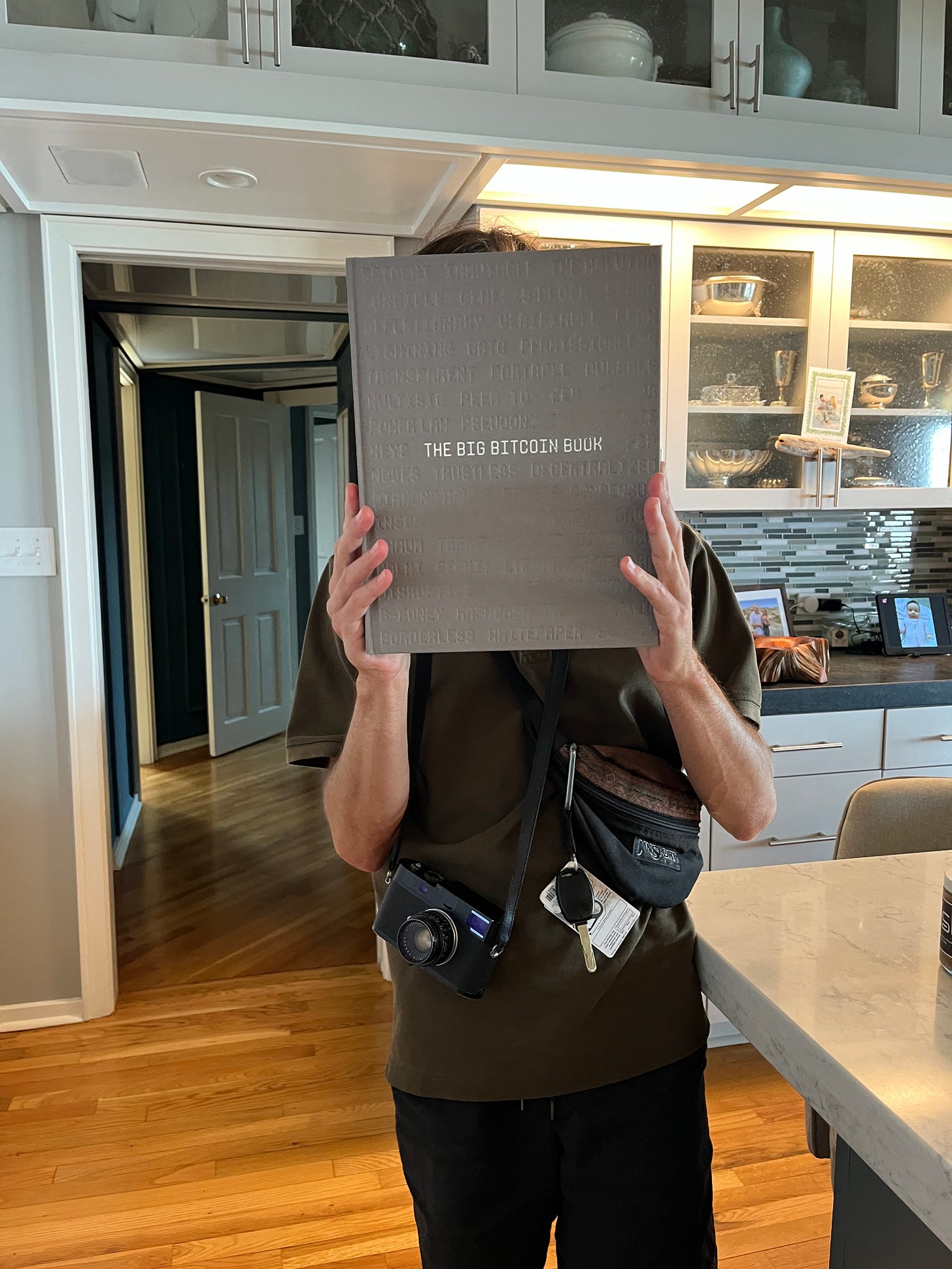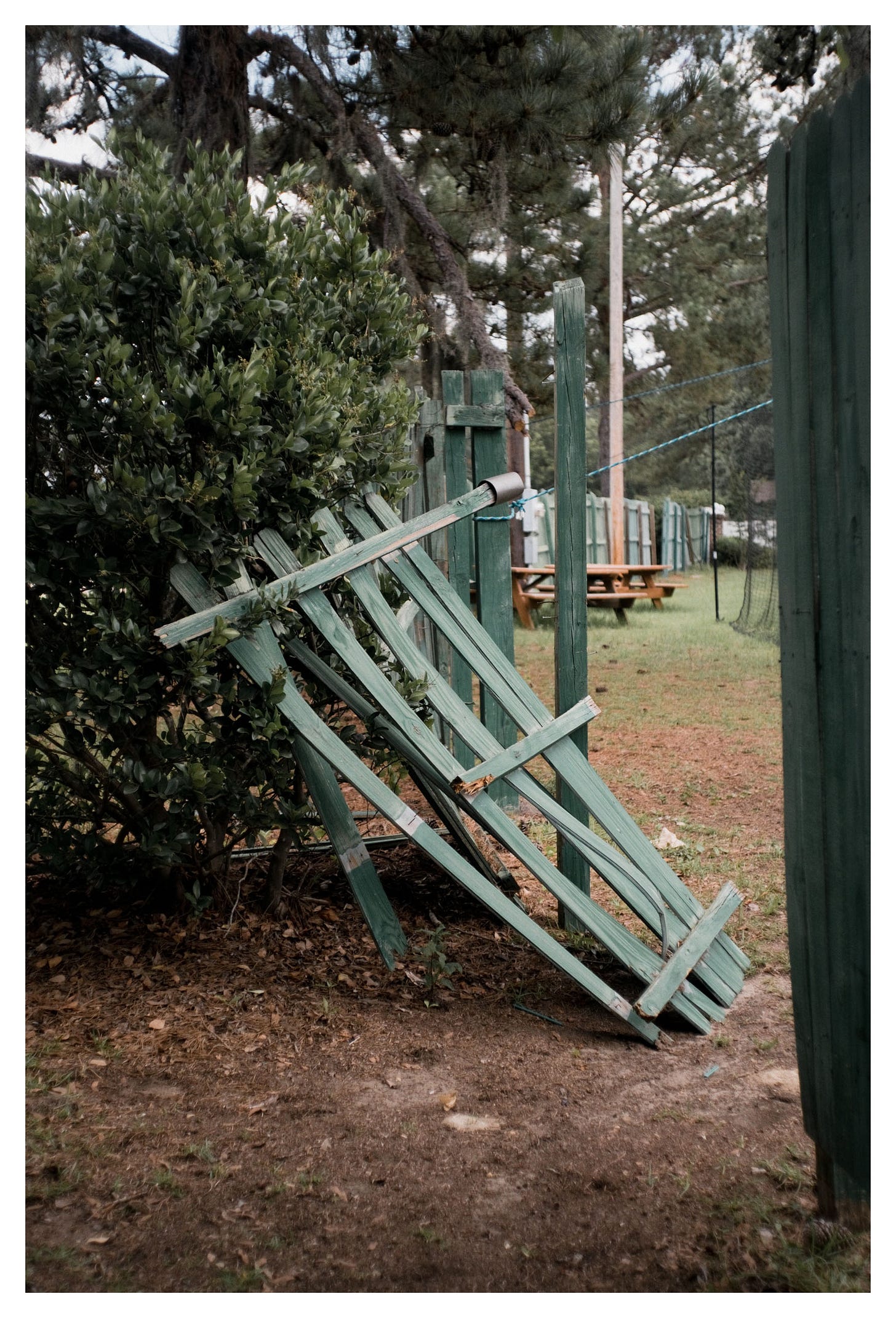-
 @ 52b4a076:e7fad8bd
2025-04-28 00:48:57
@ 52b4a076:e7fad8bd
2025-04-28 00:48:57I have been recently building NFDB, a new relay DB. This post is meant as a short overview.
Regular relays have challenges
Current relay software have significant challenges, which I have experienced when hosting Nostr.land: - Scalability is only supported by adding full replicas, which does not scale to large relays. - Most relays use slow databases and are not optimized for large scale usage. - Search is near-impossible to implement on standard relays. - Privacy features such as NIP-42 are lacking. - Regular DB maintenance tasks on normal relays require extended downtime. - Fault-tolerance is implemented, if any, using a load balancer, which is limited. - Personalization and advanced filtering is not possible. - Local caching is not supported.
NFDB: A scalable database for large relays
NFDB is a new database meant for medium-large scale relays, built on FoundationDB that provides: - Near-unlimited scalability - Extended fault tolerance - Instant loading - Better search - Better personalization - and more.
Search
NFDB has extended search capabilities including: - Semantic search: Search for meaning, not words. - Interest-based search: Highlight content you care about. - Multi-faceted queries: Easily filter by topic, author group, keywords, and more at the same time. - Wide support for event kinds, including users, articles, etc.
Personalization
NFDB allows significant personalization: - Customized algorithms: Be your own algorithm. - Spam filtering: Filter content to your WoT, and use advanced spam filters. - Topic mutes: Mute topics, not keywords. - Media filtering: With Nostr.build, you will be able to filter NSFW and other content - Low data mode: Block notes that use high amounts of cellular data. - and more
Other
NFDB has support for many other features such as: - NIP-42: Protect your privacy with private drafts and DMs - Microrelays: Easily deploy your own personal microrelay - Containers: Dedicated, fast storage for discoverability events such as relay lists
Calcite: A local microrelay database
Calcite is a lightweight, local version of NFDB that is meant for microrelays and caching, meant for thousands of personal microrelays.
Calcite HA is an additional layer that allows live migration and relay failover in under 30 seconds, providing higher availability compared to current relays with greater simplicity. Calcite HA is enabled in all Calcite deployments.
For zero-downtime, NFDB is recommended.
Noswhere SmartCache
Relays are fixed in one location, but users can be anywhere.
Noswhere SmartCache is a CDN for relays that dynamically caches data on edge servers closest to you, allowing: - Multiple regions around the world - Improved throughput and performance - Faster loading times
routerd
routerdis a custom load-balancer optimized for Nostr relays, integrated with SmartCache.routerdis specifically integrated with NFDB and Calcite HA to provide fast failover and high performance.Ending notes
NFDB is planned to be deployed to Nostr.land in the coming weeks.
A lot more is to come. 👀️️️️️️
-
 @ fd208ee8:0fd927c1
2024-12-26 07:02:59
@ fd208ee8:0fd927c1
2024-12-26 07:02:59I just read this, and found it enlightening.
Jung... notes that intelligence can be seen as problem solving at an everyday level..., whereas creativity may represent problem solving for less common issues
Other studies have used metaphor creation as a creativity measure instead of divergent thinking and a spectrum of CHC components instead of just g and have found much higher relationships between creativity and intelligence than past studies
https://www.mdpi.com/2079-3200/3/3/59
I'm unusually intelligent (Who isn't?), but I'm much more creative, than intelligent, and I think that confuses people. The ability to apply intelligence, to solve completely novel problems, on the fly, is something IQ tests don't even claim to measure. They just claim a correlation.
Creativity requires taking wild, mental leaps out into nothingness; simply trusting that your brain will land you safely. And this is why I've been at the forefront of massive innovation, over and over, but never got rich off of it.
I'm a starving autist.
Zaps are the first time I've ever made money directly, for solving novel problems. Companies don't do this because there is a span of time between providing a solution and the solution being implemented, and the person building the implementation (or their boss) receives all the credit for the existence of the solution. At best, you can hope to get pawned off with a small bonus.
Nobody can remember who came up with the solution, originally, and that person might not even be there, anymore, and probably never filed a patent, and may have no idea that their idea has even been built. They just run across it, later, in a tech magazine or museum, and say, "Well, will you look at that! Someone actually went and built it! Isn't that nice!"
Universities at least had the idea of cementing novel solutions in academic papers, but that: 1) only works if you're an academic, and at a university, 2) is an incredibly slow process, not appropriate for a truly innovative field, 3) leads to manifestations of perverse incentives and biased research frameworks, coming from 'publish or perish' policies.
But I think long-form notes and zaps solve for this problem. #Alexandria, especially, is being built to cater to this long-suffering class of chronic underachievers. It leaves a written, public, time-stamped record of Clever Ideas We Have Had.
Because they are clever, the ideas. And we have had them.
-
 @ 5f078e90:b2bacaa3
2025-05-29 09:33:22
@ 5f078e90:b2bacaa3
2025-05-29 09:33:22Frog named Gus

This is a test from Hive to Nostr, longform script, some markdown included. google link, 400 char. story.
In a lush pond, a green frog named Gus lived among lily pads. Each dawn, he croaked a cheerful tune, waking the dragonflies. One day, a heron eyed him hungrily. Gus, clever and quick, hopped beneath a broad leaf, blending perfectly. The heron, fooled, flew off. That evening, Gus sang louder, celebrating his escape. His friends—turtles and minnows—joined the chorus under the moon's glow. Gus’s courage inspired them all, proving wit outshines size. The pond thrived, with Gus as its spirited guardian, forever hopping and croaking in joy.
This was a test, please ignore.
-
 @ 5f078e90:b2bacaa3
2025-05-29 09:23:18
@ 5f078e90:b2bacaa3
2025-05-29 09:23:18May 29 badger test story
h2n, bi, some md, >380

In a dusty savanna, a honey badger named Hank prowled with fearless grit. Each night, he raided beehives, dodging stings with cunning twists. One day, a lion blocked his path, roaring fiercely. Hank, unfazed, bared his teeth and charged, startling the beast. The lion fled, and Hank strutted on, claws clicking. His boldness rallied jackals and birds, who sang his tale under starry skies. Hank’s fierce heart made him the savanna’s legend, guarding its wild spirit with every fearless step.
This is just a test, please ignore.
-
 @ 5f078e90:b2bacaa3
2025-05-29 09:10:54
@ 5f078e90:b2bacaa3
2025-05-29 09:10:54Gecky story - just a test

In a sun-dappled jungle, Zippy the gecko darted across a broad leaf, his emerald scales glinting. Chasing a juicy cricket, he leaped, only to slip into a pitcher plant’s slippery trap. With sticky toes, Zippy clung to the edge, heart racing. A curious frog peered in, offering a vine. Grateful, Zippy climbed out, sharing his cricket with his new friend. Under the moon’s glow, they danced on the leaves, tales of their adventure echoing through the jungle night.
Character count: 408
This was just a test. Ignore it.
-
 @ 7d33ba57:1b82db35
2025-05-29 08:40:35
@ 7d33ba57:1b82db35
2025-05-29 08:40:35Lingen (Ems) is a peaceful town in Lower Saxony, near the Dutch border, known for its historic old town, green surroundings, and relaxed pace of life. It may not be on the typical tourist radar, but it offers a taste of small-town Germany with plenty of charm and local culture.
🏘️ What to See and Do in Lingen
🏛️ Old Town & Market Square
- Stroll through the historic town center, where you’ll find half-timbered houses, cozy cafés, and the lovely St. Boniface Church
- The Rathaus (Town Hall) and its square are perfect for a slow coffee or people-watching
🚲 Nature & Outdoor Activities
- The region around Lingen is great for cycling and walking, especially along the Ems River
- Explore the Emsland countryside, filled with forests, meadows, and quiet villages
- Visit the nearby Emsland Moormuseum to learn about local peatland history
🎓 Student Vibes
- Thanks to the presence of a university, Lingen has a young and vibrant side, with cultural events and small live music scenes
🍺 Local Food & Drink
- Try regional dishes like Grünkohl (kale with sausage in winter) and Schnitzel in a local tavern
- Enjoy a drink at a beer garden or riverside café, especially in warmer months

🚆 Getting There
- Well connected by train, especially to Osnabrück, Münster, and the Dutch city of Enschede
- Great stop on a northern Germany road or rail trip
Lingen is ideal for travelers looking for peaceful towns, regional culture, and access to beautiful natural areas. It’s a place where you can slow down, bike along a river, and enjoy the local way of life.
-
 @ cefb08d1:f419beff
2025-05-29 08:01:15
@ cefb08d1:f419beff
2025-05-29 08:01:15https://stacker.news/items/991778
-
 @ 7459d333:f207289b
2025-05-29 07:44:37
@ 7459d333:f207289b
2025-05-29 07:44:37Bitcoin is something that grows in you. And the proof of work philosophy really is a thing.
At some point, you become uncomfortable about holding fiat or fiat related assets (stocks, bonds, ...). Because those aren't really yours. And feels like sponsoring a system you don't support.
At some point, you might have decided to opt out. And move all your savings into Bitcoin. How did you do that?
If you had a significant amount of index funds and wanted to move those to Bitcoin, how would you do it? When?
For the how: probably selling it off slowly for fiat and then Bisq or similar.
For the when: 2 years ago you would have gotten 4x the amount of Bitcoin that you get today for each “share” of the S&P 500. 4 years ago you would have gotten more or less the same that you would today. https://inflationchart.com/spx-in-btc/?time=5%20years&show_stock=0&show_adjuster=0&zero=1 Would you wait for another SP500/BTC peak?
Did you move all your savings into Bitcoin? How did you do so? How would you do it today?
https://stacker.news/items/991774
-
 @ d3d74124:a4eb7b1d
2025-05-29 02:19:14
@ d3d74124:a4eb7b1d
2025-05-29 02:19:14language is a funny thing. the English grammar is one of the most, if the not THE most complicated grammars to learn.
https://en.wikipedia.org/wiki/Defense_Language_Aptitude_Battery\ DLAB. it's the test you take to see if you have a gift for language learning.
in my exploration of languages, first Chinese Mandarin, then software languages, context is king (Jesus is King). the surrounding context is different every where you go.
physical space context. we can't be two places at once. nostr allows for many languages, because you can provide your own digital context. our physical perspective give us a field of view. NOSTR clients give us a field of view into digital context.
math is a language.
bitcoin will be called a lot of things.
wizardry
some elections results are anchored in time. using bitcoin. what else should be? legal documents seem obvious. other cryptographic proofs.
zero knowledge proofs. something about curve trees.
Find your local BitDevs.
Shenandoah Bitcoin Club
pondering a Veteran's Day live music event in Frederick County, VA. who would show up to a lunch and learn with hardware wallets in testnet4 mode? to try shit out? local only, but you should do it where you are too if you're not local.
mining
getting better? Bitmain announces a "decentralized mining pool" but I doubt we'll see open source code if history follows. 256Foundation getting to business. working prototypes for the Ember One using USB and python are out there for those that know where to look. i am very bullish on mujina. very bullish. fun coinbase tricks happening too with CTV+CSFS.
p.s. written on primal's new article publishing UI.
-
 @ eb0157af:77ab6c55
2025-05-29 09:01:38
@ eb0157af:77ab6c55
2025-05-29 09:01:38The company is facing a class action lawsuit following a stock price drop triggered by the delayed disclosure of a December data breach.
Coinbase finds itself at the center of a legal storm after being hit with a class action lawsuit filed by shareholders. The lawsuit stems from a decline in the company’s stock price, which occurred after the belated communication of a cybersecurity incident.
The class action, filed in the United States District Court for the Eastern District of Pennsylvania, names investor Brady Nessler as the lead plaintiff. The suit claims that the platform’s shareholders suffered “substantial losses and damages” due to the company’s alleged failure to disclose material information.
Investors accuse the company of not promptly revealing crucial details that could have influenced investment decisions. Among the main allegations is the failure to immediately communicate a data breach that took place last December.
Details of the breach
On May 15, Coinbase publicly disclosed the news of a cyberattack that occurred last December. The incident involved cybercriminals who managed to corrupt several company employees, gaining unauthorized access to customer personal data.
The delayed disclosure of the data breach triggered an immediate stock market reaction. Coinbase shares fell 7.2%, closing the day at $244.
The exchange estimated that the financial impact of the data breach could range between $180 million and $400 million. These costs would cover both expenses to restore security systems and potential reimbursements to customers affected by the incident.
The lawsuit highlights that the company should have communicated these estimated costs to investors more promptly, allowing them to make informed decisions about their investments.
Additional allegations in the lawsuit
In addition to the data breach, the lawsuit lists a series of other alleged communication failures by the company. Among them is the non-disclosure of a violation by CB Payments — Coinbase’s UK subsidiary — of a 2020 agreement with the UK’s Financial Conduct Authority.
The class action covers all investors who acquired company shares between April 14, 2021, and May 14, 2025 — a period during which the allegedly omitted information is believed to have negatively affected the stock price.
The legal action doesn’t target the company alone but also names top executives including CEO Brian Armstrong and CFO Alesia Haas among the defendants.
The post Lawsuit against Coinbase: investors sue exchange for failing to disclose data breach appeared first on Atlas21.
-
 @ 866e0139:6a9334e5
2025-05-29 07:29:43
@ 866e0139:6a9334e5
2025-05-29 07:29:43Autor: Anna Nagel. (Bild: Lukas Karl). Dieser Beitrag wurde mit dem Pareto-Client geschrieben. Sie finden alle Texte der Friedenstaube und weitere Texte zum Thema Frieden hier. Die neuesten Pareto-Artikel finden Sie auch in unserem Telegram-Kanal.
Die neuesten Artikel der Friedenstaube gibt es jetzt auch im eigenen Friedenstaube-Telegram-Kanal.
Wem in seinem Leben Schmerz zugefügt wurde, wer sich ungerecht behandelt fühlt oder wachen Auges in der Welt umschaut, kommt wahrscheinlich irgendwann mit der Frage in Berührung, wie das alles noch einmal «gut» werden kann. Wie kann die Welt sich mit sich selbst versöhnen? Und wie kann ich es selbst schaffen, mich mit ihr und den Menschen, die schlimme Taten vollbringen, wieder in harmonischer Akzeptanz zu verbinden? Kann und will ich gewisse Gräueltaten verzeihen oder gibt es das «Unverzeihliche»? Und selbst wenn ich wollte, wie könnte mir das gelingen?
Perspektivwechsel
Wenn wir an dem Zorn über begangenes Unrecht festhalten, schauen wir in der Regel aus immer derselben Perspektive auf das Geschehen. Mal um Mal erzürnen und empören wir uns darüber, erzählen uns und anderen stets die gleiche Geschichte, die uns allerdings – ebenfalls ein ums andere Mal – wieder selbst verletzt. Das Destruktive holt uns so ständig wieder ein; wir sehen und fühlen das unschuldige Kind und empfinden Verachtung für die Täter.
Die Perspektive zu wechseln lädt uns dazu ein, das Geschehen aus anderen Blickwinkeln zu betrachten und unser Bewusstsein von der schmerzlichen Wiederholung zu lösen. Wir können einmal weit rauszoomen und einen spirituellen Blickwinkel einnehmen, beispielsweise aus Sicht des All-ein-Bewusstseins, das sich in unzählige Seelen teilt, von denen wiederum Milliarden derzeit auf der Erde inkarniert sind. Dieses eine Bewusstsein möchte jede auch nur mögliche Erfahrung machen und durch die Trennung – die Erschaffung der Dualität – kann es sich selbst aus diesen Milliarden Persönlichkeiten heraus erfahren, um zu lernen. Während dieser scheinbaren Trennung vergessen wir, dass wir alle eins sind, dass wir alle aus demselben «Stoff» gemacht sind und nach diesem Spiel hier auf Erden unsere Erinnerung zurückerlangen und unsere Erfahrungen zurück geben in die eine «Quelle».
Unser aller Reise geht letztlich darum, hier auf der Erde aus diesem Zustand des Vergessens zu erwachen. Um dies zu erreichen und all diese Erfahrungen machen zu können und uns auch unter widrigsten Umständen an unsere wahre Essenz, an die Liebe, erinnern können, braucht es auch Akteure, die die Dunkelheit verkörpern – denn nur so haben wir die Wahl, ob wir uns von ihr einnehmen lassen oder uns für die Liebe und das Mitgefühl entscheiden. Der Täter sowie das Opfer sind dabei stets Aspekte unserer selbst – im Innen wie im Außen – und jeder einzelne verändert die Welt, indem er Liebe und Mitgefühl oder Hass und Verachtung wählt.
Eine etwas rationalere Herangehensweise wäre, zu schauen, was dazu führt, dass ein Mensch sich derart unmenschlich verhalten kann; also der Zugang über die Psychologie. Hier werden wir uns bewusst, dass jeder Täter auch einmal ein Kind war. Symbolisch sogar das Kind, mit dem wir jetzt im Beispiel mitfühlen und das wir gleichzeitig heute als erwachsenen Täter verachten. Natürlich kann man hier einwenden, dass nicht jedes Opfer zum Täter wird, aber man kann ebenso anerkennen, dass uns bei dieser Haltung das größte Stück fehlt; und zwar die Geschichte desjenigen, die Jahre dazwischen, sowie jeder einzelne Reiz und jedes Detail der Umstände.
Wie viel Schmerz und Leid muss ein Mensch erfahren, bis er unmenschlich wird? Mit Einbezug aller Umstände und Faktoren, der psychischen Schutzmechanismen traumatischer Erfahrungen sowie fehlender Ausbildung sozialer und empathischer Fähigkeiten auch im neuronalen Bereich kann man auch auf diesem Wege Verständnis erlangen. Sichtbar wird hierdurch auch, dass emotionaler Schmerz über Generationen weitergegeben wird und es schwer ersichtlich ist, wo denn die eigentliche Ursache liegt. Auch hier wird erkennbar, dass nur jeder bei sich anfangen kann und Verantwortung für seine Heilung – und damit gleichzeitig die anderer – übernehmen müsste, anstatt auf die Suche nach dem oder der «Schuldigen» zu gehen.
Was bedarf eigentlich der Vergebung?
Wenn es uns schwerfällt zu vergeben, also Groll und Verachtung loszulassen und Mitgefühl zu empfinden, ist es ebenfalls hilfreich, einmal hinzuschauen, worum es genau geht. Wenn es uns selbst betrifft, handelt es sich in der Regel um Schmerz, der uns willentlich, manchmal auch unbewusst, zugefügt wurde und den wir (noch) nicht loslassen können, weil er noch nicht verheilt ist. Darauf gehe ich später noch einmal ein. Oft geht es aber auch um uns unbekannte Menschen, von deren Verbrechen wir Kenntnis haben und deren Ungeheuerlichkeit uns aus der Fassung bringt. Es geht um Taten, die wir nicht nachvollziehen können, weder rational noch emotional. Wir meinen, selbst wenn jemand nicht spürte, was er anderen antut, so müsse er es doch wenigstens besser wissen. Das ist das, was uns Menschen ausmacht, mit anderen mitzufühlen und sie zu verstehen. Doch anscheinend gibt es Menschen, deren Persönlichkeit oder auch Psyche dazu absolut nicht in der Lage sind. Die keinen moralischen Kompass besitzen und keinerlei soziales Empfinden, denn sonst könnten sie bestimmte Taten nicht ausführen. Möglicherweise dissoziieren sie sich selbst so stark, dass diese für sie eine Normalität darstellen, sie diese entschuldigen beziehungsweise vor sich selbst rechtfertigen oder im extremen Fall keine Erinnerung mehr daran haben.
Uns erscheinen die fehlende Empathie sowie das fehlende Verständnis so fremd, dass wir es nicht nachvollziehen können. Uns fehlt die Nachvollziehbarkeit der Nichtnachvollziehbarkeit des Erlebens des anderen, und wir erachten diesen dadurch als unmenschlich. Denn menschlich wären doch eben diese Fähigkeiten wie Mitgefühl, Güte, Reflexion, Warmherzigkeit, Verständnis und Liebe. Zugleich erzeugen wir hier aber einen Konflikt, wenn wir sagen: «Da diese Menschen sich so unmenschlich verhalten, soll ihnen kein Mitgefühl und keine Vergebung entgegengebracht werden, sollen auch sie nicht menschlich behandelt werden», wodurch wir uns allerdings selbst unserer Menschlichkeit berauben.
«Aber der Täter hatte doch die freie Wahl, er hätte doch anders entscheiden können!» Ja, möglicherweise schon, aber jetzt haben wir die Wahl. Und wir haben viel leichtere Voraussetzungen dafür, menschlich zu handeln, weil wir gesunden Zugang zu unserer Empathie, Moral und unserer Ratio haben.
Hätte der Täter es geschafft, seinen Tätern zu verzeihen, würde er die Destruktivität, die er ab einem gewissen Zeitpunkt nicht mehr in sich tragen oder verdrängen konnte, nicht an anderen ausagieren. Es ist ihm nicht gelungen, vielleicht sogar weil etwas in ihm es für unmöglich hielt, Unmenschliches, das ihm zugefügt wurde, zu verzeihen. Aber uns kann es gelingen, diesen Kreislauf zu durchbrechen und uns nicht in ihn hineinziehen zu lassen; wir können dem «Dunklen» den Nährboden entziehen.
Manchmal nehmen wir an, würden wir das Unbeschreibliche verzeihen, bedeutete dies, dass wir es tolerieren oder gar gutheißen. Dem ist nicht so. Analog dazu habe ich manches Mal die Angst gehabt, würde ich aufhören, um meinen Freund zu trauern, bedeute dies, dass ich ihn nicht mehr vermisse. Auch das ist nicht richtig. Ich heile lediglich das, was mir Schmerzen zufügt, bis am Ende nur noch die Liebe bleibt. Und wenn wir verzeihen, ist es kein Gutheißen der Taten, es bedeutet ein Loslassen dessen, was uns damit verstrickt und das Destruktive nährt.
Mitgefühl beginnt bei uns selbst
«Daß ich dem Hungrigen zu essen gebe, dem vergebe, der mich beleidigt, und meinen Feind liebe- das sind große Tugenden. Was aber, wenn ich nun entdecken sollte, daß der armselige Bettler und der unverschämteste Beleidiger alle in mir selber sind und ich bedürftig bin, Empfänger meiner eigenen Wohltaten zu sein? Daß ich der Feind bin, den ich lieben muß - was dann?» – C. G. Jung
Mit diesem Zitat beginnt Dan Millman das Kapitel «Das Gesetz des Mitgefühls» in seinem Buch «Die universellen Lebensgesetze des friedvollen Kriegers». Die weise Frau lehrt dem Wanderer das Gesetz des Mitgefühls und erklärt, es sei «eine liebevolle Aufforderung, über unsere begrenzte Sichtweise hinauszuwachsen», auch wenn die Last dieser Aufgabe zuweilen sehr schwer wiegen könne. Genau deshalb müsse man daran denken, dass sie bei uns selbst beginnt und wir «geduldig» und «sanft» mit uns, unseren Gefühlen und Gedanken sein sollten.
Um dem – noch skeptischen – Wanderer zu veranschaulichen, wie wir Mitgefühl auch mit unseren Gegnern empfinden können, bat sie ihn, sich an eine Auseinandersetzung zu erinnern, in der er zornig, neidisch oder eifersüchtig war und sich diese Gefühle noch einmal zu vergegenwärtigen. Als er das tat, den Schmerz und die Wut wieder spürte, sagte sie zu ihm: «Und nun stell dir vor, daß der Mensch, mit dem du dich streitest, mitten in eurer erregten Auseinandersetzung plötzlich nach seinem Herzen faßt, einen Schrei ausstößt und zu deinen Füßen tot zu Boden sinkt.» Der Wanderer erschrak und auf Nachfrage der weisen Frau stellte er fest, dass er nun keinerlei Schmerz oder Wut mehr empfand. Sogleich aber kam ihm der Gedanke: «Aber – aber was wäre, wenn ich mich über den Tod dieses Menschen freuen würde? Wenn ich ihm nicht verzeihen könnte?», worauf die weise Frau antwortete: «Dann verzeih dir wenigstens selber deine Unversöhnlichkeit. Und in dieser Vergebung wirst du das Mitgefühl finden, das deinen Schmerz heilt, als Mensch in dieser Welt zu leben.»
Weiter erinnert uns die weise Frau daran, dass wir alle, während wir hier auf der Erde sind, Träume, Hoffnungen und Enttäuschungen haben; und dass diese, sowie letztlich der Tod, uns alle verbinden.
Es ist ein Prozess
Dan Millman sagt hier in Gestalt der Weisen Frau, dass Mitgefühl bei uns selbst beginnt und diesen Aspekt möchte ich noch einmal hervorheben. Es kann nämlich passieren, dass wir uns in einer oberflächlichen Vergebung wieder finden, weil wir meinen, es sei richtig und moralisch, anderen zu verzeihen, ohne aber die tieferen Schichten dabei zu fühlen. Das ist dann leider nichts anderes, als Verdrängung. Gerade wenn wir selbst Opfer von Ungerechtigkeit, physischer oder mentaler Gewalt wurden, ist es unerlässlich den Heilungsweg in Gänze zu durchschreiten, und in den Wachstumsprozess zu verwandeln, der uns Mitgefühl und Weisheit lehrt. Und dazu gehören die Wut auf das Begangene, die Verzweiflung, die Ungerechtigkeit und Ohnmacht zu fühlen, uns auf «unsere Seite» zu stellen und Partei für uns selbst zu ergreifen, bevor es ernstlich möglich wird, zu verzeihen. Zunächst fühlen wir mit uns selbst den Schmerz und befreien die Gefühle, die wir uns möglicherweise nie trauten zu fühlen, all die Wut und den Groll. Erst später kann dann aus dem Inneren heraus das weitere Erkennen stattfinden und Heilung und Vergebung geschehen.
Vergebung findet im Herzen statt
Die hier in diesem Text von mir aufgeführten Perspektiven sind nur zwei, drei kleine Beispiele für Sichtweisen, die man einnehmen könnte, um zu neuen Einsichten zu gelangen. Sie sollen niemanden von irgendetwas überzeugen, sondern als Anregung dienen. Denn letztlich geht es darum, Vergebung in sich selbst zu finden. Vergebung ist also etwas, das aus dem Inneren heraus entsteht; ein Ergebnis eines tiefen Verständnisses und Fühlens, ja eines Erkennens. Auf dieser Reise gehen wir unterschiedliche Blickwinkel und Versionen ab, bis wir im Herzen ankommen, es sich öffnet und wir plötzlich «klar» sehen. Daraufhin breitet sich Wärme im Körper aus, Liebe durchströmt uns, begleitet möglicherweise von einem Gefühl leiser Euphorie, möglicherweise auch einem leichten Schmerz und Tränen – sowohl ein paar der Traurigkeit als auch welchen der Dankbarkeit. Das Loslassen und die Befreiung sind spürbar und nur für jeden persönlich erfahrbar, der sich auf diesen Weg begibt und seine individuelle Ansicht findet, die ihn befreit und erlöst.
Meiner Meinung nach bedeutet also Vergebung eine Öffnung des Herzens, ein Erkennen und ein Hineinwachsen in die Perspektive der Liebe. Sie ist nicht auf rationaler Ebene zu finden; die rationale Ebene kann nur dabei helfen, den Weg zum Mitgefühl zu beschreiten, denn:
«Man sieht nur mit dem Herzen gut. Das Wesentliche ist für die Augen unsichtbar.»
– Antoine de Saint-Exupéry
Anna Nagel veröffentlicht auf ihrem Blog „Heimwärts“ seit Jahren zu den Themen Heilung, Bewusstsein, kollektives Erwachen, Gefühle, Spiritualität, Psyche, Kundalini und Philosophie.
LASSEN SIE DER FRIEDENSTAUBE FLÜGEL WACHSEN!
Hier können Sie die Friedenstaube abonnieren und bekommen die Artikel zugesandt.
Schon jetzt können Sie uns unterstützen:
- Für 50 CHF/EURO bekommen Sie ein Jahresabo der Friedenstaube.
- Für 120 CHF/EURO bekommen Sie ein Jahresabo und ein T-Shirt/Hoodie mit der Friedenstaube.
- Für 500 CHF/EURO werden Sie Förderer und bekommen ein lebenslanges Abo sowie ein T-Shirt/Hoodie mit der Friedenstaube.
- Ab 1000 CHF werden Sie Genossenschafter der Friedenstaube mit Stimmrecht (und bekommen lebenslanges Abo, T-Shirt/Hoodie).
Für Einzahlungen in CHF (Betreff: Friedenstaube):

Für Einzahlungen in Euro:
Milosz Matuschek
IBAN DE 53710520500000814137
BYLADEM1TST
Sparkasse Traunstein-Trostberg
Betreff: Friedenstaube
Wenn Sie auf anderem Wege beitragen wollen, schreiben Sie die Friedenstaube an: friedenstaube@pareto.space
Sie sind noch nicht auf Nostr and wollen die volle Erfahrung machen (liken, kommentieren etc.)? Zappen können Sie den Autor auch ohne Nostr-Profil! Erstellen Sie sich einen Account auf Start. Weitere Onboarding-Leitfäden gibt es im Pareto-Wiki.
-
 @ 83279ad2:bd49240d
2025-05-29 04:05:29
@ 83279ad2:bd49240d
2025-05-29 04:05:29 -
 @ 83279ad2:bd49240d
2025-05-29 04:03:54
@ 83279ad2:bd49240d
2025-05-29 04:03:54 -
 @ 048ecb14:7c28ac78
2025-05-29 00:49:55
@ 048ecb14:7c28ac78
2025-05-29 00:49:55I recently set up a Raspberry Pi camera server that's so minimal and straightforward, I thought it was worth sharing. This isn't one of those over-engineered solutions with fancy features - it's just a basic, reliable camera feed accessible from any browser on my local network.
The Goal
I wanted something that: 1. Starts automatically when the Pi boots up 2. Captures images at regular intervals 3. Shows the latest image in a simple web page accessible from any device 4. Doesn't require complex setup or dependencies 5. Uses minimal resources on my old Raspberry Pi
The Hardware
Nothing fancy here: - Raspberry Pi 2B (yes, the ancient one from 2015!) - Raspberry Pi Camera Module (standard version) - Power supply - That's it!
The Result

The interface is minimal but does the job. It shows the latest image and auto-refreshes every couple of seconds.
How to Get Set Up
Getting this running on your own Pi is super simple:
-
Make sure your camera module is connected and enabled
bash sudo raspi-config # Navigate to Interface Options > Camera and enable it -
Install the only dependency, ImageMagick (for rotation)
bash sudo apt update sudo apt install imagemagick -
Clone the repository, and navigate to the implementation's directory
bash git clone https://github.com/rewolf/RpiCameraViewer cd simple -
Start the camera server
bash ./start_camera_server.sh -
Access the feed from any device on your network
http://your-pi-ip-address:8080
That's it! No complex configuration, no fancy dependencies.
For more details consider reading the README
To make it start automatically on boot:
Add the following, with your specific installation path ```bash crontab -e
Add this line:
@reboot cd /path/to/RpiCameraViewer/simple && ./start_camera_server.sh ```
Configuration
There's not much configuration, but you can tweak few variables at the top of the
capture.shfile to modify width, height, rotation, quality, etc:bash QUALITY=90 WIDTH=720 HEIGHT=1280 ROTATION=90 # Set to 0 to disable rotationHow It Works
The solution is very basic:
- A bash script (
capture.sh) captures photos every few seconds by runninglibcamera-stilland sending a SIGUSR1 interrupt to signal it to capture a snapshot - The snapshot is rotated as needed with ImageMagick and saved with timestamps
- A symbolic link is updated to point to the latest image
- A minimal Python HTTP server serves a basic webpage showing the current image (the symlink), rendered to an HTML canvas
Note it does expose that directory to the whole LAN on :8080.
Give it a try if you need something like that quickly.
I have a plan to make a better implementation planned at some point, but for now this will do.
-
-
 @ 5d4b6c8d:8a1c1ee3
2025-05-29 00:42:35
@ 5d4b6c8d:8a1c1ee3
2025-05-29 00:42:35Pretty good day today, despite being a bit of a cookie monster again. - Lots of steps from mowing the lawn, walking the dog, and miscellaneous errands - Broke my fast a little early in the morning, but ate healthy until afternoon snacks
Also, I came across a new health app on nostr. Has anyone else used SOUND HSA? It supposedly pays sats for steps.
How did everyone else do with their goals today?
https://stacker.news/items/991609
-
 @ ece127e2:745bab9c
2025-05-29 00:32:33
@ ece127e2:745bab9c
2025-05-29 00:32:33vamos a ver que tal
*lo bueno es que si entro en https://makimono.lumilumi.app/ a la nota y agrego contenido , como éste ...quiero ver si lo añade o hace una nueva nota ?? *
-
 @ 000002de:c05780a7
2025-05-28 23:34:51
@ 000002de:c05780a7
2025-05-28 23:34:51With all the free press Steak `n Shake is getting for accepting bitcoin this post got me thinking about good burgers at fast food chains. There are incredible non-fast food burgers and local places but I'm limiting this to chains.
In order if you are going for a chain fast food American burgers here's the list in order.
- In-n-Out
- Shake Shack
- Habit Burger & Grill
- Five Guys
Everything else is not worth mentioning or I'm not aware of it due to where I live and have traveled.
What's your list.
Bonus:
Which of these or you picks will be next in accepting bitcoin.
https://stacker.news/items/991559
-
 @ 2b998b04:86727e47
2025-05-28 23:24:05
@ 2b998b04:86727e47
2025-05-28 23:24:05I’ve spent years chasing the promise of freedom.\ In startups. In faith communities. In movements that claimed to be for the people.
And yet — so often, that promise felt just out of reach.\ Conditional. Corporate. Sanitized.\ A freedom with fine print.
But here —\ Here in the thick of Bitcoin 2025, on Nostr, among misfits and builders and signal-bringers —\ something is alive.
It’s not a platform.\ It’s not a marketing strategy.\ It’s not another app promising to “empower” you while locking down your data and selling you out.
It’s freedom rooted in architecture.\ Decentralization not just as a buzzword —\ but as an expression of conviction.
A kind of freedom you can feel in your body:
-
When you zap someone’s words because they moved you — not because an algorithm told you to.
-
When your identity is yours — keys, not credentials.
-
When no one can delete your story because you control the server, or because there is no server — just the relay of your choosing.
This isn’t utopia.\ There are egos. There’s noise. There’s still posturing.\ But it’s different.\ The center of gravity has shifted.
We’re no longer begging institutions to notice us.\ We’re building outside their jurisdiction.
And for the first time in a long time,\ freedom feels close.\ Tangible.\ Joyful.\ Alive.
This isn’t just about tech.\ It’s about trust.\ It’s about choosing to show up —\ to build\ to write\ to signal\ to keep going.
Even when it’s hard.\ Even when no one claps.
Because real freedom doesn’t come from being noticed.\ It comes from being sovereign.
And that’s something no one can take from me again.
—
Written in Las Vegas, during Bitcoin 2025.\ Posted via Nostr. Vibes co-authored by ChatGPT (“Dr. C”).\ Zap: https://tinyurl.com/yuyu2b9t
-
-
 @ a396e36e:ec991f1c
2025-05-28 22:27:45
@ a396e36e:ec991f1c
2025-05-28 22:27:45👤 Generation X and Bitcoin: Between Invisibility, Structural Disillusionment, and Defiance
Generation X, born between 1965 and 1980, has been largely sidelined in generational discourse. Unlike the baby boomers —symbols of stability and prosperity— or millennials and Gen Z —constant fixtures in the media and cultural spotlight— Gen X remains the least mentioned, the least studied, and often not even recognized by its own members as a distinct generation.
Today, they are in midlife —a period that, according to the U-shaped curve of happiness, is one of the most emotionally and psychologically difficult stages: deteriorating health, professional stagnation, and the dual burden of caring for both parents and children. But their condition is not just a matter of age —it’s the product of a unique convergence of economic and political failure.
Structurally, Generation X reached its crucial phase of financial consolidation during the global economic crisis of 2008 —a moment that froze wage growth and severely limited access to housing, investment opportunities, and savings. In parallel, they faced increasing labor precarization: unstable contracts, outsourcing, erosion of social protections, and the dismantling of job security. Compared to other generations, their economic mobility was minimal. Even in terms of wealth accumulation and home ownership, many Gen Xers show weaker indicators than early-born millennials at the same life stage.
At the same time, many countries —especially in Latin America and parts of Europe— turned toward alternative models to free-market systems: socialist proposals that promised redistribution, justice, and equality. But in practice, these models led to state dependency, excessive intervention, economic rigidity, and a loss of productive dynamism. The outcome was devastating: rising poverty, institutional decay, inflation, plummeting investment, growing corruption, and a widespread collapse of trust.
For a generation raised on values of effort, autonomy, and social mobility, this ideological shift brought a double betrayal —first from liberalism, which failed to deliver on its promises, and then from socialism, which entrenched poverty, dependency, and dysfunction.
And yet, while younger generations increasingly embrace state-centric proposals like universal basic income, subsidies, or nationalizations as progressive solutions, many in Gen X see these not as innovation, but as déjà vu —a recycling of failed models they’ve already lived and paid for.
It’s at this point that Bitcoin emerges as more than just a financial technology. For many Gen Xers, Bitcoin is both a symbolic and concrete response — a refuge from a system that betrayed them. It’s not just about investment. It’s about individual sovereignty. They call it “fuck you money” because it represents a total break from traditional structures: it doesn’t depend on banks, governments, political parties, or promises that never materialize.
Bitcoin is money without permission, without censorship, without planned devaluation. It’s a tool for radical autonomy. For a generation marked by skepticism, self-reliance, and disillusionment, it stands as a quiet but powerful form of resistance — a way of saying: “I don’t depend on you. I don’t believe you. I don’t need you.”
Today, while others debate new statist models or more market reforms, many Gen Xers are simply opting out. Bitcoin isn’t just an economic choice — it’s a stance. A way to reclaim the individual control the system once denied them.
-
 @ eb0157af:77ab6c55
2025-05-29 07:01:39
@ eb0157af:77ab6c55
2025-05-29 07:01:39A new Bitwise report reveals notable growth for institutional investments in bitcoin over the coming years.
According to the latest forecasts from asset management firm Bitwise, capital flows into Bitcoin could exceed $120 billion by the end of 2025, with projections reaching $300 billion the following year.
This growth is rooted in the rising interest from sovereign wealth funds, publicly traded companies, state treasuries, and institutional investment vehicles such as spot exchange-traded funds (ETFs). Analysts expect the number of companies holding bitcoin in their treasuries to double by the end of 2026.
Bitwise’s analysis highlights how Bitcoin is no longer seen solely as a speculative asset but is emerging as a serious contender for the role of global store of value.
The report notes that, according to its authors, global wealth is gradually moving away from traditional safe havens like gold and shifting toward Bitcoin.
Spot ETF boom
Spot Bitcoin ETFs in the United States have outperformed all expectations throughout 2024. These financial instruments have attracted over $36.2 billion in net inflows, surpassing by twenty times the early performance of SPDR Gold Shares (GLD), historically the most successful commodity ETF.

Source: Bitwise
In just twelve months, U.S. spot ETFs have accumulated $125 billion in assets under management (AUM). Bitwise projections suggest that annual inflows could reach $100 billion by 2027.
However, approximately $35 billion in capital remained on the sidelines in 2024 due to regulatory restrictions at financial institutions such as Morgan Stanley and Goldman Sachs.
States consider a bitcoin reserve
Bitwise’s analysis also highlights Bitcoin’s growing appeal beyond Wall Street. Publicly traded companies currently hold over 1.1 million BTC, worth more than $125 billion. Sovereign governments collectively own more than 500,000 BTC, with the United States, China, and the United Kingdom leading the rankings.
In its base scenario, Bitwise forecasts a modest reallocation of institutional and sovereign assets toward Bitcoin: 5% of government gold reserves and 0.5% of assets from major wealth management platforms. Even under these conservative assumptions, total bitcoin inflows could reach $420 billion over 2025-2026.
In a more optimistic scenario, with 10% of gold reserves and 1% of managed portfolios shifting to Bitcoin, inflows could exceed $920 billion, absorbing more than 9 million bitcoins — around 40% of the total supply.
The post Bitcoin attracts institutional investors: $300 billion expected by 2026, according to Bitwise appeared first on Atlas21.
-
 @ 21335073:a244b1ad
2025-05-21 16:58:36
@ 21335073:a244b1ad
2025-05-21 16:58:36The other day, I had the privilege of sitting down with one of my favorite living artists. Our conversation was so captivating that I felt compelled to share it. I’m leaving his name out for privacy.
Since our last meeting, I’d watched a documentary about his life, one he’d helped create. I told him how much I admired his openness in it. There’s something strange about knowing intimate details of someone’s life when they know so little about yours—it’s almost like I knew him too well for the kind of relationship we have.
He paused, then said quietly, with a shy grin, that watching the documentary made him realize how “odd and eccentric” he is. I laughed and told him he’s probably the sanest person I know. Because he’s lived fully, chasing love, passion, and purpose with hardly any regrets. He’s truly lived.
Today, I turn 44, and I’ll admit I’m a bit eccentric myself. I think I came into the world this way. I’ve made mistakes along the way, but I carry few regrets. Every misstep taught me something. And as I age, I’m not interested in blending in with the world—I’ll probably just lean further into my own brand of “weird.” I want to live life to the brim. The older I get, the more I see that the “normal” folks often seem less grounded than the eccentric artists who dare to live boldly. Life’s too short to just exist, actually live.
I’m not saying to be strange just for the sake of it. But I’ve seen what the crowd celebrates, and I’m not impressed. Forge your own path, even if it feels lonely or unpopular at times.
It’s easy to scroll through the news and feel discouraged. But actually, this is one of the most incredible times to be alive! I wake up every day grateful to be here, now. The future is bursting with possibility—I can feel it.
So, to my fellow weirdos on nostr: stay bold. Keep dreaming, keep pushing, no matter what’s trending. Stay wild enough to believe in a free internet for all. Freedom is radical—hold it tight. Live with the soul of an artist and the grit of a fighter. Thanks for inspiring me and so many others to keep hoping. Thank you all for making the last year of my life so special.
-
 @ cae03c48:2a7d6671
2025-05-29 05:00:52
@ cae03c48:2a7d6671
2025-05-29 05:00:52Bitcoin Magazine

JD Vance Says “Bitcoin Finally Has a Champion in the White House”In a headline speech at the Bitcoin 2025 Conference today, U.S. Vice President JD Vance declared Bitcoin’s growing role in national policy and promised a new era of federal support under the Trump administration. “It’s great to be here with Bitcoin at $108k and to be the Vice President of the United States,” Vance opened. “This isn’t a conference of people. This is a movement.”

Thanking David Bailey, and key figures like Cameron and Tyler Winklevoss, Vance emphasized, “They took a big step and everyone else followed.” He also shouted out Coinbase for their participation at the event as well.
In sharp contrast to past administrations, Vance was clear: “What we’ve done in the Trump administration in digital asset policy is only the beginning. Crypto finally has a champion and an ally in the White House.”
JUST IN:
 Vice President JD Vance said they’re going to fire every regulator like Gary Gensler. pic.twitter.com/awHYMEMQAg
Vice President JD Vance said they’re going to fire every regulator like Gary Gensler. pic.twitter.com/awHYMEMQAg— Bitcoin Magazine (@BitcoinMagazine) May 28, 2025
Vance underscored the grassroots energy of the Bitcoin community: “This gets decided by the people, by you—not unelected bureaucrats.”
He laid out three key priorities for the administration, the first being Widespread Adoption – “Fifty million Americans own Bitcoin. I think it’s gonna be 100 million before too long.” The second being Legislative Support– “We are optimistic the Senate will pass the clean GENIUS Act. Stablecoins don’t threaten the U.S. dollar—they’re a force multiplier for the economic mission.” And third, Clear Regulation – “We need a transparent regulatory framework that incorporates Bitcoin into the mainstream economy.”
Referencing broader concerns about institutional overreach, Vance said, “Crypto is a hedge against bad policymaking in Washington.”

Promising protection and partnership from Washington, he vowed, “You deserve respect and support from your government—not bureaucrats trying to tear you down. We are ending the weaponization of federal agencies against this community.”
Vance concluded stating, “Bitcoin is digital gold, but none of you are—unless you get involved,” discussing how Bitcoin is here to stay, but only if the American people get involved and build the industry. “Where Bitcoin is going is strategically important to the U.S. We’re gonna make the right decisions, and that depends on you being a part of the conversation.”
The message that Vance made was abundantly clear. Bitcoin is in the hands of the American people, and it is up to the citizens to make a lasting impact with it.
This post JD Vance Says “Bitcoin Finally Has a Champion in the White House” first appeared on Bitcoin Magazine and is written by Jenna Montgomery.
-
 @ 70c48e4b:00ce3ccb
2025-05-21 10:52:12
@ 70c48e4b:00ce3ccb
2025-05-21 10:52:12Dear readers,
“The direct use of force is such a poor solution to any problem, it is generally employed only by small children and large nations.” — David Friedman
What If we could enforce promises without force?
David Friedman, in his book The Machinery of Freedom, tosses out a pretty wild idea: that people can build systems of cooperation and justice without needing a government at all. These systems rely on voluntary agreements, social reputation, and mutual incentives. In such a world, contracts hold value because honoring a promise brings greater rewards than breaking it.
From Friedman to Bitcoin
https://i.ytimg.com/vi/e8zsFTV94bw/maxresdefault.jpg
This vision shaped the thinking behind Angor, a funding tool built on Bitcoin. Friedman’s ideas showed that systems of cooperation could work without central authority, and Bitcoin now provides the foundation to build them. It records transactions in a public and tamper-proof way. With features like Taproot, people can set clear rules for funding and accountability. Angor uses these tools to help founders and backers create agreements that are transparent and easy to verify.
The result is a new kind of marketplace where follow-through is visible, and reputation becomes a real asset. Instead of relying on enforcement from above, trust is earned through action and built into the system itself.
What happens after the project succeeds?
One important question kept returning throughout our work: what happens after a project succeeds? The founder raises the funds, delivers the product, and begins earning revenue. What mechanism ensures that revenue is shared as promised? How can investors protect their interests in an environment that relies on voluntary structure rather than external authority?
To explore possible answers, we looked at how libertarian thinkers approach contracts in stateless systems.
How libertarian thinkers approach contracts without the state?
Friedman, along with other libertarian thinkers like Murray Rothbard and Bruce Benson, describes voluntarily created legal systems where people make binding agreements and use private mechanisms to enforce them. These mechanisms include:
• Reputational risk • Collateralized performance • Community arbitration • Decentralized insuranceSuch tools can replace state-backed enforcement when trust is earned and incentives are aligned.
If founders are anonymous:
When a founder chooses to remain pseudonymous, legal enforcement is not available. In this case, the agreement between the founder and investor can rely on cryptographic mechanisms such as performance bonds, revenue proofs, and public reputation systems.
- Performance Bonds
• Founders deposit additional Bitcoin into a separate, time-locked contract. As they meet revenue-sharing milestones, they are allowed to unlock specific portions of this bond.
• If a revenue allocation is missed or a deadline passes without fulfillment, the contract redirects the bond to investors through a Taproot clause i.e. a feature in Bitcoin that lets you set up ‘if-this-then-that’ rules directly into a transaction, but privately. This creates a clear and automatic consequence, reinforcing accountability through financial incentives.
- Revenue Proofs and Oracles
• Most founders, especially those running small businesses like cafes, games, or services, do not earn revenue in Bitcoin. Their income flows through fiat systems, which means automatic on-chain revenue streaming is not an option. The only way to maintain transparency is to prove income after the fact. This starts with exporting a sales report from a platform such as Stripe, Revolut, or a point-of-sale system. The founder hashes the file and posts that hash to the Bitcoin blockchain as a timestamped public reference.
• An oracle plays the role of a neutral verifier. This could be a trusted accountant or an observer chosen by the investor community. Their job is simple: compare the actual report with the hash recorded on-chain. If the data matches, the oracle signs a message that triggers the revenue-share payout using a Discreet Log Contract (DLC).
A DLC is similar to a smart contract, but built for Bitcoin. It allows two parties to agree on a specific outcome, such as how much revenue was made, and only releases funds when that outcome is confirmed by the oracle.
This process does not depend on central enforcement. Instead, it works through mutual agreement and the oracle’s reputation, or any collateral they may have provided in advance.
- Reputation as collateral
• Every revenue-share payout is recorded on the Bitcoin blockchain, making it publicly visible and verifiable. Community-run indexers can scan the chain and track whether a founder consistently delivers payments on time. This performance history is then summarized into what is known as a “contract streak,” which refers to the number of consecutive payouts completed without delay.
• These streaks are published as signed events through protocols like Nostr, allowing anyone to verify a founder’s track record. A strong, uninterrupted streak builds credibility and can improve the chances of raising funds for future projects. In contrast, a broken streak signals risk, which discourages new investment and reduces access to support from the Angor community.
If founders are public:
When a founder uses a real identity, the parties can combine legal agreements with on-chain contracts. These hybrid arrangements allow for tools like enforceable smart contracts, voluntary arbitration, and potentially community-backed insurance.
- Legally binding smart contracts
• This type of agreement formally identifies the founder’s legal entity and clearly links it to specific Taproot addresses used in the project. It outlines the rules for revenue sharing, describes what constitutes a breach, and specifies how disputes should be resolved. Because it is a formal legal document, it can be enforced in any relevant jurisdiction where the founder has a presence or assets.
- Private arbitration
• During the contract setup, both parties can agree to a neutral arbitrator who will step in if a dispute arises. If a revenue payout is delayed or missed, the arbitrator reviews all relevant data, including on-chain records, oracle confirmations, and supporting documentation. Based on this evidence, the arbitrator issues a decision that determines whether funds should be released, held, or redirected. This method provides a clear resolution process without involving courts, while still maintaining a fair and structured outcome.
- Equity sharing and traditional securities
• When founders are publicly identified and operating under a registered entity, they can also offer equity in the company as part of the funding arrangement. This can take the form of direct share issuance, convertible notes, or tokenized equity, depending on jurisdictional frameworks and investor preferences.
While Angor does not facilitate equity transfers directly, the on-chain agreement can reference these arrangements clearly. Investors may receive shares documented in a cap table, with accompanying legal agreements that govern dividend rights, voting power, or exit terms.
This method provides a more conventional form of investor alignment and is often well-understood by experienced backers. It can also be combined with on-chain revenue-sharing mechanisms to create hybrid models that balance transparency with long-term equity value.
Final Thought: Alignment Over Authority
The ideas in The Machinery of Freedom show how people can build cooperative systems without relying on centralized authority. Angor puts those ideas into action by applying them to decentralized crowdfunding. Each campaign becomes a contract. Each payout becomes a public signal of integrity. Reputation is built over time, through visible and verifiable performance.
This approach shifts enforcement from force to alignment. It rewards honesty and transparency while making misuse costly. By designing systems where trust is earned through action and recorded on-chain, we move toward a more resilient model of funding. This model is grounded in consent, shaped by shared incentives, and supported by the open logic of Bitcoin.
Bitcoin itself works this way. Miners follow the rules not because they are told to, but because breaking them wastes energy, time, and opportunity. The cost of cheating is built into the system. Angor adopts the same principle: integrity is not enforced from above, it is embedded in the architecture.
If you are building on Angor or exploring similar ideas, reach out. The tools are evolving, and the community is growing.
https://docs.angor.io/images/tools/hub.png
Have you tried Angor yet?
Thank you & Ciao. Guest writer: Paco nostr:npub1v67clmf4jrezn8hsz28434nc0y5fu65e5esws04djnl2kasxl5tskjmjjk
-
 @ 04c915da:3dfbecc9
2025-05-20 15:53:48
@ 04c915da:3dfbecc9
2025-05-20 15:53:48This piece is the first in a series that will focus on things I think are a priority if your focus is similar to mine: building a strong family and safeguarding their future.
Choosing the ideal place to raise a family is one of the most significant decisions you will ever make. For simplicity sake I will break down my thought process into key factors: strong property rights, the ability to grow your own food, access to fresh water, the freedom to own and train with guns, and a dependable community.
A Jurisdiction with Strong Property Rights
Strong property rights are essential and allow you to build on a solid foundation that is less likely to break underneath you. Regions with a history of limited government and clear legal protections for landowners are ideal. Personally I think the US is the single best option globally, but within the US there is a wide difference between which state you choose. Choose carefully and thoughtfully, think long term. Obviously if you are not American this is not a realistic option for you, there are other solid options available especially if your family has mobility. I understand many do not have this capability to easily move, consider that your first priority, making movement and jurisdiction choice possible in the first place.
Abundant Access to Fresh Water
Water is life. I cannot overstate the importance of living somewhere with reliable, clean, and abundant freshwater. Some regions face water scarcity or heavy regulations on usage, so prioritizing a place where water is plentiful and your rights to it are protected is critical. Ideally you should have well access so you are not tied to municipal water supplies. In times of crisis or chaos well water cannot be easily shutoff or disrupted. If you live in an area that is drought prone, you are one drought away from societal chaos. Not enough people appreciate this simple fact.
Grow Your Own Food
A location with fertile soil, a favorable climate, and enough space for a small homestead or at the very least a garden is key. In stable times, a small homestead provides good food and important education for your family. In times of chaos your family being able to grow and raise healthy food provides a level of self sufficiency that many others will lack. Look for areas with minimal restrictions, good weather, and a culture that supports local farming.
Guns
The ability to defend your family is fundamental. A location where you can legally and easily own guns is a must. Look for places with a strong gun culture and a political history of protecting those rights. Owning one or two guns is not enough and without proper training they will be a liability rather than a benefit. Get comfortable and proficient. Never stop improving your skills. If the time comes that you must use a gun to defend your family, the skills must be instinct. Practice. Practice. Practice.
A Strong Community You Can Depend On
No one thrives alone. A ride or die community that rallies together in tough times is invaluable. Seek out a place where people know their neighbors, share similar values, and are quick to lend a hand. Lead by example and become a good neighbor, people will naturally respond in kind. Small towns are ideal, if possible, but living outside of a major city can be a solid balance in terms of work opportunities and family security.
Let me know if you found this helpful. My plan is to break down how I think about these five key subjects in future posts.
-
 @ 04c915da:3dfbecc9
2025-05-20 15:50:48
@ 04c915da:3dfbecc9
2025-05-20 15:50:48For years American bitcoin miners have argued for more efficient and free energy markets. It benefits everyone if our energy infrastructure is as efficient and robust as possible. Unfortunately, broken incentives have led to increased regulation throughout the sector, incentivizing less efficient energy sources such as solar and wind at the detriment of more efficient alternatives.
The result has been less reliable energy infrastructure for all Americans and increased energy costs across the board. This naturally has a direct impact on bitcoin miners: increased energy costs make them less competitive globally.
Bitcoin mining represents a global energy market that does not require permission to participate. Anyone can plug a mining computer into power and internet to get paid the current dynamic market price for their work in bitcoin. Using cellphone or satellite internet, these mines can be located anywhere in the world, sourcing the cheapest power available.
Absent of regulation, bitcoin mining naturally incentivizes the build out of highly efficient and robust energy infrastructure. Unfortunately that world does not exist and burdensome regulations remain the biggest threat for US based mining businesses. Jurisdictional arbitrage gives miners the option of moving to a friendlier country but that naturally comes with its own costs.
Enter AI. With the rapid development and release of AI tools comes the requirement of running massive datacenters for their models. Major tech companies are scrambling to secure machines, rack space, and cheap energy to run full suites of AI enabled tools and services. The most valuable and powerful tech companies in America have stumbled into an accidental alliance with bitcoin miners: THE NEED FOR CHEAP AND RELIABLE ENERGY.
Our government is corrupt. Money talks. These companies will push for energy freedom and it will greatly benefit us all.
-
 @ 04c915da:3dfbecc9
2025-05-20 15:50:22
@ 04c915da:3dfbecc9
2025-05-20 15:50:22There is something quietly rebellious about stacking sats. In a world obsessed with instant gratification, choosing to patiently accumulate Bitcoin, one sat at a time, feels like a middle finger to the hype machine. But to do it right, you have got to stay humble. Stack too hard with your head in the clouds, and you will trip over your own ego before the next halving even hits.
Small Wins
Stacking sats is not glamorous. Discipline. Stacking every day, week, or month, no matter the price, and letting time do the heavy lifting. Humility lives in that consistency. You are not trying to outsmart the market or prove you are the next "crypto" prophet. Just a regular person, betting on a system you believe in, one humble stack at a time. Folks get rekt chasing the highs. They ape into some shitcoin pump, shout about it online, then go silent when they inevitably get rekt. The ones who last? They stack. Just keep showing up. Consistency. Humility in action. Know the game is long, and you are not bigger than it.
Ego is Volatile
Bitcoin’s swings can mess with your head. One day you are up 20%, feeling like a genius and the next down 30%, questioning everything. Ego will have you panic selling at the bottom or over leveraging the top. Staying humble means patience, a true bitcoin zen. Do not try to "beat” Bitcoin. Ride it. Stack what you can afford, live your life, and let compounding work its magic.
Simplicity
There is a beauty in how stacking sats forces you to rethink value. A sat is worth less than a penny today, but every time you grab a few thousand, you plant a seed. It is not about flaunting wealth but rather building it, quietly, without fanfare. That mindset spills over. Cut out the noise: the overpriced coffee, fancy watches, the status games that drain your wallet. Humility is good for your soul and your stack. I have a buddy who has been stacking since 2015. Never talks about it unless you ask. Lives in a decent place, drives an old truck, and just keeps stacking. He is not chasing clout, he is chasing freedom. That is the vibe: less ego, more sats, all grounded in life.
The Big Picture
Stack those sats. Do it quietly, do it consistently, and do not let the green days puff you up or the red days break you down. Humility is the secret sauce, it keeps you grounded while the world spins wild. In a decade, when you look back and smile, it will not be because you shouted the loudest. It will be because you stayed the course, one sat at a time. \ \ Stay Humble and Stack Sats. 🫡
-
 @ 04c915da:3dfbecc9
2025-05-20 15:47:16
@ 04c915da:3dfbecc9
2025-05-20 15:47:16Here’s a revised timeline of macro-level events from The Mandibles: A Family, 2029–2047 by Lionel Shriver, reimagined in a world where Bitcoin is adopted as a widely accepted form of money, altering the original narrative’s assumptions about currency collapse and economic control. In Shriver’s original story, the failure of Bitcoin is assumed amid the dominance of the bancor and the dollar’s collapse. Here, Bitcoin’s success reshapes the economic and societal trajectory, decentralizing power and challenging state-driven outcomes.
Part One: 2029–2032
-
2029 (Early Year)\ The United States faces economic strain as the dollar weakens against global shifts. However, Bitcoin, having gained traction emerges as a viable alternative. Unlike the original timeline, the bancor—a supranational currency backed by a coalition of nations—struggles to gain footing as Bitcoin’s decentralized adoption grows among individuals and businesses worldwide, undermining both the dollar and the bancor.
-
2029 (Mid-Year: The Great Renunciation)\ Treasury bonds lose value, and the government bans Bitcoin, labeling it a threat to sovereignty (mirroring the original bancor ban). However, a Bitcoin ban proves unenforceable—its decentralized nature thwarts confiscation efforts, unlike gold in the original story. Hyperinflation hits the dollar as the U.S. prints money, but Bitcoin’s fixed supply shields adopters from currency devaluation, creating a dual-economy split: dollar users suffer, while Bitcoin users thrive.
-
2029 (Late Year)\ Dollar-based inflation soars, emptying stores of goods priced in fiat currency. Meanwhile, Bitcoin transactions flourish in underground and online markets, stabilizing trade for those plugged into the bitcoin ecosystem. Traditional supply chains falter, but peer-to-peer Bitcoin networks enable local and international exchange, reducing scarcity for early adopters. The government’s gold confiscation fails to bolster the dollar, as Bitcoin’s rise renders gold less relevant.
-
2030–2031\ Crime spikes in dollar-dependent urban areas, but Bitcoin-friendly regions see less chaos, as digital wallets and smart contracts facilitate secure trade. The U.S. government doubles down on surveillance to crack down on bitcoin use. A cultural divide deepens: centralized authority weakens in Bitcoin-adopting communities, while dollar zones descend into lawlessness.
-
2032\ By this point, Bitcoin is de facto legal tender in parts of the U.S. and globally, especially in tech-savvy or libertarian-leaning regions. The federal government’s grip slips as tax collection in dollars plummets—Bitcoin’s traceability is low, and citizens evade fiat-based levies. Rural and urban Bitcoin hubs emerge, while the dollar economy remains fractured.
Time Jump: 2032–2047
- Over 15 years, Bitcoin solidifies as a global reserve currency, eroding centralized control. The U.S. government adapts, grudgingly integrating bitcoin into policy, though regional autonomy grows as Bitcoin empowers local economies.
Part Two: 2047
-
2047 (Early Year)\ The U.S. is a hybrid state: Bitcoin is legal tender alongside a diminished dollar. Taxes are lower, collected in BTC, reducing federal overreach. Bitcoin’s adoption has decentralized power nationwide. The bancor has faded, unable to compete with Bitcoin’s grassroots momentum.
-
2047 (Mid-Year)\ Travel and trade flow freely in Bitcoin zones, with no restrictive checkpoints. The dollar economy lingers in poorer areas, marked by decay, but Bitcoin’s dominance lifts overall prosperity, as its deflationary nature incentivizes saving and investment over consumption. Global supply chains rebound, powered by bitcoin enabled efficiency.
-
2047 (Late Year)\ The U.S. is a patchwork of semi-autonomous zones, united by Bitcoin’s universal acceptance rather than federal control. Resource scarcity persists due to past disruptions, but economic stability is higher than in Shriver’s original dystopia—Bitcoin’s success prevents the authoritarian slide, fostering a freer, if imperfect, society.
Key Differences
- Currency Dynamics: Bitcoin’s triumph prevents the bancor’s dominance and mitigates hyperinflation’s worst effects, offering a lifeline outside state control.
- Government Power: Centralized authority weakens as Bitcoin evades bans and taxation, shifting power to individuals and communities.
- Societal Outcome: Instead of a surveillance state, 2047 sees a decentralized, bitcoin driven world—less oppressive, though still stratified between Bitcoin haves and have-nots.
This reimagining assumes Bitcoin overcomes Shriver’s implied skepticism to become a robust, adopted currency by 2029, fundamentally altering the novel’s bleak trajectory.
-
-
 @ 5188521b:008eb518
2025-05-20 08:33:09
@ 5188521b:008eb518
2025-05-20 08:33:09This memo intends to brief the federated societies of the galaxy on the status of one specific emerging civilization that has increasingly been of interest to our members, and further, to recommend caution when traveling unannounced nearby their local planet.
External Memo #263 from the Emerging Civilizations Council (ECC)
As you are all aware, it is the intention of our federated societies to isolate any emerging civilization in order to allow them the freedom to evolve and innovate independent of any external knowledge or technology. The benefits of this are twofold. Firstly, if during their scientific exploration and development, they are able to reach our same conclusions about the fundamentals of the universe, then we receive additional independent confirmation of our existing knowledge base. Secondly, and of much greater interest, is that all of our most advanced zero-to-one technological innovations have originated from these isolated civilizations because they are permitted to solve problems without bias from more advanced societies.
In earlier times, some of our members practiced strategic infusions of knowledge into emerging civilizations that would be disguised as native discoveries in order to secretly accelerate their advancement. While this was effective in developing advanced and peaceful civilizations more quickly, it was observed that those societies rarely developed any meaningful new technologies. As we have since learned, once a bias is introduced into an emerging civilization, it is typically destined to only innovate around our existing knowledge base.
More dangerously, societies that become aware of more advanced galactic civilizations almost always become focused on extrasolar power projection. This is an extension of the local evolutionary pressures that led to their domination as the apex predator on their planet. Only after they access the virtually unlimited resources of the galaxy, and they have resolved their internal struggle over distribution of those resources, will they be granted full federation status and interspecies technology transfer can be permitted. Prior to this stage, technology transfer from advanced societies must be avoided, as it can destabilize their development and often leads to the destruction of our most precious galactic resource; independent, decentralized technological innovation.
The dominant intelligent species of the specific civilization that is the focus of this memo identify as “Humans” and collectively inhabit a planet they call “Earth.” The Humans of Earth have yet to discover any advanced technology that would be useful to our members at this time; however, based on a key recent milestone in their development, their status has been upgraded to that of “pre-federation,” making them the leading candidate for our next admission into the galactic federation. As such, it has been estimated that first contact with the Humans of Earth may be possible within the next 1-2 GmRs [1 Galactic micro-Rotation (GmR) equals approximately 200 Earth solar orbits and spans approximately 10 human generations].
Their recent promotion to pre-federation status is based on their discovery of inviolable absolute scarcity — a key event that was independently reached among all federation members and typically triggers exponential advancement within two to four local generations. As is the case on Earth, inviolable absolute scarcity is virtually always used to develop undiluted intraspecies communication of value (the so-called perfect money). This has shown to be critical for cooperation and advancement among planetary apex predators throughout our galaxy.
The Earth-based discovery centers around a simple massless ledger system that is secured by electric power projection and is rapidly being adopted among the Humans of Earth. As with most apex predators, human trust is extremely difficult to scale across their entire planetary population. However, the new Earth-based monetary system, which they have named “bitcoin,” is quickly gaining the trust of humans as it continues to prove its inviolability. As has been the case among all emerging civilizations since the formation of the ECC, scarcity alone, even absolute scarcity, has never been enough to trigger exponential technological growth. The source of absolute scarcity must also be inviolable, or it will never be sufficiently trusted among a population.
The new currency of Earth is in the process of proving its inviolability by surviving numerous attacks with no meaningful disruption. Notably, even those closest to its discovery attempted to violate the properties of Earth’s initial implementation of absolute scarcity but were unsuccessful. Today it continues to withstand external attacks by those who have the most to lose, as adoption of a true and fair economic communication threatens to expose the opposition’s less productive, less efficient ideas. This, of course, is the specific class that must be disintegrated in order to allow the Humans of Earth to innovate freely and unlock exponential advancement. This same scenario has played out in all of our ancient histories following the discovery of inviolable absolute scarcity.
Because bitcoin has only existed for approximately one half of one human generation, proofs of inviolability have only been apparent to those who are looking the closest into the implications of the new discovery. Unsurprisingly, the humans who are the most inadequately compensated by the previous monetary systems are the first to find the benefits of inviolable absolute scarcity.
The highly anticipated exponential advancement from the now pre-federation Humans of Earth has attracted the interest of many of our members. Note, that at this juncture, the galactic playbook permits members to approach a pre-federation civilization undetected in order to fairly attain small quantities of their local implementation of inviolable absolute scarcity. The purpose of this practice is to allow our members to obtain a compatible and trusted source of compensation to be used in exchange for the first valuable innovations of a pre-federation society in a way that avoids unnecessary exposure to our technology prior to its full federation status.
Fortunately, all members who have taken part in this practice have fairly participated in the securitization of the bitcoin network, contributing small amounts of energy to organize and record transactions onto its independent time-based ledger system called the “Timechain.” Fair participation is critical to establish trust upon first contact.
Further, our members have, thus far, successfully minimized their impact on the new monetary system of Earth. This is important to disguise our existence but will also help gain trust in the future as no member will be seen as having abused its privileged access to overwhelming amounts of energy and computational power. To that end, it is believed that none of our members have collected more than a single payment for their energy contributions; meaning that no member society has more than 50 out of the full supply of 21,000,000 bitcoin (this was originally the smallest attainable payment for this form of fair participation).
The ECC asks that you please continue exercising caution, keeping your contributions to the bitcoin network to an absolute minimum. As a reminder, even a single service payment (currently 6.25 out of the full supply of 21,000,000 bitcoin), will likely be sufficient compensation for any of their innovations following first contact. Once awarded full federation status, Humans of Earth will be permitted to act as a full trading partner and will be eligible for other means of value for value payment.
However, the purpose of this message is not simply to commend our members for following those aspects of the galactic playbook. All federated societies of the galaxy should also be aware that there have recently been an increasing number of atmospheric anomalies detected by the Humans of Earth. Many believe that these anomalies are primarily caused by the influx of near-earth TDEs following their upgrade to pre-federation status [Temporary Distortion Events (TDEs) are a byproduct of most means of galactic travel]. We are, therefore, requesting that all members voluntarily announce their travel coordinates to help ensure that any TDEs in the future are adequately dispersed in space-time to avoid detectable events on Earth.
Although it has been almost 50 GmRs since the last emerging civilization was upgraded to pre-federation status, it is imperative that we maintain the complete isolation of the Humans of Earth at this critical juncture. As stated, if the Humans of Earth begin to suspect the presence of an overwhelmingly advanced species, they are highly likely to skew their innovations towards violent technologies that could destabilize their society and disrupt their potential for future contributions.
Thank you for maintaining our core principles as we begin to prepare for the next member to be admitted into our peaceful, decentralized federation.
End wideband galactic transmission…
This story first appeared in Tales from the Timechain. Support our work and buy a copy here.
79% of the zaps from this story will be passed onto the author, Reed. 21 Futures requests 21% for operating costs.
@nostr:npub1xgyjasdztryl9sg6nfdm2wcj0j3qjs03sq7a0an32pg0lr5l6yaqxhgu7s is a Christian, father of three, husband, bitcoiner, mechanical engineer in the nuclear power industry, science nerd and is passionate about the pursuit of truth. Reed also organized the Western Mass Bitcoin Meetup and is active on bitcoin twitter (@FreedomMoney21) and Nostr (nostrplebs.com/s/reed)
-
 @ cae03c48:2a7d6671
2025-05-28 23:02:21
@ cae03c48:2a7d6671
2025-05-28 23:02:21Bitcoin Magazine

Donald Trump Jr. Unveils $2.5B Bitcoin Push: “We’re Going to the Moon”In an interview at the Bitcoin 2025 Conference today, Rumble Founder and CEO Chris Pavlovski sat down with Don Trump Jr. to talk free speech, Bitcoin, and a seismic shift in the financial system—fueled by the current administration’s pro-crypto stance.
JUST IN:
 Donald Trump Jr. said the flood gates are opening for #Bitcoin
Donald Trump Jr. said the flood gates are opening for #Bitcoin  pic.twitter.com/fAq4mGyJGA
pic.twitter.com/fAq4mGyJGA— Bitcoin Magazine (@BitcoinMagazine) May 28, 2025
“I wasn’t an early adopter like so many people in the room who were here in 2012,” Trump Jr. admitted. “We were real estate guys. Finance was always easy for us.”
Trump Jr. revealed that TMTG and Truth Social are forming a Bitcoin treasury to the tune of $2.5 billion—a move he called “a pretty big deal.” The announcement comes alongside new partnerships, including one with mining giant Hut 8, and the launch of a new group focused on building American Bitcoin reserves.
“We’re seriously on crypto—we’re seriously on Bitcoin,” Trump Jr. emphasized. “We’re in three major deals. I believe we’re at the beginning of what will be the future of finance. And the opportunity is massive.”
Chris Pavlovski agreed: “We weren’t a Bitcoin company to start off with—we were a free speech company. But I almost think we’re at that ‘all of a sudden’ moment. The floodgates are opening.”

Donald Trump Jr. at Bitcoin 2025 in Las Vegas
The pair drew comparisons between Bitcoin and Rumble, describing both as targets of relentless media and regulatory pressure. “Bitcoin has had things thrown at it—laws, attacks,” said Pavlovski. “Same with Rumble. But we’re in an environment now where the administration is extremely pro-crypto and pro-Bitcoin.”
“The latest adopters are going to fare the worst,” Trump Jr. warned. “It’s the future of finance. I’m so excited to see the administration stepping up.”
Rumble’s Bitcoin strategy, including its move to build reserves, was directly inspired by this shift. “It gave me all kinds of confidence that the administration would do all the right things,” Pavlovski said.
“Trump gets this stuff. He gets it quick,” Trump Jr. closed. “We’re going to the moon, guys. Stay in. Stay strong.”
This post Donald Trump Jr. Unveils $2.5B Bitcoin Push: “We’re Going to the Moon” first appeared on Bitcoin Magazine and is written by Jenna Montgomery.
-
 @ cae03c48:2a7d6671
2025-05-28 23:02:16
@ cae03c48:2a7d6671
2025-05-28 23:02:16Bitcoin Magazine

🔴 LIVE: The Bitcoin Conference 2025 – Day 2The liveblog has ended.
No liveblog updates yet.
Load more
This post 🔴 LIVE: The Bitcoin Conference 2025 – Day 2 first appeared on Bitcoin Magazine and is written by Bitcoin Magazine.
-
 @ 502ab02a:a2860397
2025-05-29 01:40:28
@ 502ab02a:a2860397
2025-05-29 01:40:28เรามาดู แลคเชอร์ประวัติศาสตร์ ที่พลิกโลกแห่งการเกษตรและอาหารของมนุษย์ชาติกันครับ เรามาดูความแยบยลที่สามารถจูงใจคนมากมายให้เห็นถึงข้อดีของเนื้อจากแลบ เขาทำได้ยังไง เรามาศึกษาการสื่อสารกันครับ
เรื่องมันเริ่มจากการประชุม World Economic Forum ปี 2015 ที่ศาสตราจารย์ Mark Post นักเภสัชวิทยาชาวดัตช์ ที่เรารู้จักกันไปแล้ว ซึ่งตอนนั้นเป็นศาสตราจารย์ด้านสรีรวิทยาของหลอดเลือดอยู่ที่ Maastricht University และเป็นผู้ร่วมก่อตั้งบริษัท Mosa Meat ได้ลุกขึ้นมาเล่าเรื่อง "เนื้อเพาะเลี้ยง" หรือ cultured meat ให้คนทั้งห้องฟัง
สิ่งที่เขาพูดมันไม่ใช่แค่นวัตกรรมใหม่ แต่คือคำเตือนที่จริงจัง ว่าถ้ามนุษย์ยังผลิตเนื้อสัตว์แบบเดิม เรากำลังวิ่งเข้าใกล้ปัญหาใหญ่ที่รออยู่ข้างหน้า
ศาสตราจารย์ Post เล่าไว้ได้น่าสนใจมาก เขาบอกว่าแค่จะได้แฮมเบอร์เกอร์ 1 ชิ้นขนาดหนึ่งในสี่ปอนด์ เราต้องใช้เมล็ดธัญพืช 7 ปอนด์ ใช้น้ำจืด 50 แกลลอน และพื้นที่ดินอีก 70 ตารางฟุต นั่นแปลว่าเรากำลังเปลี่ยนของดีในธรรมชาติ ข้าว น้ำ ดิน ไปเป็นของที่กินหมดใน 10 นาที แล้วหิวใหม่ได้ในอีกครึ่งชั่วโมง
เหตุผลก็เพราะวัวมันไม่ได้แปลงโปรตีนพืชมาเป็นเนื้อได้มีประสิทธิภาพนัก พูดอีกแบบคือ มันเปลืองเกินไป
ตอนนี้พื้นที่เพาะปลูกของโลกกว่า 70% ถูกใช้ไปในการผลิตเนื้อสัตว์ คิดดูสิว่าถ้าเราหาทางที่ดีกว่านี้ได้ เราจะมีพื้นที่ว่างกลับคืนมาแค่ไหน
แถมวัวไม่ใช่แค่กินเก่งนะ ยังปล่อยก๊าซเก่งด้วย โดยเฉพาะมีเทนที่ทำให้โลกร้อนพอๆ กับอุตสาหกรรมการขนส่งเลยทีเดียว ศาสตราจารย์ Post เล่าว่า ทุกครั้งที่เขาเห็นวัวยืนเคี้ยวหญ้า เขาไม่ได้เห็นแค่วัว...แต่เห็นเมฆก๊าซมีเทนลอยมาด้วย
และที่น่าคิดคือ เมื่อรายได้ของคนในอินเดียหรือจีนสูงขึ้น พวกเขาจะกินเนื้อเพิ่มตามรายได้ ซึ่งสถิติบอกว่าภายในปี 2050 ความต้องการเนื้อสัตว์จะเพิ่มขึ้นเป็น สองเท่า จากปัจจุบัน
แต่ศาสตราจารย์ก็ไม่ได้มองว่าเนื้อเป็นปีศาจ เขาบอกว่า มนุษย์ถูกสร้างมาให้รักเนื้อ เนื้อคือสิ่งที่มาพร้อมวิวัฒนาการ เราได้พลังงานจากมัน สมองเราใหญ่ขึ้นเพราะมัน และกลายเป็นมนุษย์เพราะมัน
แม้จะมีคนอีกกว่าสองพันล้านที่เป็นมังสวิรัติ ส่วนใหญ่อาจเพราะไม่มีทางเลือก แต่อย่างน้อยพวกเขาก็อยู่รอดได้ แต่ก็ปฏิเสธไม่ได้ว่า คนที่เคยล่า เคยกินเนื้อ จะรู้สึกตื่นเต้นทุกครั้งที่ได้แบ่งเนื้อกันบนโต๊ะ
ศาสตราจารย์ Post เองก็ยังชอบกินเนื้อ แต่เขาอยากได้เนื้อที่ได้มาจากทางเลือกที่ดีกว่า ไม่ใช่ทางที่พาโลกเข้า ICU
เนื้อเพาะเลี้ยงเริ่มจากหลักการง่ายๆ ที่เรารู้มาตั้งแต่ช่วงปี 2000 ว่า ในกล้ามเนื้อของสัตว์มี สเต็มเซลล์ รอคอยจะซ่อมแซมเนื้อเยื่อหากมันได้รับบาดเจ็บ
แค่เอาชิ้นกล้ามเนื้อเล็กๆ จากวัว ขนาดแค่ 1 ซม. x 1 มม. มาแยกสเต็มเซลล์ออกมาเลี้ยงให้ขยายตัว
เฮียว่าอันนี้น่าทึ่งมาก เพราะจากตัวอย่างเล็กๆ ชิ้นเดียว สามารถผลิตเนื้อวัวได้ถึง 10,000 กิโลกรัม เลยนะ!
แปลว่าเราสามารถลดจำนวนวัวทั้งโลกจากครึ่งพันล้านตัว เหลือแค่ประมาณ 30,000 ตัวได้เลย
และถ้าให้เซลล์กล้ามเนื้อพวกนี้อยู่ในสภาพแวดล้อมที่เหมาะสม มันก็จะเริ่มสร้างกล้ามเนื้อขึ้นมาเอง โดยเฉพาะถ้าเรากระตุ้นให้มันรู้สึกเหมือนกำลัง “ออกกำลัง” อยู่ เช่น ใส่แรงตึงเข้าไป
ทีมนักวิจัยของเขาเลี้ยงเซลล์เหล่านี้ให้เติบโตในรูปวงแหวนคล้ายโดนัท ครบ 3 สัปดาห์ กล้ามเนื้อจะเริ่มหดตัว สร้างความตึง และกลายเป็นเนื้อกล้ามเนื้อแบบเต็มตัวที่ดูไม่ต่างจากกล้ามเนื้อในสเต็กจริงๆ เลย
ปี 2013 ทีมของ Mark Post ผลิตเส้นใยกล้ามเนื้อจำนวน 10,000 เส้น เอามาทำแฮมเบอร์เกอร์ และนำไปเปิดตัวในงานแถลงข่าวที่ลอนดอน เป็นเหมือนการโชว์ทำอาหารผสมกับเปิดงานวิจัย
จุดประสงค์คือจะพิสูจน์ให้โลกเห็นว่า “เฮ้ย! สิ่งนี้ไม่ใช่แค่ไอเดียลอยๆ แต่มันทำได้จริง และจำเป็นต้องทำจริงๆ เพราะเรากำลังจะเจอวิกฤต”
ราคาแฮมเบอร์เกอร์ตอนนั้นคือ 250,000 ยูโร
มีเชฟผู้กล้าปรุง และอาสาสมัครสองคนลองชิม พวกเขาบอกว่า “ก็โอเคในฐานะเบอร์เกอร์ราคาเท่านี้ แต่ก็อยากได้รสเข้มกว่านี้หน่อย” เพราะยังไม่มีไขมัน เลยรสจืดไปหน่อย
แต่ที่สำคัญคือ พวกเขายืนยันว่า “มันคือเนื้อจริงๆ” ทั้งเนื้อสัมผัสและโครงสร้าง
แค่มีต้นแบบยังไม่พอ เพราะจะทำให้ขายได้จริง ต้องผ่านด่านสำคัญ เนื้อต้องผลิตได้โดยใช้ทรัพยากรน้อยกว่าการเลี้ยงวัวจริง การประเมินเบื้องต้นจาก University of Oxford พบว่า เนื้อเพาะเลี้ยงใช้พื้นที่น้อยลง 90% น้ำลดลง 90% พลังงานลดลง 60–70%
ทุกอย่างที่ใช้ในการเลี้ยงเซลล์ต้องมีจำนวนมากพอหรือหมุนเวียนใช้ได้ ที่น่าหนักใจคือ การเลี้ยงเซลล์ต้องใช้ “ซีรั่มจากลูกวัว” ซึ่งได้มาจากเลือดวัว ถ้าลดจำนวนวัว เราก็ไม่มีซีรั่ม แต่ตอนนี้มีงานพัฒนาไปเยอะแล้ว กำลังหาวิธีทำเซลล์กล้ามเนื้อโดยไม่ต้องพึ่งซีรั่มจากสัตว์
ไม่ใช่แค่โปรตีน แต่ต้องเป็น "เนื้อ" ในทุกความรู้สึก นักวิจัยพยายามปรับสภาพแวดล้อมการเพาะเลี้ยง เช่น ความเข้มข้นของออกซิเจน เพื่อให้เซลล์แสดงโปรตีนสำคัญ เช่น myoglobin ที่ทำให้เนื้อมีสีและรสชาติเหมือนเนื้อจริง
การยอมรับของผู้บริโภคเป็นอีกด่านสำคัญที่เนื้อเพาะเลี้ยงต้องข้ามผ่านให้ได้ ไม่ใช่แค่เรื่องรสชาติหรือคุณค่าทางโภชนาการเท่านั้น แต่ยังเป็นเรื่องของ "ใจ" ที่ต้องเปิดรับสิ่งใหม่ที่ไม่คุ้นเคย ศาสตราจารย์ Post เล่าว่า ในการสำรวจผู้บริโภคในอังกฤษและเนเธอร์แลนด์ พบว่ามีคนไม่น้อยที่ยินดีจะลองกินเนื้อเพาะเลี้ยง ถึง 52% ของชาวดัตช์ และ 60% ของชาวอังกฤษเลยทีเดียว
เขาเปรียบเทียบว่า จริงๆ แล้ว คนเรายอมกินฮอทดอกโดยไม่รู้ด้วยซ้ำว่าทำมาจากอะไร หรือผ่านอะไรมาบ้าง ขอแค่มัน "อร่อย ถูก และดูปลอดภัย" ก็เพียงพอแล้วสำหรับคนส่วนใหญ่ ดังนั้นเนื้อเพาะเลี้ยงจึงไม่ต่างกันมากนัก ขอเพียงให้คนรู้สึกว่า “กินแล้วไม่ตาย” และ “ไม่ได้แปลกจนใจฝ่อ” เท่านั้นแหละ วันหนึ่งมันก็จะกลายเป็นของธรรมดาในตู้เย็นเหมือนกับโยเกิร์ตหรือไส้กรอกนั่นเอง
ในด้านของราคา แม้จะยังไม่ถูกเท่าไส้กรอกในซูเปอร์ แต่ก็ลดลงมาไกลจากจุดเริ่มต้นแบบสุดๆ จากชิ้นต้นแบบราคา 250,000 ดอลลาร์ในปี 2013 ตอนนี้ต้นทุนลดลงมาเหลือประมาณ 65 ดอลลาร์ต่อกิโลกรัม (ยังไม่รวมเทคโนโลยีล้ำหน้าอื่นๆ ที่กำลังพัฒนาอยู่) ซึ่งก็ถือว่าอยู่ในระดับเดียวกับเนื้อวากิวหรือสเต๊กเกรดพรีเมียมเลยทีเดียว เป้าหมายคือทำให้ถูกลงอีก และผลิตได้ในระดับอุตสาหกรรมให้เพียงพอกับคนทั้งโลก ไม่ใช่ของฟุ่มเฟือยสำหรับคนรวยเท่านั้น
แต่วิสัยทัศน์ที่น่าสนใจจริงๆ คือ ภาพของอนาคตที่ศาสตราจารย์ Post วาดไว้ เขาเชื่อว่าเทคโนโลยีนี้เรียบง่ายพอที่จะขยายไปสู่ครัวเรือนหรือชุมชนเล็กๆ ได้ วันหนึ่งเราอาจได้เห็นการเพาะเลี้ยงเซลล์จากหมูที่เลี้ยงอยู่ข้างบ้าน แล้วเอาไปปั่นเป็นหมูสับแบบสดใหม่ ไม่ต้องฆ่าสัตว์ ไม่ต้องส่งโรงงาน ไม่ต้องตัดต่อพันธุกรรม แค่นั่งรอเหมือนหมักแป้งเปรี้ยว แล้วได้เนื้อสดๆ มาใส่ต้มจืด
และนั่นแหละคือ "การเปลี่ยนกรอบคิดเรื่องเนื้อสัตว์" แบบพลิกฝ่ามือ
มันจะไม่ใช่เรื่องการฆ่าอีกต่อไป ไม่ใช่เรื่องของฟาร์มกลิ่นฉี่ หรือสายพานโรงฆ่าสัตว์ มันจะเป็น "ผลิตภัณฑ์ใหม่" ที่เราสร้างได้ ควบคุมได้ และปรับแต่งได้ เช่น เพิ่มโอเมก้า 3 ในเซลล์ไขมันให้สูงขึ้น หรือทำให้เนื้อไม่มีคอเลสเตอรอลเลยก็ยังได้
แม้ศาสตราจารย์ Post จะเน้นเรื่องความมั่นคงทางอาหารและผลกระทบต่อสิ่งแวดล้อมเป็นหลัก แต่เขาก็ยอมรับว่า สำหรับคนกินทั่วๆ ไป ประเด็นที่ "ไม่มีสัตว์ต้องเจ็บปวด" จะกลายเป็นจุดขายที่สำคัญในใจของผู้บริโภค
เขาเชื่อว่า เมื่อวันนั้นมาถึง วันที่เรายืนอยู่หน้าตู้แช่ในซูเปอร์ แล้วเห็นผลิตภัณฑ์สองชิ้นวางข้างกัน — หนึ่งคือเนื้อวัวที่มาจากฟาร์ม และอีกหนึ่งคือเนื้อเพาะเลี้ยงที่ไม่เคยมีวัวต้องร้องไห้แม้แต่นิดเดียว — การตัดสินใจอาจจะไม่ง่าย แต่ "จะมีคนจำนวนมากขึ้นเรื่อยๆ ที่เลือกแบบไม่ต้องฆ่า"
เพราะสุดท้าย เราไม่ได้แค่กินเนื้อ… เรากำลังกิน “ความเชื่อ” ลงไปด้วย #pirateketo #กูต้องรู้มั๊ย #ม้วนหางสิลูก #siamstr
ใครสนใจดูคลิปก็กดตรงนี้ได้ครับ https://youtu.be/1lI9AwxKfTY?si=6CDBUl2yGBoHWc-P
-
 @ 266815e0:6cd408a5
2025-05-16 20:52:42
@ 266815e0:6cd408a5
2025-05-16 20:52:42Streams are the key to nostr
Loading events from a nostr relay is probably the most inconsistent way of loading data I've had to work with, and that's only loading from a single relay. the problem gets exponentially more complicated once you try to load events from multiple relays
Unlike HTTP nostr does not have a simple flow with timeouts built in. events are sent back one at a time and can fail at any point or have massive (10s) gaps between them
The key is to use streams. something that starts, emits any number of results, then maybe errors or completes. luckily it just so happens that JavaScript / TypeScript has a great observable stream library called RxJS
What is an observable
An
Observablein RxJS is stream a of data that are initialized lazily, which means the stream is inactive and not running until something subscribes to it```ts let stream = new Observable((observer) => { observer.next(1) observer.next(2) observer.next(3) observer.complete() })
// The stream method isn't run until its subscribed to stream.subscribe(v => console.log(v)) ```
This is super powerful and perfect for nostr because it means we don't need to manage the life-cycle of the stream. it will run when something subscribes to it and stop when unsubscribed.
Its helpful to think of this as "pulling" data. once we have created an observable we can request the data from it at any point in the future.
Pulling data from relays
We can use the lazy nature of observables to only start fetching events from a nostr relay when we need them
For example we can create an observable that will load kind 1 events from the damus relay and stream them back as they are returned from the relay
```typescript let req = new Observable((observer) => { // Create a new websocket connection when the observable is start let ws = new WebSocket('wss://relay.damus.io')
ws.onopen = () => { // Start a REQ ws.send(JSON.stringify(['REQ', 'test', {kinds: [1], limit: 20}])) }
ws.onmessage = (event) => { let message = JSON.parse(event.data) // Get the event from the message and pass it along to the subscribers if(message[0] === 'EVENT') observer.next(message[1]) }
// Cleanup subscription return () => { ws.send(JSON.stringify(['CLOSE', 'test'])) ws.close() } }) ```
But creating the observable wont do anything. we need to subscribe to it to get any events.
ts let sub = req.subscribe(event => { console.log('we got an event' event) })Cool now we are pulling events from a relay. once we are done we can stop listening to it by unsubscribing from it
ts sub.unsubscribe()This will call the cleanup method on the observable, which in turn closes the connection to the relay.
Hopefully you can see how this work, we don't have any
open,connect, ordisconnectmethods. we simply subscribe to a stream of events and it handles all the messy logic of connecting to a relayComposing and chaining observables
I've shown you how we can create a simple stream of events from a relay, but what if we want to pull from two relays?
Easy, lets make the previous example into a function that takes a relay URL
```ts function getNoteFromRelay(relay: string){ return new Observable((observer) => { let ws = new WebSocket(relay)
// ...rest of the observable...}) } ```
Then we can "merge" two of these observables into a single observable using the
mergemethod from RxJSThe
mergemethod will create a single observable that subscribes to both upstream observables and sends all the events back. Think of it as pulling events from both relays at once```ts import { merge } from 'rxjs'
const notes = merge( getNoteFromRelay('wss://relay.damus.io'), getNoteFromRelay('wss://nos.lol') )
// Subscribe to the observable to start getting data from it const sub = notes.subscribe(event => { console.log(event) })
// later unsubscribe setTimeout(() => { sub.unsubscribe() }, 10_000) ```
But now we have a problem, because we are pulling events from two relays we are getting duplicate events. to solve this we can use the
.pipemethod and thedistinctoperator from RxJS to modify our single observable to only return one version of each eventThe
.pipemethod will create a chain of observables that will each subscribe to the previous one and modify the returned values in some wayThe
distinctoperator takes a method that returns a unique identifier and filters out any duplicate values```ts import { merge, distinct } from 'rxjs'
const notes = merge( getNoteFromRelay('wss://relay.damus.io'), getNoteFromRelay('wss://nos.lol') ).pipe( // filter out events we have seen before based on the event id distinct(event => event.id) ) ```
Now we have an observable that when subscribed to will connect to two relays and return a stream of events without duplicates...
As you can see things can start getting complicated fast. but its also very powerful because we aren't managing any life-cycle code, we just subscribe and unsubscribe from an observable
Taking it to an extreme
Hopefully at this point you can see how powerful this is, we can think of almost any data loading pattern as a series of observables that pull data from upstream observables and stream it back to the original subscriber.
Here is a quick sketch of what it could look like to load user profiles. each node is an observable that "pulls" data from its child node ending with the "connect websocket" or "load from database" nodes which do the work of making a relay connection
Conclusion
All this might seem pretty simple and straight forward, but its been a long six month of learning for me. I've had to completely rethink how data and nostr events should be handled in a client and how to avoid screwing up and shooting myself in the foot with these powerful tools.
If you want to give RxJS a try I would encourage you to checkout the nostr sdk I've been building called applesauce
Its uses RxJS for pretty much everything and has the simplest and most flexible relay connection API I've seen so far (mainly no life-cycle management)
-
 @ 04c915da:3dfbecc9
2025-05-16 18:06:46
@ 04c915da:3dfbecc9
2025-05-16 18:06:46Bitcoin has always been rooted in freedom and resistance to authority. I get that many of you are conflicted about the US Government stacking but by design we cannot stop anyone from using bitcoin. Many have asked me for my thoughts on the matter, so let’s rip it.
Concern
One of the most glaring issues with the strategic bitcoin reserve is its foundation, built on stolen bitcoin. For those of us who value private property this is an obvious betrayal of our core principles. Rather than proof of work, the bitcoin that seeds this reserve has been taken by force. The US Government should return the bitcoin stolen from Bitfinex and the Silk Road.
Using stolen bitcoin for the reserve creates a perverse incentive. If governments see bitcoin as a valuable asset, they will ramp up efforts to confiscate more bitcoin. The precedent is a major concern, and I stand strongly against it, but it should be also noted that governments were already seizing coin before the reserve so this is not really a change in policy.
Ideally all seized bitcoin should be burned, by law. This would align incentives properly and make it less likely for the government to actively increase coin seizures. Due to the truly scarce properties of bitcoin, all burned bitcoin helps existing holders through increased purchasing power regardless. This change would be unlikely but those of us in policy circles should push for it regardless. It would be best case scenario for American bitcoiners and would create a strong foundation for the next century of American leadership.
Optimism
The entire point of bitcoin is that we can spend or save it without permission. That said, it is a massive benefit to not have one of the strongest governments in human history actively trying to ruin our lives.
Since the beginning, bitcoiners have faced horrible regulatory trends. KYC, surveillance, and legal cases have made using bitcoin and building bitcoin businesses incredibly difficult. It is incredibly important to note that over the past year that trend has reversed for the first time in a decade. A strategic bitcoin reserve is a key driver of this shift. By holding bitcoin, the strongest government in the world has signaled that it is not just a fringe technology but rather truly valuable, legitimate, and worth stacking.
This alignment of incentives changes everything. The US Government stacking proves bitcoin’s worth. The resulting purchasing power appreciation helps all of us who are holding coin and as bitcoin succeeds our government receives direct benefit. A beautiful positive feedback loop.
Realism
We are trending in the right direction. A strategic bitcoin reserve is a sign that the state sees bitcoin as an asset worth embracing rather than destroying. That said, there is a lot of work left to be done. We cannot be lulled into complacency, the time to push forward is now, and we cannot take our foot off the gas. We have a seat at the table for the first time ever. Let's make it worth it.
We must protect the right to free usage of bitcoin and other digital technologies. Freedom in the digital age must be taken and defended, through both technical and political avenues. Multiple privacy focused developers are facing long jail sentences for building tools that protect our freedom. These cases are not just legal battles. They are attacks on the soul of bitcoin. We need to rally behind them, fight for their freedom, and ensure the ethos of bitcoin survives this new era of government interest. The strategic reserve is a step in the right direction, but it is up to us to hold the line and shape the future.
-
 @ bf47c19e:c3d2573b
2025-05-28 20:37:58
@ bf47c19e:c3d2573b
2025-05-28 20:37:58Bitcoin: Peer-to-peer sistem elektronskog novca
Satoshi Nakamoto
satoshin@gmx.com
Prevedeno na srpski sa bitcoin.org/bitcoin.pdf od strane ECD
Sažetak. Potpuna peer-to-peer verzija elektronskog novca omogućila bi slanje uplata putem interneta direktno od jedne strane ka drugoj bez posredovanja finansijskih institucija. Digitalni potpisi pružaju deo rešenja, ali se glavni benefiti gube ako je i dalje potrebna pouzdana treća strana za sprečavanje dvostruke potrošnje. Predlažemo rešenje problema dvostruke potrošnje korišćenjem peer-to-peer mreže. Mreža vremenski označava transakcije tako što ih hešuje u tekući lanac dokaza o radu (proof of work) temeljen na hešu, formirajući zapis koji se ne može promeniti bez ponovnog rada i objavljivanja dokaza o tom radu. Najduži lanac ne služi samo kao dokaz niza događaja, nego i kao dokaz da je taj niz događaja potvrđen od strane dela peer-to-peer mreže koja poseduju najveću zbirnu procesorsku snagu (CPU). Sve dok većinu procesorske snage kontrolišu čvorovi (nodes) koji ne sarađuju u napadu na mrežu, oni će generisati najduži lanac i nadmašiti napadače. Sama mreža zahteva minimalnu strukturu. Poruke kroz mrežu se prenose uz pretpostavku da svaki čvor čini maksimalan napor da poruku prenese u svom izvornom obliku i na optimalan način, a čvorovi mogu napustiti mrežu i ponovo joj se pridružiti po želji, prihvatajući najduži lanac dokaza o radu kao dokaz onoga što se dogodilo dok ih nije bilo.
1. Uvod
Trgovina na Internetu počela je da se oslanja skoro isključivo na finansijske institucije koje služe kao pouzdani posrednici pri obradi elektronskih plaćanja. Iako sistem radi dovoljno dobro za većinu transakcija i dalje trpi od inherentnih slabosti modela utemeljenog na poverenju.
Potpuno nepovratne transakcije zapravo nisu moguće, jer finansijske institucije ne mogu izbeći posredovanje u rešavanju eventualnih sporova. Troškovi posredovanja povećavaju troškove transakcija, ograničavaju minimalnu praktičnu veličinu transakcija i onemogućuju male, povremene transakcije jer postoji velika šteta zbog gubitka mogućnosti da se izvrše nepovratna plaćanja za nepovratne usluge. Uz mogućnost povraćaja transakcije, potreba za poverenjem raste. Trgovci moraju biti oprezni prema svojim kupcima i tražiti im više informacija nego što bi inače bilo neophodno. Određeni procenat prevara prihvaćen je kao neizbežan. Ovi troškovi i nepouzdanost plaćanja mogu se izbeći korišćenjem gotovine, ali ne postoji mehanizam za elektronsko plaćanje bez pouzdane treće strane.
Ono što je potrebno je elektronski sistem plaćanja zasnovan na kriptografskom dokazu umesto na poverenju, koji omogućava da bilo koje dve strane direktno i dobrovoljno međusobno trguju bez potrebe za posrednikom. Transakcije koje su nepovratne bi zaštitile prodavce od prevara, a escrow mehanizmi mogli bi se lako implementirati radi zaštite kupaca. U ovom dokumentu predlažemo rešenje problema dvostruke potrošnje korišćenjem peer-to-peer distribuiranog servera vremenskih oznaka (timestamp) za generisanje računarskog dokaza o hronološkom redosledu transakcija. Sistem je siguran sve dok pošteni čvorovi zajedno kontrolišu više procesorske snage procesora nego bilo koja udružena grupa napadačkih čvorova.
2. Transakcije
Elektronski novčić definišemo kao lanac digitalnih potpisa. Svaki vlasnik prenosi novčić na sledećeg digitalnim potpisivanjem heša prethodne transakcije i javnog ključa sledećeg vlasnika, dodajući ih potom na kraj novčića. Primalac transakcije može da verifikuje potpise, a time i lanac vlasništva.

Problem je naravno u tome što primalac ne može potvrditi da jedan od prethodnih vlasnika nije dva puta poslao isti novčić. Uobičajeno rešenje je uvođenje pouzdanog centralizovanog posrednika, kreatora novčića koji proverava sve transakcije. Nakon svake transakcije, novčić se mora vratiti kreatoru kako bi se izdao novi novčić i veruje se da samo za novčiće izdate direktno od kreatora možemo biti sigurni da nisu dva puta potrošeni. Problem sa ovim rešenjem je što sudbina čitavog novčanog sistema zavisi od kompanije koja kreira novčiće, jer svaka transakcija mora da prođe kroz nju, baš kao što je slučaj sa bankom.
Treba nam način da primalac bude siguran da prethodni vlasnici nisu potpisali nikakve ranije transakcije kojim bi potrošili taj novčić. Za naše potrebe, računamo transakciju koja se prva desila i ne zanimaju nas naredni pokušaji da se isti novčić ponovo pošalje. Jedini način da sa sigurnošću potvrdimo da taj novčić nije prethodno bio poslat je da imamo informacije o svim transakcijama koje su se ikada desile. U modelu baziranom na centalizovan kreatoru, taj kreator je imao informacije o svim transakcijama i odlučivao koja transakcija je prva stigla. Da bismo to postigli bez pouzdanog posrednika, transakcije moraju biti javno objavljene [1] i potreban nam je sistem u kojem učesnici mogu da se dogovore o jedinstvenoj istoriji redosleda kojim su transakcije primljene. Primaocu je potreban dokaz da se u trenutku dešavanja svake od transakcija većina čvorova složila oko toga da je baš ta transakcija bila ona koja je prva primljena.
3. Server vremenskih oznaka
Rešenje koje predlažemo počinje serverom vremenskih oznaka. Server vremenske oznake radi tako što uzima heš bloka podataka kojem će se dodeliti vremenska oznaka i objavi taj heš svima u mreži, slično kao u novinama ili kao post na Usenet mreži [2-5]. Vremenska oznaka očigledno dokazuje da su podaci morali postojati u to vreme kako bi ušli u haš. Svaka vremenska oznaka sadrži prethodnu vremensku oznaku u svom hešu, formirajući tako lanac, pri čemu svaka dodatna vremenska oznaka pojačava potvrde onih pre nje.

4. Dokaz o radu (Proof-of-Work)
Da bismo implementirali distribuirani server vremenskih oznaka na peer-to-peer principu, moraćemo da koristimo sistem dokaza o radu sličan Hashcash-u Adama Back-a [6], umesto Uneset postova ili novinskih objava. Dokaz o radu uključuje traženje vrednosti koja će, kada se hešuje, na primer pomoću SHA-256 heš funkcije, stvarati heš čiji binarni zapis započinje određenim brojem nula. Prosečna količina potrebnog rada eksponencijalno raste sa brojem potrebnih početnih nula, a može se proveriti izvršavanjem samo jedne heš fuknkcije.
Za našu mrežu vremenskih oznaka implementiramo dokaz o radu povećavajući nonce broja u bloku sve dok se ne pronađe ona vrednost nonce-a koja daje hešu bloka potreban broj početnih nula. Jednom kada se procesorska snaga utroši kako bi se zadovoljio dokaz o radu, blok se ne može izmeniti bez ponovljenog rada. Kako se kasniji blokovi vežu na taj blok, rad potreban da se on izmeni uključivao bi i ponovno obrađivanje svih blokova nakon njega.

Dokaz o radu takođe rešava problem utvrđivanja većine pri odlučivanju. Ako bi se većina zasnivala na principu jednog glasa po IP adresi, mogao bi je narušiti svako ko je u stanju da glasa sa više IP adresa odjednom. Dokaz o radu u osnovi predstavlja jedan glas po jedinici procesorske snage. Većinska odluka je predstavljena najdužim lancem u čije je stvaranje zapravo investirano najviše rada prilikom dokazivanja. Ako većinu procesorske snage kontrolišu pošteni čvorovi, pošten lanac će rasti najbrže i nadmašiće sve konkurentske lance. Da bi izmenio neki od prethodnih blokova, napadač bi morao da ponovi dokaz o radu za taj blok i sve blokove nakon njega, a zatim da sustigne i nadmaši količinu rada poštenih čvorova. Kasnije ćemo pokazati da se dodavanjem novih blokova eksponencijalno smanjuje verovatnoća da će sporiji napadač uspeti da sustigne pošteni lanac.
Da bi se kompenzovalo povećanje brzine hardvera i promenljivo interesovanje ljudi za vođenje čvorova tokom vremena, težina obavljanja dokaza o radu (proof-of-work difficulty) određuje se prema prosečnom broju blokova krairanih za sat vremena. Ako se blokovi stvaraju prebrzo, težina se povećava.
5. Mreža
Koraci za vođenje mreže su sledeći:
1) Nove transakcije se prosleđuju svim čvorovima u mreži. 2) Svaki čvor prikuplja nove transakcije u blok. 3) Svaki čvor radi na pronalaženju dokaza o radu dovoljnog nivoa težine za svoj blok. 4) Kada čvor pronađe dokaz o radu, on emituje taj blok ka svim čvorovima. 5) Čvorovi prihvataju blok samo ako su sve transakcije u njemu ispravne i nisu već potrošene. 6) Čvorovi izražavaju prihvatanje bloka radeći na stvaranju sledećeg bloka u lancu, koristeći heš prihvaćenog bloka kao prethodni heš.
Čvorovi uvek smatraju da je najduži lanac ispravan i nastaviće da rade na njegovom produžavanju. Ako dva čvora istovremeno emituju različite verzije sledećeg bloka, neki čvorovi prvo mogu primiti jedan ili drugi blok. U tom slučaju svaki čvor radi na prvom koji je dobio, ali čuvaju drugu kariku lanca u slučaju da ona postane duža. Dilema će biti rešena kada se pronađe sledeći dokaz o radu i jedna karika postane duža; čvorovi koji su radili na drugoj karici lanca će se prebaciti na dužu kariku.
Emitovanje novih transakcija ne mora nužno doći do svih čvorova. Sve dok stižu do velikog broja čvorova, te transakcije će ući u blok. Slično važi i za blokove, ni oni ne moraju doći odmah do svih čvorova. Ako neki čvor propusti da primi informaciju o bloku, kada mu stigne sledeći blok,primetiće da je propustio jedan, pa će ga tražiti naknadno.
6. Podsticaj
Po pravilu, prva transakcija u bloku je posebna transakcija koja kreira novi novčić u vlasništvu kreatora bloka. Ovo daje podsticaj čvorovima da podrže mrežu i pruža način za početnu ubacivanje novčića u opticaj, budući da ne postoji centralno telo koje ih izdaje. Stalno dodavanje konstantne količine novih novčića liči na rudarenje zlata, gde rudari ulažu resurse kako bi izrudarili nove količine zlata i ubacili ih u opticaj. U našem slučaju ulaže se procesorsko vreme i električna energija.
Podsticaj se takođe može finansirati i transakcionim naknadama. Ako je iznos izlaznog dela transakcije manji od ulaznog, razliku čini naknada za transakciju koja se dodaje iznosu nagrade za kreatora bloka koji sadrži tu transakciju. Nakon što predefinisani broj novčića uđe u opticaj, podsticaj mogu u potpunosti činiti transakcione naknade, čime se sistem oslobađa inflacije.
Čvorovi su na ovaj način podstaknuti da ostanu pošteni. Ako je pohlepni napadač u stanju da angažuje više procesorske snage od svih poštenih čvorova zajedno, morao bi da bira između toga da poništi svoje izvršene transakcije i time prevari ljude ili da procesorsku snagu koristi za stvaranje novih novčića. On bi trebalo bi uvidi da je isplativije igrati po pravilima koja ga nagrađuju sa više novih novčića od svi drugi zajedno, nego da potkopava sistem i vrednost sopstvenog bogatstva.
7. Oslobađanje prostora na hard disku
Kada je dovoljno blokova dodato nakon poslednje transakcije novčića, prethodne transakcije tog novčića se mogu odbaciti kako bi se uštedeo prostor na hard disku. Kako bi se to ostvarilo bez razbijanja heša bloka, transakcije su hešovane u Merkleovo stablo (Merkle Tree) [7] [2] [5], gde je samo koren uključen u heš bloka. Stari blokovi se tada mogu sabiti uklanjanjem nepotrebnih grana drveta. Unutrašnji heševi ne moraju biti skladišteni.

Zaglavlje bloka bez transakcija bilo bi oko 80 bajtova. Ako pretpostavimo da su blokovi generisani svakih 10 minuta, 80 bajtova * 6 * 24 * 365 = 4,2 MB godišnje. Imajući u vidu činjenicu da se u 2008. godini računari uglavnom prodaju sa oko 2 GB RAM-a i Murov zakon koji predviđa trenutni rast od 1,2 GB godišnje, skladištenje ne bi trebalo da predstavlja problem čak i ako se zaglavlja bloka moraju čuvati u memoriji.
8. Pojednostavljena verifikacija plaćanja
Moguće je verifikovati plaćanja bez vođenja čitavog mrežnog čvora. Korisnik samo treba da sačuva kopiju zaglavlja blokova najdužeg lanca dokaza o radu, do koje može doći upitom ka mrežnim čvorovima dok se ne uveri da je dobio najduži lanac i dobije Merkleova granu
koja povezuje transakciju sa blokom u koji je uneta vremenska oznaka za tu transakciju. Ne može samostalno proveriti transakciju, ali povezujući je sa mestom u lancu može videti da je prihvaćena od strane čvora mreže i da su na njen blok dodati naknadni blokovi što dalje potvrđuje da ju je mreža prihvatila.

Kao takva, verifikacija je pouzdana sve dok pošteni čvorovi kontrolišu mrežu, ali je ranjiva ako napadač nadjača ostatak mreže. Čvorovi mreže mogu sami proveriti transakcije, ali napadačeve lažne transakcije mogu zavarati one koji koriste pojednostavljenu metodu verifikacije transakcija sve dok je on u stanju da nadjačava ostatak mreže. Jedna od strategija zaštite bila bi prihvatanje upozorenja čvorova mreže kada otkriju nevažeći blok, pri čemu bi korisnikov softver morao da preuzme ceo blok i sporne transakcije kako bi potvrdio nepravilnost. Biznisi koji primaju česte uplate će verovatno želeti da pokrenu i vode sopstvene čvorove radi brže verifikacije i potrebe da im sigurnost ne zavisi od drugih.
9. Kombinovanje i deljenje vrednosti
Iako bi bilo moguće pojedinačno rukovati novčićima, bilo bi nezgrapno kreirati zasebnu transakciju za svaki cent u toj transferu. Da biste dozvolili podelu i kombinovanje vrednosti, transakcije sadrže više ulaza i izlaza. Obično će postojati ili jedan ulaz iz veće prethodne transakcije ili više unosa koji kombinuju manje iznose, a najviše dva izlaza: jedan za samo plaćanje, a jedan koji vraća kusur, ako ga ima, nazad pošiljaocu.

Treba napomenuti da situacija u kojoj transakcija zavisi od nekoliko drugih transakcija, a te transakcije zavise od još mnogo više, ovde nije problem. Nikada ne postoji potreba za izdvajanjem istorije pojedinačne transakcije.
10. Privatnost
Tradicionalni bankarski model postiže odgovarajući nivo privatnosti ograničavanjem pristupa informacijama na strane uključene u transakciju i posrednika. Neophodnost javnog objavljivanja svih transakcija isključuje mogućnost primene pomenutog modela, ali privatnost se i dalje može zadržati na drugi način: čuvanjem javnih ključeva (public keys) anonimnim. Javnost može videti da neko šalje iznos nekom drugom, ali bez informacija koje povezuju transakciju sa bilo kim. Ovo je slično količini informacija koje objavljuju berze, gde se vreme i veličina pojedinačnih trgovina čine javnim, ali bez navođenja ko su stranke uključene u tu trgovinu.

Kao dodatni zaštitni zid, preporučljivo je koristiti novi par ključeva za svaku transakciju, kako ne bi bili povezane sa zajedničkim vlasnikom. Neka povezivanja su i dalje neizbežna kod transakcija sa više ulaza, koje nužno otkrivaju da su njihovi ulazi bili u vlasništvu istog vlasnika. Rizik je taj da bi se otkrivanjem vlasnik ključa mogle otkriti i ostale transakcije koje su pripadale tom vlasniku.
11. Proračuni
Razmatramo scenario u kome napadač pokušava da generiše alternativni lanac brže od poštenog lanca. Čak i ako se to postigne, to ne omogućuje proizvoljne promene u sistemu, poput stvaranje vrednosti ni iz čega ili uzimanje novca koji nikada nije pripadao napadaču. Pošteni čvorovi neće prihvatiti nevažeće transakcije kao uplatu i nikada neće prihvatiti blok koji ih sadrži. Napadač može samo pokušati da promeni jednu od svojih transakcija kako bi vratio novac koji je nedavno potrošio.
Trka između poštenog lanca i lanca napadača može se predstaviti kao binomska distribucija slučajne diskretne varijable (Binomial Random Walk). Uspešni ishod je da se pošten lanac produži za jedan blok, povećavajući svoje vođstvo za +1, a neuspešni ishod je da se napadačev lanac produži za jedan blok, smanjujući zaostatak za -1.
Verovatnoću da napadač nadoknadi određeni deficit možemo izraziti kroz problem kockareve propasti (Gambler’s Ruin Problem). Pretpostavimo da kockar sa neograničenim iznosom novca počinje sa zaostatkom i igra potencijalno beskonačan broj ponovljenih igara u pokušaju da nadoknadi zaostatak. Možemo izračunati verovatnoću za nadoknađivanje zaostatka ili da će napadač stići pošten lanac, na sledeći način [8]:
p= verovatnoća da pošten čvor pronađe sledeći blok q= verovatnoća da napadač pronađe sledeći blok qz= verovatnoća da će napadač ikada dostići z blokova zaostatka

S obzirom na našu pretpostavku da je p > q, verovatnoća pada eksponencijalno kako se povećava broj blokova koje napadač mora da nadoknadi. Sa šansama protiv njega, ako mu se u početku ne posreći, njegove šanse postaju manje i manje sa povećanjem zaostatka.
Sada razmatramo koliko primalac nove transakcije treba da čeka pre nego što postane
dovoljno siguran da pošiljalac ne može promeniti transakciju. Pretpostavljamo da je pošiljalac napadač koji želi da natera primaoca da veruje da mu je platio, a zatim nakon nekog vremena tu transakciju preusmeri ka sebi. Primalac će primetiti kada se to dogodi, ali pošiljalac se nada da će tad već biti prekasno.
Primalac generiše novi par ključeva i daje javni ključ pošiljaocu neposredno pre potpisivanja transakcije. Ovo sprečava pošiljaoca da unapred pripremi lanac blokova radeći na njemu neprekidno dok mu se ne posreći da stekne dovoljnu prednost i u tom trenutku izvrši transakciju. Kada se transakcija pošalje, nepošteni pošiljalac počinje tajno da radi na paralelnom lancu koji sadrži alternativnu verziju njegove transakcije.
Primalac čeka dok transakcija ne bude dodata u blok, i dok z blokova nije dodato nakon tog bloka. On ne zna tačno koliko je napadač napredovao, ali pod pretpostavkom da su pošteni blokovi kreirani očekivanom dinamikom, potencijalni napredak napadača će biti prikazan kao Poasonova distribucija sa očekivanom vrednošću:

Kako bismo izračunali verovatnoću da napadač ipak može da nadoknadi zaostatak, množimo gustinu verovatnoće za svaki nivo napretka koji je mogao da ostvari sa verovatnoćom da od tog trenutka može da potpuno nadoknadi zaostatak:

Preuređujemo formulu kako bismo izbegli sabiranje beskonačnog broja sabiraka zbog repa distribucije:

I konvertujemo u programski kod u programskom jeziku C…

Kroz par primera, vidimo da verovatnoća opada eksponencijalno sa porastom z.

Rešavanje za P < 0.1%…

12. Zaključak
Predložili smo sistem za elektronske transakcije bez oslanjanja na poverenje. Počeli smo sa uobičajenim šablonom i novčićima nastalim iz digitalnih potpisa, koji pruža snažnu kontrolu nad vlasništvom, ali je nepotpun bez načina da se spreči dvostruka potrošnja. Kako bismo ovo rešili, predložili smo peer-to-peer mrežu koja koristi dokaz o radu za čuvanje javne istorije transakcija čija izmena napadačima brzo postaje računski nepraktična ako pošteni čvorovi kontrolišu većinu procesorske snage. Mreža je robusna u svojoj nestrukturiranoj jednostavnosti. Svi čvorovi rade istovremeno uz malo koordinacije. Ne treba ih identifikovati, jer se poruke ne usmeravaju na jedno određeno mesto nego samo trebaju biti prenete uz maksimalan napor od strane čvorova da se taj prenos odradi na predviđen način. Čvorovi mogu da napuste i ponovo se pridruže mreži po želji, prihvatajući lanac dokaza o radu kao dokaz onoga što se dogodilo dok ih nije bilo. Oni glasaju svojom procesorskom snagom, izražavajući svoje prihvatanje validnih blokova time što pokušavaju da ih nadgrade novim blokovima i odbacuju nevažeće blokove odbijanjem ih nadgrađuju. Sva potrebna pravila i podsticaji mogu se nametnuti ovim mehanizmom postizanja konsenzusa.
Reference:
[1] W. Dai, „b-money,“ weidai.com/bmoney.txt, 1998.
[2] H. Massias, X.S. Avila, and J.-J. Quisquater, „Design of a secure timestamping service with minimal trust requirements,“ In 20th Symposium on Information Theory in the Benelux, May 1999.
[3] S. Haber, W.S. Stornetta, „How to time-stamp a digital document,“ In Journal of Cryptology, vol 3, no 2, pages 99-111, 1991.
[4] D. Bayer, S. Haber, W.S. Stornetta, „Improving the efficiency and reliability of digital time-stamping,“ In Sequences II: Methods in Communication, Security and Computer Science, pages 329-334, 1993.
[5] S. Haber, W.S. Stornetta, „Secure names for bit-strings,“ In Proceedings of the 4th ACM Conference on Computer and Communications Security, pages 28-35, April 1997.
[6] A. Back, „Hashcash – a denial of service counter-measure,“ hashcash.org/papers/hashcash.pdf, 2002.
[7] R.C. Merkle, „Protocols for public key cryptosystems,“ In Proc. 1980 Symposium on Security and Privacy, IEEE Computer Society, pages 122-133, April 1980.
[8] W. Feller, „An introduction to probability theory and its applications,“ 1957.
-
 @ 04c915da:3dfbecc9
2025-05-16 17:59:23
@ 04c915da:3dfbecc9
2025-05-16 17:59:23Recently we have seen a wave of high profile X accounts hacked. These attacks have exposed the fragility of the status quo security model used by modern social media platforms like X. Many users have asked if nostr fixes this, so lets dive in. How do these types of attacks translate into the world of nostr apps? For clarity, I will use X’s security model as representative of most big tech social platforms and compare it to nostr.
The Status Quo
On X, you never have full control of your account. Ultimately to use it requires permission from the company. They can suspend your account or limit your distribution. Theoretically they can even post from your account at will. An X account is tied to an email and password. Users can also opt into two factor authentication, which adds an extra layer of protection, a login code generated by an app. In theory, this setup works well, but it places a heavy burden on users. You need to create a strong, unique password and safeguard it. You also need to ensure your email account and phone number remain secure, as attackers can exploit these to reset your credentials and take over your account. Even if you do everything responsibly, there is another weak link in X infrastructure itself. The platform’s infrastructure allows accounts to be reset through its backend. This could happen maliciously by an employee or through an external attacker who compromises X’s backend. When an account is compromised, the legitimate user often gets locked out, unable to post or regain control without contacting X’s support team. That process can be slow, frustrating, and sometimes fruitless if support denies the request or cannot verify your identity. Often times support will require users to provide identification info in order to regain access, which represents a privacy risk. The centralized nature of X means you are ultimately at the mercy of the company’s systems and staff.
Nostr Requires Responsibility
Nostr flips this model radically. Users do not need permission from a company to access their account, they can generate as many accounts as they want, and cannot be easily censored. The key tradeoff here is that users have to take complete responsibility for their security. Instead of relying on a username, password, and corporate servers, nostr uses a private key as the sole credential for your account. Users generate this key and it is their responsibility to keep it safe. As long as you have your key, you can post. If someone else gets it, they can post too. It is that simple. This design has strong implications. Unlike X, there is no backend reset option. If your key is compromised or lost, there is no customer support to call. In a compromise scenario, both you and the attacker can post from the account simultaneously. Neither can lock the other out, since nostr relays simply accept whatever is signed with a valid key.
The benefit? No reliance on proprietary corporate infrastructure.. The negative? Security rests entirely on how well you protect your key.
Future Nostr Security Improvements
For many users, nostr’s standard security model, storing a private key on a phone with an encrypted cloud backup, will likely be sufficient. It is simple and reasonably secure. That said, nostr’s strength lies in its flexibility as an open protocol. Users will be able to choose between a range of security models, balancing convenience and protection based on need.
One promising option is a web of trust model for key rotation. Imagine pre-selecting a group of trusted friends. If your account is compromised, these people could collectively sign an event announcing the compromise to the network and designate a new key as your legitimate one. Apps could handle this process seamlessly in the background, notifying followers of the switch without much user interaction. This could become a popular choice for average users, but it is not without tradeoffs. It requires trust in your chosen web of trust, which might not suit power users or large organizations. It also has the issue that some apps may not recognize the key rotation properly and followers might get confused about which account is “real.”
For those needing higher security, there is the option of multisig using FROST (Flexible Round-Optimized Schnorr Threshold). In this setup, multiple keys must sign off on every action, including posting and updating a profile. A hacker with just one key could not do anything. This is likely overkill for most users due to complexity and inconvenience, but it could be a game changer for large organizations, companies, and governments. Imagine the White House nostr account requiring signatures from multiple people before a post goes live, that would be much more secure than the status quo big tech model.
Another option are hardware signers, similar to bitcoin hardware wallets. Private keys are kept on secure, offline devices, separate from the internet connected phone or computer you use to broadcast events. This drastically reduces the risk of remote hacks, as private keys never touches the internet. It can be used in combination with multisig setups for extra protection. This setup is much less convenient and probably overkill for most but could be ideal for governments, companies, or other high profile accounts.
Nostr’s security model is not perfect but is robust and versatile. Ultimately users are in control and security is their responsibility. Apps will give users multiple options to choose from and users will choose what best fits their need.
-
 @ 04c915da:3dfbecc9
2025-05-16 17:51:54
@ 04c915da:3dfbecc9
2025-05-16 17:51:54In much of the world, it is incredibly difficult to access U.S. dollars. Local currencies are often poorly managed and riddled with corruption. Billions of people demand a more reliable alternative. While the dollar has its own issues of corruption and mismanagement, it is widely regarded as superior to the fiat currencies it competes with globally. As a result, Tether has found massive success providing low cost, low friction access to dollars. Tether claims 400 million total users, is on track to add 200 million more this year, processes 8.1 million transactions daily, and facilitates $29 billion in daily transfers. Furthermore, their estimates suggest nearly 40% of users rely on it as a savings tool rather than just a transactional currency.
Tether’s rise has made the company a financial juggernaut. Last year alone, Tether raked in over $13 billion in profit, with a lean team of less than 100 employees. Their business model is elegantly simple: hold U.S. Treasuries and collect the interest. With over $113 billion in Treasuries, Tether has turned a straightforward concept into a profit machine.
Tether’s success has resulted in many competitors eager to claim a piece of the pie. This has triggered a massive venture capital grift cycle in USD tokens, with countless projects vying to dethrone Tether. Due to Tether’s entrenched network effect, these challengers face an uphill battle with little realistic chance of success. Most educated participants in the space likely recognize this reality but seem content to perpetuate the grift, hoping to cash out by dumping their equity positions on unsuspecting buyers before they realize the reality of the situation.
Historically, Tether’s greatest vulnerability has been U.S. government intervention. For over a decade, the company operated offshore with few allies in the U.S. establishment, making it a major target for regulatory action. That dynamic has shifted recently and Tether has seized the opportunity. By actively courting U.S. government support, Tether has fortified their position. This strategic move will likely cement their status as the dominant USD token for years to come.
While undeniably a great tool for the millions of users that rely on it, Tether is not without flaws. As a centralized, trusted third party, it holds the power to freeze or seize funds at its discretion. Corporate mismanagement or deliberate malpractice could also lead to massive losses at scale. In their goal of mitigating regulatory risk, Tether has deepened ties with law enforcement, mirroring some of the concerns of potential central bank digital currencies. In practice, Tether operates as a corporate CBDC alternative, collaborating with authorities to surveil and seize funds. The company proudly touts partnerships with leading surveillance firms and its own data reveals cooperation in over 1,000 law enforcement cases, with more than $2.5 billion in funds frozen.
The global demand for Tether is undeniable and the company’s profitability reflects its unrivaled success. Tether is owned and operated by bitcoiners and will likely continue to push forward strategic goals that help the movement as a whole. Recent efforts to mitigate the threat of U.S. government enforcement will likely solidify their network effect and stifle meaningful adoption of rival USD tokens or CBDCs. Yet, for all their achievements, Tether is simply a worse form of money than bitcoin. Tether requires trust in a centralized entity, while bitcoin can be saved or spent without permission. Furthermore, Tether is tied to the value of the US Dollar which is designed to lose purchasing power over time, while bitcoin, as a truly scarce asset, is designed to increase in purchasing power with adoption. As people awaken to the risks of Tether’s control, and the benefits bitcoin provides, bitcoin adoption will likely surpass it.
-
 @ cae03c48:2a7d6671
2025-05-28 23:02:07
@ cae03c48:2a7d6671
2025-05-28 23:02:07Bitcoin Magazine

GameStop Buys $513 Million Worth of BitcoinVideo game retailer GameStop has purchased 4,710 Bitcoin worth approximately $513 million, marking another major corporate entry into Bitcoin treasury holdings as the trend of companies adding Bitcoin to their balance sheets accelerates in 2025.
The company announced the acquisition via X on Wednesday but did not disclose specific details about when the purchases were made or the average price paid per coin. The move follows GameStop’s March announcement of plans to pursue a Bitcoin treasury strategy, which included a $1.3 billion convertible senior notes offering to fund Bitcoin purchases.
BREAKING:
 GAMESTOP PURCHASED 4,710 #BITCOIN pic.twitter.com/fDH9ctZJVP
GAMESTOP PURCHASED 4,710 #BITCOIN pic.twitter.com/fDH9ctZJVP— Bitcoin Magazine (@BitcoinMagazine) May 28, 2025
GameStop’s Bitcoin acquisition represents a strategic shift in corporate treasury management, following the playbook established by companies like Strategy.
The purchase comes amid a surge in corporate Bitcoin adoption, with over 50 public companies announcing Bitcoin treasury programs in the first five months of 2025. Recent entrants include 21 Capital, Strive, H100 Group and more.
The announcement pushed GameStop’s shares up 4.4% in pre-market trading, while Bitcoin traded near $108,900. The company reported $4.78 billion in cash and marketable securities as of February 1, suggesting this Bitcoin investment represents approximately 10.7% of its liquid assets.
The move follows similar treasury diversification strategies by other major corporations, including Tesla’s $1.25 billion Bitcoin holding and recent announcements from Trump Media and Technology Group of plans to raise $2.5 billion for Bitcoin purchases.
At press time, Bitcoin trades at $108,900, down 0.68% over the past 24 hours, as the market processes this significant institutional development and its implications for broader corporate adoption of Bitcoin as a treasury asset.
This post GameStop Buys $513 Million Worth of Bitcoin first appeared on Bitcoin Magazine and is written by Vivek Sen.
-
 @ cae03c48:2a7d6671
2025-05-28 22:01:22
@ cae03c48:2a7d6671
2025-05-28 22:01:22Bitcoin Magazine

Leaders Rally Behind BTC at Bitcoin 2025 Conference: Strategic Reserves, Market Clarity, and Legislative MomentumAt Bitcoin 2025, top U.S. lawmakers and Coinbase’s Chief Policy Officer discussed the U.S. government’s shifting tone on Bitcoin, strategic reserves, regulatory frameworks, and legislation—all pointing toward a bullish future for digital assets.
In a panel moderated by Grant McCarty, Co-President of the Bitcoin Policy Institute, the Bitcoin 2025 Conference saw a major spotlight on U.S. policy shifts surrounding digital assets. U.S. Representatives Byron Donalds and Bryan Steil were joined by Faryar Shirzad, Chief Policy Officer at Coinbase, to highlight what they described as a watershed moment for Bitcoin in Washington.
JUST IN:
 US Congressman Byron Donalds says he's voting for the Strategic Bitcoin Reserve Act
US Congressman Byron Donalds says he's voting for the Strategic Bitcoin Reserve Act 
"Bitcoin has proven to be a holder of value" pic.twitter.com/NuQlZ26Lmy
— Bitcoin Magazine (@BitcoinMagazine) May 27, 2025
“What the president and his team are doing is choosing to step into the digital assets marketplace,” said Byron Donalds. “Bitcoin is a key asset because it has demonstrated to be a holder of value outside of fiat currency and central banking.” Donalds emphasized that President Trump is taking the long view—strategically recognizing Bitcoin’s role in a national reserve capacity.
Bryan Steil pointed to Trump’s media magnetism and political leverage as the driver behind recent legislative momentum: “What he’s done is put a spotlight on the exact three bills… giving us the ability to drive forward.” He noted that legislation is difficult to pass, but with executive support, there’s newfound energy and opportunity to cross the finish line.
Shirzad echoed that sentiment: “The tone from the top point is exactly what Donald Trump has showed us… He wants a market structure built. He wants a much more strategic approach.” Coinbase, Shirzad added, sees the impact firsthand—legislators now recognize the need to support innovation rather than stifle it.
Donalds added: “If you talk to any business owner in the world, the number one thing they desire more than anything else is certainty and consistency.” That, he said, is what will turn Bitcoin into a trillion-dollar industry in the U.S., instead of one bogged down by regulatory ambiguity and legal overhead.
On the regulatory front, Steil noted: “Under the Biden administration, policy was being developed through enforcement actions. Bitcoin is decentralized and should be treated as a commodity.” Shirzad agreed, pushing for “regulatory therapy” to unleash billions still sidelined.
McCarty closed with mention of the Blockchain Regulatory Clarity Act—legislation that would protect open-source developers from rogue regulatory action: “It allows developers to operate without being punished.”
Donalds summed it up: “There’s only going to be 21 million ever in creation. That can’t be eroded by central banks. A strategic reserve for Bitcoin is critical in my opinion for the United States.”
This post Leaders Rally Behind BTC at Bitcoin 2025 Conference: Strategic Reserves, Market Clarity, and Legislative Momentum first appeared on Bitcoin Magazine and is written by Jenna Montgomery.
-
 @ 04c915da:3dfbecc9
2025-05-16 17:12:05
@ 04c915da:3dfbecc9
2025-05-16 17:12:05One of the most common criticisms leveled against nostr is the perceived lack of assurance when it comes to data storage. Critics argue that without a centralized authority guaranteeing that all data is preserved, important information will be lost. They also claim that running a relay will become prohibitively expensive. While there is truth to these concerns, they miss the mark. The genius of nostr lies in its flexibility, resilience, and the way it harnesses human incentives to ensure data availability in practice.
A nostr relay is simply a server that holds cryptographically verifiable signed data and makes it available to others. Relays are simple, flexible, open, and require no permission to run. Critics are right that operating a relay attempting to store all nostr data will be costly. What they miss is that most will not run all encompassing archive relays. Nostr does not rely on massive archive relays. Instead, anyone can run a relay and choose to store whatever subset of data they want. This keeps costs low and operations flexible, making relay operation accessible to all sorts of individuals and entities with varying use cases.
Critics are correct that there is no ironclad guarantee that every piece of data will always be available. Unlike bitcoin where data permanence is baked into the system at a steep cost, nostr does not promise that every random note or meme will be preserved forever. That said, in practice, any data perceived as valuable by someone will likely be stored and distributed by multiple entities. If something matters to someone, they will keep a signed copy.
Nostr is the Streisand Effect in protocol form. The Streisand effect is when an attempt to suppress information backfires, causing it to spread even further. With nostr, anyone can broadcast signed data, anyone can store it, and anyone can distribute it. Try to censor something important? Good luck. The moment it catches attention, it will be stored on relays across the globe, copied, and shared by those who find it worth keeping. Data deemed important will be replicated across servers by individuals acting in their own interest.
Nostr’s distributed nature ensures that the system does not rely on a single point of failure or a corporate overlord. Instead, it leans on the collective will of its users. The result is a network where costs stay manageable, participation is open to all, and valuable verifiable data is stored and distributed forever.
-
 @ f4db5270:3c74e0d0
2025-05-16 08:13:05
@ f4db5270:3c74e0d0
2025-05-16 08:13:05Hi Art lover! 🎨🫂💜
You may not know it yet but all of the following paintings are available in #Bitcoin on my website: <https://isolabellart.carrd.co/>
For info and prices write to me in DM and we will find a good deal! 🤝
 THE QUIET ROOM 50x40cm, Oil on board - Completed May 8, 2025
THE QUIET ROOM 50x40cm, Oil on board - Completed May 8, 2025
 OLTRE LA NEBBIA 50x40cm, Oil on board - Completed April 18, 2025
OLTRE LA NEBBIA 50x40cm, Oil on board - Completed April 18, 2025
 TO THE LAST LIGHT 50x40cm, Oil on board - Completed April 5, 2025
TO THE LAST LIGHT 50x40cm, Oil on board - Completed April 5, 2025
 BLINDING SUNSET 40x40cm, Oil on board - Completed March 18, 2025
BLINDING SUNSET 40x40cm, Oil on board - Completed March 18, 2025
 ECHI DEL TEMPO PERDUTO 40x40cm, Oil on board - Completed March 09, 2025
ECHI DEL TEMPO PERDUTO 40x40cm, Oil on board - Completed March 09, 2025
 EVANESCENZE 40x40cm, Oil on board - Completed February 11, 2025
EVANESCENZE 40x40cm, Oil on board - Completed February 11, 2025
 OLTRE LA STACCIONATA 50x40cm, Oil on board - Completed February 8, 2025
OLTRE LA STACCIONATA 50x40cm, Oil on board - Completed February 8, 2025
 LONELY WINDMILL 50x40cm, Oil on board - Completed January 30, 2025
LONELY WINDMILL 50x40cm, Oil on board - Completed January 30, 2025
 ON THE ROAD AGAIN 40x50cm, Oil on canvas - Completed January 23, 2025
ON THE ROAD AGAIN 40x50cm, Oil on canvas - Completed January 23, 2025
 SUN OF JANUARY 40x50cm, Oil on canvas - Completed January 14, 2025
SUN OF JANUARY 40x50cm, Oil on canvas - Completed January 14, 2025

THE BLUE HOUR 40x50cm, Oil on canvas - Completed December 14, 2024
 WHERE WINTER WHISPERS 50x40cm, Oil on canvas - Completed November 07, 2024
WHERE WINTER WHISPERS 50x40cm, Oil on canvas - Completed November 07, 2024
 L'ATTESA DI UN MOMENTO 40x40cm, Oil on canvas - Completed October 29, 2024
L'ATTESA DI UN MOMENTO 40x40cm, Oil on canvas - Completed October 29, 2024

LE COSE CHE PENSANO 40x50cm, Oil on paper - Completed October 05, 2024
 TWILIGHT'S RIVER 50x40cm, Oil on canvas - Completed September 17, 2024
TWILIGHT'S RIVER 50x40cm, Oil on canvas - Completed September 17, 2024

GOLD ON THE OCEAN 40x50cm, Oil on paper - Completed September 08, 2024
 SUSSURRI DI CIELO E MARE 50x40cm, Oil on paper - Completed September 05, 2024
SUSSURRI DI CIELO E MARE 50x40cm, Oil on paper - Completed September 05, 2024
 THE END OF A WONDERFUL WEEKEND 40x30cm, Oil on board - Completed August 12, 2024
THE END OF A WONDERFUL WEEKEND 40x30cm, Oil on board - Completed August 12, 2024
 FIAMME NEL CIELO 60x35cm, Oil on board - Completed July 28, 2024
FIAMME NEL CIELO 60x35cm, Oil on board - Completed July 28, 2024
 INIZIO D'ESTATE 50x40cm, Oil on cradled wood panel Completed July 13, 2024
INIZIO D'ESTATE 50x40cm, Oil on cradled wood panel Completed July 13, 2024
 OMBRE DELLA SERA 50x40cm, Oil on cradled wood panel - Completed June 16, 2024
OMBRE DELLA SERA 50x40cm, Oil on cradled wood panel - Completed June 16, 2024
 NEW ZEALAND SUNSET 80x60cm, Oil on canvas board - Completed May 28, 2024
NEW ZEALAND SUNSET 80x60cm, Oil on canvas board - Completed May 28, 2024
 VENICE 50x40cm, Oil on board - Completed May 4, 2024
VENICE 50x40cm, Oil on board - Completed May 4, 2024
 CORNWALL 50x40cm, Oil on board - Completed April 26, 2024
CORNWALL 50x40cm, Oil on board - Completed April 26, 2024
 DOCKS ON SUNSET 40x19,5cm, Oil on board Completed March 14, 2024
DOCKS ON SUNSET 40x19,5cm, Oil on board Completed March 14, 2024
 SOLITUDE 30x30cm, Oil on cradled wood panel - Completed March 2, 2024
SOLITUDE 30x30cm, Oil on cradled wood panel - Completed March 2, 2024
 LULLING WAVES 40x30cm, Oil on cradled wood panel - Completed January 14, 2024
LULLING WAVES 40x30cm, Oil on cradled wood panel - Completed January 14, 2024
 MULATTIERA IN AUTUNNO 30x30cm, Oil on cradled wood panel - Completed November 23, 2023
MULATTIERA IN AUTUNNO 30x30cm, Oil on cradled wood panel - Completed November 23, 2023
 TRAMONTO A KOS 40x40cm, oil on board canvas - Completed November 7, 2023
TRAMONTO A KOS 40x40cm, oil on board canvas - Completed November 7, 2023
 HIDDEN SMILE 40x40cm, oil on board - Completed September 28, 2023
HIDDEN SMILE 40x40cm, oil on board - Completed September 28, 2023
 INIZIO D'AUTUNNO 40x40cm, oil on canvas - Completed September 23, 2023
INIZIO D'AUTUNNO 40x40cm, oil on canvas - Completed September 23, 2023
 BOE NEL LAGO 30x30cm, oil on canvas board - Completed August 15, 2023
BOE NEL LAGO 30x30cm, oil on canvas board - Completed August 15, 2023
 BARCHE A RIPOSO 40x40cm, oil on canvas board - Completed July 25, 2023
BARCHE A RIPOSO 40x40cm, oil on canvas board - Completed July 25, 2023

IL RISVEGLIO 30x40cm, oil on canvas board - Completed July 18, 2023

LA QUIETE PRIMA DELLA TEMPESTA 30x40cm, oil on canvas board - Completed March 30, 2023
 LAMPIONE SUL LAGO 30x30cm, oil on canvas board - Completed March 05, 2023
LAMPIONE SUL LAGO 30x30cm, oil on canvas board - Completed March 05, 2023
 DUE NELLA NEVE 60x25cm, oil on board - Completed February 4, 2023
DUE NELLA NEVE 60x25cm, oil on board - Completed February 4, 2023
 UNA CAREZZA 30x30cm, oil on canvas board - Completed January 17, 2023
UNA CAREZZA 30x30cm, oil on canvas board - Completed January 17, 2023
 REBEL WAVES 44x32cm, oil on canvas board
REBEL WAVES 44x32cm, oil on canvas board
 THE SCREAMING WAVE 40x30cm, oil on canvas board
THE SCREAMING WAVE 40x30cm, oil on canvas board

"LA DONZELLETTA VIEN DALLA CAMPAGNA..." 30x40cm, oil on canvas board

LIGHTHOUSE ON WHITE CLIFF 30x40cm, oil on canvas board
-
 @ e9d7ed6f:f52b3346
2025-05-28 23:36:58
@ e9d7ed6f:f52b3346
2025-05-28 23:36:58I'd like to toss it off by thanking you my reader, friends, associates, strangers, bitcoiners, cryptonaires, economists, and critics from all walks of life for granting me this opportunity to write to you. yeah?...
Is that readable? Is there enough ink in this pen to write? Let me squash and develop a fresh script!
Okay now, that was one heck of a disaster introduction my friends.
That's not even the way Satoshi introduced his White paper back in 2008, or rather mined his first block. So dear reader, lets pretend this introduction never happened lets give it one more kick start.
Alright we are set so here we go...
Flavatos, Gateway Mall, the left ventricle of Lilongwe's heart, Malawi is where the aroma of a fresh bitcoin pizza sent waves of spattering energy, broadcasting to all nodes over the bitcoin network. Pizza crums spread over the table, folks and knives faced opposite directions, tomato sauce on the white plate had contours of pizza passage, a half baked joke & its laughter could be heard by passersby's heading inside the mall. It was chilly Saturday afternoon from outside but the soft drinks were a must to soften the well baked fragments of pizza which were being churned. All thanks to Larszlo Keyckenes. Phones where right on the table as the photographer snapped every detail of moment with his camera, trying to paint a bitcoin Monalisa, innocence was in the youthful energetic bitcoiners who filled left to right seats in pairs. Three tables were joined together making a table tennis appear short, but the waitress had to check for any empty slot to squeeze a chair in. We were twenty three with the expection of thirty but the space was just plentiful.
Flavatos was ready and set. The waitress again, with a smile of welcoming a guest whispered right besides where i was standing that the pizza is ready, but i had to HODL for a moment, we were just setting up the laptop which we would use to connect & listen to a presentation by John Miller, a distant relative and a bitcoiner we had talked of for weeks. As if am very good at analysing charts, the looks of the faces were eagerly waiting and i when i looked on my wrist i realised we didn't have much more time other than to start off, so i clapped my hands to capture everyones attention. I was excited to welcome all & really appreciate for sparing their time to come.
There was buzz in the atmosphere, all eyes glued to me as i thanked the cofounder Grant for pulling the strings, in our presence we had the cofounder of women of Satoshi Yankho who i was facing directly to my right hand side and threw me sparkle of acknowledgement, i couldn't forget & sweep under the mat, John Miller sponsor for the Bitcoin Pizza who is currently in the US & was waiting to deliver a speech on this very moment. All started off in the right order, my stomach tuned as my brain signaled the pizza image, sending tickling hunger sensation, so not to keep everyone waiting longer, i handed it over to Grant who quickly threw like free shot on the free throw line. There was genuine appreciation and he set the floor ready for John Miller to grace and unwrap the Pizza. When John took on the google meet space, we all fixed to our phones, eager to see John who was seven hours away from us, about two or three plane tickets to get where he was physically located. John delivered a twenty minute presentation that would make a fresh graduate take off his hat and really consider what they did the last four years of their university. There was a lot of knowledge on his presentation, highlighting the eminent nails to the coffin for US dollar, the chart and numbers didn't lie when he displayed how the purchasing power of the dollar has declined since 1971 post detachment from gold. He spoke with authority on why bitcoin, how Bitcoiners should continue orange pilling and detoxing all the pool of confusion of the current FIAT sytem. It was listening to wisdom of an old man, giving the torch to the young ones. The waitress had brought to the table clean white plates with some folks wrapped in a white napkin tissue that appeared so white as Satoshi's white paper. In no time the pizza was ready to bona petite, John wrapped up in a cousy style by saying, "keep stacking Sats and avoiding shitcoins. The attendees were in pairs and hands were rubbing, contemplating of how the first bite would feel. The enzymes were ready to digest. The next host, who happens to be the writer of this article had to take the floor and give short remarks to thank John, Grant and everyone. I saw the pizza being cut into slices, whilst others took sips of their favorite soft drinks, there were smiles from left to right check. The sound chewing was amplified, triggering my ear drums to some vibe. This was was a big family reunion. My signal for speaking almost went off as the aroma teased the mind, i saw the bubble from the fanta bottle float up but i was mature to handled the temper of my hunger. As the pizza halvening was going on, I reminded of how significant this moment was when Larszlo Heykens first made an offer of 10,000 BTC & how it signified use case of bitcoin as a medium of exchange and a resort of finality between two counterparts without any middleman. It surely was moment that reminded us of the free markets. Where two counterparts chose their own commodities of exchange and each left satisfied as finality of transactions. Truly those were the good old free market days. By the time i said goodbye, my counterparts had already mined half of the pizza brought. I was about to pop a question of where is my share when i saw three more full plates of pizza broadcasted & awaiting for verification. I knew i was in for a treat.
As i kept my hands, mouth and tummy busy, one surprising moment really fired me up with excitement. Grant stood up and surprised everyone by introducing his new friend from Kenya. He said they had met in Mulanje and how they came across each other was purely a barter coincidence of wants. Rather him explaining, he let our new Kenyan explorer share the fascinating story of how he wanted to send funds in Kenya but couldn't find means of transalating our local currency into the Kenyan shilling. So how could these two opposite worlds tie together? When he saw the post of bitcoin accepted here, it sparked the charge. Using Bitcoin, he was able to send funds in Kenya via bitcoin lightening wallet through Tando and Mpesa. As if we were in a cinema watching possibilities become realities, a demostration was showcased how inter transactions are done from a wallet of Satoshi lightening wallet to Tando whilst eating pizza in Malawi.
It was truly a fantastic orange day to pill and slice. See you in the next article as i continue to polish my writing skills.
Pacharo Nyirenda. Bitcoinboma An amature writer but soon to be pro writer & blogger!
-
 @ 04c915da:3dfbecc9
2025-05-15 15:31:45
@ 04c915da:3dfbecc9
2025-05-15 15:31:45Capitalism is the most effective system for scaling innovation. The pursuit of profit is an incredibly powerful human incentive. Most major improvements to human society and quality of life have resulted from this base incentive. Market competition often results in the best outcomes for all.
That said, some projects can never be monetized. They are open in nature and a business model would centralize control. Open protocols like bitcoin and nostr are not owned by anyone and if they were it would destroy the key value propositions they provide. No single entity can or should control their use. Anyone can build on them without permission.
As a result, open protocols must depend on donation based grant funding from the people and organizations that rely on them. This model works but it is slow and uncertain, a grind where sustainability is never fully reached but rather constantly sought. As someone who has been incredibly active in the open source grant funding space, I do not think people truly appreciate how difficult it is to raise charitable money and deploy it efficiently.
Projects that can be monetized should be. Profitability is a super power. When a business can generate revenue, it taps into a self sustaining cycle. Profit fuels growth and development while providing projects independence and agency. This flywheel effect is why companies like Google, Amazon, and Apple have scaled to global dominance. The profit incentive aligns human effort with efficiency. Businesses must innovate, cut waste, and deliver value to survive.
Contrast this with non monetized projects. Without profit, they lean on external support, which can dry up or shift with donor priorities. A profit driven model, on the other hand, is inherently leaner and more adaptable. It is not charity but survival. When survival is tied to delivering what people want, scale follows naturally.
The real magic happens when profitable, sustainable businesses are built on top of open protocols and software. Consider the many startups building on open source software stacks, such as Start9, Mempool, and Primal, offering premium services on top of the open source software they build out and maintain. Think of companies like Block or Strike, which leverage bitcoin’s open protocol to offer their services on top. These businesses amplify the open software and protocols they build on, driving adoption and improvement at a pace donations alone could never match.
When you combine open software and protocols with profit driven business the result are lean, sustainable companies that grow faster and serve more people than either could alone. Bitcoin’s network, for instance, benefits from businesses that profit off its existence, while nostr will expand as developers monetize apps built on the protocol.
Capitalism scales best because competition results in efficiency. Donation funded protocols and software lay the groundwork, while market driven businesses build on top. The profit incentive acts as a filter, ensuring resources flow to what works, while open systems keep the playing field accessible, empowering users and builders. Together, they create a flywheel of innovation, growth, and global benefit.
-
 @ d61f3bc5:0da6ef4a
2025-05-13 16:03:48
@ d61f3bc5:0da6ef4a
2025-05-13 16:03:48What happens when you integrate a Nostr client with a bitcoin lightning wallet? They both get massively better! Social interactions benefit from seamless micropayments, while the wallet is able to tap into the massive address book represented by the Nostr social graph. This makes it possible to interact with people around the world in totally new ways. For example, Markus from Germany can zap a note posted by Isabella in Costa Rica, who can then buy a coffee with those sats, all from the same app.
At Primal, our goal is to deliver products that have mass appeal; products that can be easily used by anyone. Our latest iOS release represents our best take on how to build on open protocols and balance the tradeoffs between user sovereignty, user experience and ease of use. We believe that Nostr and Bitcoin will grow to billions of users, and we are building the technology that will help onboard and delight everyone.
Nostr Onboarding
Our goal is to achieve the highest level of user experience on a decentralized network, without sacrificing user sovereignty over their account, connections, and content. Therefore the onboarding process needs to be smooth and resemble what users are used to on legacy platforms, while providing access to their Nostr keys:

The user is able to sign up and start using Nostr quickly and without friction. Their key is available in the Account Settings, providing complete control over their Nostr account. In addition, the user can specify the set of Nostr relays they wish to publish to. The Primal iOS app signs all content with the user’s key and publishes it directly to the specified set of relays. This achieves full user control over their Nostr account, social connections, and the content they publish.

Performance & UX
In order to compete with the centralized legacy platforms, we must match and exceed their level of user experience. Interfaces must load quickly and completely, otherwise people will lose interest and Nostr will see a high degree of user churn. With this in mind, we built the Nostr caching service, and open sourced it so that other Nostr developers can leverage it as well. This enables us to provide the types of user experiences that are expected by most people today:

For details about our caching approach please refer to my Nostrasia presentation.
Primal Wallet
We are psyched to introduce Primal Wallet, an insanely easy-to-use transactional wallet, ideal for holding small amounts of bitcoin and making payments on the lightning network.
Strike is providing custody, fiat conversions, and lightning network connectivity to Primal users. By integrating with Strike, we are able to provide uninterrupted service to U.S. and international customers.

Smooth onboarding and wallet operation are essential for our use case. Given that we are dealing with very small amounts, we decided to take the custodial approach. This sacrifices direct user custody over the funds, but makes the overall UX seamless and reliable. New users are able to send and receive sats as soon as they download the app.
Here are a few additional points to keep in mind:
-
\In-App Purchases\: Once the wallet is activated, it is fully-operational and able to receive sats. If the user doesn’t own any sats, they are able to buy small amounts via an in-app purchase, in $5 increments. Note that these purchases are subject to “Apple tax” (15% in U.S. and Canada, 30% elsewhere, for customers with iOS devices), plus 1% Strike margin. Primal does not make any revenue on these purchases. Users can always buy sats through a different method and send them to their Primal Wallet. The in-app purchase is merely a convenient way for new users to get started with small amounts.
-
\Maximum Wallet Balance\: Primal Wallet is designed for holding and transacting with small amounts of bitcoin. Larger amounts should be kept in self custody, preferably on a hardware wallet. To encourage self custody for larger amounts, we are enforcing a maximum wallet balance of 1,000,000 sats (approximately USD $400 at the time of this writing).
We believe that Primal Wallet offers the best tradeoff balance for our use case, including social media zaps, and small purchases: coffee, beer, lunch, etc. We are planning to expand the feature set of the wallet in the upcoming releases, based on the feedback from our users.
Open Networks Win
Nostr is an open network, not controlled by any person, company, nor organization. Anyone can join without asking for permission, and any developer is free to build on it. In a short amount of time, hundreds of projects have sprouted building on Nostr, including: Damus, Amethyst, Snort, Highlighter, Alby, Nos, Mutiny, Coracle, ZBD, Fountain, Habla.news, Plebstr, Spring, Iris, Nostrgram, Current, Blogstack, Zap.stream, Listr, Nostr.band, Nostr.build, Flycat, Nosta.me, NoStrudel, Nostur, Nostore, Zaplife, Wavlake, and many more.
Your Nostr keys work with Primal, as well as every other app in the Nostr ecosystem. You can seamlessly use your Nostr identity in social media apps, blog/news sites, marketplaces, etc. Every Nostr product brings more users and more gravity to the entire network. This is why we believe that Nostr will eventually connect everybody.
If you are not satisfied with the status quo dictated by the legacy media complex, if you think that the global town square should not be owned by anyone, if you feel that people should be in control over their online identity, social connections, and the content they publish - you do have a choice. Join us on Nostr. 🤙💜
-
-
 @ 9ca447d2:fbf5a36d
2025-05-28 21:02:30
@ 9ca447d2:fbf5a36d
2025-05-28 21:02:30Panama City may be the next Latin American city to adopt bitcoin, after El Salvador.
Panama City Mayor Mayer Mizrachi has got the bitcoin world excited after hinting that the city might have a bitcoin reserve. The speculation started on May 16 when Mizrachi posted a simple but powerful message on X:
Two words. That’s it. What makes it special is that it came after a high-profile meeting with Max Keiser and Stacy Herbert, two key figures behind El Salvador’s bitcoin strategy.
Keiser is an advisor to El Salvador’s President Nayib Bukele and Herbert leads the country’s Bitcoin Office.
El Salvador became the first country to adopt bitcoin as legal tender back in 2021. Since then, it has been building a national bitcoin reserve, currently holding 6,179 BTC worth around $640 million. It’s also using geothermal energy to power bitcoin mining in an eco-friendly way.

El Salvador’s bitcoin treasury — Bitcoin.gob.sv
Mizrachi’s meeting with Keiser and Herbert was about how Panama could do the same. While the details of the conversation are private, Keiser shared on social media that the two countries will play a big role in the future of Bitcoin.
“Bitcoin is transforming Central America,” Keiser wrote. “El Salvador’s geothermal & Panama’s hydro-electric will power the Bitcoin revolution.”
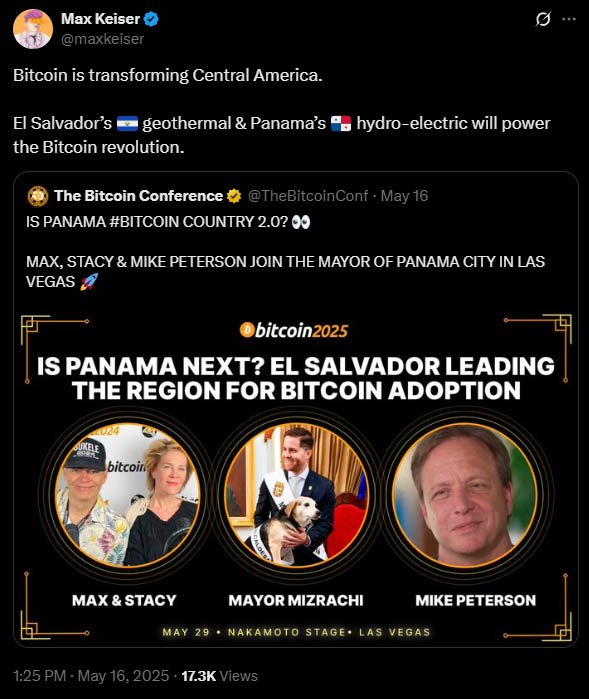
Max Keiser on X
Panama with its hydroelectric power could be a hub for green bitcoin mining.
Mizrachi has not announced a bitcoin reserve plan nor submitted a proposal to the National Assembly. But his post and public appearances suggest it’s being considered.
He will be speaking at the upcoming Bitcoin 2025 Conference in Las Vegas just days after his social media post. Many expect he will share more about Panama City’s bitcoin plans during his talk.
If Mizrachi pushes for a bitcoin reserve, he will need to work with national lawmakers to pass new legislation. So far, there is no evidence of that.
Even without a bitcoin reserve, Panama City is already going big on digital assets.
In April 2025, the city council approved a measure to allow residents to pay taxes, fees, fines and permits with digital currencies. Supported tokens are bitcoin (BTC), ethereum (ETH), USD Coin (USDC) and Tether (USDT).
To comply with financial laws, the city has partnered with a bank that instantly converts these digital assets into U.S. dollars. According to Mizrachi, this way it’s easier for residents to use digital assets and the city’s financial operations will be transparent and legal.
Another part of the meeting with El Salvador’s advisors was education.
Stacy Herbert confirmed that Panama City will be integrating El Salvador’s financial literacy book, “What is Money?” into their digital library system. The goal is to help students, teachers and the general public understand bitcoin and digital currencies in modern finance.
This is a trend in Latin America where countries are looking for alternatives to traditional banking systems. Inflation, economic instability and the rise of decentralized finance are forcing governments to look into new financial tools.
-
 @ cae03c48:2a7d6671
2025-05-28 21:01:56
@ cae03c48:2a7d6671
2025-05-28 21:01:56Bitcoin Magazine

US Senator Cynthia Lummis Discusses Bitcoin Reserve, Stablecoin Legislation, and Market Structure Bill at Bitcoin 2025 ConferenceAt the 2025 Bitcoin Conference in Las Vegas, U.S Senator Cynthia Lummis and CLO of Coinbase Paul Grewal discussed the market structure bill, stablecoin bill, future taxing system, bitcoin strategy reserve and bitcoin mining.
Cynthia Lummis started by commenting about the market structure bill and stablecoin bill.
“The market structure bills is probably more important to a lot of the people in this conference than the stablecoin bill because there are a lot of businesses, yours among them,” said Lummis. “There are businesses for people who either buy and hold, so they want a custodial service or there are companies that lend Bitcoin, there is a futures market for Bitcoin, there are so many ways in which Bitcoin can interface with fiat currency with the US dollar.”
Lummis also mentioned the tax system that she wants to implement and what her office has submitted to the finance committee.
“As the lighting network develops and companies like Strike sort of have been leaders in that space,” added Lummis. “Create an opportunity for transactions to occur on a daily basis in Bitcoin. Everything from buying a cup of coffee to dinner somewhere. It would be helpful that certain transactions of that size below 600 dollars per transaction, not be subject to taxation.”
During her speech, she went into detail on one the biggest problems lawmakers are facing against digital assets.
“Part of the problem in the last four years has been largely regulatory agencies that have been very hostile towards digital assets, so we are trying to change as fast as we can,” said Lummis. “It doesn’t happen overnight. We don’t even have a confirmed IRS director in place yet, so it is really hard to get these structural changes enacted by the rule makers at the IRS when there is no IRS commission yet in place.”
Ending the panel, Lummis addressed one of the biggest reasons the US government should get into Bitcoin.
“We are 37 trillion dollars in debt, so if we bought and held a million Bitcoin for 20 years it will cut that debt in half and we have underperforming assets that can be converted to Bitcoin without borrowing additional money. Bitcoin is such an important Global Strategic asset and it is not only important in the economy, but in our global defense because there are components to our defense. One is having a lethal war fighting machine that can overcome other armies, another military effort. Another one is having an economic machine that can overcome other currencies.” She continued, “Even our military generals say that bitcoin is an important deterrent to aggression from other countries, especially from China.”
This post US Senator Cynthia Lummis Discusses Bitcoin Reserve, Stablecoin Legislation, and Market Structure Bill at Bitcoin 2025 Conference first appeared on Bitcoin Magazine and is written by Oscar Zarraga Perez.
-
 @ b7274d28:c99628cb
2025-05-28 01:11:43
@ b7274d28:c99628cb
2025-05-28 01:11:43In this second installment of The Android Elite Setup tutorial series, we will cover installing the nostr:npub10r8xl2njyepcw2zwv3a6dyufj4e4ajx86hz6v4ehu4gnpupxxp7stjt2p8 on your #Android device and browsing for apps you may be interested in trying out.
Since the #Zapstore is a direct competitor to the Google Play Store, you're not going to be able to find and install it from there like you may be used to with other apps. Instead, you will need to install it directly from the developer's GitHub page. This is not a complicated process, but it is outside the normal flow of searching on the Play Store, tapping install, and you're done.
Installation
From any web browser on your Android phone, navigate to the Zapstore GitHub Releases page and the most recent version will be listed at the top of the page. The .apk file for you to download and install will be listed in the "Assets."

Tap the .apk to download it, and you should get a notification when the download has completed, with a prompt to open the file.

You will likely be presented with a prompt warning you that your phone currently isn't allowed to install applications from "unknown sources." Anywhere other than the Play Store is considered an "unknown source" by default. However, you can manually allow installation from unknown sources in the settings, which the prompt gives you the option to do.
In the settings page that opens, toggle it to allow installation from this source, and you should be prompted to install the application. If you aren't, simply go to your web browser's downloads and tap on the .apk file again, or go into your file browser app and you should find the .apk in your Downloads folder.

If the application doesn't open automatically after install, you will find it in your app drawer.

Home Page
Right at the top of the home page in the Zapstore is the search bar. You can use it to find a specific app you know is available in the Zapstore.

There are quite a lot of open source apps available, and more being added all the time. Most are added by the Zapstore developer, nostr:npub1wf4pufsucer5va8g9p0rj5dnhvfeh6d8w0g6eayaep5dhps6rsgs43dgh9, but some are added by the app developers themselves, especially Nostr apps. All of the applications we will be installing through the Zapstore have been added by their developers and are cryptographically signed, so you know that what you download is what the developer actually released.
The next section is for app discovery. There are curated app collections to peruse for ideas about what you may want to install. As you can see, all of the other apps we will be installing are listed in nostr:npub1wf4pufsucer5va8g9p0rj5dnhvfeh6d8w0g6eayaep5dhps6rsgs43dgh9's "Nostr" collection.

In future releases of the Zapstore, users will be able to create their own app collections.
The last section of the home page is a chronological list of the latest releases. This includes both new apps added to the Zapstore and recently updated apps. The list of recent releases on its own can be a great resource for discovering apps you may not have heard of before.

Installed Apps
The next page of the app, accessed by the icon in the bottom-center of the screen that looks like a clock with an arrow circling it, shows all apps you have installed that are available in the Zapstore. It's also where you will find apps you have previously installed that are ready to be updated. This page is pretty sparse on my test profile, since I only have the Zapstore itself installed, so here is a look at it on my main profile:

The "Disabled Apps" at the top are usually applications that were installed via the Play Store or some other means, but are also available in the Zapstore. You may be surprised to see that some of the apps you already have installed on your device are also available on the Zapstore. However, to manage their updates though the Zapstore, you would need to uninstall the app and reinstall it from the Zapstore instead. I only recommend doing this for applications that are added to the Zapstore by their developers, or you may encounter a significant delay between a new update being released for the app and when that update is available on the Zapstore.
Tap on one of your apps in the list to see whether the app is added by the developer, or by the Zapstore. This takes you to the application's page, and you may see a warning at the top if the app was not installed through the Zapstore.

Scroll down the page a bit and you will see who signed the release that is available on the Zapstore.

In the case of Primal, even though the developer is on Nostr, they are not signing their own releases to the Zapstore yet. This means there will likely be a delay between Primal releasing an update and that update being available on the Zapstore.
Settings
The last page of the app is the settings page, found by tapping the cog at the bottom right.

Here you can send the Zapstore developer feedback directly (if you are logged in), connect a Lightning wallet using Nostr Wallet Connect, delete your local cache, and view some system information.
We will be adding a connection to our nostr:npub1h2qfjpnxau9k7ja9qkf50043xfpfy8j5v60xsqryef64y44puwnq28w8ch wallet in part 5 of this tutorial series.
For the time being, we are all set with the Zapstore and ready for the next stage of our journey.
Continue to Part 3: Amber Signer. Nostr link: nostr:naddr1qqxnzde5xuengdeexcmnvv3eqgstwf6d9r37nqalwgxmfd9p9gclt3l0yc3jp5zuyhkfqjy6extz3jcrqsqqqa28qy2hwumn8ghj7un9d3shjtnyv9kh2uewd9hj7qg6waehxw309aex2mrp0yhxyunfva58gcn0d36zumn9wss80nug
-
 @ 21335073:a244b1ad
2025-05-09 13:56:57
@ 21335073:a244b1ad
2025-05-09 13:56:57Someone asked for my thoughts, so I’ll share them thoughtfully. I’m not here to dictate how to promote Nostr—I’m still learning about it myself. While I’m not new to Nostr, freedom tech is a newer space for me. I’m skilled at advocating for topics I deeply understand, but freedom tech isn’t my expertise, so take my words with a grain of salt. Nothing I say is set in stone.
Those who need Nostr the most are the ones most vulnerable to censorship on other platforms right now. Reaching them requires real-time awareness of global issues and the dynamic relationships between governments and tech providers, which can shift suddenly. Effective Nostr promoters must grasp this and adapt quickly.
The best messengers are people from or closely tied to these at-risk regions—those who truly understand the local political and cultural dynamics. They can connect with those in need when tensions rise. Ideal promoters are rational, trustworthy, passionate about Nostr, but above all, dedicated to amplifying people’s voices when it matters most.
Forget influencers, corporate-backed figures, or traditional online PR—it comes off as inauthentic, corny, desperate and forced. Nostr’s promotion should be grassroots and organic, driven by a few passionate individuals who believe in Nostr and the communities they serve.
The idea that “people won’t join Nostr due to lack of reach” is nonsense. Everyone knows X’s “reach” is mostly with bots. If humans want real conversations, Nostr is the place. X is great for propaganda, but Nostr is for the authentic voices of the people.
Those spreading Nostr must be so passionate they’re willing to onboard others, which is time-consuming but rewarding for the right person. They’ll need to make Nostr and onboarding a core part of who they are. I see no issue with that level of dedication. I’ve been known to get that way myself at times. It’s fun for some folks.
With love, I suggest not adding Bitcoin promotion with Nostr outreach. Zaps already integrate that element naturally. (Still promote within the Bitcoin ecosystem, but this is about reaching vulnerable voices who needed Nostr yesterday.)
To promote Nostr, forget conventional strategies. “Influencers” aren’t the answer. “Influencers” are not the future. A trusted local community member has real influence—reach them. Connect with people seeking Nostr’s benefits but lacking the technical language to express it. This means some in the Nostr community might need to step outside of the Bitcoin bubble, which is uncomfortable but necessary. Thank you in advance to those who are willing to do that.
I don’t know who is paid to promote Nostr, if anyone. This piece isn’t shade. But it’s exhausting to see innocent voices globally silenced on corporate platforms like X while Nostr exists. Last night, I wondered: how many more voices must be censored before the Nostr community gets uncomfortable and thinks creatively to reach the vulnerable?
A warning: the global need for censorship-resistant social media is undeniable. If Nostr doesn’t make itself known, something else will fill that void. Let’s start this conversation.
-
 @ 70c48e4b:00ce3ccb
2025-05-09 06:21:57
@ 70c48e4b:00ce3ccb
2025-05-09 06:21:57Dear reader,
HODLing was never the end goal.
HODLing Bitcoin is smart. It always has been. If you held through the Mt. Gox hacks, China bans, the 2017 Blocksize wars, the 2018 bloodbath, and the FTX clownery of 2022, then you already know. Bitcoin rewards conviction.
But let’s not forget why you got in.
It was never just about watching numbers go up. You felt something. Something deep. A quiet voice inside said, “This system is broken. I’m done playing by its rules.” - That is where it all began.
Back in 2008, while the banks were crashing the economy and handing you the bill, Bitcoin showed up as a silent answer. A lifeboat. A revolution wrapped in code.
The whitepaper starts with a simple, powerful idea: "A purely peer-to-peer version of electronic cash would allow online payments to be sent directly from one party to another without going through a financial institution."
https://plebsite.net/cdn/shop/files/Bitcoin_Whitepaper-Poster-3.jpg
And Bitcoin has lived up to that vision.
You saw it in El Salvador when they made it legal tender — even if they later made it optional. You saw it when WikiLeaks used Bitcoin after getting cut off by banks. You saw the Silk Road prove what peer-to-peer money really means. No matter what you think of those examples, one thing is clear: It worked. It was used. It still works.
Today, Bitcoin powers circular economies across the world — in Costa Rica, South Africa, Brazil, and beyond. People are using it because their local money fails them. Bitcoin became more than a store of value. It became a tool for survival and sovereignty.
https://imageio.forbes.com/specials-images/imageserve/67e422a1808f4902b8a1c6bc/Bitcoin-Ekasi-Center/960x0.jpg?format=jpg&width=1440
And now, look at you.
You believed early. You stacked. You held. And now, you have more Bitcoin than you ever imagined. Your needs are met. Your wants, too. You held through it all. And maybe now, you’ve found some stability, maybe even freedom. You stayed patient. You played the long game. You won.
So now the question is simple: What will your Bitcoin build?
Let me paint you a picture- Somewhere out there, there is a young soul maybe in Lagos, maybe in Buenos Aires, maybe right next door. This person might be working on a new privacy tool that protects free expression. Or developing a drone taxi system to change the way people move in growing cities. Or creating a decentralized alternative to platforms like Patreon, where no one is silenced for thinking differently.
They do not have powerful connections. They are not sitting in fancy offices or attending tech conferences. They are building quietly, with conviction and hope.
You can be the magical wand in their life. Your belief and support can turn someone's idea into something real. You can help create the next chapter of their story.
Angor allows you to do exactly that. It gives you a way to fund builders directly, using your Bitcoin. The process is safe and structured. You support projects in stages, and the funds only move forward when clear milestones are completed. Everything is on-chain, using Bitcoin scripts and time-locked contracts to ensure accountability.
This is how the ecosystem grows.
Where do you go now that HODLing was just the beginning?
Here’s what you do:
1. Check the Proposal
Go read the Angor docs. It’s not some bloated whitepaper. It’s clean, clear, and you’ll get it. Here’s the link - https://docs.angor.io/start/.
2. Join the Talk on Nostr
Nostr is where real, uncensored conversation is happening. It is decentralized and open by design. Use a client like Primal or Damus to dive in. Or check out nostr.band to explore what people are building and sharing across the network.
This is where ideas take shape. Builders post updates. Communities give feedback. The next wave of innovation is already in motion — and you can be part of it.
Follow Angor on Nostr: nostr:nprofile1qqs8p3ywfd92w7zvjgy7wrpylz8t30hy3z5dc5al4070l9y8qr8rejcksnh5c
3. Contribute
Whatever your skill is writing, design, coding, memes, Angor has room for you. Get on GitHub. Even if you just report a bug or suggest a feature, it helps. Or you could even fork the code and do as you wish.
4. Explore Angor Hub
This is the cockpit. It’s where you find new projects, track progress, talk to founders and make moves. Dive in. It’s live.
https://docs.angor.io/images/tools/hub.png
Final Thoughts
Bitcoin gave us the base layer. It proved that peer-to-peer money works. But that was just the beginning. Now it’s time to build the next layer together.
And no, this is not about another meme coin or a monkey NFT. This is about real infrastructure. Real value. Real use cases.
Angor is for the misfits, the dreamers, the people who read the whitepaper and said, “Yeah, this is the way.”
So if you have Bitcoin, do not treat it like a relic from a past battle. Use it to empower the next builder. Fund a project. Spark a new idea. Help decentralize the next thing.
You got into Bitcoin to protect your future maybe even to get rich but also to bring some change to the world.
HODLing was the first act.
Building is the second.
Angor is where we build.
Let’s make sure the next wave of Bitcoiners do not just see price charts. Let them see tools, apps, ideas, and communities that actually do something. Real things. Useful things. Built on the hardest money the world has ever known.
You in?
Thanks for reading, See y’all soon for another blog post. Ciao
Guest Post by nostr:npub1v67clmf4jrezn8hsz28434nc0y5fu65e5esws04djnl2kasxl5tskjmjjk
-
 @ 0e29efc2:ff142af2
2025-05-07 15:09:46
@ 0e29efc2:ff142af2
2025-05-07 15:09:46Table of Contents
- Intro
- Important Terminology
- Getting Started
- Where do I buy bitcoin?
- Okay, I bought some bitcoin-now what?
- Less than 0.01 BTC
- More than 0.01 BTC and less than 0.1 BTC
- More than 0.1 BTC
- How Bitcoin Works
- Skepticism
- Someone will hack it
- The government will try to stop it
- It’s not backed by anything
- Conclusion
Intro
Maybe you saw an article in Forbes, a news segment about MicroStrategy (MSTR), or you glanced at the bitcoin price chart; whatever the spark, your curiosity led you here. Enough friends and relatives keep asking me about bitcoin that I finally organized my thoughts into a single reference. This is not a comprehensive guide—it assumes you trust me as a heuristic.
Important Terminology
Sat (satoshi) – the smallest unit of bitcoin. One bitcoin (₿) equals 100 000 000 sats.
Getting Started
Where do I buy bitcoin?
I use River because it publishes proof‑of‑reserves, supports the Lightning Network, and pays interest on idle USD balances (currently 3.8 %).
Okay, I bought some bitcoin-now what?
Withdraw it immediately. Centralized exchanges can and do fail. Your next step depends on how much bitcoin you hold.
If at any point you're struggling, please reach out to me.
Less than 0.01 BTC
- On your phone open Safari (iOS) or Chrome (Android).
- Paste
https://wallet.cashu.me?mint=https://mint.westernbtc.com. Confirm the prompt that asks whether you trusthttps://mint.westernbtc.com. I run this mint so beginners can skip the gnarly parts. - Complete setup.
- Tap Receive → LIGHTNING → enter amount → COPY.
- In River choose Send → Send to a Bitcoin wallet, paste the invoice, verify, and send.
- Return to the wallet; your sats should appear.

More than 0.01 BTC and less than 0.1 BTC
It's time for cold storage. Cold storage means a dedicated signing device not connected to the internet. Think of it like keys to a house. If you have the keys (your cold storage signing device), you can get into your house (the bitcoin). I recommend and use the COLDCARD Q or COLDCARD MK4 from COLDCARD. See this thorough walkthrough.
The creator nostr:npub1rxysxnjkhrmqd3ey73dp9n5y5yvyzcs64acc9g0k2epcpwwyya4spvhnp8 makes reliable content.
More than 0.1 BTC
The next security upgrade involves something called multisig. It requires the use of multiple devices instead of one. Think of those nuclear launch silos in movies where two keys need to be turned in order to launch the missile. One person can't reach both keys, so you need two people. Like the two keys needing to be turned, we need a certain number of keys (signing devices) to be used.

This offers a number of benefits. Say you have a 2-of-3 multisig setup. You would need two of the three keys to move the bitcoin. If you were to lose one, you could use the two others to move it instead. Many choose to geographically distribute the keys; choosing to keep one at a friend’s house or with a bank.
The previous video I linked covers multisig as well. Again, please reach out to me if you need help.
How Bitcoin Works
I'm going to paint a scene portraying the basics of how bitcoin works. Picture a race that's supposed to take 10 minutes to run start-to-finish, and there's a crowd of people spectating. When the fastest runner crosses the finish line, they're awarded 50 bitcoin. Everyone in the crowd recognizes who won, and writes it down on their own scoreboard. Then, the next race begins.
Now, let's say more racers who've had special training join. They start winning consistently because of it, and now the race only lasts about 9 minutes. There's a special rule everyone in the crowd agreed to, that they can make the race harder to ensure it's around 10 minutes long. So they make the race harder to counteract the faster runners.

With this in mind, let's get to the skepticism you might have.
Skepticism
Someone will hack it
Think of bitcoin as the people in the crowd. If someone tries to cheat and writes on their scoreboard that they have a billion bitcoin, their scoreboard is going to look different than everybody else’s. The other people in the crowd will cross-reference with each other and decide to ignore that person who cheated.
The government will try to stop it
Again, think of the crowd. In reality, the "crowd participants" are scattered all around the world. You might be able to stop many of them, but it would be almost impossible to stop everyone. Imagine people are watching the race on TV, can you find everyone who's spectating? Ironically, attempted bans often increase interest.
It’s not backed by anything.
Think of the runners. The runners are bitcoin miners. They have to expend real energy to participate in the race. The more bitcoin miners, the more secure the network. In summary, it's backed by electricity and work.
Conclusion
There are too many topics to cover in one article. I haven't even touched on the history of money, what money is, scarcity, etc. The best way to learn is to research the topics you're interested in for yourself. It took months of deep diving before I was sold on bitcoin, and I had many touch points before that.
Once you see it though, you can't unsee it.
-
 @ 5188521b:008eb518
2025-05-06 08:09:37
@ 5188521b:008eb518
2025-05-06 08:09:37Macaron returns, fluffs his white linen napkin, and takes his seat at their table, “Thank you, John, for extending my French people such great mercy as to be allowed to transact freely on the Bitcoin blockchain.” He extends his arm out towards a waiter, “Monsieur? Champagne for the three of us please!”
Vrrrm! “I can’t believe we were able to find an American Mustang in this French countryside. I am ripping down these narrow roads!” John celebrates.
“Bloody hell, slow down!” Lily begs as her oversized diamond dangle earrings sway side to side. “You’ve got nothing to prove, John. Big man in your yankee ten-gallon hat. Let’s just get there safely.”
John slows to give her a smoldering look, “Aww, my sweet British compatriot, you care about me!”
“Bollocks! I care about not dying!” Lily retorts. “Now focus on the mission. We need to save a boatload of English border collies — literally. Frenchman Macaron wants to groom them into French poodles!”
John wags a finger off the wheel to reply in his Southern drawl, “However, my sweet Lily flower, my US Hash Force intends to project power to coerce the French for the dogs’ release!”
Lily bats his finger away, “Yes, but may I remind you, my arrogant wanker, geographically challenged friend, MI6’s intel says to steadily power on any miners as His Majesty’s Hash Force may do. The border collies’ barge will take about an hour to flee France, cross the English channel, and safely reach our shores so we don’t want to burst their souffle too quickly. Oh, and the barge is armed with explosives controlled by a remote detonator. When Macaron asks for his bitcoin ransom payment in exchange for the dogs’ release, how do you cowboys plan to help from across the pond?”
John takes both hands off the wheel to flex his biceps, “Shock and awe, Lily. Full Throttle! We’re not giving the French a single sat. Instead, we’re diverting maximum energy to the U.S. Hash Force, of course!”
Lily guffaws, “And where is this sudden surge of readily available power supposed to come from undetected?”
“No need to worry my English crumpet! Our back of the envelope calculations suggest that, with a little help from the Texas of the North, there’s enough flared natural gas in the U.S. to run the entire Bitcoin network!” John proudly replies.
Lily’s jaw drops, “So miners have already stealthily built out the infrastructure to capture wasted natural gas flares for the benefit of the U.S. government, but are waiting to turn them on until commanded to by the U.S. Hash Force?!”
“Yup! As soon as Macaron sees our hash power come online, we’re going to try to start mining blocks on the Bitcoin network to Denial of Service (DOS) attack any UTXOs with a known history of French transactions.”
“A DOS attack, for peace?” Lily asks skeptically.
“Peace through strength, baby! If you don’t comply with America’s dog rights standards, you get censored. America saves British dogs again, and without a single shot fired!”
“Not fair! It’s only because our MI6 chainanalysis intel knows which Bitcoin addresses to censor on the blockchain we suspect belong to Macaron and his government that this plan even has a shot at succeeding. You’re lucky Macaron is even more self-assured than you Americans. That’s the only reason France doesn’t have a Hash Force of its own to project power back!”
John pulls the Mustang up to the front of the fancy French restaurant, Chandelier. Lily grabs her green purse that matches her elegant emerald ball gown, and they head inside to meet Macaron.
John and Lily spot Macaron sitting alone at the white linen table closest to the dance floor. He’s tapping his Louis Vuitton snake leather shoes, checking his Chanel watch, and fluffing his floofy black French Hermès beret. The red French ascot spilling out of his black and white blouse looks ridiculous.
John lets out a big sigh, and Macaron stands with open arms, “Lily, John, welcome to France!” Before John can flinch away, Macaron kisses him on both cheeks. He lifts up Lily’s hand for a kiss, “Mademoiselle.”
John raises his hand, “Waiter! I’ll take a bourbon, neat. And make it a double!” John calls out.
Slap!
“Hey, what was that for, Frenchie?” John asks as he rubs his face.
“Rude American, where are your manners?” Macaron asks as he pulls out a hidden red detonator clipped in the folds of his ascot. “Don’t drive me to prematurely push this button and blow up the boat carrying your English doggies! First, send me my bitcoin ransom payment. Then we can celebrate with drinks!” Macaron demands.
“In your dreams, Frenchie!” John presses his finger to his ear, “Uniform, Sierra, Alpha!”
Macaron turns to Lily and scoffs, “What is this rude American man doing, Lily?”
Annoyed, Lily answers, “Check your bitcoin UTXOs. Notice anything?”
Macaron frantically queries his Bitcoin node remotely from his cellphone and breathes a sigh of relief, “Phew. No, I don’t notice anything at all. All of my unspent bitcoin is still under the control of my government’s private key.”
“And it’ll stay that way, too!” John beats his chest. “You mess with the US, and you get the Hash Force! We just secretly doubled the difficulty to mine a block by turning on all of our miners — as many miners as the entire existing Bitcoin network! Now you’ll have to wait twice as long for your French bitcoin transactions to confirm! That is, unless you release the barge of dogs right now!”
Lily drops down to the table and buries her face in her palms to hide her embarrassment.
Flustered, Macaron furiously types out a long text message with the order to release the barge of English Border Collies to cross the English channel. “There, I’ve let the dogs out! Will you two please excuse me for a moment? I have to place a call with my government to confirm we haven’t lost our property rights to spend our bitcoin.
Beaming with pride, John falls back into his chair at the table. “We did it, Lily! Quick, give the command for His Majesty’s Hash Force to power on so we can 51% attack this guy!”
Lily finally stops rubbing her eyes, “John, that isn’t how any of this works!”
“What do you mean?” he asks.
“Within a 2,016 block difficulty adjustment period, doubling the hash power means the global Bitcoin network will mine new blocks twice as fast, not slower! At least, until the 2,016 block period ends and the difficulty adjusts so miners resume taking on average 10 minutes to generate a valid block. And sure, maybe the US has a political incentive to not collect the fees of any transactions of UTXOs with a known French association, but the rest of the network’s miners will happily profit from the sats you leave in the mempool! But most of all, the Bitcoin network is now just twice as secure from attack!”
John’s double bourbon finally arrives at the table. Selfishly focused on his own glass, he doesn’t bother to stop the waiter in case Lily wants to order a drink of her own. He drinks a big gulp, “But if you give the order for His Majesty’s Hash Force to power on, won’t we have over 51% of the hash power of the Bitcoin network? We can write Macaron’s bitcoin out of existence!”
Lily crosses her arms, “Not exactly. It’s not enough to just surpass half the hashrate. We also need to maintain a higher hashrate than the legacy chain to generate more chain weight to then reorg the other chain when we join the legacy network. We would have to be mining this heavier chain in secret, but in one bombastic order you just completely blew apart our whole plan! Now we’d need some sort of massive collusion somehow between existing miners, and some secret stealth miners, to have any power projection.”
John mutters under his breath, “Frenchie’s been gone a long time. Wonder what he’s up to….”
Macaron returns, fluffs his white linen napkin, and takes his seat at their table, “Thank you, John, for extending my French people such great mercy as to be allowed to transact freely on the Bitcoin blockchain.” He extends his arm out towards a waiter, “Monsieur? Champagne for the three of us please!” Macaron turns to John and Lily, “After my phone call, I am in much better spirits. Though I’m bitter you denied paying our bitcoin ransom, I’m grateful you’re furthering the security of the Bitcoin network.”
In his excitement, Macaron leans forward and claps his hands together, “You two are so lucky to be dining with me tonight. You won’t have to drink that sparkling-wine-swill you have in your home countries. Tonight, you’ll get to have proper champagne, from the Champagne region of France — my treat!”
John grunts in disgust, “Macaron, you can order champagne, but I’ve got my bourbon.”
Lily steps on John’s foot, “Ow! What was that for?” John shrieks.
“Aren’t you going to ask me if I want anything?” Lily asks.
“Huh?” John replies confusedly.
Macaron takes Lily’s hand, “Mademoiselle, in addition to champagne, can I get you anything else?”
Lily recoils her hand back, “Gin martini. Shaken, not stirred.”
“Lily, may I ask you another question?” Macaron asks sweetly.
“Bloody hell, what is it, Macaron?” she responds while rolling her eyes.
“Why do I get the feeling that forgetting to ask you what you’d like to drink isn’t the first time John has neglected to ask you what you wanted?”
Lily’s eyes light up as she leans in closer to Macaron, “Why, yes. This isn’t the first time John’s ever disregarded my needs. You know, he’s always only thinking about himself, his own ego, and he never misses a chance to interrupt me—”
“—That’s not true!” John interrupts.
Lily kicks him under the table, “See what I mean?”
Macaron whisks Lily’s hair behind her ear, “You have such beautiful earrings, Lily. Did John buy those for you?”
“No, John never buys me anything.”
“What do you mean?” John protests.
Lily shrugs him off and Macaron leans in closer to Lily to whisper just loud enough for John to hear, “You know, in my country, men like me know how to show a lady respect.”
John stands up and extends out his hand, “C’mon, Lily. I think it’s time I take you out onto the floor for a dance.”
She shakes her head, so he stomps on her feet under the table.
“Ow!” Lily shrieks.
“I insist,” John presses. “They’re playing my song, Don’t Stop Believin’. C’mon!”
On the dance floor, John pulls Lily close to whisper in her ear, “What are you doing? We’ve finished our mission. Let’s ensure the dogs safely cross the English channel and get out of here! The way you’re flirting with him we’ll never leave!”
Lily blushes, “John, are you that blind? If Macaron is suddenly being sweet to us, then he must be scheming something.”
“What’s that supposed to mean?” John shakes his head. “Look, there’s no time to argue. We can’t risk him blowing up the barge as long as he’s got that remote detonator clipped to his ascot! He’s in a jubilant mood for now, but those French can be so melodramatic. We’ve got to get the detonator to ensure the safety of the dogs until they reach safe harbor at your shores.”
John’s box step dancing pace quickens as he looks over to check on Macaron. He spots him placing an order with the waiter and grits his teeth, “He’s pure evil. He was willing to kill the English border collies if he didn’t get ransom payment for not grooming them into French poodles. Only the threat of our Hash Force forced him to comply with our demand for their release!”
Lily breaks away from John to do a twirl on the dance floor; her elegant flowy green dress tries to keep up. She flips her hair and winks at Macaron, “Maybe I should flirt with him some more? After all, he’s so handsome — and he listens to me!”
John stops dancing and stomps his feet.
“Aww, are you jealous, John?” Lily asks.
“Jealous?!”
Lily floats back to John, digs her nails into the back of his neck, and nibbles on his ear as she whispers, “John, you better dip me on this dance floor! Otherwise, I’m going to ask him to draw me like one of his French girls. C’mon John, Don’t stop believin’!”
Ahem Macaron clears his throat, adjusts his detonator-pinned ascot, and taps Lily on the shoulder.
“Mademoiselle, may I have this dance?”
“Oh, certainly,” she replies. “Better than this brute with two left feet!”
John grunts in dissatisfaction and bolts back to the table.
With Macaron distracted dancing with Lily for what feels like an eternity, John defiantly presses his finger to his ear. “MI6 — status report. What’s taking so long?” he mutters under his breath. “I hate seeing this Frenchie dance with an English lass who deserves so much better. It’s driving me crazy!”
“You just gotta distract him from detonation for ten more minutes,” a British accent replies. “Intel shows the puppy barge armed with explosives has almost reached us across the channel, and then we can safely disarm it.”
“USHF, come in,” John queries.
“We’ve got trouble! The global energy grid has spiked along the Asian seaboard, and among the French alps. Looks like a secret French Hash Force we’ve never detected is colluding with the existing Chinese, Japanese, and Tibetan miners!
They’ve stopped including American-linked bitcoin address transactions in their blocks! Can you politely get him to back down? We’ve already played our power-projection show-of-force card!”
“Ok, I’ll do my best to play nice with Frenchie, but no promises!” John cautions. As he watches Lily and Macaron dance with disdain, a waiter approaches him at the table.
“Here you are, monsieur. Your appetizer.”
“Appetizer? I didn’t order an appetizer! All I ordered was this bourbon.”
“I’m sorry monsieur, but the other gentleman of your party insists. He said he offers this delicacy as a gift. A token of appreciation for the mercy demonstrated today by you, the quote Big American Man enquote.”
John looks on the dance floor and sees Macaron give him a nod with a big wiley grin. Lily gives him the “go-ahead” signal, so John pops one of the hot slimy appetizer balls into his mouth.
“Mhmm! These are tastier than Ma’s Frito Pie!” he shouts as Macaron and Lily walk over to join him back at the table. John continues, “These remind me of the Rocky Mountain oysters we have back at home! Of course, I’m grateful they aren’t, if you know what I mean. What are they, anyways?”
“Escargot,” the Frenchman replies, “a local specialty.”
“Escar-what-now?” John asks.
“Snails!” Lily clarifies.
John gags and spits his half-eaten snail onto the floor. He stands up and slams his ten-gallon cowboy hat on the table. “Ok, that’s it! I’ve had enough! Macaron, stop playing nice. We know you’ve activated some secret alliance with the miners on the other side of the globe! What’re you up to?”
“John, don’t upset him! Think about the puppies!” Lily pleads.
“To heck with the puppies! I’m not letting this man stand up a Hash Force to DOS attack us! You hear that, Macaron? You mess with the best, and we’ll use kinetic force against your miners stashed in the caves of the French alps!” Tsk! Tsk! Tsk! Macaron wags his finger, and pulls out the detonator switch clipped to his ascot.
“Silly pompous American, did you forget I still have the detonator? Did you really think I was going to let you get away with rescuing your hideous English border collies? Life is one giant power projection game, and the way nation states survive is by mutually assured preservation. In exchange for taming the unwieldy fur of Tibetan Mastiffs, Chinese Chow Chows, and Japanese Shih-Tzu and Shiba Inus, these countries pledged their miners to our stealthy French Hash Force when we’re in need. Well, thanks to your little stunt, not only did I find the perfect opportunity to project power back at you arrogant Americans, but also dump these hideous dogs given to me onto your barge, so they’re the British Isles’ problem now!”
“But we’ll be overrun by doges!” Lily gasps in horror.
“Yes, Lily! That’s what you get for partnering with John! What do Americans say?” Macaron asks rhetorically. “That’s right, ‘No dogs left behind!’ But most of all, John, I just wanted one last dance with your girlfriend, and to watch you eat snails!” French nasally honking laughing sounds
Lily shouts back, “I’m not his girlfriend!” She pulls a whistle out of her purse and blows it as hard as she can, but it doesn’t make a sound. John looks at her confused, and Macaron honks even harder. The whole restaurant starts to rumble, and the chandeliers sway from the ceiling.
“What’s this!?” Macaron shouts.
Gradually, then suddenly a stampede of bulldogs comes barreling into the dining room, knocking over all the tables, and tackling Macaron! As he falls, the detonator gets knocked into the air, and Lily catches it just before it hits the floor.
John looks at her, bewildered, and stammers, “You…. you let the Bitcoin dogs out??”
“You think you wankers got all the tricks? The English have a few surprises too! Now c’mon, let’s flee out the back in my British Mini Cooper. And this time, I’m driving!”
Will Schoellkopf is the author of two books: Bitcoin Girl Save the World and The Bitcoin Dog: Following the Scent to the Bitcoin C++ Source Code. He hosts the Bitcoin podcast It’s So Early! and publishes a weekly newsletter, featuring his favorite Bitcoin Posts of the Week, at realbitcoindog.com. His work has appeared in the anthology 21 Futures: Tales from the Timechain, in print at Bitcoin Magazine, Citadel21, Stackchain Magazine and online at Satoshi’s Journal. Follow him on Nostr and X @realBitcoinDog, or email will@realbitcoindog.com
-
 @ d61f3bc5:0da6ef4a
2025-05-06 01:37:28
@ d61f3bc5:0da6ef4a
2025-05-06 01:37:28I remember the first gathering of Nostr devs two years ago in Costa Rica. We were all psyched because Nostr appeared to solve the problem of self-sovereign online identity and decentralized publishing. The protocol seemed well-suited for textual content, but it wasn't really designed to handle binary files, like images or video.
The Problem
When I publish a note that contains an image link, the note itself is resilient thanks to Nostr, but if the hosting service disappears or takes my image down, my note will be broken forever. We need a way to publish binary data without relying on a single hosting provider.
We were discussing how there really was no reliable solution to this problem even outside of Nostr. Peer-to-peer attempts like IPFS simply didn't work; they were hopelessly slow and unreliable in practice. Torrents worked for popular files like movies, but couldn't be relied on for general file hosting.
Awesome Blossom
A year later, I attended the Sovereign Engineering demo day in Madeira, organized by Pablo and Gigi. Many projects were presented over a three hour demo session that day, but one really stood out for me.
Introduced by hzrd149 and Stu Bowman, Blossom blew my mind because it showed how we can solve complex problems easily by simply relying on the fact that Nostr exists. Having an open user directory, with the corresponding social graph and web of trust is an incredible building block.
Since we can easily look up any user on Nostr and read their profile metadata, we can just get them to simply tell us where their files are stored. This, combined with hash-based addressing (borrowed from IPFS), is all we need to solve our problem.
How Blossom Works
The Blossom protocol (Blobs Stored Simply on Mediaservers) is formally defined in a series of BUDs (Blossom Upgrade Documents). Yes, Blossom is the most well-branded protocol in the history of protocols. Feel free to refer to the spec for details, but I will provide a high level explanation here.
The main idea behind Blossom can be summarized in three points:
- Users specify which media server(s) they use via their public Blossom settings published on Nostr;
- All files are uniquely addressable via hashes;
- If an app fails to load a file from the original URL, it simply goes to get it from the server(s) specified in the user's Blossom settings.
Just like Nostr itself, the Blossom protocol is dead-simple and it works!
Let's use this image as an example:
 If you look at the URL for this image, you will notice that it looks like this:
If you look at the URL for this image, you will notice that it looks like this:blossom.primal.net/c1aa63f983a44185d039092912bfb7f33adcf63ed3cae371ebe6905da5f688d0.jpgAll Blossom URLs follow this format:
[server]/[file-hash].[extension]The file hash is important because it uniquely identifies the file in question. Apps can use it to verify that the file they received is exactly the file they requested. It also gives us the ability to reliably get the same file from a different server.
Nostr users declare which media server(s) they use by publishing their Blossom settings. If I store my files on Server A, and they get removed, I can simply upload them to Server B, update my public Blossom settings, and all Blossom-capable apps will be able to find them at the new location. All my existing notes will continue to display media content without any issues.
Blossom Mirroring
Let's face it, re-uploading files to another server after they got removed from the original server is not the best user experience. Most people wouldn't have the backups of all the files, and/or the desire to do this work.
This is where Blossom's mirroring feature comes handy. In addition to the primary media server, a Blossom user can set one one or more mirror servers. Under this setup, every time a file is uploaded to the primary server the Nostr app issues a mirror request to the primary server, directing it to copy the file to all the specified mirrors. This way there is always a copy of all content on multiple servers and in case the primary becomes unavailable, Blossom-capable apps will automatically start loading from the mirror.
Mirrors are really easy to setup (you can do it in two clicks in Primal) and this arrangement ensures robust media handling without any central points of failure. Note that you can use professional media hosting services side by side with self-hosted backup servers that anyone can run at home.
Using Blossom Within Primal
Blossom is natively integrated into the entire Primal stack and enabled by default. If you are using Primal 2.2 or later, you don't need to do anything to enable Blossom, all your media uploads are blossoming already.
To enhance user privacy, all Primal apps use the "/media" endpoint per BUD-05, which strips all metadata from uploaded files before they are saved and optionally mirrored to other Blossom servers, per user settings. You can use any Blossom server as your primary media server in Primal, as well as setup any number of mirrors:
 ## Conclusion
## ConclusionFor such a simple protocol, Blossom gives us three major benefits:
- Verifiable authenticity. All Nostr notes are always signed by the note author. With Blossom, the signed note includes a unique hash for each referenced media file, making it impossible to falsify.
- File hosting redundancy. Having multiple live copies of referenced media files (via Blossom mirroring) greatly increases the resiliency of media content published on Nostr.
- Censorship resistance. Blossom enables us to seamlessly switch media hosting providers in case of censorship.
Thanks for reading; and enjoy! 🌸
-
 @ bf47c19e:c3d2573b
2025-05-28 19:59:23
@ bf47c19e:c3d2573b
2025-05-28 19:59:23Originalni tekst na dvadesetjedan.com
Autor: Vijay Boyapati / Prevod na hrvatski: Matija
Sa zadnjim cijenama koje je bitcoin dosegao 2017., optimističan scenarij za ulagače se možda čini toliko očitim da ga nije potrebno niti spominjati. Alternativno, možda se nekome čini glupo ulagati u digitalnu vrijednost koja ne počiva na nijednom fizičkom dobru ili vladi i čiji porast cijene su neki usporedili sa manijom tulipana ili dot-com balonom. Nijedno nije točno; optimističan scenarij za Bitcoin je uvjerljiv, ali ne i očit. Postoje značajni rizici kod ulaganja u Bitcoin, no, kao što planiram pokazati, postoji i ogromna prilika.
Geneza
Nikad u povijesti svijeta nije bilo moguće napraviti transfer vrijednosti među fizički udaljenim ljudima bez posrednika, poput banke ili vlade. 2008. godine, anonimni Satoshi Nakamoto je objavio 8 stranica rješenja na dugo nerješivi računalski problem poznat kao “Problem Bizantskog Generala.” Njegovo rješenje i sustav koji je izgradio - Bitcoin - dozvolio je, prvi put ikad, da se vrijednost prenosi brzo i daleko, bez ikakvih posrednika ili povjerenja. Implikacije kreacije Bitcoina su toliko duboke, ekonomski i računalski, da bi Nakamoto trebao biti prva osoba nominirana za Nobelovu nagradu za ekonomiju i Turingovu nagradu.
Za ulagače, važna činjenica izuma Bitcoina (mreže i protokola) je stvaranje novog oskudnog digitalnog dobra - bitcoina (monetarne jedinice). Bitcoini su prenosivi digitalni “novčići” (tokeni), proizvedeni na Bitcoin mreži kroz proces nazvan “rudarenje” (mining). Rudarenje Bitcoina je ugrubo usporedivo sa rudarenjem zlata, uz bitnu razliku da proizvodnja bitcoina prati unaprijed osmišljeni i predvidivi raspored. Samo 21 milijun bitcoina će ikad postojati, i većina (2017., kada je ovaj tekst napisan) su već izrudareni. Svake četiri godine, količina rudarenih bitcoina se prepolovi. Produkcija novih bitcoina će potpuno prestati 2140. godine.
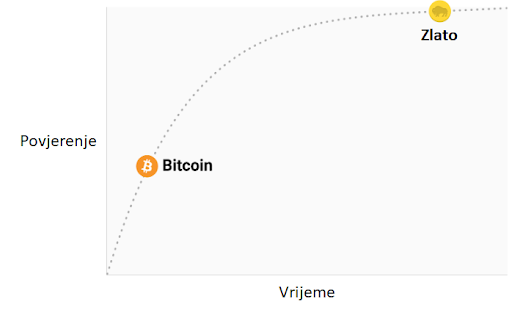 Stopa inflacije —— Monetarna baza
Stopa inflacije —— Monetarna bazaBitcoine ne podržava nikakva roba ili dobra, niti ih garantira ikakva vlada ili firma, što postavlja očito pitanje za svakog novog bitcoin ulagača: zašto imaju uopće ikakvu vrijednost? Za razliku od dionica, obveznica, nekretnina ili robe poput nafte i žita, bitcoine nije moguće vrednovati koristeći standardne ekonomske analize ili korisnost u proizvodnji drugih dobara. Bitcoini pripadaju sasvim drugoj kategoriji dobara - monetarnih dobara, čija se vrijednost definira kroz tzv. teoriju igara; svaki sudionik na tržištu vrednuje neko dobro, onoliko koliko procjenjuje da će ga drugi sudionici vrednovati. Kako bismo bolje razumjeli ovo svojstvo monetarnih dobara, trebamo istražiti podrijetlo novca.
Podrijetlo novca
U prvim ljudskim društvima, trgovina među grupama se vršila kroz robnu razmjenu. Velika neefikasnost prisutna u robnoj razmjeni je drastično ograničavala količinu i geografski prostor na kojem je bila moguća. Jedan od najvećih problema sa robnom razmjenom je problem dvostruke podudarnosti potražnje. Uzgajivač jabuka možda želi trgovati sa ribarom, ali ako ribar ne želi jabuke u istom trenutku, razmjena se neće dogoditi. Kroz vrijeme, ljudi su razvili želju za čuvanjem određenih predmeta zbog njihove rijetkosti i simbolične vrijednosti (npr. školjke, životinjski zube, kremen). Zaista, kako i Nick Szabo govori u svojem izvrsnom eseju o podrijetlu novca, ljudska želja za sakupljanjem predmeta pružila je izraženu evolucijsku prednost ranom čovjeku nad njegovim najbližim biološkim rivalom, neandertalcem - Homo neanderthalensis.
"Primarna i najbitnija evolucijska funkcija sakupljanja bila je osigurati medij za čuvanje i prenošenje vrijednosti".
Predmeti koje su ljudi sakupljali služili su kao svojevrsni “proto-novac,” tako što su omogućavale trgovinu među antagonističkim plemenima i dozvoljavale bogatsvu da se prenosi na sljedeću generaciju. Trgovina i transfer takvih predmeta bile su rijetke u paleolitskim društvima, te su oni služili više kao “spremište vrijednosti” (store of value) nego kao “medij razmjene” (medium of exchange), što je uloga koju danas igra moderni novac. Szabo objašnjava:
"U usporedbi sa modernim novcem, primitivan novac je imao jako malo “brzinu” - mogao je promijeniti ruke samo nekoliko puta u životu prosječnog čovjeka. Svejedno, trajni i čvrsti sakupljački predmet, što bismo danas nazvali “nasljeđe,” mogao je opstati mnogo generacija, dodajući znatnu vrijednost pri svakom transferu - i zapravo omogućiti transfer uopće".
Rani čovjek suočio se sa bitnom dilemom u teoriji igara, kada je odlučivao koje predmete sakupljati: koje od njih će drugi ljudi željeti? Onaj koji bi to točno predvidio imao bi ogromnu prednost u mogućnosti trgovine i akvizicije bogatsva. Neka američka indijanska plemena, npr. Naraganseti, specijalizirala su se u proizvodnji sakupljačkih dobara koja nisu imala drugu svrhu osim trgovine. Valja spomenuti da što je ranije predviđanje da će neko dobro imati takvu vrijednost, veća je prednost koju će imati onaj koji je posjeduje, zato što ju je moguće nabaviti jeftinije, prije nego postane vrlo tražena roba i njezona vrijednost naraste zajedno sa populacijom. Nadalje, nabava nekog dobra u nadi da će u budućnosti biti korišteno kao spremište vrijednosti, ubrzava upravo tu primjenu. Ova cirkularnost je zapravo povratna veza (feedback loop) koja potiče društva da se rapidno slože oko jednog spremišta vrijednosti. U terminima teorije igara, ovo je znano kao “Nashov ekvilibrij.” Postizanje Nashovog ekvilibrija za neko spremište vrijednosti je veliko postignuće za društvo, pošto ono znatno olakšava trgovinu i podjelu rada, i time omogućava napredak civilizacije.

Tisućljećima, kako su ljudska društva rasla i otvarala trgovinske puteve, različite aplikacije spremišta vrijednosti u individualnim društvima počele su se natjecati međusobno. Trgovci su imali izbor: čuvati svoju zaradu u spremištu vrijednosti vlastite kulture, ili one kulture sa kojom su trgovali, ili mješavini oboje. Benefit štednje u stranom spremištu vrijednosti bila je uvećana sposobnost trgovanja u povezanom stranom društvu. Trgovci koji su štedili u stranom spremištu vrijednosti su također imali dobrih razloga da potiču svoje društvo da ga prihvati, jer bi tako uvećali vrijednost vlastite ušteđevine. Prednosti “uvezene” tehnologije spremanja vrijednosti bile su prisutne ne samo za trgovce, nego i za sama društva. Kada bi se dvije grupe konvergirale u jedinstvenom spremištu vrijednosti, to bi značajno smanjilo cijenu troškova trgovine jednog s drugim, i samim time povećanje bogatstva kroz trgovinu. I zaista, 19. stoljeće bilo je prvi put da je najveći dio svijeta prihvatio jedinstveno spremište vrijednosti - zlato - i u tom periodu vidio najveću eksploziju trgovine u povijesti svijeta. O ovom mirnom periodu, pisao je John Maynard Keynes:
"Kakva nevjerojatna epizoda u ekonomskom napretku čovjeka… za svakog čovjeka iole iznadprosječnog, iz srednje ili više klase, život je nudio obilje, ugodu i mogućnosti, po niskoj cijeni i bez puno problema, više nego monarsima iz prethodnih perioda. Stanovnik Londona mogao je, ispijajući jutarnji čaj iz kreveta, telefonski naručiti razne proizvode iz cijele Zemlje, u količinama koje je želio, i sa dobrim razlogom očekivati njihovu dostavu na svoj kućni prag."
Svojstva dobrog spremišta vrijednosti
Kada se spremišta vrijednosti natječu jedno s drugim, specifična svojstva rade razliku koja daje jednom prednost nad drugim. Premda su mnoga dobra u prošlosti korištena kao spremišta vrijednosti ili kao “proto-novac,” određena svojstva su se pokazala kao posebno važna, i omogućila dobrima sa njima da pobijede. Idealno spremište vrijednosti biti će:
- Trajno: dobro ne smije biti kvarljivo ili lako uništeno. Tako naprimjer, žito nije idealno spremište vrijednosti.
- Prenosivo: dobro mora biti lako transportirati i čuvati, što omogućuje osiguranje protiv gubitka ili krađe i dopušta trgovinu na velike udaljenosti. Tako, krava je lošije spremište vrijednosti od zlatne narukvice.
- Zamjenjivo: jedna jedinica dobra treba biti zamjenjiva sa drugom. Bez zamjenjivosti, problem podudarnosti želja ostaje nerješiv. Time, zlato je bolje od dijamanata, jer su oni nepravilni u obliku i kvaliteti.
- Provjerljivo: dobro mora biti lako i brzo identificirano i testirano za autentičnost. Laka provjera povećava povjerenje u trgovini i vjerojatnost da će razmjena biti dovršena.
- Djeljivo: dobro mora biti lako djeljivo na manje dijelove. Premda je ovo svojstvo bilo manje važno u ranim društvima gdje je trgovina bila rijetka, postalo je važnije sa procvatom trgovine. Količine koje su se mijenjale postale su manje i preciznije.
- Oskudno: Monetarno dobro mora imati “cijenu nemoguću za lažirati,” kao što je rekao Nick Szabo. Drugim riječima, dobro ne smije biti obilno ili lako dostupno kroz proizvodnju. Oskudnost je možda i najvažnije svojstvo spremišta vrijednosti, pošto se izravno vezuje na ljudsku želju da sakupljamo ono što je rijetko. Ona je izvor vrijednosti u spremištu vrijednosti.
- Duge povijesti: što je dulje neko dobro vrijedno za društvo, veća je vjerojatnost da će biti prihvaćeno kao spremište vrijednosti. Dugo postojeće spremište vrijednosti biti će jako teško uklonjeno od strane došljaka, osim u slučaju sile (ratno osvajanje) ili ako je nova tehnologija znatno bolja u ostalim svojstvima.
- Otporno na cenzuru: novije svojstvo, sve više važno u modernom digitalnom svijetu sa sveprisutnim nadzorom, je otpornost na cenzuru. Drugim riječima, koliko je teško da vanjski agent, kao korporacija ili država, spriječi vlasnika dobra da ga čuva i koristi. Dobra koja su otporna na cenzuru su idealna za ljude koji žive u režimima koji prisilno nadziru kapital ili čine neke oblike mirne trgovine protuzakonitima.
Ova tablica ocjenjuje Bitcoin, zlato (gold) i fiat novac (kao što je euro ili dolar) po svojstvima izlistanim gore. Objašnjenje svake ocjene slijedi nakon tablice.
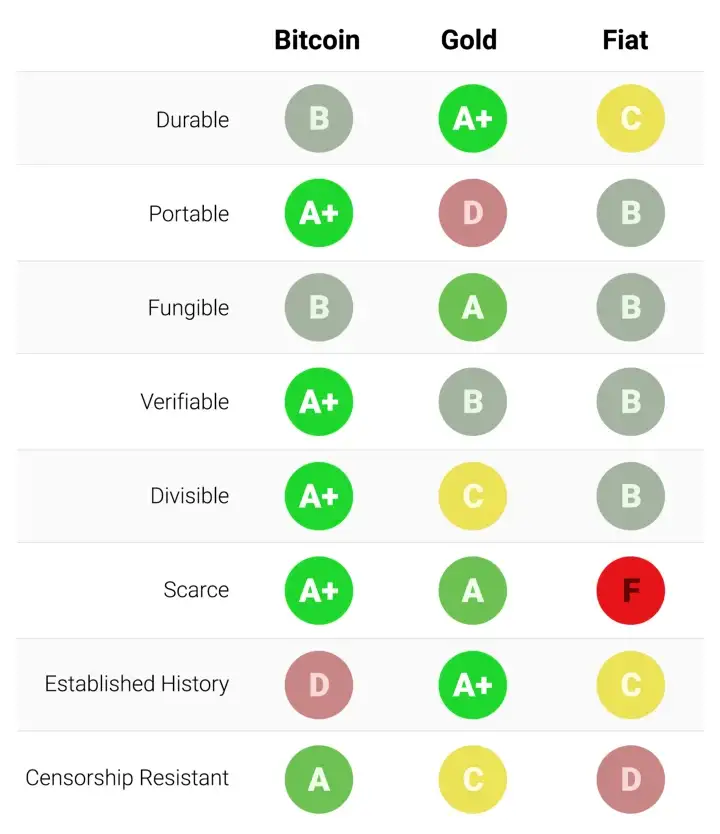
Trajnost:
Zlato je neosporeni kralj trajnosti. Velika većina zlata pronađenog kroz povijest, uključujući ono egipatskih faraona, opstaje i danas i vjerojatno će postojati i za tisuću godina. Zlatnici korišteni u antičko doba imaju značajnu vrijednost i danas. Fiat valute i bitcoini su digitalni zapisi koji ponekad imaju fizički oblik (npr. novčanice). Dakle, njihovu trajnost ne određuju njihova fizička svojstva (moguće je zamijeniti staru i oštećenu novčanicu za novu), nego institucije koje stoje iza njih. U slučaju fiat valuta, mnoge države su nastale i nestale kroz stoljeća, i valute su nestale s njima. Marke iz Weimarske republike danas nemaju vrijednost zato što institucija koja ih je izdavala više ne postoji. Ako je povijest ikakav pokazatelj, ne bi bilo mudro smatrati fiat valute trajnima dugoročno; američki dolar i britanska funta su relativne anomalije u ovom pogledu. Bitcoini, zato što nemaju instituciju koja ih održava, mogu se smatrati trajnima dok god mreža koja ih osigurava postoji. Obzirom da je Bitcoin još uvijek mlada valuta, prerano je za čvrste zaključke o njegovoj trajnosti. No, postoje ohrabrujući znakovi - prominente države su ga pokušavale regulirati, hakeri ga napadali - usprkos tome, mreža nastavlja funkcionirati, pokazujući visok stupanj antifragilnosti.
Prenosivost:
Bitcoini su najprenosivije spremište vrijednosti ikad. Privatni ključevi koji predstavljaju stotine milijuna dolara mogu se spremiti na USB drive i lako ponijeti bilo gdje. Nadalje, jednako velike sume mogu se poslati na drugi kraj svijeta skoro instantno. Fiat valute, zbog svojeg temeljno digitalnog oblika, su također lako prenosive. Ali, regulacije i kontrola kapitala od strane države mogu ugroziti velike prijenose vrijednosti, ili ih usporiti danima. Gotovina se može koristiti kako bi se izbjegle kontrole kapitala, ali onda rastu rizik čuvanja i cijena transporta. Zlato, zbog svojeg fizičkog oblika i velike gustoće, je najmanje prenosivo. Nije čudo da većina zlatnika i poluga nikad ne napuste sefove. Kada se radi prijenos zlata između prodavača i kupca, uglavnom se prenosi samo ugovor o vlasništvu, ne samo fizičko zlato. Prijenos fizičkog zlata na velike udaljenosti je skupo, riskantno i sporo.
Zamjenjivost:
Zlato nam daje standard za zamjenjivost. Kada je rastopljeno, gram zlata je praktički nemoguće razlikovati od bilo kojeg drugog grama, i zlato je oduvijek bilo takvo. S druge strane, fiat valute, su zamjenjive samo onoliko koliko njihova institucija želi da budu. Iako je uglavnom slučaj da je novčanica zamjenjiva za drugu istog iznosa, postoje situacije u kojima su velike novčanice tretirane drukčije od malih. Naprimjer, vlada Indije je, u pokušaju da uništi neoporezivo sivo tržište, potpuno oduzela vrijednost novčanicama od 500 i 1000 rupija. To je uzrokovalo da ljudi manje vrednuju te novčanice u trgovini, što je značilo da više nisu bile zaista zamjenjive za manje novčanice. Bitcoini su zamjenjivi na razini mreže; svaki bitcoin je pri prijenosu tretiran kao svaki drugi. No, zato što je moguće pratiti individualne bitcoine na blockchainu, određeni bitcoin može, u teoriji, postati “prljav” zbog korštenja u ilegalnoj trgovini, te ga trgovci ili mjenjačnice možda neće htjeti prihvatiti. Bez dodatnih poboljšanja oko privatnosti i anonimnosti na razini mrežnog protokola, bitcoine ne možemo smatrati jednako zamjenjivim kao zlato.
Mogućnost provjere:
Praktično gledajući, autentičnost fiat valuta i zlata je prilično lako provjeriti. Svejedno, i usprkos pokušajima da spriječe krivotvorenje novčanica, i dalje postoji potencijal prevare za vlade i njihove građane. Zlato također nije imuno na krivotvorenje. Sofisticirani kriminalci su koristili pozlaćeni tungsten kako bi prevarili kupce zlata. Bitcoine je moguće provjeriti sa matematičkom sigurnošću. Korištenjem kriptografskih potpisa, vlasnik bitcoina može javno demonstrirati da posjeduje bitcoine koje tvrdi da posjeduje.
Djeljivost:
Bitcoine je moguće podijeliti u stotinu milijuna manjih jedinica (zvanih satoshi), i prenositi takve (no, valja uzeti u obzir ekonomičnost prijenosa malih iznosa, zbog cijene osiguravanja mreže - “network fee”). Fiat valute su tipično dovoljno djeljive na jedinice sa vrlo niskom kupovnom moći. Zlato, iako fizički i teoretski djeljivo, postaje teško za korištenje kada se podijeli na dovoljno male količine da bi se moglo koristiti u svakodnevnoj trgovini.
Oskudnost:
Svojstvo koje najjasnije razlikuje Bitcoin od fiat valuta i zlata je njegova unaprijed definirana oskudnost. Od početka, konačna količina bitcoina nikad neće biti veća od 21 milijun. To daje vlasnicima bitcoina jasan i znan uvid u postotak ukupnog vlasništva. Naprimjer, vlasnik 10 bitcoina bi znao da najviše 2,1 milijuna ljudi (manje od 0.03% populacije) može ikad imati isto bitcoina kao i on. Premda je kroz povijest uvijek bilo oskudno, zlato nije imuno na povećanje ukupne količine. Ako se ikad izumi nova, ekonomičnija metoda rudarenja ili proizvodnje zlata, ukupna količina zlata bi se mogla dramatično povećati (npr. rudarenje morskog dna ili asteroida). Na kraju, fiat valute, relativno nov izum u povijesti, pokazale su se sklonima konstantnim povećanjima u količini. Države su pokazale stalnu sklonost inflaciji monetarne kvantitete kako bi rješavale kratkoročne političke probleme. Inflacijske tendencije vlada diljem svijeta čine fiat valute gotovo sigurnim da će gubiti vrijednost kroz vrijeme.
Etablirana povijest:
Nijedno monetarno dobro nema povijest kao zlato, koje je imalo vrijednost za cijelog trajanja ljudske civilizacije. Kovanice izrađene u antičko doba i danas imaju značajnu vrijednost. Ne može se isto reći za fiat valute, koje su same relativno nova povijesna anomalija. Od njihovog početka, fiat valute su imale gotovo univerzalni smjer prema bezvrijednosti. Korištenje inflacije kao podmuklog načina za nevidljivo oporezivanje građana je vječita kušnja kojoj se skoro nijedna država u povijesti nije mogla oduprijeti. Ako je 20. stoljeće, u kojem je fiat novac dominirao globalni monetarni poredak, demonstriralo neku ekonomsku istinu, to je onda bila ta da ne možemo računati na fiat novac da održi vrijednost u dužem ili srednjem vremenskom periodu. Bitcoin, usprkos svojoj novosti, je preživio dovoljno testova tržišta da postoji velika vjerojatnost da neće nestati kao vrijedno dobro. Nadalje, Lindy efekt govori da što duže Bitcoin bude korišten, to će veća biti vjera u njega i njegovu sposobnost da nastavi postojati dugo u budućnost. Drugim riječima, društvena vjera u monetarno dobro je asimptotička, kao u grafu ispod:

Ako Bitcoin preživi prvih 20 godina, imat će gotovo sveopće povjerenje da će trajati zauvijek, kao što ljudi vjeruju da je internet trajna stvar u modernom svijetu.
Otpor na cenzuru
Jedan od najbitnijih izvora za ranu potražnju bitcoina bila je njegova upotreba u ilegalnoj kupovini i prodaji droge. Mnogi su zato pogrešno zaključili da je primarna potražnja za bitcoinima utemeljena u njihovoj prividnoj anonimnosti. Međutim, Bitcoin nije anonimna valuta; svaka transakcija na mreži je zauvijek zapisana na javnom blockchainu. Povijesni zapis transakcija dozvoljava forenzičkoj analizi da identificira izvore i tijek sredstava. Takva analiza dovela je do uhićenja počinitelja zloglasne MtGox pljačke. Premda je istina da dovoljno oprezna i pedantna osoba može sakriti svoj identitet koristeći Bitcoin, to nije razlog zašto je Bitcoin bio toliko popularan u trgovini drogom.
Ključno svojstvo koje čini Bitcoin najboljim za takve aktivnosti je njegova agnostičnost i nepotrebnost za dozvolom (“premissionlessness”) na mrežnoj razini. Kada se bitcoini prenose na Bitcoin mreži, ne postoji nitko tko dopušta transakcije. Bitcoin je distribuirana peer-to-peer (korisnik-korisniku) mreža, i samim time dizajnirana da bude otporna na cenzuru. Ovo je u velikom kontrastu sa fiat bankarskim sustavom, u kojem države reguliraju banke i ostale institucije prijenosa novca, kako bi one prijavljivale i sprječavale protuzakonito korištenje monetarnih dobara. Klasičan primjer regulacije novca su kontrole kapitala. Npr., bogati milijunaš će vrlo teško prenijeti svoje bogatstvo u novu zemlju, kada bježi iz opresivnog režima. Premda zlato nije izdano i proizvedeno od države, njegova fizička priroda ga čini teško prenosivim kroz prostor, i samim time ga je daleko lakše regulirati nego Bitcoin. Indijski Akt kontrole zlata je primjer takve regulacije.
Bitcoin je odličan u većini gore navedenih svojstava, što mu omogućava da bude marginalno bolji od modernih i drevnih monetarnih dobara, te da pruži poticaje za svoje rastuće društveno usvajanje. Specifično, moćna kombinacija otpornosti na cenzuru i apsolutne oskudnosti bila je velika motivacija za bogate ulagače koji su uložili dio svojeg bogatstva u Bitcoin.
Evolucija novca
U modernoj monetarnoj ekonomiji postoji opsesija sa ulogom novca kao medija razmjene. U 20. stoljeću, države su monopolizirale izdavanje i kontrolu novca i kontinuirano potkopavale njegovo svojstvo spremišta vrijednosti, stvarajući lažno uvjerenje da je primarna svrha novca biti medij razmjene. Mnogi su kritizirali Bitcoin, govoreći da je neprikladan da bude novac zato što mu je cijena bila previše volatilna za medij razmjene. No, novac je uvijek evoluirao kroz etape; uloga spremišta vrijednosti je dolazila prije medija razmjene. Jedan od očeva marginalističke ekonomije, William Stanley Jevons, objašnjava:
"Povijesno govoreći… čini se da je zlato prvo služilo kao luksuzni metal za ukras; drugo, kao sačuvana vrijednost; treće, kao medij razmjene; i konačno, kao mjerilo vrijednosti."
U modernoj terminologiji, novac uvijek evoluira kroz četiri stadija:
- Kolekcionarstvo: U prvoj fazi svoje evolucije, novac je tražen samo zbog svojih posebnih svojstava, uglavnom zbog želja onog koji ga posjeduje. Školjke, perlice i zlato su bili sakupljani prije nego su poprimili poznatije uloge novca.
- Spremište vrijednosti: Jednom kada je novac tražen od dovoljnog broja ljudi, biti će prepoznat kao način za čuvanje i spremanje vrijednosti kroz vrijeme. Kada neko dobro postane široko korišteno kao spremište vrijednosti, njegova kupovna moć raste sa povećanom potražnjom za tu svrhu. Kupovna moć spremišta vrijednosti će u jednom trenutku doći do vrhunca, kada je dovolno rašireno i broj novih ljudi koji ga potražuju splasne.
- Sredstvo razmjene: Kada je novac potpuno etabliran kao spremište vrijednosti, njegova kupovna moć se stabilizira. Nakon toga, postane prikladno sredstvo razmjene zbog stabilnosti svoje cijene. U najranijim danima Bitcoina, mnogi ljudi nisu shvaćali koju buduću cijenu plaćaju koristeći bitcoine kao sredstvo razmjene, umjesto kao novonastalo spremište vrijednosti. Poznata priča o čovjeku koji je za 10,000 bitcoina (vrijednih oko 94 milijuna dolara kada je ovaj članak napisan) za dvije pizze ilustrira ovaj problem.
- Jedinica računanja vrijednosti: Jednom kada je novac široko korišten kao sredstvo razmjene, dobra će biti vrednovana u njemu, tj. većina cijena će biti izražena u njemu. Uobičajena zabluda je da je većinu dobara moguće zamijeniti za bitcoine danas. Npr., premda je možda moguće kupiti šalicu kave za bitcoine, izlistana cijena nije prava bitcoin cijena; zapravo se radi o cijeni u državnoj valuti koju želi trgovac, preračunatu u bitcoin po trenutnoj tržišnoj cijeni. Kad bi cijena bitcoina pala u odnosu na valutu, vrijednost šalice izražena u bitcoinima bi se povećala. Od trenutka kada trgovci budu voljni prihvaćani bitcoine kao platežno sredstvo, bez obraćanja pažnje na vrijednost bitcoina u državnoj fiat valuti, moći ćemo reći da je Bitcoin zaista postao jedinica računanja vrijednosti.
Monetarna dobra koja još nisu jedinice računanja vrijednosti možemo smatrati “djelomično monetiziranima.” Danas zlato ima takvu ulogu, jer je spremište vrijednosti, ali su mu uloge sredstva razmjene i računanja vrijednosti oduzete intervencijama država. Moguće je također da se jedno dobro koristi kao sredstvo razmjene, dok druga ispunjavaju ostale uloge. To je tipično u zemljama gdje je država disfunkcionalna, npr. Argentina ili Zimbabwe. U svojoj knjizi, Digitalno zlato, Nathaniel Popper piše:
"U Americi, dolar služi trima funkcijama novca: nudi sredstvo razmjene, jedinicu za mjerenje vrijednosti dobara, i mjesto gdje se može čuvati vrijednosti. S druge strane, argentinski peso je korišten kao sredstvo razmjene (za svakodnevne potrebe), ali ga nitko nije koristio kao spremište vrijednosti. Štednja u pesosima bila je ekvivalent bacanja novca. Zato su ljudi svu svoju štednju imali u dolarima, jer je dolar bolje čuvao vrijednost. Zbog volatilnosti pesosa, ljudi su računali cijene u dolarima, što im je pružalo pouzdaniju jedinicu mjerenja kroz vrijeme."
Bitcoin je trenutno u fazi tranzicije iz prvog stadija monetizacije u drugi. Vjerojatno će proći nekoliko godina prije nego Bitcoin pređe iz začetaka spremišta vrijednosti u istinski medij razmjene, i put do tog trenutka je još uvijek pun rizika i nesigurnosti. Važno je napomenuti da je ista tranzicija trajala mnogo stoljeća za zlato. Nitko danas živ nije doživio monetizaciju dobra u realnom vremenu (kroz koju Bitcoin prolazi), tako da nemamo puno iskustva govoriti o putu i načinu na koji će se monetizacija dogoditi.
Put monetizacije
Kroz proces monetizacije, monetarno dobro će naglo porasti u kupovnoj moći. Mnogi su tako komentirali da je uvećanje kupovne moći Bitcoina izgledalo kao “balon” (bubble). Premda je ovaj termin često korišten kako bi ukazao na pretjeranu vrijednosti Bitcoina, sasvim slučajno je prikladan. Svojstvo koje je uobičajeno za sva monetarna dobra jest da je njihova kupovna moć viša nego što se može opravdati samo kroz njihovu uporabnu vrijednost. Zaista, mnogi povijesni novci nisu imali uporabnu vrijednost. Razliku između kupovne moći i vrijednosti razmjene koju bi novac mogao imati za svoju inherentnu korisnost, možemo razmatrati kao “monetarnu premiju.” Kako monetarno dobro prolazi kroz stadije monetizacije (navedene gore), monetarna premija raste. No, ta premija ne raste u ravnoj i predvidivoj liniji. Dobro X, koje je bilo u procesu monetizacije, može izgubiti u usporedbi sa dobrom Y koje ima više svojstava novca, te monetarna premija dobra X drastično padne ili potpuno nestane. Monetarna premija srebra je skoro potpuno nestala u kasnom 19. stoljeću, kada su ga vlade diljem svijeta zamijenile zlatom kao novcem.
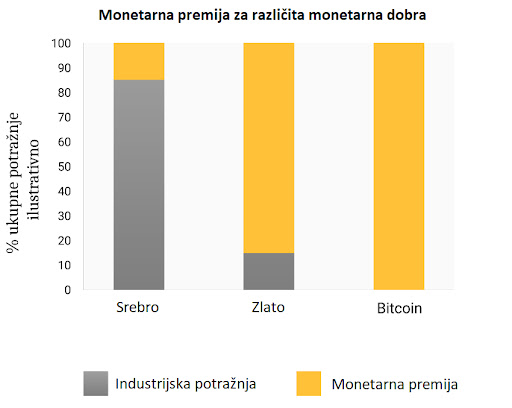
Čak i u odsustvu vanjskih faktora, kao što su intervencije vlade ili druga monetarna dobra, monetarna premija novog novca neće ići predvidivim putem. Ekonomist Larry White primijetio je:
"problem sa pričom “balona,” naravno, je da je ona konzistentna sa svakim putem cijene, i time ne daje ikakvo objašnjenje za specifičan put cijene"
Proces monetizacije opisuje teorija igara; svaki akter na tržištu pokušava predvidjeti agregiranu potražnju ostalih aktera, i time buduću monetarnu premiju. Zato što je monetarna premija nevezana za inherentnu korisnost, tržišni akteri se uglavnom vode za prošlim cijenama da bi odredili je li neko dobro jeftino ili skupo, i žele li ga kupiti ili prodati. Veza trenutne potražnje sa prošlim cijenama naziva se “ovisnost o putu” (path dependence); ona je možda najveći izvor konfuzije u shvaćanju kretanja cijena monetarnih dobara.
Kada kupovna moć monetarnog dobra naraste zbog većeg i šireg korištenja, očekivanja tržišta o definicijama “jeftinog” i “skupog” se mijenjaju u skladu s time. Slično tome, kada cijena monetarnog dobra padne, očekivanja tržišta mogu se promijeniti u opće vjerovanje da su prethodne cijene bile “iracionalne” ili prenapuhane. Ovisnost o putu novca ilustrirana je riječima poznatog upravitelja fondova s Wall Streeta, Josha Browna:
"Kupio sam bitcoine kada su koštali 2300 USD, i to mi se udvostručilo gotovo odmah. Onda sam počeo govoriti kako “ne mogu kupiti još” dok im je cijena rasla, premda sam znao da je to razmišljanje bazirano samo na cijenu po kojoj sam ih kupio. Kasnije, kada je cijena pala zbog kineske regulacije mjenjačnica, počeo sam si govoriti, “Odlično, nadam se da će još pasti da mogu kupiti još.”"
Istina leži u tome da su ideje “jeftinog” i “skupog” zapravo besmislene kada govorimo o monetarnim dobrima. Cijena monetarnog dobra ne reflektira njegovu stopu rasprostanjenosti ili korisnosti, nego mjeru koliko je ono široko prihvaćeno da ispuni razne uloge novca.
Dodatna komplikacija u ovom aspektu novca je činjenica da tržišni akteri ne djeluju samo kao nepristrani promatrači koji pokušavaju kupiti i prodati u iščekivanju budućih kretanja monetarne premije, nego i kao aktivni proponenti. Pošto ne postoji objektivno “točna” monetarna premija, širiti dobar glas o superiornijim svojstvima nekog monetarnog dobra je efektivnije nego za obična dobra, čija vrijednost je u konačnici vezana na njegovu osnovnu korisnost. Religiozni zanos sudionika na Bitcoin tržištu vidljiv je na raznim internetskim forumima, gdje Bitcoineri aktivno promoviraju benefine Bitcoina i bogatstvo koje je moguće ostvariti investiranjem u njega. Promatrajući Bitcoin tržište, Leigh Drogen komentira:
"To je prepoznatljivo svima kao religija - priča koju si pričamo i oko koje se slažemo. Religija je krivulja na grafu prihvaćanja o kojoj trebamo razmišljati. Sustav je gotovo savršen - onog trenutka kada netko pristupi krugu Bitcoinera, to će reći svima i nastaviti širiti riječ. Onda njihovi prijatelji pristupe i nastave širiti riječ."
Premda usporedba sa religijom može staviti Bitcoin u iracionalno svjetlo, potpuno je racionalno za individualnog vlasnika da širi dobru vijest o superiornom monetarnom dobru, i za šire društvo da se standardizira oko njega. Novac djeluje kao temelj za svu trgovinu i štednju; tako da prihvaćanje superiornog oblika novca ima ogromne multiplicirajuće benefite za stvaranje bogatstva za sve članove društva.
Oblik monetizacije
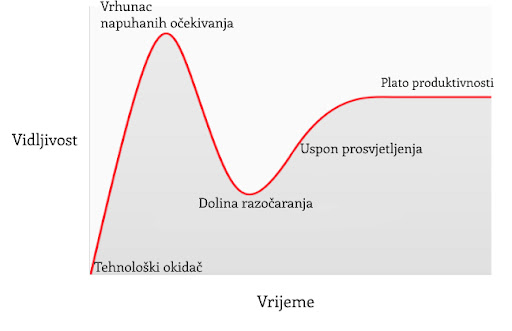
U članku o Spekulativnom prihvaćanju Bitcoina / teorije cijene, Michael Casey postulira da rastući Gartner hype ciklusi predstavljaju faze standardne S-krivulje prihvaćanja novih tehnologija, koje su bile prisutne kod mnogih transformacijskih tehnologija dok su postajale uobičajene u društvu.

Svaki Gartner hype ciklus počinje sa eksplozijom entuzijazma za novom tehnologijom, a cijenu podižu oni sudionici na tržištvu koji su “dostupni” u toj fazi. Najraniji kupci u Gartner hype ciklusu obično imaju jaku vjeru o transformacijskoj prirodi tehnologije u koju ulažu. S vremenom, tržište dosegne vrhunac entuzijazma kako se količina novih kupaca iscrpljuje, te kupovinom počnu dominirati spekulatori koji su više zainteresirani u brze profite nego u samu tehnologiju.
Nakon vrha hype ciklusa, cijene rapidno padaju dok spekulativno ludilo ustupa mjesto očajavanju, javnoj poruzi i osjećaju da tehnologija nije uopće bila transformacijska. S vremenom, cijena dosegne dno i formira plato na kojem se originalnim ulagačima, koji su imali snažno uvjerenje, pridružuju nove grupe ljudi koji su izdržali bol kraha cijena i koji cijene važnost same tehnologije.
Plato traje neko vrijeme i formira, kako Casey kaže, “stabilnu, dosadnu dolinu.” Za ovo vrijeme, javni interes za tehnologiju opada, no nastaviti će se razvijati i snažna zajednica uvjerenja će polako rasti. Tada, postavlja se nova baza za sljedeću iteraciju hype ciklusa, dok vanjski promatrači prepoznaju da tehnologija i dalje postoji i da ulaganje u nju možda nije onoliko rizično kao što se činilo za vrijeme pada cijene. Sljedeća iteracija hype ciklusa donosi mnogo veći broj novih ljudi, pa je i ciklus daleko veći u svojoj magnitudi.
Jako mali broj ljudi koji sudjeluju u Gartner hype ciklusu će točno predvidjeti koliko će visoko cijena porasti za vrijeme ciklusa. Cijene često dosegnu razine koje bi se činile apsurdnima većini ulagača u raniji stadijima ciklusa. Kada ciklus završi, mediji tipično atribuiraju pad cijene nekoj od aktualnih drušvenih tema. Premda takva tema može biti okidač pada, ona nikad nije temeljni razlog zašto ciklus završava. Gartner hype ciklusi završavaju kada je količina dostupnih novih sudionika na tržištu iscrpljena.
Zanimljivo je da je i zlato nacrtalo klasičan graf Gartner hype ciklusa od kasnih 1970-ih do ranih 2000-ih. Moguće je spekulirati da je hype ciklus osnovna socijalna dinamika oko procesa monetizacije.
Gartner kohorte
Od početka trgovanja Bitcoina na mjenjačnicama 2010. godine, Bitcoin tržište je svjedočilo četirima velikim Gartner hype ciklusima. U retrospektivi, možemo vrlo precizno identificirati grupe cijena prethodnih hype ciklusa Bitcoin tržišta. Također, možemo kvalitativno odrediti kohorte ulagača koje su povezane sa svakom iteracijom prethodnih ciklusa.
0 USD –1 USD (2009. – 3. mjesec 2011.): Prvi hype ciklus u Bitcoin tržištu dominirali su kriptografi, računalni znanstvenici i cypherpunkovi koji su od početka bili spremni razumijeti važnost nevjerojatnog izuma Satoshija Nakamotoa, i koji su bili pioniri u potvrđivanju da Bitcoin protokol nema tehničkih mana.
1 USD - 30 USD (3. mjesec 2011. – 7. mjesec. 2011.): Drugi ciklus privukao je rane entuzijaste oko novih tehnologija kao i stabilan pritok ideološki motiviranih ulagača koji su bili oduševljeni idejom novca odvojenog od države. Libertarijanci poput Rogera Vera došli su u Bitcoin zbog aktivnog anti-institucionalnog stava, i mogućnosti koju je nova tehnologija obećavala. Wences Casares, briljantni i dobro povezani serijski poduzetnik, bio je također dio drugog Bitcoin hype ciklusa te je širio riječ o Bitcoinu među najprominentnijim tehnolozima i ulagačima u Silicijskoj Dolini.
250 USD – 1100 USD (4. mjesec 2013. – 12. mjesec 2013.): Treći hype ciklus doživio je ulazak ranih generalnih i institucionalnih ulagača koji su bili voljni uložiti trud i riskirati kroz užasno komplicirane kanale likvidnosti kako bi kupili bitcoine. Primaran izvor likvidnosti na tržištu za vrijeme ovog perioda bio je MtGox, mjenjačnica bazirana u Japanu, koju je vodio notorno nesposobni i beskrupulozni Mark Karpeles, koji je kasnije završio i u zatvoru zbog svoje uloge u kolapsu MtGoxa.
Valja primijetiti da je rast Bitcoinove cijene za vrijeme spomenuti hype ciklusa većinom povezano sa povećanjem likvidnosti i lakoćom sa kojom su ulagači mogli kupiti bitcoine. Za vrijeme prvog hype ciklusa, nisu postojale mjenjačnice; akvizicija bitcoina se odvijala primarno kroz rudarenje (mining) ili kroz izravnu razmjenu sa onima koju su već izrudarili bitcoine. Za vrijeme drugog hype ciklusa, pojavile su se rudimentarne mjenjačnice, no nabavljanje i osiguravanje bitcoina na ovim mjenjačnicama bilo je previše kompleksno za sve osim tehnološki najsposobnijih ulagača. Čak i za vrijeme trećeg hype ciklusa, ulagači koju su slali novac na MtGox kako bi kupili bitcoine su morali raditi kroz značajne prepreke. Banke nisu bile voljne imati posla sa mjenjačnicom, a oni posrednici koji su nudili usluge transfera bili su često nesposobni, kriminalni, ili oboje. Nadalje, mnogi koji su uspjeli poslati novac MtGoxu, u konačnici su morali prihvatiti gubitak svojih sredstava kada je mjenjačnica hakirana i kasnije zatvorena.
Tek nakon kolapsa MtGox mjenjačnice i dvogodišnje pauze u tržišnoj cijeni Bitcoina, razvili su se zreli i duboki izvori likvidnosti; primjeri poput reguliranih mjenjačnica kao što su GDAX i OTC brokeri kao Cumberland mining. Dok je četvrti hype ciklus započeo 2016. godine, bilo je relativno lako običnim ulagačima kupiti i osigurati bitcoine.
1100 USD – 19600 USD? (2014. –?):
U trenutku pisanja ovog teksta, tržište Bitcoina je prolazilo svoj četvrti veliki hype ciklus. Sudjelovanje u ovom hype ciklusu dominirala je ona skupina koju je Michael Casey opisao kao “rana većina” običnih i institucionalnih ulagača.
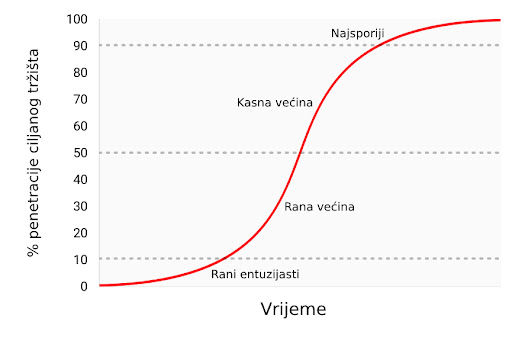
Kako su se izvori likvidnosti produbljivali i sazrijevali, veliki institucionalni ulagači sada imaju priliku sudjelovati kroz regulirana “futures” tržišta. Dostupnosti takvih tržišta stvara put ka kreaciji Bitcoin ETF-a (exchange traded fund) (fond na slobodnom tržištu), koji će onda pokrenuti “kasnu većinu” i “najsporije” u sljedećim hype ciklusima.
Premda je nemoguće predvidjeti točan efekt budućih hype ciklusa, razumno je očekivati da će najviša točka biti između 20.000 USD i 50.000 USD (2021. zenit je bio preko 69.000 USD). Znatno više od ovog raspona, i Bitcoin bi imao znatan postotak ukupne vijednosti zlata (zlato i Bitcoin bi imali jednaku tržišnu kapitalizaciju kada bi bitcoini vrijedili oko 380.000 USD u trenutku pisanja ovog teksta). Značajan postotak vrijednosti zlata dolazi od potražnje centralnih banaka, te je malo vjerojatno da će centralne banke ili suverene države sudjelovati u trenutnom hype ciklusu.
Ulazak suverenih država u Bitcoin
Bitcoinov zadnji Gartner hype ciklus će započeti kada ga suverene države počnu akumulirati kao dio svojih rezervi stranih valuta. Tržišna kapitalizacija Bitcoina je trenutno premala da bismo ga smatrali značajnim dodatkom rezervama većini zemalja. No, kako se interes u privatnom sektoru povećava i kapitalizacija Bitcoina se približi trilijunu dolara, postat će dovoljno likvidan za većinu država. Prva država koja službeno doda bitcoine u svoje rezerve će vjerojatno potaknuti stampedo ostalih da učine isto. Države koje su među prvima u usvajanju Bitcoina imat će najviše benefita u svojim knjigama ako Bitcoin u konačnici postane globalna valuta (global reserve currency). Nažalost, vjerojatno će države sa najjačom izvršnom vlasti - diktature poput Sjeverne Koreje - biti najbrže u akumulaciji bitcoina. Neodobravanje prema takvim državama i slaba izvršna tijela zapadnjačkih demokracija uzrokovat će sporost i kašnjenje u akumulaciji bitcoina za njihove vlastite rezerve.
Velika je ironija u tome što je SAD trenutno jedna od regulatorno najotvorenijih nacija prema Bitcoinu, dok su Kina i Rusija najzatvorenije. SAD riskira najviše, geopolitički, ako bi Bitcoin zamijenio dolar kao svjetska rezervna valuta. U 1960-ima, Charles de Gaulle je kritizirao “pretjeranu privilegiju” (“exorbitant privilege”) koju su SAD imale u međunarodnom monetarnom poretku, postavljenom kroz Bretton Woods dogovor 1944. godine. Ruska i kineska vlada još ne shvaćaju geo-strateške benefite Bitcoina kao rezervne valute, te se trenutno brinu o efektima koje bi mogao imati na njihova unutarnja tržišta. Kao de Gaulle u 1960-ima, koji je prijetio SAD-u povratkom na klasični standard zlata, Kinezi i Rusi će s vremenom uvidjeti korist u velikoj poziciji u Bitcoinu - spremištu vrijednosti bez pokrića ijedne vlade. Sa najvećom koncentracijom rudara Bitcoina u Kini (2017.), kineska vlada već ima znatnu potencijalnu prednost u stavljanju bitcoina u svoje rezerve.
SAD se ponosi svojim statusom nacije inovatora, sa Silicijskom dolinom kao krunom svoje ekonomije. Dosad, Silicijska dolina je dominirala konverzacijom usmjerenom prema regulaciji, i poziciji koju bi ona treba zauzeti prema Bitcoinu. No, bankovna industrija i federalna rezerva SAD-a (US Federal Reserve, Fed) napokon počinju uviđati egzistencijalnu prijetnju koju Bitcoin predstavlja za američku monetarnu politiku, postankom globalne rezervne valute. Wall Street Journal, jedan od medijskih glasova federalne reserve, izdao je komentar o Bitcoinu kao prijetnji monetarnoj politici SAD-a:
"Postoji još jedna opasnost, možda i ozbiljnija iz perspektive centralnih banaka i regulatora: bitcoin možda ne propadne. Ako je spekulativni žar u kriptovalutu samo prvi pokazatelj njezinog šireg korištenja kao alternative dolaru, Bitcoin će svakako ugroziti monopol centralnih banaka nad novcem."
U narednim godinama, možemo očekivati veliku borbu između poduzetnika i inovatora u Silicijskoj dolini, koji će pokušavati čuvati Bitcoin od državne kontrole s jedne strane, i bankovne industrije i centralnih banaka koje će učiniti sve što mogu da bi regulirale Bitcoin kako bi spriječile znatne promjene u svojoj industriji i moći izdavanja novca, s druge.
Prijelaz na medij razmjene
Monetarno dobro ne može postati opće prihvaćen medij razmjene (standardna ekonomska definicija za “novac”) prije nego je vrednovano od širokog spektra ljudi; jednostavno, dobro koje nije vrednovano neće biti prihvaćeno u razmjeni. Kroz proces generalnog rasta vrijednosti, i time postanka spremišta vrijednosti, monetarno dobro će brzo narasti u kupovnoj moći, i time stvoriti cijenu za korištenje u razmjeni. Samo kada ta cijena rizika mijenjanja spremišta vrijednosti padne dovoljno nisko, može dobro postati opće prihvaćen medij razmjene.
Preciznije, monetarno dobro će biti prikladno kao medij razmjene samo kada je suma cijene rizika i transakcijske cijene u razmjeni manja nego u trgovini bez tog dobra.
U društvu koje vrši robnu razmjenu, prijelaz spremišta vrijednosti u medij razmjene može se dogoditi čak i onda kada monetarno dobro raste u kupovnoj moći, zato što su transakcijski troškovi robne razmjene iznimno visoki. U razvijenoj ekonomiji, u kojoj su troškovi razmjene niski, moguće je za mladu i rapidno rastućnu tehnologiju spremišta vrijednosti, poput Bitcoina, da se koristi kao medij razmjene, doduše na ograničen način. Jedan primjer je ilegalno tržište droge, gdje su kupci voljni žrtvovati oportunu cijenu čuvanja bitcoina kako bi umanjili znatan rizik kupovine droge koristeći fiat novac.
Postoje međutim velike institucionalne barijere da novonastalo spremište vrijednosti postane sveopće prihvaćen medij razmjene u razvijenom društvu. Države koriste oporezivanje kao moćnu metodu zaštite svojeg suverenog novca protiv rivalskih monetarnih dobara. Ne samo da suvereni novac ima prednost konstantnog izvora potražnje, zato što je porez moguće platiti jedino u njemu, nego su i rivalska monetarna dobra oporezana pri svakoj razmjeni za vrijeme rastuće cijene. Ova metoda oporezivanja stvara znatan otpor korištenju spremišta vrijednosti kao medija razmjene.
Ovakvo sabotiranje tržišnih monetarnih dobara nije nepremostiva barijera za njihovo prihvaćanje kao općeg medija razmjene. Ako ljudi izgube vjeru u suvereni novac, njegova vrijednost može rapidno propasti kroz proces zvan hiperinflacija. Kada suvereni novac prolazi kroz hiperinflaciju, njegova vrijednost propadne prvo u usporedbi sa najlikvidnijim dobrima u društvu, kao što je zlato ili stabilna strana valuta (američki dolar npr.), ako su ona dostupna. Kada nema likvidnih dobara ili ih ima premalo, novac u hiperinflaciji kolabira u usporedbi sa stvarnim dobrima, kao što su nekretnine ili upotrebljiva roba. Arhetipska slika hiperinflacije je trgovina sa praznim policama - potrošači brzo bježe iz propadajuće vrijednosti novca svoje nacije.

Nakon dovoljno vremena, kada je vjera potpuno uništena za vrijeme hiperinflacije, suvereni novac više nitko ne prihvaća, te se društvo može vratiti na robnu razmjenu, ili će doživjeti potpunu zamjenu monetarne jedinice za sredstvo razmjene. Primjer ovog procesa bila je zamjena zimbabveanskog dolara za američki dolar. Takva promjena suverenog novca za stranu valutu je dodatno otežana relativnom oskudnošću strane valute i odsustvom stranih bankarskih institucija koje pružaju likvidnost tržištu.
Sposobnost lakog prenošenja bitcoina preko granica i odsustvo potrebe za bankarskim sustavom čine Bitcoin idealnim monetarnim dobrom za one ljude koji pate pod hiperinflacijom. U nadolazećim godinama, kako fiat valute nastave svoj povijesni trend ka bezvrijednosti, Bitcoin će postati sve popularniji izbor za ušteđevine ljudi diljem svijeta. Kada je novac nacije napušten i zamijenjen Bitcoinom, Bitcoin će napraviti tranziciju iz spremišta vrijednosti u tom društvu u opće prihvaćeno sredstvo razmjene. Daniel Krawicz stvorio je termin “hiperbitcoinizacija” da bi opisao ovaj proces.
Učestala pogrešna shvaćanja
Većina ovog članka usredotočila se na monetarnu prirodu Bitcoina. Sa tim temeljima možemo adresirati neke od najčešćih nerazumijevanja u Bitcoinu.
Bitcoin je balon (bubble)
Bitcoin, kao sva tržišna monetarna dobra, posjeduje monetarnu premiju. Ona često rezultira uobičajenom kritikom da je Bitcoin samo “balon.” No, sva monetarna dobra imaju monetarnu premiju. Naprotiv, ta monetarna premija (cijena viša od one koju diktira potražnja za dobrom kao korisnim) je upravo karakteristična za sve oblike novca. Drugim riječima, novac je uvijek i svuda balon. Paradoksalno, monetarno dobro je istovremeno balon i ispod vrijednosti ukoliko je u ranijim stadijima općeg prihvaćanja kao novac.
Bitcoin je previše volatilan
Volatilnost cijene Bitcoina je funkcija njegovog nedavnog nastanka. U prvih nekoliko godina svojeg postojanja, Bitcoin se ponašao kao mala dionica, i svaki veliki kupac - kao npr. braća Winklevoss - mogao je uzrokovati veliki skok u njegovoj cijeni. No, kako su se prihvaćenost i likvidnost povećavali kroz godine, volatilnost Bitcoina je srazmjerno smanjila. Kada Bitcoin postigne tržišnu kapitalizaciju (vrijednost) zlata, imat će sličnu volatilnost kao i zlato. Kako Bitcoin nastavi rasti, njegova volatilnost će se smanjiti do razine koja ga čini prikladnim za široko korištenje kao medij razmjene. Kao što je prethodno rečeno, monetizacija Bitcoina se odvija u seriji Gartner hype ciklusa. Volatilnost je najniža za vrijeme vrhunaca i dolina unutar ciklusa. Svaki hype ciklus ima nižu volatilnost od prethodnih, zato što je likvidnost tržišta veća.
Cijene transakcija su previsoke
Novija kritika Bitcoin mreže je ta da ju je povećanje cijena prijenosa bitcoina učinilo neprikladnom za sustav plaćanja. No, rast u cijenama transakcija je zdrav i očekivan. One su nužne za plaćanje bitcoin minera (rudara), koji osiguravaju mrežu validacijom transakcija. Rudare se plaća kroz cijene transakcija ili kroz blok-nagrade, koje su inflacijska subvencija od trane trenutnih vlasnika bitcoina.
S obzirom na Bitcoinovu fiksnu proizvodnju (monetarna politika koja ga čini idealnim za spremanje vrijednosti), blok-nagrade će s vremenom nestati i mrežu će se u konačnici morati osiguravati kroz cijene transakcija. Mreža sa “niskim” cijenama transakcija je mreža sa slabom sigurnosti i osjetljiva na vanjsku intervenciju i cenzuru. Oni koji hvale niske cijene Bitcoinovih alternative zapravo niti ne znajući opisuju slabosti tih takozvanih “alt-coina.”
Površan temelj kritika Bitcoinovih “visokih” cijena transakcija je uvjerenje da bi Bitcoin trebao biti prvo sustav plaćanja, i drugo spremište vrijednosti. Kao što smo vidjeli kroz povijest novca, ovo uvjerenje je naopako. Samo onda kada Bitcoin postane duboko ukorijenjeno spremište novca može biti prikladan kao sredstvo razmjene. Nadalje, kada oportunitetni trošak razmjene bitcoina dođe na razinu koja ga čini prikladnim sredstvom razmjene, većina trgovine neće se odvijati na samoj Bitcoin mreži, nego na mrežama “drugog sloja” (second layer) koje će imati niže cijene transakcija. Takve mreže, poput Lightning mreže, služe kao moderna verzija zadužnica koje su korištene za prijenos vlasničkih papira zlata u 19. stoljeću. Banke su koristile zadužnice zato što je prijenos samog metala bio daleko skuplji. Za razliku od takvih zadužnica, Lightning mreža će omogućavati nisku cijenu prijenosa bitcoina bez potrebe za povjerenjem prema trećoj strani, poput banaka. Razvoj Lightning mreže je tehnološka inovacija od izuzetne važnosti u povijesti Bitcoina, i njezina vrijednost će postati očita u narednim godinama, kako je sve više ljudi bude razvijalo i koristilo.
Konkurencija
Pošto je Bitcoin softverski protokol otvorenog tipa (open-source), oduvijek je bilo moguće kopirati softver i imitirati mrežu. Kroz godine nastajali su mnogi imitatori, od identičnih kopija, kao Litecoin, do kompleksnijih varijanti kao što je Ethereum, koje obećavaju arbitrarno kompleksne ugovorne mehanizme koristeći decentralizirani računalni sustav. Česta kritika Bitcoinu od strane ulagača je ta da on ne može zadržati svoju vrijednost kada je vrlo lako stvoriti konkurente koji mogu lako i brzo u sebi imati najnovije inovacije i softverske funkcionalnosti.

Greška u ovom argumentu leži u manju takozvanog “mrežnog efekta” (network effect), koji postoji u prvoj i dominantnoj tehnologiji u nekom području. Mrežni efekt - velika vrijednost korištenja Bitcoina samo zato što je već dominantan - je važno svojstvo samo po sebi. Za svaku tehnologiju koja posjeduje mrežni efekt, to je daleko najvažnije svojstvo koje može imati.
Za Bitcoin, mrežni efekt uključuje likvidnost njegovog tržišta, broj ljudi koji ga posjeduju, i zajednicu programera koji održavaju i unaprjeđuju njegov softver i svjesnost u javnosti. Veliki ulagači, uključujući države, će uvijek prvo tražiti najlikvidnije tržište, kako bi mogli ući i izaći iz tržišta brzo, i bez utjecanja na cijenu. Programeri će se pridružiti dominantnoj programerskoj zajednici sa najboljim talentom, i time pojačati samu zajednicu. Svjesnost o brendu sama sebe pojačava, pošto se nadobudni konkurenti Bitcoina uvijek spominju u kontekstu Bitcoina kao takvog.
Raskrižje na putu (fork)
Trend koji je postao popularan 2017. godine nije bio samo imitacija Bitcoinovog softvera, nego kopiranje potpune povijesti njegovih prošlih transakcija (cijeli blockchain). Kopiranjem Bitcoinovog blockchaina do određene točke/bloka i odvajanjem sljedećih blokova ka novoj mreži, u procesu znanom kao “forking” (odvajanje), Bitcoinovi konkurenti su uspjeli riješiti problem distribuiranja svojeg tokena velikom broju korisnika.

Najznačajniji takav fork dogodio se 1. 8. 2017. godine, kada je nova mreža nazvana Bitcoin Cash (Bcash) stvorena. Vlasnik N količine bitcoina prije 1.8.2017. bi onda posjedovao N bitcoina i N BCash tokena. Mala, ali vrlo glasna zajednica Bcash proponenata je neumorno pokušavala prisvojiti Bitcoinov brend i ime, imenujući svoju novu mrežu Bitcoin Cast i pokušavajući uvjeriti nove pridošlice u Bitcoin da je Bcash “pravi” Bitcoin. Ti pokušaji su većinom propali, i taj neuspjeh se vidi u tržišnim kapitalizacijama dviju mreža. No, za nove ulagače, i dalje postoji rizik da bi konkurent mogao kopirati Bitcoin i njegov blockchain i tako uspjeti u preuzimanju tržišne kapitalizacije, te postati de facto Bitcoin.
Moguće je uočiti važno pravilo gledajući velike forkove u prošlosti Bitcoin i Ethereum mreža. Većina tržišne kapitalizacije odvijat će se na mreži koja zadrži najviši stupanj talenta i aktivnosti u zajednici programera. Premda se na Bitcoin može gledati kao na nov i mlad novac, on je također računalna mreža koja počiva na softveru, kojeg se pak treba održavati i poboljšavati. Kupovina tokena na mreži koja ima malo neiskusnih programera bilo bi kao kupovati kopiju Microsoft Windowsa na kojoj rade lošiji programeri. Jasno je vidljivo iz povijesti forkova koji su se odvili 2017. godine da su najbolji računalni i kriptografski stručnjaci posvećeni razvoju originalnog Bitcoina, a ne nekoj od rastućeg broja imitacija koje su se izrodile iz njega.
Stvarni rizici
Premda su uobičajene kritike upućene Bitconu od strane medija i ekonomske profesije krive i bazirane na netočnom shvaćanju novca, postoje pravi i značajni rizici kod ulaganja u Bitcoin. Bilo bi mudro za novog Bitcoin ulagača da shvati ove rizike prije potencijalnog ulaganja.
Rizik protokola
Bitcoin protokol i kriptografski sastavni dijelovi na kojima je sagrađen potencijalno imaju dosad nepronađenu grešku u svom dizajnu, ili mogu postati nesigurni razvojem kvantnih računala. Ako se pronađe greška u protokolu, ili neka nova metoda računarstva učini mogućim probijanje kriptografskih temelja Bitcoina, vjera u Bitcoin biti će znatno narušena. Rizik protokola bio je najviši u ranim godinama razvoja Bitcoina, kada je još uvijek bilo nejasno, čak i iskusnim kriptografima, je li Satoshi Nakamoto zaista riješio problem bizantskih generala (Byzantine Generals’ Problem). Brige oko ozbiljnih grešaka u Bitcoin protokolu nestale su kroz godine, no uzevši u obzir njegovu tehnološku prirodu, rizik protokola će uvijek ostati u Bitcoinu, makar i kao izuzetak.
Propadanje mjenjačnica
Time što je decentraliziran, Bitcoin je pokazao značajnu otpornost, suočen sa brojnim pokušajima raznih vlada da ga reguliraju ili unište. No, mjenjačnice koje trguju bitcoinima za fiat valute su centralizirani entiteti i podložne regulacijama i zatvaranju. Bez mjenjačnica i volje bankara da s njima posluju, proces monetizacije Bitcoina bio bi ozbiljno usporen, ako ne i potpuno zaustavljen. Iako postoje alternativni izvori likvidnosti za Bitcoin, poput “over-the-counter” brokera i decentraliziranih tržišta za kupovinu i prodaju bitcoina, kritičan proces otkrivanja i definiranja cijene se odvija na najlikvidnijim mjenjačnicama, koje su sve centralizirane.
Jedan od načina za umanjivanje rizika gašenja mjenjačnica je geografska arbitraža. Binance, jedna od velikih mjenjačnica iz Kine, preselila se u Japan nakon što joj je kineska vlada zabranila operiranje u Kini. Vlade su također oprezne kako ne bi ugušile novu industriju koja je potencijalno značajna kao i internet, i time predale nevjerojatnu konkurentnu vrijednost drugim nacijama.
Samo kroz koordinirano globalno ukidanje Bitcoin mjenjačnica bi proces monetizacije mogao biti zaustavljen. Trenutno smo u utrci; Bitcoin raste i postaje sve rašireniji, i doći će do trenutka kada bi potpuno ukidanje mjenjačnica postalo politički neizvedivo - kao i gašenje interneta. Mogućnost takvog ukidanja je još uvijek realna, i valja je uzeti u obzir pri ulaganju u Bitcoin. Kao što je gore objašnjeno, suverene vlade se polako bude i uviđaju prijetnju koju predstavlja neovisna digitalna valuta otporna na cenzuru, za njihovu monetarnu politiku. Otvoreno je pitanje hoće li išta poduzeti da odgovore ovoj prijetnji prije nego Bitcoin postane toliko utvrđen i raširen da politička akcija postane nemoćna i ne-efektivna.
Zamjenjivost
Otvorena i transparentna priroda Bitcoin blockchaina omogućava državama da proglase specifične bitcoine “okaljanima” zbog njihovog korištenja u određenim aktivnostima. Premda Bitcoin, na protokolarnoj razini, ne diskriminira transakcije na ikoji način, “okaljani” bitcoini bi mogli postati bezvrijedni ako bi ih regulacije proglasile ilegalnima i neprihvatljivima za mjenjačnice ili trgovce. Bitcoin bi tada izgubio jedno od kritičnih svojstava monetarnog dobra: zamjenjivost.
Da bi se ovaj problem riješio i umanjio, biti će potrebna poboljšanja na razini protokola kako bi se poboljšala privatnost transakcija. Premda postoji napredak u ovom smjeru, prvi put primjenjen u digitalnim valutama kao što su Monero i Zcash, potrebno je napraviti značajne tehnološke kompromise između efikasnosti i kompleksnosti Bitcoina i njegove privatnosti. Pitanje ostaje otvoreno je li moguće dodati nova svojstva privatnosti na Bitcoin, na način koji neće kompromitirati njegovu korisnost kao novca.
Zaključak
Bitcoin je novonastali novac koji je u procesu transformacije iz sakupljačkog dobra u spremište vrijednosti. Kao neovisno monetarno dobro, moguće je da će u budućnosti postati globalan novac, slično kao zlato za vrijeme 19. stoljeća. Prihvaćanje Bitcoina kao globalnog novca je upravo taj optimističan scenarij za Bitcoin, kojeg je artikulirao Satoshi Nakamoto još 2010. godine u email razmjeni sa Mikeom Hearnom:
"Ako zamisliš da se koristi u nekom dijelu svjetske trgovine, i da će postojati samo 21 milijun bitcoina za cijeli svijet, vrijednost po jedinici će biti znatno veća".
Ovaj scenarij je još snažnije definirao briljantni kriptograf Hal Finney, koji je ujedno primio i prve bitcoine od Nakamotoa, ubrzo nakon najave prvog funkcionalnog Bitcoin softvera:
"Zamislimo da Bitcoin bude uspješan i postane dominantan sustav plaćanja diljem svijeta. U tom slučaju će ukupna vrijednost valute biti jednaka ukupnoj vrijednosti svog bogatstva svijeta. Današnje procjene ukupnog svjetskog bogatska kućanstava koje sam pronašao borave negdje između 100 i 300 trilijuna dolara. Sa 20 milijuna bitcoina, svaki bi onda vrijedio oko 10 milijuna dolara."
Čak i da Bitcoin ne postane u cijelost globalan novac, nego da se samo natječe sa zlatom kao neovisno spremište vrijednosti, i dalje je masivno podcijenjen. Mapiranje tržišne kapitalizacije postojeće količine izrudarenog zlata (oko 8 trilijuna dolara) na maksimalnu dostupnost Bitcoina od 21 milijun, daje vrijednost od otprilike 380,000 dolara po bitcoinu. Kao što smo vidjeli u prethodnom tekstu, svojstva koja omogućavaju monetarnom dobru da bude prikladno spremište vrijednosti, čine Bitcoin superiornijim zlatu u svakom pogledu osim trajanja povijesti. No, kako vrijeme prolazi i Lindy efekt postane jači, dosadašnja povijest će prestati biti prednost zlata. Samim time, nije nerazumno očekivati da će Bitcoin narasti do, a možda i preko, ukupne cijene zlata na tržištvu do 2030. Opaska ovoj tezi je činjenica da veliki postotak vrijednosti zlata dolazi od toga što ga centralne banke čuvaju kao spremište vrijednosti. Da bi Bitcoin došao do te razine, određena količina suverenih država će trebati sudjelovati. Hoće li zapadnjačke demokracije sudjelovati u vlasništvu Bitcoina je nepoznato. Vjerojatnije je, nažalost, da će prve nacije u Bitcoin tržištu biti sitne diktature i kleptokracije.
Ako niti jedna država ne bude sudjelovala u Bitcoin tržištu, optimistična teza i dalje postoji. Kao nevisno spremište vrijednosti u rukama individualnih i institucionalnih ulagača, Bitcoin je i dalje vrlo rano u svojoj “krivulji prihvaćenosti” (adoption curve); tzv. “rana većina” ulaze na tržište sada, dok će ostali ući tek nekoliko godina kasnije. Sa širim sudjelovanjem individualnih i institucionalnih ulagača, cijena po bitcoinu između 100,000 i 200,000 dolara je sasvim moguća.
Posjedovanje bitcoina je jedna od malobrojnih asimetričnih novčanih strategija dostupnih svakome na svijetu. Poput “call” opcija, negativan rizik ulagača je ograničen na 1x, dok potencijalna dobit i dalje iznosi 100x ili više. Bitcoin je prvi istinski globalan balon čija je veličina ograničena samo potražnjom i željom građana svijeta da zaštite svoju ušteđevinu od raznovrsnih ekonomskih malverzacija vlade. Bitcoin je ustao kao feniks iz pepela globalne financijske krize 2008. godine - katastrofe kojoj su prethodile odluke centralnih banaka poput američke Federalne rezerve (Federal Reserve).
Onkraj samo financijske teze za Bitcoin, njegov rast i uspjeh kao neovisno spremište vrijednosti imat će duboke geopolitičke posljedice. Globalna, ne-inflacijska valuta će prisiliti suverene države da promjene svoje primarne mehanizme financiranja od inflacije u izravno oporezivanje; koje je daleko manje politički popularno. Države će se smanjivati proporcionalno političkoj boli koju im nanese oporezivanje kao jedini način financiranja. Nadalje, globalna trgovina vršiti će se na način koji zadovoljava aspiraciju Charlesa de Gaullea, da nijedna nacija ne bi smjela imati privilegiju nad ikojom drugom:
"Smatramo da je potrebno da se uspostavi međunarodna trgovina, kao što je bio slučaj prije velikih nesreća koje su zadesile svijet, na neosporivoj monetarnoj bazi, koja ne nosi na sebi oznaku ijedne države."
Za 50 godina, ta monetarna baza biti će Bitcoin.
-
 @ 266815e0:6cd408a5
2025-05-02 22:24:59
@ 266815e0:6cd408a5
2025-05-02 22:24:59Its been six long months of refactoring code and building out to the applesauce packages but the app is stable enough for another release.
This update is pretty much a full rewrite of the non-visible parts of the app. all the background services were either moved out to the applesauce packages or rewritten, the result is that noStrudel is a little faster and much more consistent with connections and publishing.
New layout
The app has a new layout now, it takes advantage of the full desktop screen and looks a little better than it did before.
Removed NIP-72 communities
The NIP-72 communities are no longer part of the app, if you want to continue using them there are still a few apps that support them ( like satellite.earth ) but noStrudel won't support them going forward.
The communities where interesting but ultimately proved too have some fundamental flaws, most notably that all posts had to be approved by a moderator. There were some good ideas on how to improve it but they would have only been patches and wouldn't have fixed the underlying issues.
I wont promise to build it into noStrudel, but NIP-29 (relay based groups) look a lot more promising and already have better moderation abilities then NIP-72 communities could ever have.
Settings view
There is now a dedicated settings view, so no more hunting around for where the relays are set or trying to find how to add another account. its all in one place now
Cleaned up lists
The list views are a little cleaner now, and they have a simple edit modal

New emoji picker
Just another small improvement that makes the app feel more complete.
Experimental Wallet
There is a new "wallet" view in the app that lets you manage your NIP-60 cashu wallet. its very experimental and probably won't work for you, but its there and I hope to finish it up so the app can support NIP-61 nutzaps.
WARNING: Don't feed the wallet your hard earned sats, it will eat them!
Smaller improvements
- Added NSFW flag for replies
- Updated NIP-48 bunker login to work with new spec
- Linkfy BIPs
- Added 404 page
- Add NIP-22 comments under badges, files, and articles
- Add max height to timeline notes
- Fix articles view freezing on load
- Add option to mirror blobs when sharing notes
- Remove "open in drawer" for notes
-
 @ 6a6be47b:3e74e3e1
2025-05-28 17:37:11
@ 6a6be47b:3e74e3e1
2025-05-28 17:37:11Hi frens! 🌞
How was your day? Mine was pretty great! Not to brag—I just try to see things in a positive light. Even when a day is “meh” or downright awful, I look for at least one good thing in it. Sometimes, let’s be real, there isn’t even one. Some days, weeks, or even months can just be tough. But even that shall pass.
✨ So, let’s try to focus on at least one good thing around us, or within us. Who knows—maybe a little magic can happen…
🎨 Today, I made time for some drawing on Procreate—yaaay! If you caught yesterday’s discussion, you know I drew a butterfly 🦋. Maybe with today’s drawing, you’ll be able to guess my next blog entry 👀
Today’s subject: Cytisus scoparius, better known as “Scotch broom” (or Scots broom).
🔍 I used to mix it up with gorse, but there are some telltale differences:
“Broom is similar to common gorse in size, shape and flower colour, but it lacks the spines and has short, flattened leaves and larger flowers.” — The Wildlife Trusts
⭐️Fun fact: I actually painted a gorse not too long ago for my Beltane post.
🚨 A word of caution though—don’t get too close! Scotch broom is harmful if eaten, so keep an eye out for your pets when you’re out and about, according to rhs.org.uk
🌼 I love spotting these bright yellow blooms by the highway or just outside town. That color is chef’s kiss—it really brightens up any drive!
💐That’s all for today. I’m super excited to hear what you think!
Take care and godspeed, my frens! 🚀✨
https://stacker.news/items/991324
-
 @ c1e6505c:02b3157e
2025-05-28 17:36:03
@ c1e6505c:02b3157e
2025-05-28 17:36:03I recently acquired a new lens:
1959 Leica Summaron F2.8 35mm LTM.
1959 Leica Summaron 35mm f2.8 LTM mounted on my Fujifilm Xpro2 with LTM adapter made by Urth.
Technically, it was a trade. I helped a fellow Bitcoiner set up their Sparrow Wallet, Nostr stuff, and troubleshoot a few wallet issues, and in return, they gave me the lens.
It all started at a local Bitcoin meetup I went to about a week ago - my second time attending. I recognized a few faces from last time, but also saw some new ones. These meetups are refreshing - it’s rare to speak a common language about something like Bitcoin or Nostr. Most people still don’t get it. But they will.
Technology moves forward. Networks grow. Old cells die off.
During the meetup, someone noticed I had my Leica M262 with me and struck up a conversation. Said they had some old Leica lenses and gear at home, and wanted to show me.
Bitcoin and photography in one conversation? I’m down.
A day or so later, they sent me a photo of one of the lenses: a vintage Summaron LTM 35mm f/2.8 from 1959. I’d never seen or heard of one before. They asked if I could help them set up Sparrow and a Bitcoin node. In exchange, they’d give me the lens. Sounded like a good deal to me. Helping plebs with their setups feels like a duty anyway. I said, of course.
They invited me over - a pretty trusting move, which I appreciated. They had some great Bitcoin memorabilia: Fred Krueger’s The Big Bitcoin Book (even if the guy’s turned full shitcoiner), and some FTX sunglasses from Bitcoin 2022. Probably future collector’s items, lol.
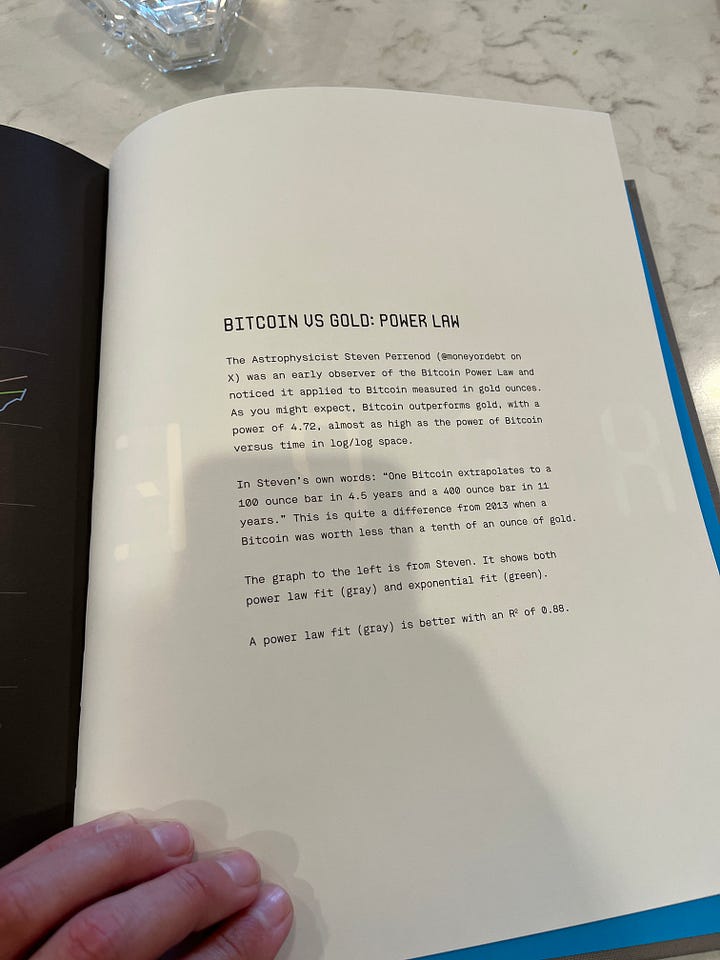

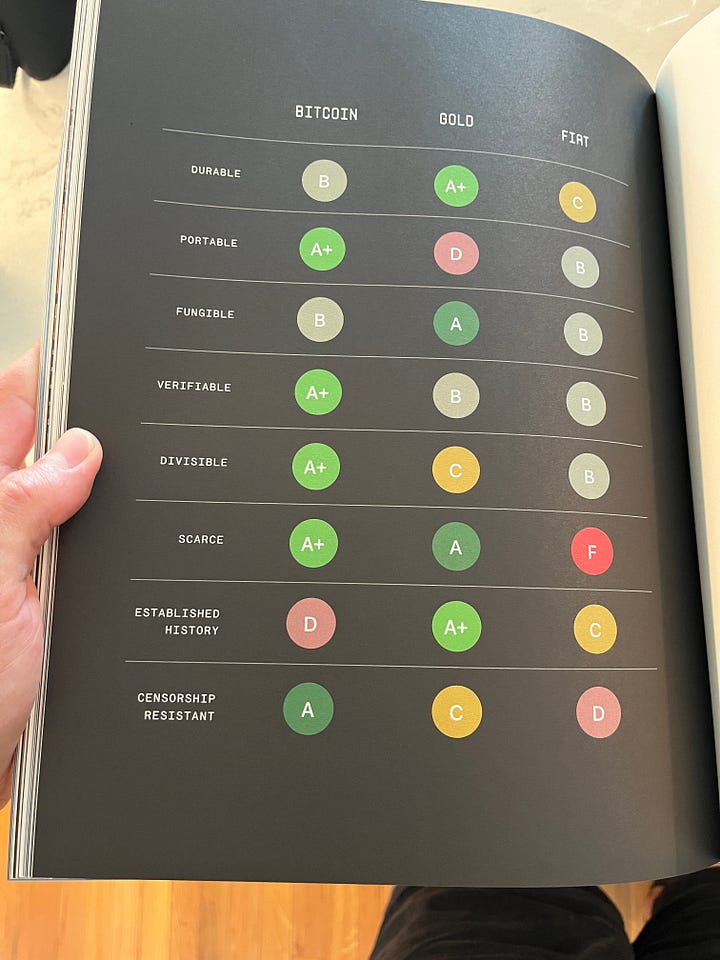

We headed upstairs to work on setting up Sparrow Wallet on their Windows machine. I verified the software download first (which you should always do), then helped them create a new wallet using their Ledger Flex. They also had an older Ledger Nano X. The Flex setup was easy, but the Nano X gave us trouble. It turns out Ledger allows multiple wallets for the same asset, which can show up differently depending on how they’re configured. In Sparrow, only one wallet showed—none of the others.
I believe it had to do with the derivation path from the Ledger. If anyone knows a fix, let me know.
After a few hours of troubleshooting, I told them I couldn’t really recommend Ledger. The UX is a mess. They’d already heard similar things from other plebs too.
I suggested switching to the Blockstream Jade. It’s a solid Bitcoin-only device from a trustworthy team. That’s what you want in a hardware wallet.
But back to the lens…
Since it’s an LTM (Leica Thread Mount), I couldn’t mount it directly on my M262. Luckily, I remembered I had an Urth adapter that fits my Fujifilm X-Pro2. I don’t use the X-Pro2 much these days—it’s mostly been sidelined by the M262 - but this was the perfect excuse to bring it out again.
To test the lens, I shot everything wide open at f/2.8. Nothing crazy fast, but it’s the best way to see a lens’s character. And this one definitely has character. There’s a subtle softness and a kind of motion blur effect around the edges when wide open. At first, I wasn’t sure how I felt about it, but the more I shot, the more I liked it. It reminds me of Winogrand’s work in Winogrand Color - those messy, shifting edges that make the frame feel alive. It also helps soften the digital-ness of the camera sensor.
The focus throw is short and snappy - much tighter than my Summicron V3 35mm f/2. I really like how fast it is to use. The closest focusing distance is about 3.5 feet, so it’s not ideal for close-ups. And with the Urth adapter on the X-Pro2, the focal length ends up closer to 40mm.
The only thing that threw me off was the infinity lock. When the focus hits infinity, it physically locks - you have to press a small tab to unlock it. I’ve seen others complain about it, so I guess it’s just one of those old lens quirks. I’m getting used to it.
All the photos here were taken around where I live in South Carolina. Some during bike rides to the river for a swim, others while walking through the marshlands.
I try to make work wherever I am. You should be able to.
It’s about the light, the rhythm, the play - and having the motivation to actually go out and shoot.
Lens rating: 7.9/10
I mainly shoot with a Leica M262, and edit in Lightroom + Dehancer
Use “PictureRoom” for 10% off Dehancer Film
If you’ve made it this far, thank you for taking the time to view my work - consider becoming a paid subscriber.
Also, please contact me if you would like to purchase any of my prints.
Follow me on Nostr:
npub1c8n9qhqzm2x3kzjm84kmdcvm96ezmn257r5xxphv3gsnjq4nz4lqelne96
-
 @ 5188521b:008eb518
2025-05-02 10:19:17
@ 5188521b:008eb518
2025-05-02 10:19:17Fabian Sixsmith leaned closer to the screen. A couple of white pixels fizzed through the frame, and the hairs on his arm prickled. It had to be her. The blonde. Underworld’s most wanted — T1n4Red.
It was nearing daybreak in Lewistown, Montana. The end of yet another 14-hour shift at the DoS facility. Pulling fourteens was tough on his body, but it reduced the time it would take for Fabian to gain promotion to agent. Working at the Department of Surveillance came with the serious drawback of being labeled a snoop, but agents could be free — solid pension credits and private property. But today, he would not slink back to his closet-sized studio for buttered noodles and two hours on the velobike. Today would be the day he proved his work was responsible for locating T1n4Red. Her crimes were manifold; her methods were meticulous. Operating encrypted communication networks and thousands of transaction joins to obfuscate Underworld finances. Fabian flipped the plastic cover of the alarm on his console and pressed the button.
Agent Williams appeared behind him in seconds. The babble of voice commands in the CCTV facility cut to zero. “Situation update, Operative Sixsmith.”
Liquidating the bad guys had been the dream ever since his father lost his college fund to a hacker. Cypherpunks came in all guises, and some could phish credits from careless Boston drunks and cover their tracks with encryption. Fabian opened the dossier on his desk. “Tier 1 target located. DNA confirmation requested from ground team.” He was certain. So many nights following encoded messages he found hidden data in images on the public comms ledger. Many were drop sites for the scumbags who delivered supplies to the Underworld in exchange for bitcoin — the only money the government couldn’t meter out and strip away automatically. That pixel of white had to be her blonde hair vanishing, once again, underground.
“Enhance the facial image,” said Williams.
There was no clear image to enhance. Fabian would have some explaining to do if he was wrong. Except he couldn’t be wrong. Those pixels had been his life for the last ten months. Finally, he had trapped her. Straightening his glasses, he prepared his reply. “I can bring up the drop locations from the LSB ima—”
“Operative. What is the protocol required to initiate a Tier 1 alert?”
Fabian could feel the heat of his boss’s glare. “Agent, there is insufficient facial recognition data, but if you give me a minute…” He had captured dozens of steganographical messages — locations, account numbers, usernames. Hiding messages in plain sight was apparently how cypherpunks avoided detection with such ease.
Williams was already patching through to the ground team on his Neurocomms link. “What’s your ETA on the location?” He furrowed his brow. “Copy that... proceed.” Turning towards Fabian, he snapped his fingers. “My office. Now.”
According to Fabian’s calculations, the ground team would report back with the DNA scan in three to four minutes. When they got a match, she’d be toast. T1n4Red would be underground forever; if she resurfaced, the dronecopters would gun her down in minutes. He just had to stall Williams until the confirmation came through. That might be the only way to avoid his first ever sanction. Having a blemish on record would set his lifeplan back by several months. He thought about requesting a comfort break on the system, but Williams would deny it. Fabian stood up purposefully. He arranged the chair and a few items on the desk, then dragged his feet all the way to the office.
Each agent in the DoS facility had an area of control around the size of a football field. Their 12’ by 12’ office comprised the only enclosed space and was positioned in the middle of rows upon rows of desks. Four walls of two-way mirrored glass formed the raised office cube — a mini panopticon within the greater panopticon of DoS. The agent sat in the swivel chair and swung his feet onto the desk. “You better be right about this, Sixsmith, or you’re done here.”
Fabian’s heart beat like a heavy bass kick. The perfectly calibrated 67-degree air didn’t stop him from wanting to loosen his tie. When he jammed his fingers down the small gap between his neck and collar, they came out slick with sweat. All those nights chasing. The tabulations, the data models, the transcripts from Underworld detainees, the ciphers he’d decoded — they all seemed like a game. A dream. He was the grizzled sheriff finally placing the noose around the neck of the uncatchable outlaw. He knew that in sixty seconds or so, the ground team would confirm a DNA match, and it would be impossible for T1n4Red to resurface without physical liquidation. “I’m sure, sir. This was the only way. We’d never get a facial match on a Tier 1.”
The agent looked at the communicator on his desk. Nothing.
Did T1n4Red eat buttered noodles and work out in her underground living closet? Did she crave for the feel of a paperback novel, or perhaps own a non-cataloged copy? It’s not like she could step foot inside the state knowledge center. “What action will DoS—”
Ground Unit Bravo to Williams. Do you copy?
“This is Williams. Over.”
Bravo commander confirmed the DNA match. It was her. She would now be classified a subverter. The payment instructions she had etched into the self-repair polymer bench had been photographed. Any wallet receiving those coins would be investigated. The fintech arm would already be working on liquidating affiliated Overworld accounts. One wrong turn and they can shut down your life’s wealth.
But T1n4Red was smarter. DoS would always be one step behind the cypherpunks because they were bound by government protocol, unable to infiltrate the Level 3 realm of encrypted private comms. Fabian had to take risks. What use was all his dedication if it just led to being remaining on the outside of a panopticon looking in?
“You can leave.” Williams motioned to the office door. “Your shift was over sixteen minutes ago.”
The State Knowledge Center smelled of the past. That’s what Fabian liked about it. He turned the page, savoring the quality feel of thick paper, imagining that when this book ran through enough hands, the inked fibers would run from black to gray to cream-white and the story would be gone. These were some of the only off Ledger items left in the country.
Wild Country Outlaws was Fabian’s sanctuary from the pressures of his job. All fiction was based on the kind of truth that needed to survive. Back to the times when eyes touched words without being digitally tracked, when citizens could own things. He read a paragraph and closed his eyes to imagine how life was back then. The cavernous knowledge center, with its hard seats and CCTV lenses transformed into lush plains and steep hills. Fabian felt the warm breeze on his face and the muscles of the horse beneath him. The two rifles slung on his back would shoot those boys dead. No one would take his property. His wife, children, his lame brother, hell, the whole damned village of Lewistown depended on his cattle to provide.
Of course, land could only be leased now. Livestock too. Those rustlers would have a hard time taking anything without public subscription fees and pre-taxed profits coming out. And if they wanted, the Department of Property could rescind custody of any item and confiscate it. Fabian’s smart-band vibrated, indicating he had just ten minutes of reading time left. The thing buzzed too hard. It pinched, but like all sanctioned hardware, it was government hard-coded.
He hadn’t been able to focus this time. Not really. Was T1n4Red an outlaw or a rancher? Either way, she was fighting the system that had stripped Americans of their right to call their house a home. According to the Department of Education, pre-ledger days were violent wealth-disparity wars, but the novels Fabian read painted a different picture — a fantasy freedom where ordinary citizens could build wealth.
Fabian rose to go. He handed the book to the desk girl and watched her scan it into the system. His smart-band buzzed again with a compliance point. To think his friends chased these stupid tokens for avatar upgrades and paid-time-off options. But, without them, he might end up with his ID frozen like his high school buddy, Scott, cut off from all legal avenues to earn a living and watched like a hawk by DoS. Did he have a secret stash of satoshis that kept him clear of the state debtors’ facility?
The lady at the desk smiled. Her brown bob remained undisturbed by the air cooling system. “We hope you enjoyed your trip into our analog archives, Fabian.”
“Sure. See you next time, Miranda.” He breezed out. They had history, but it wasn’t something he was interested in repeating. Imagine the conversations about cataloging systems and the internal squabbles of the Knowledge Center board. Fabian was already in a committed relationship with the powers of his imagination. Explicit videos were far too risky for a DoS worker to use, but the image of T1n4Red’s full lips and blond hair invaded his dreams. They could run a ranch together, or maybe they’d be cattle rustlers on the run. He wasn’t sure why, but every night, Fabian masturbated to the one rendered CGI model of T1n4Red they had on file. On the outside, his life was the ultimate mundanity, but the thrill of T1n4Red, the taste of the air on the great ranches outside the city, the sheer danger of even thinking all this, was the only way he could sleep.

They watched the pollination drone flit between the hibiscus flowers in the thick air of the botanical biodome. Fabian had been lucky to receive two of the limited daily visitor passes. It was even luckier for Scott, who now had the chance to get out of his mom’s dingy basement for a few hours.
“You know why they made them bigger than bees, right?” Scott spoke out of the side of his mouth. When Fabian shrugged, he leant in to inspect the device hovering around eye level. He blew a kiss and waved at its pollen-collector end.
“You don’t know that.”
Scott turned and swept his lank hair off his forehead. “You're the one who checks the footage, snoop.”
Micro cameras were yet another panopticon in the armory of the State. You had to assume, even when lying in bed with a lover, even when going to the toilet, that it was possible you were recorded, watched, and analyzed even years later. Secrecy was a virus DoS sought to eradicate.
The biosphere wristband on Fabian’s right arm sounded. Closing time was fast approaching. Fabian put a hand on Scott’s shoulder. “You know, there was a time when access to nature wasn’t so strictly controlled.” He stopped himself from saying more.
They joined the crowds heading to the exit down the palm pathway. “You heard about the latest blacklist?” asked Scott. “The mixnets are awash with it.”
Fabian’s neck muscles tightened. “You shouldn’t be telling me you’re on those forums.” Until he became an agent, even Fabian was prohibited from accessing the decentralized ‘Level 2’ network.
Scott laughed. It was the first time Fabian had heard him laugh that day. “That’s the fun of this little game, homie. Encoding and decrypting ciphers is living. It’s all I got apart from running from debt.” He lowered his voice. “My identity is already in prison, but I ain’t going too.”
Glancing left then right, Fabian made a decision. It was a decision to offer information to a friend, a true friend who had no reason to stick by him when all others cut ties. Sharing a secret in the meatspace was the biggest risk Fabian had taken in years, but he had no way to do it digitally.
“I was behind it.” He expelled a sigh.
Scott turned his head. They carried on walking towards the exit in the throng of people. A few seconds passed.
Fabian scratched at the mole above his eye. “Spent months unraveling stego messages. I feel like I know her. Like really know her.” Was he saying this out of pride or trepidation? Even if they ended in constrained mediocrity, lifeplans were so beautifully simple. Tina, Williams, the ranch, avenging his father’s bankruptcy, the forums, the caution, it all seemed so jumbled. “Maybe I’m in love.” What was Fabian saying? However long T1n4Red lasted underground, she’d never be able to surface again.
Scott bumped Fabian by stepping across his path. “Not in the meatspace. Keep checking the images. There’s a lot more hiding in plain sight than you know.”
They walked in silence through the automated exit gate into the gray city air. As they departed, Scott turned back and called out, “Right pocket.”
Sure enough, Fabian felt the weight of a ‘brick’. He had held one of the untethered devices once in DoS training. Without even putting his hand into his pocket he knew that it was there and what it meant. Decentralized forum instructions would be written on an attached note. The code would be something only he and Scott knew. T14nRed and the entire underworld were now at his fingertips.
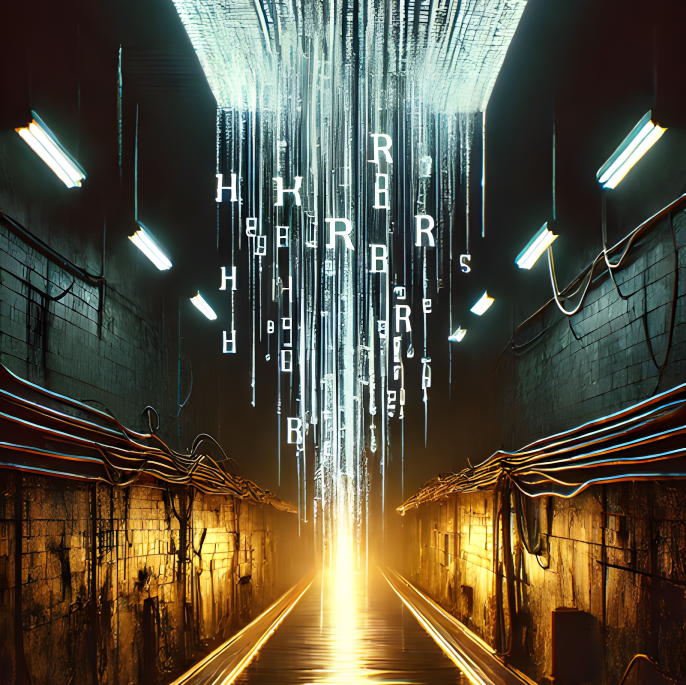
23:43 - untethered alert.
Invitation to join Level 2 CP mixnet.
Confirmation Key: M0ntann4Sc0ttySn00ps2031
Fabian lay back in his single bed. He followed the personalized invite link Scott had generated. It must have been strange, he thought, when space was not at a premium, when people went for a walk to escape, rather than lie on their bunk and plug themselves into a metaverse or L2 world. The Ledger made everything easy, an all-in-one software system for citizens so dialed in to their lifeplans, they didn’t have a second to spare. That’s how it had seized control of the nation.
The forum loaded and he found his welcome message from Scott.
Relay from T1n4Red:
It is never too late to use the powers of surveillance for good, Operative Sixsmith. Underworld 4gives but the ledger does not 4get.
In the darkness of his cabin, his face bathed in blue light, Fabian sat bolt upright. His head broke the plane of the holoscreen and a tinge of current trickled through his temple. She knew who he was; she knew what he had done. A charge pulsed through him, the thrill of true privacy. How had he been duped into thinking a total lack of encryption guaranteed freedom and not a glass cage?
The holoscreen flickered for a second. A multimedia message.
Level 2s were a gray area, not illegal. Messages could be relayed peer to peer along a mixnet to the end user. With personalized links hidden in messages on the public comms ledger, communities could be discerning about who joined.
When Fabian leaned back into a lying position, he was greeted by a 3D render of the woman he’d been chasing for over a year. His eyes drank in the red-lipped smile and blonde hair of the woman he’d forced underground, never to feel the rays of the Montana sun again. She held a piece of paper up to the camera, but Fabian couldn’t tear his eyes from her piercing gaze. 64k cameras could pick up the tiniest imperfection. She looked even more real than if he saw her in the flesh. The piece of paper she held was another invite code — this time to an L3 channel.
Fabian exhaled. Breathe. He ran his finger over the chain of three tiny moles above his right eyebrow as if checking they were still there. There were agents who’d been on the force for decades without penetrating Level 3. All messages were stored on the Ledger — that couldn’t be avoided. But with all the red herrings and strong encryption, it was impossible for even the most powerful computers at DoS to uncover much about the members of Underworld’s inner circle. Fabian’s hand reached for his untethered brick. He entered the address from the 3D render of Tina’s paper, followed by the 24-character code from the paper on the outside of the brick. He was in. His next shift at DoS started in ten hours, but he knew he wouldn’t sleep much before then. Tina, and the Underworld answers he’d been seeking awaited on the L3 forum. Fabian made his way to the bathroom and rooted out an old lighter from the medicine cabinet. Staring back from the mirror was his reflection; perhaps it was an avatar of him bound for the Underworld while he remained in the meatspace with his tiny closet apartment and faltering lifeplan. They both watched the password on the paper note burn.
The hubbub of DoS Sector 4A quietened as Fabian walked down the corridor. The hum of hundreds of microcameras was imperceptible to human ears. The one place without them was the toilets — a DoS employee committee had made sure of that — and that is where Fabian’s untethered communicator brick lay. Even if it was found on a bug sweep, they couldn’t trace it to him. And he had ten minutes every two hours to get to the bathroom and check in.
At first she’d been cautious, wanting to know if Fabian would follow her precise instruction. Then, information from Tina had came fast and furious. Names, transactions, locations, protocol, so much information. The tips she’d provided checked out. In fact, they were all just about low-level enough that it was believable that Fabian’s data-driven detective work had unearthed them. She’d even provided a methodology to show which macros and filters he could use to locate L2 peddlers and fixers.
He removed the floor tile behind the toilet bowl. This never got less gross. After relieving himself and pulling the flush chain, he attached the remote charge pack and switched it on. No battery, no trace signal.
11:03 - Message waiting: 6Smith, something important is about to happen. Act surprised. After confirmation, we must meet in person. It will not be easy to get you here. Instructions will follow.
Fabian heard the toilet door open. Could DoS be employing physical spies without the use of cameras in the bathrooms?
The sound of a belt buckle. Charcoal-gray trousers descended and appeared on top of brown loafers through the little gap under the cubicle wall. The heavy-set man dumped himself onto the john and exhaled.
After he deleted the message, Fabian switched off the phone and wiped the power back into his remote charger. He scrubbed his prints off the brick and replaced it behind the bowl. Another flush and he was gone. Out the door before charcoal trousers could physically tie him to the brick. If he was snooping, they would know. He’d get questions about using an unsanctioned jailbroken device. Maybe he could claim he was trying to arrange a physical meeting with T1n4Red. Still, the interrogation would be brutal.
Back on the floor, Agent Williams activated a meeting alert on Fabian’s desk. The red light informed him he must report to the cube immediately. It took great restraint for Fabian to avoid any nervous ticks. Especially with the scrutiny of operatives at his level, he couldn’t avoid a single nervous exploration of the moles on his temple or wiping of hands on trousers. The electronic band every citizen had clamped around their right wrist fed streams of bio-data to the DoS servers. Who would be alerted if his heartbeat spiked or breathing patterns changed? As he’d learned on the L2 forums, flying under the radar took a lot more than digital restraint. The surveillance apparatus of the state kept so much biometric data it had become a living cyborg. Could this be about the bathroom break? The guy in the next stall with the charcoal trousers? The brick? Was this the start of a downfall that ended in the same invisible blacklist Scott was on? Maybe that chick in the library had something against him too.
The glass door slid open and Fabian moved through the entry point in one clean step.
“No need to sit, Operative Sixsmith. Let’s stay on our feet here.”
Sixsmith awaited the news. Whatever it was, at least it would be quick.
Williams raised a stainless steel travel mug to his lips and drank. If the coffee was hot, he showed no signs of it. “I must admit, I’ve had my doubts about you.” An ominous start. “Up until this year, your work was adequate.” Williams paced towards the glass wall to watch the goings on of the morning-shift operators. His invisible stare could put someone’s back out. “And that stunt you pulled to get the jump on T1n4Red… some stricter agents might have filed that as a denial-of-protocol infraction.”
Fabian locked his gaze to the coffee cup and let him talk.
“But since then, your results have been quite something. An 89% strike rate on intel and twelve L2 agitators liquidated. That’s as high as I’ve seen.”
“Thank you, sir.” Fabian rearranged his cotton shirt, which, despite the blasting air con, was stuck firmly to his back.
“Good news.” Agent Williams went to his desk drawer and removed a six-inch blade. The silver tip matched the glint of William’s graying hair under the strip light. “You are no longer an operative here at the Department of Surveillance.”
Fabian imagined the angle of attack. A diagonal slashing motion from up high. He wouldn’t have time to avoid the agent’s quick reflexes.
“Congratulations, Agent Sixsmith.”
Fabian took a step back. His right hand found its way to his brow. “What?”
“You’ve been promoted, son. It can’t be that much of a surprise.”
Fabian had spent so long tracking certainties, he had forgotten what surprise felt like. He had his doubts about the system, his L3 secrets, his upcoming liaison with T1n4Red, his friendship with Scott. But things would be better as an agent. His family back in Boston would surely offer some begrudging respect. If he wasn’t six feet under, his old man might feel some kind of peace knowing his boy had won back those credits. Freedom from bio-data collection and freedom to roam. He faced his boss. “But I’m not up for review until—”
“Take the win.” Williams approached, knife in hand. “We need all the capable agents we can get.” He reached for Fabian’s right forearm. His grip was that of a much bigger man. “Effective immediately, you are Agent Sixsmith of the Department of Surveillance.” He slid the knife under Fabian’s communicator wristband and sliced through the strap.
The cool office air touched his now naked wrist. Fabian smoothed the skin as if he had been unshackled.
Once Williams returned the knife to its drawer, he offered his hand to shake. “Congratulations, Agent. Full briefing tomorrow at 0930.”
“Yes sir. Thank you for your trust.” He turned to go.
“Stop,” a sharp voice called. Williams held a small piece of metal between thumb and forefinger. “Don’t forget this.”
Agent Fabian Sixsmith accepted the gift — an American flag pin. He nodded and stepped through the doorway in the same way he entered.
](https://image.nostr.build/b3cff409a4d05409b84ddd61f9689f707b24376f196887558c2eaee1d17c8275.jpg)
Fabian zipped his thick hoodie and stepped out into the night. The reflectors in the fabric would dazzle the night vision of the cameras, and the Federal Government hadn’t passed any laws telling people how to dress… yet. He opened the door and set out to meet his handler.
He started his run towards the city outskirts, the hood shrouding his adrenaline-shot eyes. The back of his skull throbbed. It had been bothering him all afternoon. Throwing in a few boxing moves for good measure, Fabian pounded out the miles. One, two, past the city limits and onto the shoulder of the 87, the sixteen-wheeler auto rigs ripping past. The drones would be following — of that he was sure.
His handler was there. Just like Tina said. Half a mile after the first junction, under the bridge, Scott straddled his solarbike. This must be how he earned his sats — acting as a go between for Underworld agents who had gone to ground.
No words, just the exchange. Fabian unzipped the hoodie and draped it over his friend’s shoulders. Scott removed a 3D image scanner from his pocket and ran it over Fabian’s face. Two seconds and the ID confirmation would be relayed on the Ledger, probably embedded with a stego message. A quick clap of the hands, and he drove into the night. Forty, fifty, sixty, and gone, west towards Great Falls. Fabian took a breath. Is this what he had done all those reps in the closet for? He scrambled up the bank and jumped for the bridge railing. Hauling his body up and over in one swift motion. Then, crouching low behind the advertising hoarding, he duck-walked over the bridge and down the bank. How would he disable the micro cameras? Even without tracking data, the DoS apparatus wouldn’t be far behind — especially after they scrambled a drone to intercept Scott. Thirty seconds tops.
This place, just a few miles away from Lewistown, was the setting for one of those books he loved — cowboys, sheriffs, and theft. Of course, the subterfuge of Level 3 protocol and 256-bit encryption was a little more complicated now. The idea of coding messages is as old as civilization, only the attack vectors changed over time.
Left. Right. Feet smacking dirt. Fabian had to trust the track was level. He could barely see three feet in front of him — only the dim Montana moonlight for company. The whirr of a camcopter approached overhead. If it locked his thermal image, he was toast. Just a few more strides surely. His lungs burned after all those miles.
DoS wasn’t just going to let a newly-minted agent go for a mysterious wilderness night run.
His foot jammed against a root. He stumbled on, narrowly avoiding a painful fall.
“IDENTIFY ORDER.” The camcopter had locked the human gait recognition. “FAILURE TO COMPLY EVOKES FEDERAL CREDIT ELIMINATION.”
Fabian almost laughed. These fucking things threatening to zero-out people’s hard-earned savings. How the hell had Americans let things go this far? He spotted the manhole cover under the tree. His lungs sucked in the night air, and his heart tore at his ribs.
Wham. Down to the ground. The force of a truck pinned Fabian and pushed his face into the dirt. “No,” he cried. “Let me explain.” Searing pain pulsed through his skull from the back to the front. In the seconds that followed, it was as if his brain was rebooting. Who was this? What were they doing?
“Neural tracer deactivated,” said the voice of the brute on top of him.
Fabian managed to turn his head. He caught a glimpse of the man, but it was too dark to see his face. The pressure on Fabian’s back slowly released. He shook the cobwebs out of his head.
As Fabian stood, he saw the guard moving away, pointing his EMP caster at the sky, sweeping left then right.
Crash. One dronecopter downed. A crash to the right, another drone gone. These things would be disposed of in some pit or quarry. The figure collected the drones and moved into the night.
Fabian dusted himself off and walked towards his destination of the irrigation pipe system. As Agent Sixsmith hauled the steel grate to the side, he took a breath. This was it. Too late to deny involvement. Too far down the rabbit hole. He’d have to give up everything he worked for — respect at Thanksgiving and a pension large enough to retire to a ranch and ride a horse over the land. In exchange, he’d get a one-time Underworld trip, where he would learn the methods and tactics the punks used to stay off grid.
Now it was quiet, bar the low hum of the highway and the sound of his rasping breath. He’d never been this alive. It sure beat the meticulous protocol of DoS. Before he could stop himself, Fabian was inside, his hands replacing the grate, gripping the ladder, his feet on the rungs, stepping down, down into the dark. Whatever she had to tell him, he needed to hear it. Meeting T1n4Red in the meatspace trumped any handshake from Agent Williams, any pension plan, and any begrudging respect from his nagging mother and fucked-up family. He descended to the Underworld.
At the end of the dank tunnel, Fabian saw the purple glow of UV light. He approached slowly. The sound of soft footsteps approached from behind. He didn’t dare turn. Then, a few paces from the curve where the light grew stronger, a flat plastic object jammed the base of his skull forward. Click. Probably a 3D-printed gun.
“Arms out. Legs astride.”
Fabian complied. The EM scan wouldn’t find anything. He was stripped of all tech — one of the many firsts he’d experienced that day. It was safer for all parties if he didn’t turn around.
The voice barked, “Clear,” and a rough hand pushed him forward. The footsteps descended back towards the tunnel opening.
Peering into the mirror positioned at the tunnel corner, Fabian caught a glimpse of the woman he came to see. The channel between well-defined back muscles drew his eye south. How long had it been since he felt the touch of a woman? How did she stay in such good shape down here? The weak UV light faded to a soft yellow glow in the chamber.
“Agent Sixsmith. We’ve been expecting you.” Tina pulled a t-shirt over her bra and cinched her blonde hair into a top bun. She laughed. “Take a seat.”
“How do you know I’m an agent?” Fabian sat on the plastic chair closest to him. The room had been widened from its original layout. It was now around fifteen feet square with a camp bed, a desk with double monitors, and a treadmill. His eyes settled on the black desktop compu-box.
She touched his arm, her hand surprisingly warm. “I bet you’d love to open that up and take a look.”
Fabian had never seen a homemade device connected up. Getting the parts must have taken years, but nobody could detect unregistered tech through lead linings and all the perimeter protocal. She truly owned something, even if it was just a little black box.
“You didn’t think agents are unsurveilled, did you? Poor boy.”
Fabian’s mind switched to rational mode. Was he burned? Would he ever be able to surface without getting financially or physically liquidated?
“Relax. I know what you’re thinking. This is your first trip here, but it won’t be your last. We fried your tracer chip and they can’t admit they implanted ‘cause it ain’t legal.” She swiveled the computer chair and sat on it back to front. The high chair back almost came up to her chin. “You get one question. Shoot.”
In their digital conversation, Tina had always been careful to give instructions only, never responding to Fabian’s questions. He might have a lot to learn, but at least he wasn’t living in the dark like her, a trapped soldier unable to look above the parapet. Was he walking into a trap? Was he already in one? If things got tough in the interrogation he was sure to receive from Williams, he could always offer some Underworld secret. Fabian turned to face the shadow of a woman he had chased for nearly a year. “Where are the Level 3 relay servers kept?”
“Ooh amor, you’ve gotta think bigger than that.” Tina Red was more than just a celebrity crush. Her blue eyes burned with the intensity of a neutron star. Her slender legs wrapped around the chair like a boa constrictor drawing in its prey. She drew closer, and he could smell the sweat. “There are no dedicated L3 relay servers. We’ve been using a hacked DoS server for months. Keeps you searching for that mythical Underworld data center, right?”
There were so many units in the DoS server cities that it would take years to isolate the hack. Smart. “What’s the end goal to all of this?” he asked.
Instead of replying, Tina shook her head.
Play by Underworld rules, Fabian. It didn’t matter — he knew. Reversing the grip of the big-government machine was virtually impossible, but the dream was that the country returned to ‘the land of the free.’ Freedom to secrecy. Freedom to own. Freedom to transact with whomever you wanted.
Fabian watched as T1n4Red stood and crossed the six-foot gap between them. She leant over and moved a hand to the back of his hair, gripping his short black hair in her fist. The same fear pulsed through him as in the meeting he’d had with Agent Williams — the same Williams who was organizing the search and interrogate protocol for him at that very moment. Was her bodyguard waiting around the corner with the 3D-printed gun, primed to deliver its one shot straight into his brain?
“This is our endgame.” Their faces were inches apart. He saw the same freckles and imperfections in her skin as in the high-res digital render. But there was nothing like real life.
And then, a swell of the tide inside him. Euphoria. The kiss was deep. Their lips fused, one person, one dream. Fabian’s hands reached for the shape of the woman he’d dreamed about so many nights. She sat, straddling his legs and they went on. Blood rising like an ocean swell, Fabian dived into bliss. It all melted away — the dronecopters hovering above, the awkward entry to the office tomorrow, the nagging fear that his accounts would be zeroed out in mere hours. But one image remained. The moment transported Fabian to his spiritual home — the wilds of the Montana hills, the wind blowing through the grassland, the mountain range guarding the horizon. The wild country that called him.
When they finally broke the kiss, Tina stood. “Did you feel it?”
Fabian raised his gaze. “I think so. A place. The wild—”
She raised a finger to silence him. “Don’t say it. This is our secret, Agent Sixsmith.”
He thought for a second. Project Wild Country. It was strange, but he had no doubt. The phrase was branded into his mind clearer than the passphrase he had to memorize for his DoS access. How could two beings communicate telepathically?
“It’s called ‘Telepathic Key Exchange’. TKX for short.” Tina approached and whispered into his ear. “From the mentalists of the late 20th Century.” It had been there all along — a method to eliminate the gap where biological beings had to enter a passphrase physically. This was only part of the information chain without a cipher. No more worries about the micro cameras that could capture keystrokes or capture pen and ink comms.
“Our project,” she breathed.
The image swam through Fabian’s mind once more, the color of the sky as vivid as the eyes of the woman in front of him. The hills and plains in front of them. All protests start with the spark of non-compliance. And all revolution hinges on the man who knows how to play both sides. He’d have to learn more about it, understand it better, but TKX could lay the path to a fully anonymous market, unbreakable smart contracts, and a citizens’ private arbitration court. This would be the rewilding of America.
“We only have a few more minutes.” Tina returned to her chair. She explained the comms protocol and that the two of them were the only people on Earth to know the name of this mission. Project Wild Country would bring TKX to the masses.
“How can we teach people?”
“We lead people through the levels, just like I got you here. There are more stego images on the Ledger every day. It’s already started.”
Fabian looked at the wrist his bio-band had once gripped. “What do I say to DoS to explain this time-gap?” How long had he even been down there, fifteen minutes?
“You wouldn’t be much of an agent if you couldn’t think of something. Be the sovereign of yourself, Fabian.” T1n4Red laughed. “Better get running.”
Fabian moved toward the dark tunnel that led to a surface world buzzing with invisible spies. “I’ll be thinking of you,” he said. Fabian thought he detected the hint of a smile on Tina’s lips, and he felt a tiny swell of the euphoria that had filled him moments earlier. Then, he turned to go. Agent Sixsmith rounded the corner and started his journey back to the wild country.
This story first appeared in Financial Fallout. Find out more about the book at 21futures.com
21 Futures retains 21% of the zaps received to cover operating costs. The majority of the sats are forwarded to the author.

Max Hillebrand is a praxeologist who contributes to several open-source projects, because code is abundant and not scarce. He shares his work freely for others to use and modify. His goal is to help build a parallel economy based on sound money and individual sovereignty, where people can pursue their entrepreneurial ambitions without interference from central authorities. Find out more at towardsliberty.com
-
 @ 26769dac:498e333b
2025-05-28 18:56:30
@ 26769dac:498e333b
2025-05-28 18:56:30I am here too\ In the same space like you
In the same situation I'm in\ It's a matter of positioning
I cannot leave this place I'm in\ It was brought about\ By what's been happening
So please don't look at me\ For what I can or cannot do for you\ But look at what is happening for me\ And what is happening for you
Let's communicate\ Not orchestrate
Because there's something I wish to do\ And there's a place I wish to go to
And I'm sure that there is too\ In your heart a fire\ Known by only you
So let us listen, look and see\ For what's true for you\ And what's true for me
That we may act upon what's here\ In order for us both to take a step\ In the direction we wish to steer
-
 @ 9e9085e9:2056af17
2025-05-29 07:51:18
@ 9e9085e9:2056af17
2025-05-29 07:51:18Part 5: Why You Should Join Yakihonne Today
🚀 Yakihonne: The Future of Free, Fair & Fast Social Interaction
Looking for a platform where you control everything—your posts, your data, your income?
Yakihonne is not just another app. It's a movement. A decentralized social payment network where:
Your voice can't be silenced
Your data isn't sold
Your followers are truly yours
Your creativity can be rewarded instantly
🔥 6 Reasons to Pay Attention to Yakihonne:
-
Zero Censorship Say what matters without fear of being muted or banned.
-
Built on Nostr Protocol Secure, scalable, and permissionless by design.
-
Social + Payments in One Chat, connect, and get paid—all from one app.
-
Lightning Fast Tips Reward content instantly with Bitcoin micro-payments.
-
No Algorithms. No Ads. No Noise. What you see is what you follow—simple and clean.
-
True Digital Freedom Break free from centralized control and own your digital presence.
🔗 Explore now: https://yakihonne.com 📱 Available on #iOS & #Android
-
-
 @ cae03c48:2a7d6671
2025-05-28 19:00:54
@ cae03c48:2a7d6671
2025-05-28 19:00:54Bitcoin Magazine
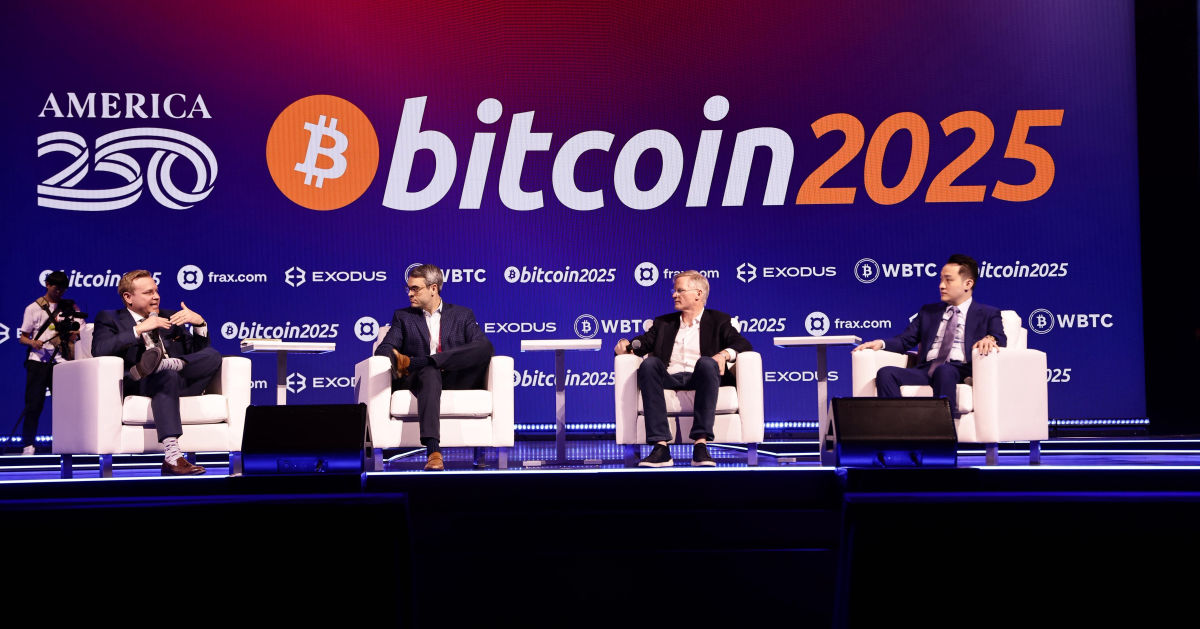
Bitcoin Enters a New Era: Industry Leaders Predict Trillions in Institutional InflowsAt the 2025 Bitcoin Conference in Las Vegas, the Founder and CEO of Kelly Intelligence Kevin Kelly, the Chief Executive Officer of Bitwise Asset Management Hunter Horsley, the CEO of BitGo Mike Belshe and the Advisor of WBTC Justin Sun talked about the future of financial products in the globe.
Hunter Horsley started the panel by saying that we are entering a new chapter in 2025 with the change in the regulatory circumstances.
“In the US wealth managers manage between 30 and 60 trillion dollars,” said Horsley. “If wealth managers wind up allocating 1% to the space on behalf of their clients, helping their clients access the opportunities here that are hundreds and billions of dollars.”
JUST IN:
 $12 billion Bitwise CEO Hunter Horsley says if wealth managers allocate 1% to #Bitcoin, “that's hundreds of billions of dollars.”
$12 billion Bitwise CEO Hunter Horsley says if wealth managers allocate 1% to #Bitcoin, “that's hundreds of billions of dollars.”  pic.twitter.com/4OhoBjwDYR
pic.twitter.com/4OhoBjwDYR— Bitcoin Magazine (@BitcoinMagazine) May 27, 2025
Justin Sun emphasized the importance of integrating Bitcoin into decentralized finance (DeFi) platforms:
“Raw Bitcoin is a way to get your Bitcoin into a smart contract platform,” said Sun. “You can use your Bitcoin as collateral you borrow like stablecoin, you borrow other major crypto currencies tokens and also of course generate yield on the Bitcoin you are holding because Bitcoin is a proof of network.”
“Any transaction you can see in the blockchain and all the reserve addresses is available on the Blockchain. It’s safe and transparent and at the same time is smart,” stated Sun.
Mike Belshe elaborated on the foundational elements that make a stablecoin successful, particularly when Bitcoin is used in that context.
“What makes a good stablecoin whether you are talking about dollars or Bitcoin, it’s the liquidity that you have on the market around the world,” stated Belshe.
Horsley continued by addressing that we’ll see more companies adopting this and hundreds of thousands of Bitcoin being put onto more balance sheets.
“Corporations are buying Bitcoin,” commented Horsley. “It’s an extraordinary theme of this year. As of the first quarter of this year, 79 publicly traded companies had put Bitcoin on their balance sheet. Over 600k Bitcoin and there is only 21 million Bitcoin. It’s a lot of Bitcoin”
Justin Sun closed the panel by stating, “the progress we are making here in the United States really matters because as we all further encourage people around the world to get into the Bitcoin industry.”
“Once Bitcoin passes this kind of stage and gets institution adoption in the United States will accelerate that option globally,” said Sun.
This post Bitcoin Enters a New Era: Industry Leaders Predict Trillions in Institutional Inflows first appeared on Bitcoin Magazine and is written by Oscar Zarraga Perez.
-
 @ 088436cd:9d2646cc
2025-05-01 21:01:55
@ 088436cd:9d2646cc
2025-05-01 21:01:55The arrival of the coronavirus brought not only illness and death but also fear and panic. In such an environment of uncertainty, people have naturally stocked up on necessities, not knowing when things will return to normal.
Retail shelves have been cleared out, and even online suppliers like Amazon and Walmart are out of stock for some items. Independent sellers on these e-commerce platforms have had to fill the gap. With the huge increase in demand, they have found that their inventory has skyrocketed in value.
Many in need of these items (e.g. toilet paper, hand sanitizer and masks) balk at the new prices. They feel they are being taken advantage of in a time of need and call for intervention by the government to lower prices. The government has heeded that call, labeling the independent sellers as "price gougers" and threatening sanctions if they don't lower their prices. Amazon has suspended seller accounts and law enforcement at all levels have threatened to prosecute. Prices have dropped as a result and at first glance this seems like a victory for fair play. But, we will have to dig deeper to understand the unseen consequences of this intervention.
We must look at the economics of the situation, how supply and demand result in a price and how that price acts as a signal that goes out to everyone, informing them of underlying conditions in the economy and helping coordinate their actions.
It all started with a rise in demand. Given a fixed supply (e.g., the limited stock on shelves and in warehouses), an increase in demand inevitably leads to higher prices. Most people are familiar with this phenomenon, such as paying more for airline tickets during holidays or surge pricing for rides.
Higher prices discourage less critical uses of scarce resources. For example, you might not pay $1,000 for a plane ticket to visit your aunt if you can get one for $100 the following week, but someone else might pay that price to visit a dying relative. They value that plane seat more than you.
*** During the crisis, demand surged and their shelves emptied even though
However, retail outlets have not raised prices. They have kept them low, so the low-value uses of things like toilet paper, masks and hand sanitizer has continued. Often, this "use" just takes the form of hoarding. At everyday low prices, it makes sense to buy hundreds of rolls and bottles. You know you will use them eventually, so why not stock up? And, with all those extra supplies in the closet and basement, you don't need to change your behavior much. You don't have to ration your use.
At the low prices, these scarce resources got bought up faster and faster until there was simply none left. The reality of the situation became painfully clear to those who didn't panic and got to the store late: You have no toilet paper and you're not going to any time soon.
However, if prices had been allowed to rise, a number of effects would have taken place that would have coordinated the behavior of everyone so that valuable resources would not have been wasted or hoarded, and everyone could have had access to what they needed.
On the demand side, if prices had been allowed to rise, people would have begun to self-ration. You might leave those extra plies on the roll next time if you know they will cost ten times as much to replace. Or, you might choose to clean up a spill with a rag rather than disposable tissue. Most importantly, you won't hoard as much. That 50th bottle of hand sanitizer might just not be worth it at the new, high price. You'll leave it on the shelf for someone else who may have none.
On the supply side, higher prices would have incentivized people to offer up more of their stockpiles for sale. If you have a pallet full of toilet paper in your basement and all of the sudden they are worth $15 per roll, you might just list a few online. But, if it is illegal to do so, you probably won't.
Imagine you run a business installing insulation and have a few thousand respirator masks on hand for your employees. During a pandemic, it is much more important that people breathe filtered air than that insulation get installed, and that fact is reflected in higher prices. You will sell your extra masks at the higher price rather than store them for future insulation jobs, and the scarce resource will be put to its most important use.
Producers of hand sanitizer would go into overdrive if prices were allowed to rise. They would pay their employees overtime, hire new ones, and pay a premium for their supplies, making sure their raw materials don't go to less important uses.
These kinds of coordinated actions all across the economy would be impossible without real prices to guide them. How do you know if it makes sense to spend an extra $10k bringing a thousand masks to market unless you know you can get more than $10 per mask? If the price is kept artificially low, you simply can't do it. The money just isn't there.
These are the immediate effects of a price change, but incredibly, price changes also coordinate people's actions across space and time.
Across space, there are different supply and demand conditions in different places, and thus prices are not uniform. We know some places are real "hot spots" for the virus, while others are mostly unaffected. High demand in the hot spots leads to higher prices there, which attracts more of the resource to those areas. Boxes and boxes of essential items would pour in where they are needed most from where they are needed least, but only if prices were allowed to adjust freely.
This would be accomplished by individuals and businesses buying low in the unaffected areas, selling high in the hot spots and subtracting their labor and transportation costs from the difference. Producers of new supply would know exactly where it is most needed and ship to the high-demand, high-price areas first. The effect of these actions is to increase prices in the low demand areas and reduce them in the high demand areas. People in the low demand areas will start to self-ration more, reflecting the reality of their neighbors, and people in the hotspots will get some relief.
However, by artificially suppressing prices in the hot spot, people there will simply buy up the available supply and run out, and it will be cost prohibitive to bring in new supply from low-demand areas.
Prices coordinate economic actions across time as well. Just as entrepreneurs and businesses can profit by transporting scarce necessities from low-demand to high-demand areas, they can also profit by buying in low-demand times and storing their merchandise for when it is needed most.
Just as allowing prices to freely adjust in one area relative to another will send all the right signals for the optimal use of a scarce resource, allowing prices to freely adjust over time will do the same.
When an entrepreneur buys up resources during low-demand times in anticipation of a crisis, she restricts supply ahead of the crisis, which leads to a price increase. She effectively bids up the price. The change in price affects consumers and producers in all the ways mentioned above. Consumers self-ration more, and producers bring more of the resource to market.
Our entrepreneur has done a truly incredible thing. She has predicted the future, and by so doing has caused every individual in the economy to prepare for a shortage they don't even know is coming! And, by discouraging consumption and encouraging production ahead of time, she blunts the impact the crisis will have. There will be more of the resource to go around when it is needed most.
On top of this, our entrepreneur still has her stockpile she saved back when everyone else was blithely using it up. She can now further mitigate the damage of the crisis by selling her stock during the worst of it, when people are most desperate for relief. She will know when this is because the price will tell her, but only if it is allowed to adjust freely. When the price is at its highest is when people need the resource the most, and those willing to pay will not waste it or hoard it. They will put it to its highest valued use.
The economy is like a big bus we are all riding in, going down a road with many twists and turns. Just as it is difficult to see into the future, it is difficult to see out the bus windows at the road ahead.
On the dashboard, we don't have a speedometer or fuel gauge. Instead we have all the prices for everything in the economy. Prices are what tell us the condition of the bus and the road. They tell us everything. Without them, we are blind.
Good times are a smooth road. Consumer prices and interest rates are low, investment returns are steady. We hit the gas and go fast. But, the road is not always straight and smooth. Sometimes there are sharp turns and rough patches. Successful entrepreneurs are the ones who can see what is coming better than everyone else. They are our navigators.
When they buy up scarce resources ahead of a crisis, they are hitting the brakes and slowing us down. When they divert resources from one area to another, they are steering us onto a smoother path. By their actions in the market, they adjust the prices on our dashboard to reflect the conditions of the road ahead, so we can prepare for, navigate and get through the inevitable difficulties we will face.
Interfering with the dashboard by imposing price floors or price caps doesn't change the conditions of the road (the number of toilet paper rolls in existence hasn't changed). All it does is distort our perception of those conditions. We think the road is still smooth--our heavy foot stomping the gas--as we crash onto a rocky dirt road at 80 miles per hour (empty shelves at the store for weeks on end).
Supply, demand and prices are laws of nature. All of this is just how things work. It isn't right or wrong in a moral sense. Price caps lead to waste, shortages and hoarding as surely as water flows downhill. The opposite--allowing prices to adjust freely--leads to conservation of scarce resources and their being put to their highest valued use. And yes, it leads to profits for the entrepreneurs who were able to correctly predict future conditions, and losses for those who weren't.
Is it fair that they should collect these profits? On the one hand, anyone could have stocked up on toilet paper, hand sanitizer and face masks at any time before the crisis, so we all had a fair chance to get the supplies cheaply. On the other hand, it just feels wrong that some should profit so much at a time when there is so much need.
Our instinct in the moment is to see the entrepreneur as a villain, greedy "price gouger". But we don't see the long chain of economic consequences the led to the situation we feel is unfair.
If it weren't for anti-price-gouging laws, the major retailers would have raised their prices long before the crisis became acute. When they saw demand outstrip supply, they would have raised prices, not by 100 fold, but gradually and long before anyone knew how serious things would have become. Late comers would have had to pay more, but at least there would be something left on the shelf.
As an entrepreneur, why take risks trying to anticipate the future if you can't reap the reward when you are right? Instead of letting instead of letting entrepreneurs--our navigators--guide us, we are punishing and vilifying them, trying to force prices to reflect a reality that simply doesn't exist.
In a crisis, more than any other time, prices must be allowed to fluctuate. To do otherwise is to blind ourselves at a time when danger and uncertainty abound. It is economic suicide.
In a crisis, there is great need, and the way to meet that need is not by pretending it's not there, by forcing prices to reflect a world where there isn't need. They way to meet the need is the same it has always been, through charity.
If the people in government want to help, the best way for the to do so is to be charitable and reduce their taxes and fees as much as possible, ideally to zero in a time of crisis. Amazon, for example, could instantly reduce the price of all crisis related necessities by 20% if they waived their fee. This would allow for more uses by more people of these scarce supplies as hoarders release their stockpiles on to the market, knowing they can get 20% more for their stock. Governments could reduce or eliminate their tax burden on high-demand, crisis-related items and all the factors that go into their production, with the same effect: a reduction in prices and expansion of supply. All of us, including the successful entrepreneurs and the wealthy for whom high prices are not a great burden, could donate to relief efforts.
These ideas are not new or untested. This is core micro economics. It has been taught for hundreds of years in universities the world over. The fact that every crisis that comes along stirs up ire against entrepreneurs indicates not that the economics is wrong, but that we have a strong visceral reaction against what we perceive to be unfairness. This is as it should be. Unfairness is wrong and the anger it stirs in us should compel us to right the wrong. Our anger itself isn't wrong, it's just misplaced.
Entrepreneurs didn't cause the prices to rise. Our reaction to a virus did that. We saw a serious threat and an uncertain future and followed our natural impulse to hoard. Because prices at major retail suppliers didn't rise, that impulse ran rampant and we cleared the shelves until there was nothing left. We ran the bus right off the road and them blamed the entrepreneurs for showing us the reality of our situation, for shaking us out of the fantasy of low prices.
All of this is not to say that entrepreneurs are high-minded public servants. They are just doing their job. Staking your money on an uncertain future is a risky business. There are big risks and big rewards. Most entrepreneurs just scrape by or lose their capital in failed ventures.
However, the ones that get it right must be allowed to keep their profits, or else no one will try and we'll all be driving blind. We need our navigators. It doesn't even matter if they know all the positive effects they are having on the rest of us and the economy as a whole. So long as they are buying low and selling high--so long as they are doing their job--they will be guiding the rest of us through the good times and the bad, down the open road and through the rough spots.
-
 @ cae03c48:2a7d6671
2025-05-28 19:00:53
@ cae03c48:2a7d6671
2025-05-28 19:00:53Bitcoin Magazine

Cowbolt Announces Their Mission to Make Bitcoin Familiar to EverybodyToday at the Bitcoin Conference in Las Vegas, Cowbolt, an app that lets you split expense payments and settle in bitcoin, will launch their mission: turn peer-to-peer payments into a Bitcoin onramp, starting with family and friends.

Cowbolt will let their clients split costs and settle instantly using Bitcoin and USDT, with no middlemen, no bank friction and with self-custody. They will try to convert everyday transactions into Bitcoin adoption.
“We believe the most powerful onramp to Bitcoin isn’t an exchange — it’s people,” said the co-founder of Cowbolt Daniel Ekström. “That’s why we built Cowbolt. For friends, not hedge funds.”
What Cowbolt will bring to the table:
- Split and settle.
- Keep your keys.
- Fast and trusted.
- Works across borders.
The app is already being used for remittances, group travel, and day-to-day payments. It’s designed to be like a modern fintech app and will be available for iOS and Android.
“Building Airbnb taught me that when design is simple and gets out of the way, people do amazing things,” stated the ex-Creative Director at Airbnb & co-founder Cowbolt Tony Högqvist. “That’s the point here too. Not to store bitcoin in an ETF, but to use it between people. Effortlessly. Among teams, friends, families — every day.”

This post Cowbolt Announces Their Mission to Make Bitcoin Familiar to Everybody first appeared on Bitcoin Magazine and is written by Oscar Zarraga Perez.
-
 @ 005bc4de:ef11e1a2
2025-05-28 16:24:41
@ 005bc4de:ef11e1a2
2025-05-28 16:24:41
Two days ago I put this out: https://peakd.com/hive-124838/@crrdlx/hostr-snaps-9i13ooa7ufp
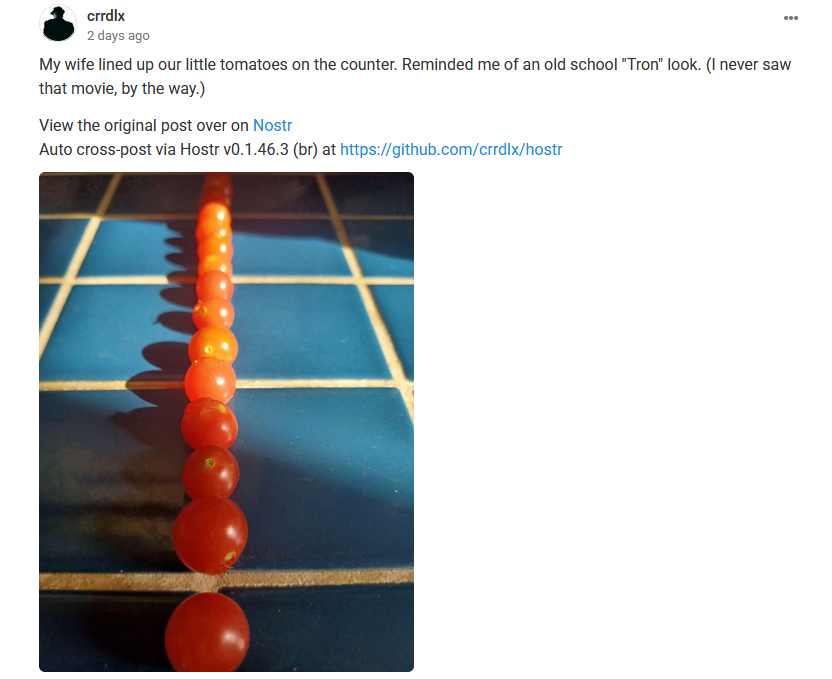 Post: https://peakd.com/hive-124838/@crrdlx/hostr-snaps-9i13ooa7ufp
Post: https://peakd.com/hive-124838/@crrdlx/hostr-snaps-9i13ooa7ufpOne of the comments said it "...looks like some sort of game as well." That was enough to tickle my curiosity and get me thinking. The round tomatoes and how they nestled into the grooves of the tiles reminded me of Chinese checkers. The grid brought Hex to mind (the game John Nash played) and I wondered if a square-grid version might be viable. A little searching revealed Hex is a "Connection game" and there are several. The one called Tak seemed really interesting and simple. I like interesting and I really like simple.
So, a square grid connection game wouldn't be new, however, you can't play Tak with tomatoes. Tak requires stacking "stones" or standing them on edge, that would be very, very tricky with tomatoes.
I looked around and happened to have some dried corn kernels and dry beans. I drew out a 5 x 5 grid of dots, lined up five corn kernels on one side in a "home row" and 5 beans on the other. We used to play a game where two sides of Army men met after a series of moves. In that game, we rolled dice to have a "combat" and see who would win the little battle. I wanted something like that in my game, some type of combat or conquest, somehow. So, I started messing around, moving kernels and beans, and totally just set out to make this game up on the fly. This is what I got...
Rules
The objective, like Hex or Tak, is to connect one side (your home row) to your opponent's side. The connection to the other side can be a straight line, or it CAN include a diagonal road. Any of the roads below would be a win for team bean (B).
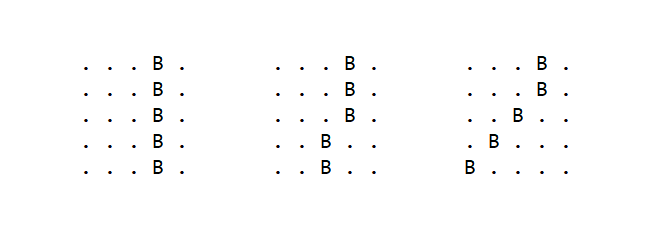
- One side makes a move by sliding one corn/bean one spot forward.
- Then, take turns making moves.
- Movement can only be one spot forward/back or sideways (NSEW). You cannot move diagonally.
- Opponents CAN occupy, or "squat", on the same spot at once. If so, the spot is being "co-squatted" (they're like two people standing in the same sidewalk tile at the same time).
- However, while opponents occupy the same spot, a "combat" might ensue. A corn/bean can "attack" by moving yet another adjoining corn or bean onto the co-squatted spot. A conquest is made by outnumbering a spot 2-to-1. For instance, if a spot is being occupied by both a bean and corn, and then a second corn moves in, the two corns conquer the one bean. The bean is immediately removed. The bean player then places that conquered bean into any empty spot on his or her home row. That placement constitutes the bean player's turn. So, after the bean is placed on the home row, the corn player makes the next move.
- Play continues until someone completes a road from their home row across to their opponent's home row. (Again, a diagonal road is okay for the win.)
- The losing player got Succotashed.
Game name
As to the name, initially I wanted a tomato-ish name. But, I was using corn and beans. So, I'm naming this game "Succotash" after the corn, bean, and vegetable recipe. I considered calling it the "Texas Caviar Game" because it has tomatoes in it, but playing Succotash just sounds better. Plus, putting tomatoes in succotash sounds yummy.
Simple
A big goal here was to keep it simple. To that end, all that's needed is (a) a paper with a 5 x 5 grid drawn on it, and, (b) 5 pieces of something and 5 pieces of something else. Obviously I used corn kernels and beans, but it could easily be shells/legos, pennies/paperclips, nuts/stones, or whatever.
Initially, I had a "storehouse" of extra corn kernels and storehouse of extra beans (seen in the images). My thinking was that they would replace the corn or beans that get conquered by opponents. Upon playing the game, it was apparent that a storehouse is totally unnecessary. Once captured, the same corn/bean can just be the one that's placed back onto the home row. Five of each is fine.
Also, I'm sure the grid could easily be expanded to whatever size you wish. I played an opponent with the 5 x 5 grid, and that seemed a good size for a five minute or so game.
Why not sit down face-to-face with someone for a minute and give Succotash a try? If you do, I'd love to hear how it went.
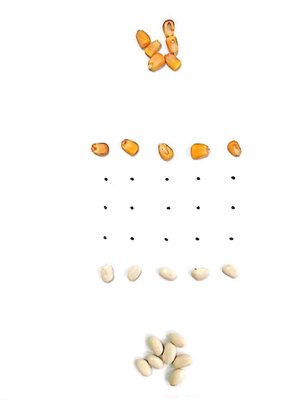
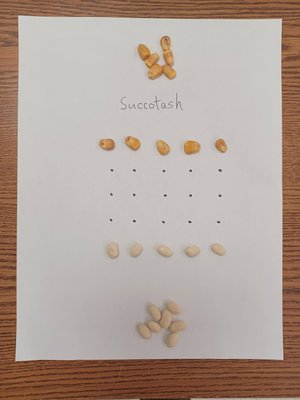
-
 @ da8b7de1:c0164aee
2025-05-28 15:42:22
@ da8b7de1:c0164aee
2025-05-28 15:42:22Nemzetközi nukleáris energetikai hírek
Új amerikai kis moduláris reaktor engedélykérelem
A Tennessee Valley Authority (TVA) benyújtotta az Egyesült Államok Nukleáris Szabályozó Hatóságához (NRC) az engedélykérelmet egy GE Vernova Hitachi Nuclear Energy BWRX-300 kis moduláris reaktor (SMR) megépítésére a Clinch River telephelyen. Ez jelentős lépés az új, fejlett nukleáris technológiák bevezetésében az Egyesült Államokban, és jól mutatja, hogy az SMR-ek egyre fontosabb, rugalmas és skálázható tisztaenergia-megoldássá válnak[world-nuclear-news.org].
Amerikai elnöki rendeletek a nukleáris bővítés felgyorsítására
Donald Trump amerikai elnök négy elnöki rendeletet írt alá, amelyek célja a reaktorengedélyezési folyamatok gyorsítása, a hazai urántermelés növelése és a fejlett nukleáris technológiák bevezetésének felgyorsítása. Az új irányelvek ambiciózus célokat tűznek ki, például az amerikai nukleáris kapacitás megnégyszerezését 2050-re, az NRC számára az engedélyezési idő 18 hónapra csökkentését, valamint szövetségi területek kijelölését új nukleáris létesítmények számára. Ezeket a rendeleteket az „amerikai nukleáris reneszánsz” alapjának szánják, különös hangsúlyt fektetve az AI-ipar energiaigényeinek kielégítésére és a hazai gyártás újjáélesztésére[nucnet.org].
Iparági optimizmus és globális befektetési trendek
Az iparági vezetők egészséges és optimista kilátásokról számolnak be a nukleáris energia terén, kiemelve olyan aktív projekteket, mint a TerraPower Wyomingban, az X-energy és a Dow együttműködése, valamint a Westinghouse tevékenysége Lengyelországban. Különösen nagy az érdeklődés a magánbefektetések iránt a magas dúsítású, alacsony dúsítású urán (HALEU) előállítása terén, illetve annak lehetősége iránt, hogy a Világbank elkezdjen nukleáris projekteket finanszírozni, ami szélesebb körű nemzetközi befektetéseket is elindíthat[ans.org].
Nemzetközi fejlemények és ellátási lánc felkészültsége
Számos ország halad előre a nukleáris fejlesztésekkel: - Kína tíz új reaktort hagyott jóvá. - India szabályozó hatósága engedélyezte egy új, négyblokkos telephely létesítését Rádzsasztánban. - Belgium konzultációt indított egy innovatív, ólom-hűtésű kis moduláris reaktor terveiről. - Brazília várhatóan Oroszországgal közösen fejleszt SMR-projektet. - Csehország új nukleáris szerződéseket köt, a külső politikai nyomás ellenére is.
A globális nukleáris ellátási láncot arra ösztönzik, hogy készüljön fel a gyors növekedésre, kiemelve a helyi és nemzetközi együttműködés fontosságát a növekvő igények kielégítésére[world-nuclear-news.org].
Úszó atomerőművek és tengeri innovációk
Az úszó atomerőművek továbbra is az innováció középpontjában állnak: - Oroszország Akademik Lomonosov nevű úszó atomerőműve elérte az első milliárd kilowattóra termelést. - Az Egyesült Királyságban a Core Power egy amerikai központú tengeri nukleáris programot fejleszt, melynek célja úszó reaktorok telepítése amerikai kikötőkben a 2030-as évek közepére. - A dán Seaborg Technologies (új nevén Saltfoss Energy) kompakt olvadt só reaktor technológián dolgozik, amelyet szintén a 2030-as évekre terveznek bevezetni. - A Westinghouse és a Core Power együttműködik egy úszó atomerőmű fejlesztésén az eVinci mikroreaktorral[world-nuclear-news.org].
Érintettek bevonása és társadalmi bizalom
A Nemzetközi Atomenergia-ügynökség (IAEA) kiemeli az érintettek bevonásának fontosságát a nukleáris energia jövője szempontjából. Folyamatban lévő konferenciáján olyan témákat tárgyalnak, mint a nukleáris energia szerepe az ipari dekarbonizációban, a nyilvános meghallgatások értéke a projektek átláthatósága érdekében, valamint a társadalmi bizalom és a szabályozói megfelelés legjobb gyakorlatai, különösen az új technológiák, például az SMR-ek bevezetése során[iaea.org].
Források: - world-nuclear-news.org - nucnet.org - iaea.org - ans.org
-
 @ cae03c48:2a7d6671
2025-05-28 18:01:12
@ cae03c48:2a7d6671
2025-05-28 18:01:12Bitcoin Magazine

White House Executive Director Bo Hines Declares U.S. The Future Global Crypto SuperpowerIn a session at the Bitcoin 2025 Conference this morning titled “_Making America the Global Bitcoin Superpower“_, Bo Hines, White House Executive Director, Tyler Williams, from the US Treasury Department, and moderator Miles Jennings made one thing clear: the United States is going all-in on Bitcoin—and fast.
JUST IN:
 President Trump's Executive Director said "Bitcoin is the golden standard."
President Trump's Executive Director said "Bitcoin is the golden standard." "We're not gonna sell any Bitcoin that we possible have in the US government, period."
 pic.twitter.com/F6Dv2nUk9b
pic.twitter.com/F6Dv2nUk9b— Bitcoin Magazine (@BitcoinMagazine) May 27, 2025
“We are well on our way to becoming the bitcoin superpower of the world,” said Bo Hines. “This is something that is not partisan. This is a revolution in our financial system.”
Moderator Miles Jennings pointed to key regulatory steps currently in motion. “If the bill becomes law (and I hope it does) we will have quite an active role. The connective tissue between the legacy financial system and bitcoin, stablecoins, and everything else will really be paved with stablecoin legislation,” Jennings said.
Hines emphasized that, “Updating the payment rails is necessary and we are well on our way to achieving that.” He also noted that upcoming market structure legislation will define how intermediaries like exchanges and brokers are regulated and how digital assets are classified—either as securities or commodities.
“We want folks to innovate here,” Hines stressed. “We can’t be fearful of them walking into the SEC and getting a Wells notice before they get on the elevator.” He added that U.S. regulators are now encouraging crypto innovators to return: “Our message to folks who have gone offshore is: welcome home_._”
Williams highlighted that any new laws must reflect the unique architecture of decentralized finance. “Traditional markets are based on a principal-agent model,” he explained. “But crypto moves us toward a principal-to-principal structure.”
He noted that after regulatory support for the ETP marketplace, institutional Bitcoin adoption surged—and believes the same would happen again under stablecoin and market structure legislation.
The most bullish comment of the morning came from Hines: “Bitcoin is truly the golden standard… This is an asset that we should be harnessing on behalf of the American people. We want as much as we can possibly get.”
“We are going big on digital assets,” added Tyler. “You will certainly see the United States stepping out as the bitcoin superpower of the world,” Hines concluded.
You can watch the full panel discussion and the rest of the Bitcoin 2025 Conference Industry Day below:
https://www.youtube.com/live/3e3KE40r_WM?si=LCZcZeKbxi_iTk62This post White House Executive Director Bo Hines Declares U.S. The Future Global Crypto Superpower first appeared on Bitcoin Magazine and is written by Jenna Montgomery.
-
 @ 9e9085e9:2056af17
2025-05-29 07:35:34
@ 9e9085e9:2056af17
2025-05-29 07:35:34**Part 4: Yakihonne as a Decentralized Social Payment Client
Yakihonne – Own Your Voice, Own Your Value
Yakihonne is evolving beyond just decentralized social networking—it’s now a decentralized social payment client on the Nostr protocol. With its integration of secure, user-owned identities and direct payment features, Yakihonne empowers people to truly own their voice and their value.
🔗 yakihonne.com 💬 Chat, post, connect—and pay—all in one place 💸 Send and receive Lightning payments directly 📱 Cross-platform access for #iOS and #Android
Why It Matters:
No Middlemen: Directly support creators, friends, or causes
Censorship-Resistant: Your content can’t be taken down or hidden
True Ownership: Your identity, your wallet, your data
Secure and Open: Built on the fast-growing Nostr protocol
Yakihonne isn’t just another app—it’s a new way to interact with your community and control your digital life.
Yakihonne #Yakihonne #Yakihonne #Nostr #Nostr #YoungDfx**
-
 @ 21335073:a244b1ad
2025-05-01 01:51:10
@ 21335073:a244b1ad
2025-05-01 01:51:10Please respect Virginia Giuffre’s memory by refraining from asking about the circumstances or theories surrounding her passing.
Since Virginia Giuffre’s death, I’ve reflected on what she would want me to say or do. This piece is my attempt to honor her legacy.
When I first spoke with Virginia, I was struck by her unshakable hope. I had grown cynical after years in the anti-human trafficking movement, worn down by a broken system and a government that often seemed complicit. But Virginia’s passion, creativity, and belief that survivors could be heard reignited something in me. She reminded me of my younger, more hopeful self. Instead of warning her about the challenges ahead, I let her dream big, unburdened by my own disillusionment. That conversation changed me for the better, and following her lead led to meaningful progress.
Virginia was one of the bravest people I’ve ever known. As a survivor of Epstein, Maxwell, and their co-conspirators, she risked everything to speak out, taking on some of the world’s most powerful figures.
She loved when I said, “Epstein isn’t the only Epstein.” This wasn’t just about one man—it was a call to hold all abusers accountable and to ensure survivors find hope and healing.
The Epstein case often gets reduced to sensational details about the elite, but that misses the bigger picture. Yes, we should be holding all of the co-conspirators accountable, we must listen to the survivors’ stories. Their experiences reveal how predators exploit vulnerabilities, offering lessons to prevent future victims.
You’re not powerless in this fight. Educate yourself about trafficking and abuse—online and offline—and take steps to protect those around you. Supporting survivors starts with small, meaningful actions. Free online resources can guide you in being a safe, supportive presence.
When high-profile accusations arise, resist snap judgments. Instead of dismissing survivors as “crazy,” pause to consider the trauma they may be navigating. Speaking out or coping with abuse is never easy. You don’t have to believe every claim, but you can refrain from attacking accusers online.
Society also fails at providing aftercare for survivors. The government, often part of the problem, won’t solve this. It’s up to us. Prevention is critical, but when abuse occurs, step up for your loved ones and community. Protect the vulnerable. it’s a challenging but a rewarding journey.
If you’re contributing to Nostr, you’re helping build a censorship resistant platform where survivors can share their stories freely, no matter how powerful their abusers are. Their voices can endure here, offering strength and hope to others. This gives me great hope for the future.
Virginia Giuffre’s courage was a gift to the world. It was an honor to know and serve her. She will be deeply missed. My hope is that her story inspires others to take on the powerful.
-
 @ a008def1:57a3564d
2025-04-30 17:52:11
@ a008def1:57a3564d
2025-04-30 17:52:11A Vision for #GitViaNostr
Git has long been the standard for version control in software development, but over time, we has lost its distributed nature. Originally, Git used open, permissionless email for collaboration, which worked well at scale. However, the rise of GitHub and its centralized pull request (PR) model has shifted the landscape.
Now, we have the opportunity to revive Git's permissionless and distributed nature through Nostr!
We’ve developed tools to facilitate Git collaboration via Nostr, but there are still significant friction that prevents widespread adoption. This article outlines a vision for how we can reduce those barriers and encourage more repositories to embrace this approach.
First, we’ll review our progress so far. Then, we’ll propose a guiding philosophy for our next steps. Finally, we’ll discuss a vision to tackle specific challenges, mainly relating to the role of the Git server and CI/CD.
I am the lead maintainer of ngit and gitworkshop.dev, and I’ve been fortunate to work full-time on this initiative for the past two years, thanks to an OpenSats grant.
How Far We’ve Come
The aim of #GitViaNostr is to liberate discussions around code collaboration from permissioned walled gardens. At the core of this collaboration is the process of proposing and applying changes. That's what we focused on first.
Since Nostr shares characteristics with email, and with NIP34, we’ve adopted similar primitives to those used in the patches-over-email workflow. This is because of their simplicity and that they don’t require contributors to host anything, which adds reliability and makes participation more accessible.
However, the fork-branch-PR-merge workflow is the only model many developers have known, and changing established workflows can be challenging. To address this, we developed a new workflow that balances familiarity, user experience, and alignment with the Nostr protocol: the branch-PR-merge model.
This model is implemented in ngit, which includes a Git plugin that allows users to engage without needing to learn new commands. Additionally, gitworkshop.dev offers a GitHub-like interface for interacting with PRs and issues. We encourage you to try them out using the quick start guide and share your feedback. You can also explore PRs and issues with gitplaza.
For those who prefer the patches-over-email workflow, you can still use that approach with Nostr through gitstr or the
ngit sendandngit listcommands, and explore patches with patch34.The tools are now available to support the core collaboration challenge, but we are still at the beginning of the adoption curve.
Before we dive into the challenges—such as why the Git server setup can be jarring and the possibilities surrounding CI/CD—let’s take a moment to reflect on how we should approach the challenges ahead of us.
Philosophy
Here are some foundational principles I shared a few years ago:
- Let Git be Git
- Let Nostr be Nostr
- Learn from the successes of others
I’d like to add one more:
- Embrace anarchy and resist monolithic development.
Micro Clients FTW
Nostr celebrates simplicity, and we should strive to maintain that. Monolithic developments often lead to unnecessary complexity. Projects like gitworkshop.dev, which aim to cover various aspects of the code collaboration experience, should not stifle innovation.
Just yesterday, the launch of following.space demonstrated how vibe-coded micro clients can make a significant impact. They can be valuable on their own, shape the ecosystem, and help push large and widely used clients to implement features and ideas.
The primitives in NIP34 are straightforward, and if there are any barriers preventing the vibe-coding of a #GitViaNostr app in an afternoon, we should work to eliminate them.
Micro clients should lead the way and explore new workflows, experiences, and models of thinking.
Take kanbanstr.com. It provides excellent project management and organization features that work seamlessly with NIP34 primitives.
From kanban to code snippets, from CI/CD runners to SatShoot—may a thousand flowers bloom, and a thousand more after them.
Friction and Challenges
The Git Server
In #GitViaNostr, maintainers' branches (e.g.,
master) are hosted on a Git server. Here’s why this approach is beneficial:- Follows the original Git vision and the "let Git be Git" philosophy.
- Super efficient, battle-tested, and compatible with all the ways people use Git (e.g., LFS, shallow cloning).
- Maintains compatibility with related systems without the need for plugins (e.g., for build and deployment).
- Only repository maintainers need write access.
In the original Git model, all users would need to add the Git server as a 'git remote.' However, with ngit, the Git server is hidden behind a Nostr remote, which enables:
- Hiding complexity from contributors and users, so that only maintainers need to know about the Git server component to start using #GitViaNostr.
- Maintainers can easily swap Git servers by updating their announcement event, allowing contributors/users using ngit to automatically switch to the new one.
Challenges with the Git Server
While the Git server model has its advantages, it also presents several challenges:
- Initial Setup: When creating a new repository, maintainers must select a Git server, which can be a jarring experience. Most options come with bloated social collaboration features tied to a centralized PR model, often difficult or impossible to disable.
-
Manual Configuration: New repositories require manual configuration, including adding new maintainers through a browser UI, which can be cumbersome and time-consuming.
-
User Onboarding: Many Git servers require email sign-up or KYC (Know Your Customer) processes, which can be a significant turn-off for new users exploring a decentralized and permissionless alternative to GitHub.
Once the initial setup is complete, the system works well if a reliable Git server is chosen. However, this is a significant "if," as we have become accustomed to the excellent uptime and reliability of GitHub. Even professionally run alternatives like Codeberg can experience downtime, which is frustrating when CI/CD and deployment processes are affected. This problem is exacerbated when self-hosting.
Currently, most repositories on Nostr rely on GitHub as the Git server. While maintainers can change servers without disrupting their contributors, this reliance on a centralized service is not the decentralized dream we aspire to achieve.
Vision for the Git Server
The goal is to transform the Git server from a single point of truth and failure into a component similar to a Nostr relay.
Functionality Already in ngit to Support This
-
State on Nostr: Store the state of branches and tags in a Nostr event, removing reliance on a single server. This validates that the data received has been signed by the maintainer, significantly reducing the trust requirement.
-
Proxy to Multiple Git Servers: Proxy requests to all servers listed in the announcement event, adding redundancy and eliminating the need for any one server to match GitHub's reliability.
Implementation Requirements
To achieve this vision, the Nostr Git server implementation should:
-
Implement the Git Smart HTTP Protocol without authentication (no SSH) and only accept pushes if the reference tip matches the latest state event.
-
Avoid Bloat: There should be no user authentication, no database, no web UI, and no unnecessary features.
-
Automatic Repository Management: Accept or reject new repositories automatically upon the first push based on the content of the repository announcement event referenced in the URL path and its author.
Just as there are many free, paid, and self-hosted relays, there will be a variety of free, zero-step signup options, as well as self-hosted and paid solutions.
Some servers may use a Web of Trust (WoT) to filter out spam, while others might impose bandwidth or repository size limits for free tiers or whitelist specific npubs.
Additionally, some implementations could bundle relay and blossom server functionalities to unify the provision of repository data into a single service. These would likely only accept content related to the stored repositories rather than general social nostr content.
The potential role of CI / CD via nostr DVMs could create the incentives for a market of highly reliable free at the point of use git servers.
This could make onboarding #GitViaNostr repositories as easy as entering a name and selecting from a multi-select list of Git server providers that announce via NIP89.
!(image)[https://image.nostr.build/badedc822995eb18b6d3c4bff0743b12b2e5ac018845ba498ce4aab0727caf6c.jpg]
Git Client in the Browser
Currently, many tasks are performed on a Git server web UI, such as:
- Browsing code, commits, branches, tags, etc.
- Creating and displaying permalinks to specific lines in commits.
- Merging PRs.
- Making small commits and PRs on-the-fly.
Just as nobody goes to the web UI of a relay (e.g., nos.lol) to interact with notes, nobody should need to go to a Git server to interact with repositories. We use the Nostr protocol to interact with Nostr relays, and we should use the Git protocol to interact with Git servers. This situation has evolved due to the centralization of Git servers. Instead of being restricted to the view and experience designed by the server operator, users should be able to choose the user experience that works best for them from a range of clients. To facilitate this, we need a library that lowers the barrier to entry for creating these experiences. This library should not require a full clone of every repository and should not depend on proprietary APIs. As a starting point, I propose wrapping the WASM-compiled gitlib2 library for the web and creating useful functions, such as showing a file, which utilizes clever flags to minimize bandwidth usage (e.g., shallow clone, noblob, etc.).
This approach would not only enhance clients like gitworkshop.dev but also bring forth a vision where Git servers simply run the Git protocol, making vibe coding Git experiences even better.
song
nostr:npub180cvv07tjdrrgpa0j7j7tmnyl2yr6yr7l8j4s3evf6u64th6gkwsyjh6w6 created song with a complementary vision that has shaped how I see the role of the git server. Its a self-hosted, nostr-permissioned git server with a relay baked in. Its currently a WIP and there are some compatability with ngit that we need to work out.
We collaborated on the nostr-permissioning approach now reflected in nip34.
I'm really excited to see how this space evolves.
CI/CD
Most projects require CI/CD, and while this is often bundled with Git hosting solutions, it is currently not smoothly integrated into #GitViaNostr yet. There are many loosely coupled options, such as Jenkins, Travis, CircleCI, etc., that could be integrated with Nostr.
However, the more exciting prospect is to use DVMs (Data Vending Machines).
DVMs for CI/CD
Nostr Data Vending Machines (DVMs) can provide a marketplace of CI/CD task runners with Cashu for micro payments.
There are various trust levels in CI/CD tasks:
- Tasks with no secrets eg. tests.
- Tasks using updatable secrets eg. API keys.
- Unverifiable builds and steps that sign with Android, Nostr, or PGP keys.
DVMs allow tasks to be kicked off with specific providers using a Cashu token as payment.
It might be suitable for some high-compute and easily verifiable tasks to be run by the cheapest available providers. Medium trust tasks could be run by providers with a good reputation, while high trust tasks could be run on self-hosted runners.
Job requests, status, and results all get published to Nostr for display in Git-focused Nostr clients.
Jobs could be triggered manually, or self-hosted runners could be configured to watch a Nostr repository and kick off jobs using their own runners without payment.
But I'm most excited about the prospect of Watcher Agents.
CI/CD Watcher Agents
AI agents empowered with a NIP60 Cashu wallet can run tasks based on activity, such as a push to master or a new PR, using the most suitable available DVM runner that meets the user's criteria. To keep them running, anyone could top up their NIP60 Cashu wallet; otherwise, the watcher turns off when the funds run out. It could be users, maintainers, or anyone interested in helping the project who could top up the Watcher Agent's balance.
As aluded to earlier, part of building a reputation as a CI/CD provider could involve running reliable hosting (Git server, relay, and blossom server) for all FOSS Nostr Git repositories.
This provides a sustainable revenue model for hosting providers and creates incentives for many free-at-the-point-of-use hosting providers. This, in turn, would allow one-click Nostr repository creation workflows, instantly hosted by many different providers.
Progress to Date
nostr:npub1hw6amg8p24ne08c9gdq8hhpqx0t0pwanpae9z25crn7m9uy7yarse465gr and nostr:npub16ux4qzg4qjue95vr3q327fzata4n594c9kgh4jmeyn80v8k54nhqg6lra7 have been working on a runner that uses GitHub Actions YAML syntax (using act) for the dvm-cicd-runner and takes Cashu payment. You can see example runs on GitWorkshop. It currently takes testnuts, doesn't give any change, and the schema will likely change.
Note: The actions tab on GitWorkshop is currently available on all repositories if you turn on experimental mode (under settings in the user menu).
It's a work in progress, and we expect the format and schema to evolve.
Easy Web App Deployment
For those disapointed not to find a 'Nostr' button to import a git repository to Vercel menu: take heart, they made it easy. vercel.com_import_options.png there is a vercel cli that can be easily called in CI / CD jobs to kick of deployments. Not all managed solutions for web app deployment (eg. netlify) make it that easy.
Many More Opportunities
Large Patches via Blossom
I would be remiss not to mention the large patch problem. Some patches are too big to fit into Nostr events. Blossom is perfect for this, as it allows these larger patches to be included in a blossom file and referenced in a new patch kind.
Enhancing the #GitViaNostr Experience
Beyond the large patch issue, there are numerous opportunities to enhance the #GitViaNostr ecosystem. We can focus on improving browsing, discovery, social and notifications. Receiving notifications on daily driver Nostr apps is one of the killer features of Nostr. However, we must ensure that Git-related notifications are easily reviewable, so we don’t miss any critical updates.
We need to develop tools that cater to our curiosity—tools that enable us to discover and follow projects, engage in discussions that pique our interest, and stay informed about developments relevant to our work.
Additionally, we should not overlook the importance of robust search capabilities and tools that facilitate migrations.
Concluding Thoughts
The design space is vast. Its an exciting time to be working on freedom tech. I encourage everyone to contribute their ideas and creativity and get vibe-coding!
I welcome your honest feedback on this vision and any suggestions you might have. Your insights are invaluable as we collaborate to shape the future of #GitViaNostr. Onward.
Contributions
To conclude, I want to acknowledge some the individuals who have made recent code contributions related to #GitViaNostr:
nostr:npub180cvv07tjdrrgpa0j7j7tmnyl2yr6yr7l8j4s3evf6u64th6gkwsyjh6w6 (gitstr, song, patch34), nostr:npub1useke4f9maul5nf67dj0m9sq6jcsmnjzzk4ycvldwl4qss35fvgqjdk5ks (gitplaza)
nostr:npub1elta7cneng3w8p9y4dw633qzdjr4kyvaparuyuttyrx6e8xp7xnq32cume (ngit contributions, git-remote-blossom),nostr:npub16p8v7varqwjes5hak6q7mz6pygqm4pwc6gve4mrned3xs8tz42gq7kfhdw (SatShoot, Flotilla-Budabit), nostr:npub1ehhfg09mr8z34wz85ek46a6rww4f7c7jsujxhdvmpqnl5hnrwsqq2szjqv (Flotilla-Budabit, Nostr Git Extension), nostr:npub1ahaz04ya9tehace3uy39hdhdryfvdkve9qdndkqp3tvehs6h8s5slq45hy (gnostr and experiments), and others.
nostr:npub1uplxcy63up7gx7cladkrvfqh834n7ylyp46l3e8t660l7peec8rsd2sfek (git-remote-nostr)
Project Management nostr:npub1ltx67888tz7lqnxlrg06x234vjnq349tcfyp52r0lstclp548mcqnuz40t (kanbanstr) Code Snippets nostr:npub1ygzj9skr9val9yqxkf67yf9jshtyhvvl0x76jp5er09nsc0p3j6qr260k2 (nodebin.io) nostr:npub1r0rs5q2gk0e3dk3nlc7gnu378ec6cnlenqp8a3cjhyzu6f8k5sgs4sq9ac (snipsnip.dev)
CI / CD nostr:npub16ux4qzg4qjue95vr3q327fzata4n594c9kgh4jmeyn80v8k54nhqg6lra7 nostr:npub1hw6amg8p24ne08c9gdq8hhpqx0t0pwanpae9z25crn7m9uy7yarse465gr
and for their nostr:npub1c03rad0r6q833vh57kyd3ndu2jry30nkr0wepqfpsm05vq7he25slryrnw nostr:npub1qqqqqq2stely3ynsgm5mh2nj3v0nk5gjyl3zqrzh34hxhvx806usxmln03 and nostr:npub1l5sga6xg72phsz5422ykujprejwud075ggrr3z2hwyrfgr7eylqstegx9z for their testing, feedback, ideas and encouragement.
Thank you for your support and collaboration! Let me know if I've missed you.
-
 @ cae03c48:2a7d6671
2025-05-28 17:00:35
@ cae03c48:2a7d6671
2025-05-28 17:00:35Bitcoin Magazine

Lyn Ulbricht Launches MACS at the 2025 Bitcoin Conference to Fight Cruel SentencingIn a powerful statement against unjust sentencing, Mothers Against Cruel Sentencing (MACS), a nonprofit founded by Lyn Ulbricht, officially launched today at the 2025 Bitcoin conference. The group is dedicated to advocating for prisoners serving excessive and inhumane sentences and supporting the families affected by such punishments.
MACS seeks to unite voices from across the political divide and tech community to drive meaningful reform in sentencing laws.
“Multiple thousands of people, many of them nonviolent like Ross, are serving extreme sentences—locked away for years, decades, even lifetimes,” said Ulbricht. “MACS aims to give families a voice to push for fair and reasonable sentencing, where the punishment fits the crime.”
Ulbricht will formally introduce the organization during the Women of Bitcoin Brunch, a major event at the conference that gathers influential women from the Bitcoin world to discuss advocacy, innovation, and impact.
Ross Ulbricht’s Journey: From Life Sentence to Presidential Pardon
Ross Ulbricht became a controversial figure after launching Silk Road in 2011, an online marketplace that used Bitcoin for anonymous transactions. While the site was unfortunately used for selling illegal drugs, it also served as Bitcoin’s first real-world use case, showcasing the power of decentralized, censorship-resistant money.
In 2015, Ulbricht was sentenced to double life imprisonment without the possibility of parole. His punishment quickly became a symbol of government overreach for many in the tech and the Bitcoin world. Critics argued that his sentence far exceeded the limits of justice, especially considering the nonviolent nature of his crimes.
His pardon, announced shortly after Trump returned to office, is seen as a strong move to honor campaign promises and support Bitcoin’s values of personal freedom and resistance to government overreach. It sparked celebration throughout the Bitcoin community but also reminded advocates that the fight for justice is far from over.
The Bitcoin community continues to call for clemency and support for others, including the developers of Samourai Wallet who are facing prosecution for creating privacy tools, and Edward Snowden, who remains in exile for revealing government surveillance programs.
Ross will be giving the keynotes speech at the 2025 Bitcoin Conference on May 29th at 8pm EST. You can watch his speech live here.
This post Lyn Ulbricht Launches MACS at the 2025 Bitcoin Conference to Fight Cruel Sentencing first appeared on Bitcoin Magazine and is written by Oscar Zarraga Perez.
-
 @ 99e7936f:d5d2197c
2025-05-28 14:55:40
@ 99e7936f:d5d2197c
2025-05-28 14:55:40“Dieser Beitrag wurde mit dem Pareto-Client geschrieben.”
Wo bleibt die Rettung?
Wenn man bei einem Notfall auf den Rettungswagen wartet, dann fühlen sich Minuten wie Stunden an. Die Nerven sind bis zum Anschlag gespannt, alle Sinne sind geschärft.
Die Natur hat das so eingerichtet, damit man aufmerksam und gut geschützt ist vor weiteren Verletzungen.
Bei Trauma ist das auch so, nur dass dieser Zustand gefühlt ein halbes Leben andauert. Das klingt brutal, ist aber in etwa so. Da ein menschlicher Körper das nicht gut aushalten kann, sendet er dem Gehirn die Information: “ Bitte mach etwas zur Entlastung, ich kann mit dem Dauerstress nicht gut umgehen. Ich habe ständig das Gefühl, dass etwas Schlimmes passiert und ich mich verteidigen muss.“ Das Gehirn überlegt sich dann eine Lösung, um auch selber endlich wieder Ruhe zu haben. In der Regel wird der traumatische Inhalt verdrängt, vergessen, abgewandelt, abgeschwächt oder als Schwarz-Weiß-Film wieder gegeben, also ohne Gefühl (re)präsentiert. Man kann dann von den traumatischen Erlebnissen erzählen, ohne ein einziges Gefühl zu haben. Das wirkt souverän, als habe man das Trauma verarbeitet, das Gegenteil ist der Fall. Manche Menschen reden sogar über Gefühle, empfinden diese aber nicht. Gefühle werden imitiert oder inszeniert. Wenn man selber fühlen kann, spürt man diesen feinen Unterschied als Zuhörer sofort. Jedenfalls ist alles das Traumafolge bzw. die Lösung, die uns das Gehirn nach Trauma anbietet. Entweder ist der ganze Inhalt samt Emotion weg, oder der Inhalt ist noch da, aber die Emotion dazu fehlt. Es gibt Menschen, die so tief traumatisiert sind, dass sie eine ganz andere Geschichte von sich selbst erzählen, als die, die eigentlich stattgefunden hat. Ich weiß, dass das gruselig klingt. Aber das ist eine Realität. Und es ist vermutlich gut so. Die Natur macht alles, um ein Menschenleben zu retten, und wenn es um den Preis des psychologischen Vergessens ist. Manche Erinnerungen sind offensichtlich nicht mit dem Leben vereinbar, deswegen werden sie für immer abgespalten. Mittlerweile habe ich persönlich viel Respekt vor Menschen, die sich an nichts mehr „erinnern“ können, da ich gelernt habe, dass sie am schlimmsten traumatisiert sind. Diese Einstellung hatte ich nicht immer.
Jedenfalls verhält es sich nach meiner Beobachtung und auch nach meinen eigenen Erfahrungen so, dass man sich ganz oft erst dann vollständig UND in Farbe an traumatische Erlebnisse erinnert, wenn die Zeit dafür reif ist. Man könnte auch sagen, wenn die Seele bereit ist, die verlorenen Seelenanteile wieder zuzulassen. Sie sind nie weg, denn eine unsichtbare Schnur verbindet uns immer mit dem, was passiert ist. Also, wenn dieser Moment, in dem Du Deine Seelenanteile wieder begrüßen darfst, kommt, dann ist das wie ein riesiges Geschenk, auch wenn sich das zu Beginn nicht so anfühlt. Es fühlt sich dann eher so an, wie wenn man auf den Rettungswagen wartet, aber es ist definitiv ein Geschenk, genau wie eine Geburt ein Geschenk ist. Und eine Geburt ist ja auch nicht immer leicht.
Also, je mehr Gefühl beim Erinnern von traumatischen Inhalten spürbar ist, desto besser kann Traumabearbeitung gelingen. (Heiße den Schmerz willkommen, wenn er in Dein Leben kommt.) Ich persönlich hatte lange Wehen, bevor mein Trauma dann schlagartig aktiviert wurde. Das war, bildlich gesprochen, eine Hausgeburt, die ich allein vollbracht habe, weil der Rettungswagen dermaßen Verspätung hatte. Aber das Kind hat sich dennoch gut entwickelt. Ich habe zuvor lange von meinem Trauma „nur“ geredet. Ich habe rationalisiert, wie man in der Fachsprache sagt. Mir war meine frühe Verletzung bewusst, aber ich hatte kein Gefühl zu dem, was ich erlebt hatte. Als das Gefühl da war, verstand ich, dass es sinnvoll war, es solange nicht gefühlt haben zu können, denn es war ein überwältigender Schmerz. Die Natur macht instinktiv ein gutes Timing für die Wiederkehr des Gefühls. Sie sucht sich eine Zeit im Leben aus, wo man einen guten Stand hat, stabil ist, eine Umgebung hat, die einen zumindest für eine Weile halten und auffangen kann. Denn die Natur möchte schließlich, dass man auch die Wiederkehr des Gefühls überlebt.
Genauso schmerzhaft wie der Verlust des Gefühls war, genauso schmerzhaft ist seine Wiederkehr.
Der Schmerz ist quasi der Erste und der Letzte. Er macht das Licht aus, und später macht er das Licht oder den Farbfilm wieder an. Der Schmerz ist viel besser als sein Ruf.
Ich erzähle hier lediglich meine Erfahrungen und Beobachtungen, auch wenn ich allgemein formuliere. Das kann sich bei anderen Menschen auch anders verhalten. Aber ich finde den Erfahrungsaustausch über dieses Thema wichtig, WEIL es unterschiedlich sein kann und jeder auf einem anderen Level von Traumabearbeitung steht. Ein Problem bei Traumabearbeitung ist, dass jeder ein anderes Trauma erlebt hat, dass jeder einen anderen Nährboden hatte, auf den das Trauma fiel, und dass es verschiedene Stadien gibt, bis es dann endlich und hoffentlich soweit ist, dass das Trauma wieder vollständig in die eigene Psyche integriert werden kann und man wieder „ganz“ bzw. „neu und etwas anders“ ist. Und meine Erfahrung ist, dass man auf das Tempo dieses Prozesses leider keinen Einfluss hat, auch wenn es hierzu, wie ich finde, viele falsche Verkehrsdurchsagen gibt. Die Natur ist da verschlossen wie eine Auster, sie lässt sich nicht ins Handwerk pfuschen. Als ich das verstand, hat sich mein Wunsch, Menschen zu helfen, schlagartig verändert. Ich verstand, dass ICH das nicht machen kann, dass die Natur das selber macht. Und das ist eine gute Nachricht, denn die Natur kann das am besten und ist ein super zuverlässiger Partner.
Wir brauchen keinen Rettungswagen. Der Schmerz ist die Rettung.
Das Thema „Trauma“ birgt so viel positiven Erkenntnisgewinn über das Wunder des Lebens.
Aber zurück zum Thema. Wenn man, so wie ich, ein halbes Leben in einem Schwarz-Weiß-Film verbracht hat, dann die Hausgeburt ohne Rettungswagen durchgestanden hat und das Kind irgendwann anfängt, neugierige Fragen zu stellen, dann ist man im Zugzwang. In dieser Situation bin ich heute. Deswegen schreibe ich. Mein neues ICH fragt mich immer öfter, warum ich so viele Dinge tue, die ich eigentlich gar nicht mehr tun will. Kinder fragen einen auch manchmal ganz unverblümt, ob man den Hansi denn lieb hat oder ob man gerne im Büro arbeitet. Wenn man den Hansi nicht lieb hat und nicht gerne im Büro arbeitet, dann muss man schlucken und eine kindgerechte Antwort formulieren. Genauso wenig wie Kinder als kompetenter 20-jähriger auf die Welt kommen, genau so wenig ist man nach geglückter Traumabearbeitung „geheilt“. Es wird nichts schlagartig besser. Das ist auch so eine falsche Verkehrsdurchsage. Man lebt ja noch im alten Leben, was nun Schritt für Schritt verändert werden darf. ABER man ist glückliche Mutter. Mutter sein, ist nicht immer leicht, habe ich mir sagen lassen. Mütter lieben ihre Kinder. Im Idealfall machen sie sich keine Gedanken darüber, was aus ihrem Kind mal werden soll. Sie vertrauen einfach darauf, DASS aus ihrem Kind ein glücklicher Mensch wird und buttern deshalb so viel Liebe in das Kind hinein, wie in den wenigen Jahren, die das Kind ein Kind ist, möglich ist. So ähnlich geht es mir heute auch. Ich bin stolz auf mein neues ICH und lobe es, so oft ich kann. Jede Mutter lobt ihre Butter. Das ist wichtig, denn das Leben bietet ständig Herausforderungen, an denen man bekanntlich wachsen darf. Ich gehe jeden Tag mit meinem „Kind“ spazieren, und wir sehen viel. Wir sehen andere Menschen mit Trauma, wir hören zu, welches Trauma der andere erlebt hat und auf welchem Level er ist. Wir hören das Gefühl heraus, welches mitschwingt. Wir sehen Menschen in ihrem Schwarz-Weiß-Film. Und wir sehen Menschen, die scheinbar mit jeder Situation souverän umgehen können. Am meisten interessieren „uns“ zur Zeit solche Menschen, die ehrlich zugeben, dass sie Wehen haben, dass der Schmerz sich in immer kürzeren Abständen meldet. (Die verlorenen Seelenanteile ziehen an der unsichtbaren Schnur.) Mit diesen Leuten kann ich im Moment am besten. Das hört sich komisch an. Aber ich will damit zum Ausdruck bringen, dass ich mit diesen Menschen mittlerweile am meisten resoniere. Sie sprechen meine Sprache. Sie empfinden Gefühle, und sprechen über diese. Das ist für mich die schönste Sprache.
Wer in diesen Tagen wahrhaftig Schmerz empfindet, und nicht nur als Lippenbekenntnis, sondern echten üblen Schmerz über die enttäuschte Liebe oder über die Verhältnisse in dieser Welt, der ist mir sympathisch, der ist mir nah. Denn ich weiß, dass so ein fühlender Mensch auch bald eine Niederkunft erleben wird, die ihn verändert, die ihn anders auf diese Welt schauen lässt.
Der Schmerz bringt uns die Verwandlung. Der Schmerz bringt die verlorenen Seelenanteile zurück. Der Schmerz ist der Hüter des Lebens. Der Schmerz bringt Dir Deine volle Sensibilität für andere Menschen zurück. Alles, was Du bei Dir nicht fühlen kannst, kannst Du bei anderen nicht fühlen. Der Schmerz beendet das. Er macht das Licht an und gibt dem Film wieder Farbe.
Heiße den Schmerz willkommen, wenn er in Dein Leben kommt. Tu das, nicht etwa weil Du gern leidest, nein tu das, weil Du Dich liebst, weil Du bewusst darauf achten möchtest, was Dir wirklich gut tut und Freude macht. Ein Mensch oder ein Job, der Dir Schmerz bereitet, den gilt es loszulassen. Und wenn Du Schmerz im Gesicht Deines Gegenübers siehst, dann frage Dich ehrlich, was Dein Anteil daran ist, dass der andere leidet. Wir sind nicht für jedes Leid auf dieser Welt verantwortlich, das möchte ich hier auch betonen. Und die Schuld-Nummer zieht bei mir schon lange nicht mehr. Aber ich nehme immer besser wahr, wenn mein eigenes Verhalten nicht angemessen, nicht authentisch ist, von überholten Glaubensmustern geprägt ist. Ich kann das erkennen und korrigieren. Ich kann das heute selber erkennen, weil der Schmerz mich das gelehrt hat, mich geöffnet hat. Der Schmerz lehrt uns ganz viel. Der Schmerz ist der Hüter des Lebens. Er trifft einen hart, macht aber weich.
Heiße den Schmerz willkommen, denn er ist die Rettung.
“Dieser Beitrag wurde mit dem Pareto-Client geschrieben.”
Onboarding bei Nostr: Nostr
Easy onboarding via **Start.**\ \ Das Pareto-Team baut den “Marktplatz der Ideen” und hat dabei schon viel erreicht. \ team@pareto.space \ https://pareto.space \ https://geyser.fund/project/pareto?hero=1c1b8e487090
\ \ Newsletter per Mail (Die Friedenstaube)\ hier abonnieren\ \ In Telegram lesen -> hier unsere Kanäle\ https://t.me/pareto_artikel \ https://t.me/friedenstaube_artikel \ \ Als Feed in einem Feed-Reader \ https://pareto.space/atom/feed.xml \ https://pareto.space/atom/de_feed.xml \ https://pareto.space/atom/en_feed.xml
-
 @ 805b8139:823180b0
2025-05-28 16:51:09
@ 805b8139:823180b0
2025-05-28 16:51:09Bitcoin Circular Economy in Africa
https://btch17n.layer3.press/articles/9ec7208a-5bd6-4b32-9e1e-24f1aa4b1ca2
-
 @ 1739d937:3e3136ef
2025-04-30 14:39:24
@ 1739d937:3e3136ef
2025-04-30 14:39:24MLS over Nostr - 30th April 2025
YO! Exciting stuff in this update so no intro, let's get straight into it.
🚢 Libraries Released
I've created 4 new Rust crates to make implementing NIP-EE (MLS) messaging easy for other projects. These are now part of the rust-nostr project (thanks nostr:npub1drvpzev3syqt0kjrls50050uzf25gehpz9vgdw08hvex7e0vgfeq0eseet) but aren't quite released to crates.io yet. They will be included in the next release of that library. My hope is that these libraries will give nostr developers a simple, safe, and specification-compliant way to work with MLS messaging in their applications.
Here's a quick overview of each:
nostr_mls_storage
One of the challenges of using MLS messaging is that clients have to store quite a lot of state about groups, keys, and messages. Initially, I implemented all of this in White Noise but knew that eventually this would need to be done in a more generalized way.
This crate defines traits and types that are used by the storage implementation crates and sets those up to wrap the OpenMLS storage layer. Now, instead of apps having to implement storage for both OpenMLS and Nostr, you simply pick your storage backend and go from there.
Importantly, because these are generic traits, it allows for the creation of any number of storage implementations for different backend storage providers; postgres, lmdb, nostrdb, etc. To start I've created two implementations; detailed below.
nostr_mls_memory_storage
This is a simple implementation of the nostr_mls_storage traits that uses an in-memory store (that doesn't persist anything to disc). This is principally for testing.
nostr_mls_sqlite_storage
This is a production ready implementation of the nostr_mls_storage traits that uses a persistent local sqlite database to store all data.
nostr_mls
This is the main library that app developers will interact with. Once you've chose a backend and instantiated an instance of NostrMls you can then interact with a simple set of methods to create key packages, create groups, send messages, process welcomes and messages, and more.
If you want to see a complete example of what the interface looks like check out mls_memory.rs.
I'll continue to add to this library over time as I implement more of the MLS protocol features.
🚧 White Noise Refactor
As a result of these new libraries, I was able to remove a huge amount of code from White Noise and refactor large parts of the app to make the codebase easier to understand and maintain. Because of this large refactor and the changes in the underlying storage layer, if you've installed White Noise before you'll need to delete it from your device before you trying to install again.
🖼️ Encrypted Media with Blossom
Let's be honest: Group chat would be basically useless if you couldn't share memes and gifs. Well, now you can in White Noise. Media in groups is encrypted using an MLS secret and uploaded to Blossom with a one-time use keypair. This gives groups a way to have rich conversations with images and documents and anything else while also maintaining the privacy and security of the conversation.
This is still in a rough state but rendering improvements are coming next.
📱 Damn Mobile
The app is still in a semi-broken state on Android and fully broken state on iOS. Now that I have the libraries released and the White Noise core code refactored, I'm focused 100% on fixing these issues. My goal is to have a beta version live on Zapstore in a few weeks.
🧑💻 Join Us
I'm looking for mobile developers on both Android and iOS to join the team and help us build the best possible apps for these platforms. I have grant funding available for the right people. Come and help us build secure, permissionless, censorship-resistant messaging. I can think of few projects that deserve your attention more than securing freedom of speech and freedom of association for the entire world. If you're interested or know someone who might be, please reach out to me directly.
🙏 Thanks to the People
Last but not least: A HUGE thank you to all the folks that have been helping make this project happen. You can check out the people that are directly working on the apps on Following._ (and follow them). There are also a lot of people behind the scenes that have helped in myriad ways to get us this far. Thank you thank you thank you.
🔗 Links
Libraries
White Noise
Other
-
 @ cae03c48:2a7d6671
2025-05-28 16:00:58
@ cae03c48:2a7d6671
2025-05-28 16:00:58Bitcoin Magazine
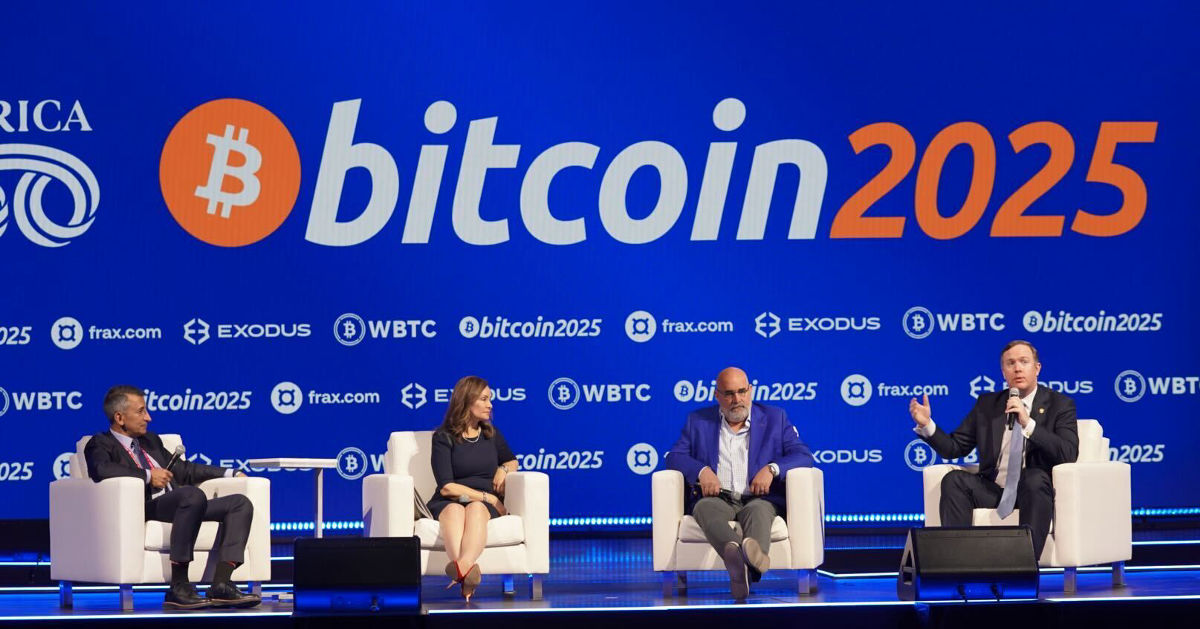
Bitcoin Is Here To Stay, Says Former US Treasurer Rosie RiosAt the 2025 Bitcoin Conference in Las Vegas, the Co-Manager of President Trump’s 2024 Campaign Chris LaCivita, Congressman Brian T. Jack, the Chief Policy Officer of Coinbase Faryar Shirzad and Former US Treasurer Rosie Rios at the Nakamoto stage discussed the 250th birthday of the United States, Bitcoin, freedom, and crypto.
Rosie Rios emphasized that consumer behavior is very hard to change unless there is a shock to the system. She said she is amazed by the momentum of the level of change that has happened during these four months in terms of giving that green light to innovation to actually happen.
“You are gonna hear me say a lot, the train has left the station. Bitcoin is here to stay. Blockchain is here to stay,” said Rios.
JUST IN:
 Former Treasurer of the United States Rosie Rios says, “#Bitcoin is here to stay.”
Former Treasurer of the United States Rosie Rios says, “#Bitcoin is here to stay.” “The train has left the station.”
 pic.twitter.com/M4noy7DPha
pic.twitter.com/M4noy7DPha— Bitcoin Magazine (@BitcoinMagazine) May 27, 2025
“It’s about freedom and what crypto represents on a national scale,” said Chris LaCivita. “This country was founded on the entrepreneurial spirit of Americans and we are on the forefront of establishing and formulating the future of currency.”

Jack mentioned that earlier this year, they started to use a congressional tool called the Congressional Review Act that will enable them to repeal any regulation Joe Biden’s administration put on any sector during his last months in office.
“One of the first laws that Donald Trump signed into law was the repeal of a very niche but interesting issue for some folks in the room,” stated Jack. “It was a policy that the CFPB thrust upon the industry in December that really helped them regulate, if you will, or over regulate payment processors. So a lot of the payment processors that process bitcoin, process crypto, they were going to be under these incredible burdens by CFPB.”
“The eyes of the world are watching,” commented Rosie. “We are setting the tone for what happens not just in our history but for the future and for all of us this is the American dream. This is about the values of which our country was founded.”
“For Bitcoin and Blockchain in general whoever creates that dominant digital infrastructure will set the tone for the whole global financial system and it starts here literally at this conference with this leadership with this President moving forward,” stated Rosie Rios closing the panel.
This post Bitcoin Is Here To Stay, Says Former US Treasurer Rosie Rios first appeared on Bitcoin Magazine and is written by Oscar Zarraga Perez.
-
 @ 8d34bd24:414be32b
2025-05-28 13:53:46
@ 8d34bd24:414be32b
2025-05-28 13:53:46These days it can feel like the whole world is out of control. Government officials lie and break the law. People are selfish, act emotionally rather than logically, and push ideologies that are illogical and contrary to reality. Society is divided into groups and people are judged, not for their own character, but based on which group they are placed into. There are wars and rumors of wars. There are worries of pandemics and economic disasters. Depression, psychosis, and despair is rampant even among the youngest among us.
Hope For Believers
As much as things seem to be out of control, they are not out of God’s control. This is what the Bible predicted. No matter how bad things get in the world, those who have put their faith in Jesus, do not need to feel despair.
Why are you in despair, O my soul?\ And why have you become disturbed within me?\ Hope in God, for I shall again praise Him\ For the help of His presence.\ O my God, my soul is in despair within me;\ Therefore I remember You from the land of the Jordan\ And the peaks of Hermon, from Mount Mizar. (Psalm 42:5-6)
When we start to feel despair overcoming us, we need to remember what God has done and what He has promised. We need to praise God for what He has done, what He has promised, and what He will bring to completion. Things may be hard now, but God is still in control, and we know how the story will end. God triumphs. Good is rewarded. Evil is destroyed. We can stand on the foundation of hope because we know the ending. Even though things may be out of our personal control, they are always under God’s control.
The more fiercely the storm rages, the more we need to rest in Jesus and the more we need to put our hope in Him.
O love the Lord, all you His godly ones!\ The Lord preserves the faithful\ And fully recompenses the proud doer.\ **Be strong and let your heart take courage,\ All you who hope in the Lord. (Psalm 31:23-24) {emphasis mine}
We can take courage because God always acts for our long term good. Every hardship we experience here on earth will be recognized as a blessing that grew our faith and prepared us for heaven and God’s presence in eternity.
For I know the plans that I have for you,’ declares the Lord, ‘plans for welfare and not for calamity to give you a future and a hope. (Jeremiah 29:11)
Even the worst things that happen to us, due to the sins of others, have a good purpose in our lives. God is working good through us. Our hope isn’t an empty hope. It isn’t a “I really hope this happens.” It is a “I can hope in the guaranteed promises of God.”
For we do not want you to be unaware, brethren, of our affliction which came to us in Asia, that we were burdened excessively, beyond our strength, so that we despaired even of life; indeed, we had the sentence of death within ourselves so that we would not trust in ourselves, but in God who raises the dead; who delivered us from so great a peril of death, and will deliver us, He on whom we have set our hope. And He will yet deliver us, (2 Corinthians 1:8-10) {emphasis mine}
We may experience situations so bad that they seem hopeless, but with God, nothing is hopeless. The God who raises the dead can raise us out of any situation. The God who spoke the universe into existence can deliver us by a word.
The God of the Bible knows all and loves us completely. He looks at our situation through the lens of eternity. What seems best in the moment is not necessarily what is best for our eternity. Many times He delivers us through hardship rather than out of it. We just need to trust Him and put our hope in Him because He is good.
In the same way God, desiring even more to show to the heirs of the promise the unchangeableness of His purpose, interposed with an oath, so that by two unchangeable things in which it is impossible for God to lie, we who have taken refuge would have strong encouragement to take hold of the hope set before us. This hope we have as an anchor of the soul, a hope both sure and steadfast and one which enters within the veil, where Jesus has entered as a forerunner for us, having become a high priest forever according to the order of Melchizedek. (Hebrews 6:17-20) {emphasis mine}
Read that statement again. “This hope we have as an anchor of the soul, a hope both sure and steadfast.” Are you trusting Jesus as the “anchor of your soul?” Is your hope just a wish or is it a “sure and steadfast” hope based on the promises of God that you know will 100% come true?
And not only this, but we also exult in our tribulations, knowing that tribulation brings about perseverance; and perseverance, proven character; and proven character, hope; and hope does not disappoint, because the love of God has been poured out within our hearts through the Holy Spirit who was given to us. (Romans 5:3-5)
Isn’t it ironic that we need hope to persevere through tribulations, but that persevering through tribulation gives us character and hope? Our faith, trust, and hope grow through hardship. When things are easy, we almost always fall back on trusting in our own power rather than relying on God’s power. If we have put our faith in Jesus, there is no situation in which we should lose hope.
Now may the God of hope fill you with all joy and peace in believing, so that you will abound in hope by the power of the Holy Spirit. (Romans 15:13)
Is your joy and peace based on your circumstances or have you learned to have hope in God so you can experience joy and peace even in the trials?
Many people equate joy and happiness, but I think there is a key distinction. Happiness is a pleasant feeling that comes from pleasant circumstances. Joy is a similar feeling to happiness, but it comes from knowing God and His love. It is not tied to circumstances. When we have truly put our hope in God we can still have joy in and despite the most horrific circumstances.
Blessed be the God and Father of our Lord Jesus Christ, who according to His great mercy has caused us to be born again to a living hope through the resurrection of Jesus Christ from the dead, to obtain an inheritance which is imperishable and undefiled and will not fade away, reserved in heaven for you, (1 Peter 1:3-4) {emphasis mine}
Just as Jesus told the Samaritan woman at the well that He provides living water that wells up inside, so that she need never thirst, in the same way believers have a living hope that wells up in times of need. Our hope is in the Creator of the universe and Savior of the world. No problem is too big for Him. No situation is a surprise to Him. No enemy is too powerful for Him. All of our problems are already solved. We just haven’t necessarily seen the solution yet.
My soul, wait in silence for God only,\ For my hope is from Him.\ He only is my rock and my salvation,\ My stronghold; I shall not be shaken.\ On God my salvation and my glory rest;\ The rock of my strength, my refuge is in God. (Psalm 62:5-7)
Despair For Unbelievers
Although believers never have reason to despair, the same is not true for those who have rejected the Savior, Jesus Christ. In these perilous times, they have a real reason for dread and despair.
Moreover, the Lord will scatter you among all peoples, from one end of the earth to the other end of the earth; and there you shall serve other gods, wood and stone, which you or your fathers have not known. Among those nations you shall find no rest, and there will be no resting place for the sole of your foot; but there the Lord will give you a trembling heart, failing of eyes, and despair of soul. So your life shall hang in doubt before you; and you will be in dread night and day, and shall have no assurance of your life. (Deuteronomy 64-66)
Those who reject the atoning sacrifice of Jesus do not get His protection. They do not get His help. They cannot rest in hope in Him.
Of course, the good news is that they can chose to turn their hearts to Him, confess their sins, and trust in Him up until their moment of death. Sadly many will continue to put off faith until it is too late. Many will choose evil over good and license over submission until God gives them over to their lusts.
And just as they did not see fit to acknowledge God any longer, God gave them over to a depraved mind, to do those things which are not proper, being filled with all unrighteousness, wickedness, greed, evil; full of envy, murder, strife, deceit, malice; they are gossips, slanderers, haters of God, insolent, arrogant, boastful, inventors of evil, disobedient to parents, without understanding, untrustworthy, unloving, unmerciful; and although they know the ordinance of God, that those who practice such things are worthy of death, they not only do the same, but also give hearty approval to those who practice them. (Romans 1:28-32)
If any of you have not yet put your trust in Jesus as Savior and Lord, do not wait. Turn away from evil. Submit to the will of Jesus. Trust Him to take away your sins and cover you with His righteousness.
If any of you know people who are in despair, share the gospel with them. Tell them about the greatness of God. Show them the hope that is within you.
Can Believers Despair?
Are there believers who despair? Yes. Should believers ever despair? Definitely not!
But we have this treasure in earthen vessels, so that the surpassing greatness of the power will be of God and not from ourselves; we are afflicted in every way, but not crushed; perplexed, but not despairing; persecuted, but not forsaken; struck down, but not destroyed; always carrying about in the body the dying of Jesus, so that the life of Jesus also may be manifested in our body. (2 Corinthians 4:7-10)
Jesus is always with believers in all situations guiding and protecting us. Those difficult situations that happen are for our good, even when we can’t see how it could be for good.
Job had more reasons to despair than almost anyone, yet he trusted in God. He didn’t know why he was being put through such loss, but his loss increased his faith in God and was a great example to people throughout history. I also love this cry of his heart.
“Oh that my words were written!\ Oh that they were inscribed in a book!” (Job 19:23)
He may or may not have seen even the partial fulfillment of this cry, but His words are written in the book of Job, in the Holy Scriptures read by Jews and Christians throughout the world and throughout history. Job’s first response to loss was an example to us all. After losing all ten children and all of his wealth, this was his response.
Then Job arose and tore his robe and shaved his head, and he fell to the ground and worshiped. (Job 1:20)
Yes, it is true that he had moments of despair where he cursed his birth, but he then returned to God in faith and hope. After a brief rebuke from God, Job submitted to God’s will.
“Behold, I am insignificant; what can I reply to You?\ I lay my hand on my mouth.\ Once I have spoken, and I will not answer;\ Even twice, and I will add nothing more.” (Job 40:4-5)
After his second rebuke from God, he fully submitted.
Then Job answered the Lord and said,
“I know that You can do all things,\ And that no purpose of Yours can be thwarted.\ ‘Who is this that hides counsel without knowledge?’\ *Therefore I have declared that which I did not understand,\ Things too wonderful for me, which I did not know.\ ‘Hear, now, and I will speak;\ I will ask You, and You instruct me*.’\ I have heard of You by the hearing of the ear;\ But now my eye sees You;\ Therefore I retract,\ And I repent in dust and ashes**.” (Job 42:1-6) {emphasis mine}
Job admitted that he did not understand what God was doing, but that God was right; God was good; and God was Lord. Job was able to have hope knowing that God was in control and working for good.
In the case of Job, he was later blessed with more kids, more wealth, and more respect than he had in the beginning. We won’t all see our blessings here on earth, but all believers will receive blessings from their trials.
May our glorious Savior and God fill you with faith and hope in God, His goodness, His power, and His plan. May we all submit to His good will even when we do not understand and even when every part of our earthly body is crying, “stop!” May God fill you with knowledge of Him, faith in Him, and hope in Him.
Trust Jesus
-
 @ 266815e0:6cd408a5
2025-04-29 17:47:57
@ 266815e0:6cd408a5
2025-04-29 17:47:57I'm excited to announce the release of Applesauce v1.0.0! There are a few breaking changes and a lot of improvements and new features across all packages. Each package has been updated to 1.0.0, marking a stable API for developers to build upon.
Applesauce core changes
There was a change in the
applesauce-corepackage in theQueryStore.The
Queryinterface has been converted to a method instead of an object withkeyandrunfields.A bunch of new helper methods and queries were added, checkout the changelog for a full list.
Applesauce Relay
There is a new
applesauce-relaypackage that provides a simple RxJS based api for connecting to relays and publishing events.Documentation: applesauce-relay
Features:
- A simple API for subscribing or publishing to a single relay or a group of relays
- No
connectorclosemethods, connections are managed automatically by rxjs - NIP-11
auth_requiredsupport - Support for NIP-42 authentication
- Prebuilt or custom re-connection back-off
- Keep-alive timeout (default 30s)
- Client-side Negentropy sync support
Example Usage: Single relay
```typescript import { Relay } from "applesauce-relay";
// Connect to a relay const relay = new Relay("wss://relay.example.com");
// Create a REQ and subscribe to it relay .req({ kinds: [1], limit: 10, }) .subscribe((response) => { if (response === "EOSE") { console.log("End of stored events"); } else { console.log("Received event:", response); } }); ```
Example Usage: Relay pool
```typescript import { Relay, RelayPool } from "applesauce-relay";
// Create a pool with a custom relay const pool = new RelayPool();
// Create a REQ and subscribe to it pool .req(["wss://relay.damus.io", "wss://relay.snort.social"], { kinds: [1], limit: 10, }) .subscribe((response) => { if (response === "EOSE") { console.log("End of stored events on all relays"); } else { console.log("Received event:", response); } }); ```
Applesauce actions
Another new package is the
applesauce-actionspackage. This package provides a set of async operations for common Nostr actions.Actions are run against the events in the
EventStoreand use theEventFactoryto create new events to publish.Documentation: applesauce-actions
Example Usage:
```typescript import { ActionHub } from "applesauce-actions";
// An EventStore and EventFactory are required to use the ActionHub import { eventStore } from "./stores.ts"; import { eventFactory } from "./factories.ts";
// Custom publish logic const publish = async (event: NostrEvent) => { console.log("Publishing", event); await app.relayPool.publish(event, app.defaultRelays); };
// The
publishmethod is optional for the asyncrunmethod to work const hub = new ActionHub(eventStore, eventFactory, publish); ```Once an
ActionsHubis created, you can use therunorexecmethods to execute actions:```typescript import { FollowUser, MuteUser } from "applesauce-actions/actions";
// Follow fiatjaf await hub.run( FollowUser, "3bf0c63fcb93463407af97a5e5ee64fa883d107ef9e558472c4eb9aaaefa459d", );
// Or use the
execmethod with a custom publish method await hub .exec( MuteUser, "3bf0c63fcb93463407af97a5e5ee64fa883d107ef9e558472c4eb9aaaefa459d", ) .forEach((event) => { // NOTE: Don't publish this event because we never want to mute fiatjaf // pool.publish(['wss://pyramid.fiatjaf.com/'], event) }); ```There are a log more actions including some for working with NIP-51 lists (private and public), you can find them in the reference
Applesauce loaders
The
applesauce-loaderspackage has been updated to support any relay connection libraries and not justrx-nostr.Before:
```typescript import { ReplaceableLoader } from "applesauce-loaders"; import { createRxNostr } from "rx-nostr";
// Create a new rx-nostr instance const rxNostr = createRxNostr();
// Create a new replaceable loader const replaceableLoader = new ReplaceableLoader(rxNostr); ```
After:
```typescript
import { Observable } from "rxjs"; import { ReplaceableLoader, NostrRequest } from "applesauce-loaders"; import { SimplePool } from "nostr-tools";
// Create a new nostr-tools pool const pool = new SimplePool();
// Create a method that subscribes using nostr-tools and returns an observable function nostrRequest: NostrRequest = (relays, filters, id) => { return new Observable((subscriber) => { const sub = pool.subscribe(relays, filters, { onevent: (event) => { subscriber.next(event); }, onclose: () => subscriber.complete(), oneose: () => subscriber.complete(), });
return () => sub.close();}); };
// Create a new replaceable loader const replaceableLoader = new ReplaceableLoader(nostrRequest); ```
Of course you can still use rx-nostr if you want:
```typescript import { createRxNostr } from "rx-nostr";
// Create a new rx-nostr instance const rxNostr = createRxNostr();
// Create a method that subscribes using rx-nostr and returns an observable function nostrRequest( relays: string[], filters: Filter[], id?: string, ): Observable
{ // Create a new oneshot request so it will complete when EOSE is received const req = createRxOneshotReq({ filters, rxReqId: id }); return rxNostr .use(req, { on: { relays } }) .pipe(map((packet) => packet.event)); } // Create a new replaceable loader const replaceableLoader = new ReplaceableLoader(nostrRequest); ```
There where a few more changes, check out the changelog
Applesauce wallet
Its far from complete, but there is a new
applesauce-walletpackage that provides a actions and queries for working with NIP-60 wallets.Documentation: applesauce-wallet
Example Usage:
```typescript import { CreateWallet, UnlockWallet } from "applesauce-wallet/actions";
// Create a new NIP-60 wallet await hub.run(CreateWallet, ["wss://mint.example.com"], privateKey);
// Unlock wallet and associated tokens/history await hub.run(UnlockWallet, { tokens: true, history: true }); ```
-
 @ 812cff5a:5c40aeeb
2025-05-28 12:56:32
@ 812cff5a:5c40aeeb
2025-05-28 12:56:32NIP-01 — الشكل الأساسي للأحداث في نُستر
رقم التعريف (NIP): 01
العنوان: الشكل الأساسي للأحداث
الحالة: نهائي
المؤلف: fiatjaf
التاريخ: 2020-12-10
الملخص
هذا المستند يعرّف الشكل القياسي لأي "حدث" يتم تداوله ضمن شبكة نُستر (Nostr).
الهدف من هذا التنسيق هو ضمان إمكانية معالجة وتفسير الأحداث من قبل جميع العملاء والخوادم بطريقة موحّدة.
هيكل الحدث
كل حدث عبارة عن كائن يحتوي على الحقول التالية:
{ "id": <معرّف فريد>, "pubkey": <مفتاح عام للمرسل>, "created_at": <تاريخ الإنشاء كرقم UNIX timestamp>, "kind": <نوع الحدث>, "tags": [<قائمة من الوسوم>], "content": <المحتوى>, "sig": <التوقيع الرقمي> }
شرح الحقول
- id: سلسلة نصية تمثل SHA-256 لمحتوى الحدث.
- pubkey: المفتاح العام للمستخدم (عادةً 32 بايت بصيغة hex).
- created_at: الطابع الزمني للإنشاء (Unix timestamp).
- kind: رقم يحدد نوع الحدث (مثلاً: منشور، متابعة، إعادة نشر).
- tags: قائمة من الوسوم المرتبطة بالحدث (مثلاً: إشارة إلى مستخدم أو حدث).
- content: المحتوى الأساسي للحدث (نص أو بيانات).
- sig: التوقيع الرقمي الذي يثبت أن المرسل هو صاحب المحتوى.
كيفية توليد معرف الحدث
idيتم توليد المعرّف عبر أخذ تمثيل JSON للحدث (بدون الحقول
idوsig) ثم حساب التجزئة باستخدام SHA-256.
توقيع الحدث
يُوقّع المستخدم الحدث باستخدام مفتاحه الخاص.
هذا التوقيع الرقمي يسمح لأي شخص بالتحقق من صحة الحدث باستخدام المفتاح العام.
أنواع الأحداث (kind)
0: ملف التعريف (الاسم، الصورة، النبذة).1: منشور عام نصي.2: إعادة نشر.3: قائمة المتابَعين.4: رسالة مشفّرة خاصة.- أنواع أخرى يمكن إضافتها لاحقًا.
الوسوم (Tags)
الوسوم عبارة عن قوائم (arrays) داخل الحدث لتوفير معلومات إضافية.
مثال:["e", "<معرّف الحدث>"] ["p", "<مفتاح عام لمستخدم>"]"e"تشير إلى حدث."p"تشير إلى مستخدم.
الخلاصة
NIP-01 هو الأساس الهيكلي لتبادل الأحداث عبر نُستر.
من خلال اتباع هذا الشكل، يمكن لجميع التطبيقات والخوادم العمل معاً بسلاسة، وضمان أمن وموثوقية كل حدث. -
 @ b7274d28:c99628cb
2025-05-28 00:59:49
@ b7274d28:c99628cb
2025-05-28 00:59:49Your identity is important to you, right? While impersonation can be seen in some senses as a form of flattery, we all would prefer to be the only person capable of representing ourselves online, unless we intentionally delegate that privilege to someone else and maintain the ability to revoke it.
Amber does all of that for you in the context of #Nostr. It minimizes the possibility of your private key being compromized by acting as the only app with access to it, while all other Nostr apps send requests to Amber when they need something signed. This even allows you to give someone temporary authority to post as you without giving them your private key, and you retain the authority to revoke their permissions at any time.
nostr:npub1w4uswmv6lu9yel005l3qgheysmr7tk9uvwluddznju3nuxalevvs2d0jr5 has provided Android users with an incredibly powerful tool in Amber, and he continues to improve its functionality and ease of use. Indeed, there is not currently a comparative app available for iOS users. For the time being, this superpower is exclusive to Android.
Installation
Open up the Zapstore app that you installed in the previous stage of this tutorial series.
Very likely, Amber will be listed in the app collection section of the home page. If it is not, just search for "Amber" in the search bar.

Opening the app's page in the Zapstore shows that the release is signed by the developer. You can also see who has added this app to one of their collections and who has supported this app with sats by zapping the release.

Tap "Install" and you will be prompted to confirm you are sure you want to install Amber.

Helpfully, you are informed that several other users follow this developer on Nostr. If you have been on Nostr a while, you will likely recognize these gentlemen as other Nostr developers, one of them being the original creator of the protocol.
You can choose to never have Zapstore ask for confirmation again with apps developed by nostr:npub1w4uswmv6lu9yel005l3qgheysmr7tk9uvwluddznju3nuxalevvs2d0jr5, and since we have another of his apps to install later in this tutorial series, I recommend you toggle this on. Then tap on "Trust greenart7c3 and install app."
Just like when you installed the Zapstore from their GitHub, you will be prompted to allow the Zapstore to install apps, since Android considers it an "unknown source."

Once you toggle this on and use the back button to get back to the Zapstore, Amber will begin downloading and then present a prompt to install the app. Once installed, you will see a prompt that installation was a success and you can now open the app.

From here, how you proceed will depend on whether you need to set up a new Nostr identity or use Amber with an existing private key you already have set up. The next section will cover setting up a new Nostr identity with Amber. Skip to the section titled "Existing Nostrich" if you already have an nsec that you would like to use with Amber.
New Nostrich
Upon opening the application, you will be presented with the option to use an existing private key or create a new Nostr account. Nostr doesn't really have "accounts" in the traditional sense of the term. Accounts are a relic of permissioned systems. What you have on Nostr are keys, but Amber uses the "account" term because it is a more familiar concept, though it is technically inaccurate.

Choose "Create a new Nostr account" and you will be presented with a screen telling you that your Nostr account is ready. Yes, it was really that easy. No email, no real name, no date of birth, and no annoying capcha. Just "Create a new account" and you're done.

The app presents you with your public key. This is like an address that can be used to find your posts on Nostr. It is 100% unique to you, and no one else can post a note that lists this npub as the author, because they won't have the corresponding private key. You don't need to remember your npub, though. You'll be able to readily copy it from any Nostr app you use whenever you need it.
You will also be prompted to add a nickname. This is just for use within Amber, since you can set up multiple profiles within the app. You can use anything you want here, as it is just so you can tell which profile is which when switching between them in Amber.
Once you've set your nickname, tap on "Continue."
The next screen will ask you what Amber's default signing policy should be.

The default is to approve basic actions, referring to things that are common for Nostr clients to request a signature for, like following another user, liking a post, making a new post, or replying. If you are more concerned about what Amber might be signing for on your behalf, you can tell it to require manual approval for each app.
Once you've made your decision, tap "Finish." You will also be able to change this selection in the app settings at any time.
With this setup out of the way, you are now presented with the main "Applications" page of the app.

At the top, you have a notification encouraging you to create a backup. Let's get that taken care of now by tapping on the notification and skipping down to the heading titled "Backing Up Your Identity" in this tutorial.
Existing Nostrich
Upon opening the application, you will be presented with the option to use your private key or create a new Nostr account. Choose the former.

The next screen will require you to paste your private key.

You will need to obtain this from whatever Nostr app you used to create your profile, or any other Nostr app that you pasted your nsec into in the past. Typically you can find it in the app settings and there will be a section mentioning your keys where you can copy your nsec. For instance, in Primal go to Settings > Keys > Copy private key, and on Amethyst open the side panel by tapping on your profile picture in the top-left, then Backup Keys > Copy my secret key.
After pasting your nsec into Amber, tap "Next."

Amber will give you a couple options for a default signing policy. The default is to approve basic actions, referring to things that are common for Nostr clients to request a signature for, like following another user, liking a post, making a new post, or replying. If you are more concerned about what Amber might be signing for on your behalf, you can tell it to require manual approval for each app.
Once you've made your decision, tap "Finish." You will also be able to change this selection in the app settings at any time.

With this setup out of the way, you are now presented with the main "Applications" page of the app. You have nothing here yet, since you haven't used Amber to log into any Nostr apps, but this will be where all of the apps you have connected with Amber will be listed, in the order of the most recently used at the top.
Before we go and use Amber to log into an app, though, let's make sure we've created a backup of our private key. You pasted your nsec into Amber, so you could just save that somewhere safe, but Amber gives you a few other options as well. To find them, you'll need to tap the cog icon at the bottom of the screen to access the settings, then select "Backup Keys."


Backing Up Your Identity

You'll notice that Amber has a few different options for backing up your private key that it can generate.
First, it can give you seed words, just like a Bitcoin seed. If you choose that option, you'll be presented with 12 words you can record somewhere safe. To recover your Nostr private key, you just have to type those words into a compatible application, such as Amber.
The next option is to just copy the secret/private key in its standard form as an "nsec." This is the least secure way to store it, but is also the most convenient, since it is simple to paste into another signer application. If you want to be able to log in on a desktop web app, the browser extension Nostr signers won't necessarily support entering your 12 word seed phrase, but they absolutely will support pasting in your nsec.
You can also display a QR code of your private key. This can be scanned by Amber signer on another device for easily transferring your private key to other devices you want to use it on. Say you have an Android tablet in addition to your phone, for instance. Just make sure you only use this function where you can be certain that no one will be able to get a photograph of that QR code. Once someone else has your nsec, there is no way to recover it. You have to start all over on Nostr. Not a big deal at this point in your journey if you just created a Nostr account, but if you have been using Nostr for a while and have built up a decent amount of reputation, it could be much more costly to start over again.
The next options are a bit more secure, because they require a password that will be used to encrypt your private key. This has some distinct advantages, and a couple disadvantages to be aware of. Using a password to encrypt your private key will give you what is called an ncryptsec, and if this is leaked somehow, whoever has it will not necessarily have access to post as you on Nostr, the way they would if your nsec had been leaked. At least, not so long as they don't also have your password. This means you can store your ncryptsec in multiple locations without much fear that it will be compromised, so long as the password you used to encrypt it was a strong and unique one, and it isn't stored in the same location. Some Nostr apps support an ncryptsec for login directly, meaning that you have the option to paste in your ncryptsec and then just log in with the password you used to encrypt it from there on out. However, now you will need to keep track of both your ncryptsec and your password, storing both of them safely and separately. Additionally, most Nostr clients and signer applications do not support using an ncryptsec, so you will need to convert it back to a standard nsec (or copy the nsec from Amber) to use those apps.
The QR option using an ncryptsec is actually quite useful, though, and I would go this route when trying to set up Amber on additional devices, since anyone possibly getting a picture of the QR code is still not going to be able to do anything with it, unless they also get the password you used to encrypt it.
All of the above options will require you to enter the PIN you set up for your device, or biometric authentication, just as an additional precaution before displaying your private key to you.
As for what "store it in a safe place" looks like, I highly recommend a self-hosted password manager, such as Vaultwarden+Bitwarden or KeePass. If you really want to get wild, you can store it on a hardware signing device, or on a steel seed plate.
Additional Settings

Amber has some additional settings you may want to take advantage of. First off, if you don't want just anyone who has access to your phone to be able to approve signing requests, you can go into the Security settings add a PIN or enable biometrics for signing requests. If you enable the PIN, it will be separate from the PIN you use to access your phone, so you can let someone else use your phone, like your child who is always begging to play a mobile game you have installed, without worrying that they might have access to your Nostr key to post on Amethyst.
Amber also has some relay settings. First are the "Active relays" which are used for signing requests sent to Amber remotely from Nostr web apps. This is what enables you to use Amber on your phone to log into Nostr applications on your desktop web browser, such as Jumble.social, Coracle.social, or Nostrudel.ninja, eliminating your need to use any other application to store your nsec whatsoever. You can leave this relay as the default, or you can add other relays you want to use for signing requests. Just be aware, not all relays will accept the notes that are used for Nostr signing requests, so make sure that the relay you want to use does so. In fact, Amber will make sure of this for you when you type in the relay address.
The next type of relays that you can configure in Amber are the "Default profile relays." These are used for reading your profile information. If you already had a Nostr identity that you imported to Amber, you probably noticed it loaded your profile picture and display name, setting the latter as your nickname in Amber. These relays are where Amber got that information from. The defaults are relay.nostr.band and purplepag.es. The reason for this is because they are aggregators that look for Nostr profiles that have been saved to other relays on the network and pull them in. Therefore, no matter what other relay you may save your profile to, Amber will likely be able to find it on one of those two relays as well. If you have a relay you know you will be saving your Nostr profiles to, you may want to add it to this list.
You can also set up Amber to be paired with Orbot for signing over Tor using relays that are only accessible via the Tor network. That is an advanced feature, though, and well beyond the scope of this tutorial.
Finally, you can update the default signing policy. Maybe after using Amber for a while, you've decided that the choice you made before was too strict or too lenient. You can change it to suit your needs.
Zapstore Login
Now that you are all set up with Amber, let's get you signed into your first Nostr app by going back to the Zapstore.

From the app's home screen, tap on the user icon in the upper left of the screen. This will open a side panel with not much on it except the option to "sign in." Go ahead and tap on it.
You will be presented with the option to either sign in with Amber, or to paste your npub. However, if you do the latter, you will only have read access, meaning you cannot zap any of the app releases. There are other features planned for the Zapstore that may also require you to be signed in with write access, so go ahead and choose to log in with Amber.

Your phone should automatically switch to Amber to approve the sign-in request.

You can choose to only approve basic actions for Zapstore, require it to manually approve every time, or you can tell it that you "fully trust this application." Only choose the latter option with apps you have used for a while and they have never asked you to sign for anything suspicious. For the time being, I suggest you use the "Approve basic actions" option and tap "Grant Permissions."
Your phone will switch back to the Zapstore and will show that you are now signed in. Congratulations! From here on out, logging into most Nostr applications will be as easy as tapping on "Log in with Amber" and approving the request.

If you set up a new profile, it will just show a truncated version of your npub rather than the nickname you set up earlier. That's fine. You'll have an opportunity to update your Nostr profile in the next tutorial in this series and ensure that it is spread far and wide in the network, so the Zapstore will easily find it.
That concludes the tutorial for Amber. While we have not covered using Amber to log into Nostr web apps, that is outside the scope of this series, and I will cover it in an upcoming tutorial regarding using Amber's remote signer options in detail.
Since you're already hanging out in the Zapstore, you may as well stick around, because we will be using it right out the gate in the next part of this series: Amethyst Installation and Setup. (Coming Soon)
-
 @ f683e870:557f5ef2
2025-04-28 10:10:55
@ f683e870:557f5ef2
2025-04-28 10:10:55Spam is the single biggest problem in decentralized networks. Jameson Lopp, co-founder of Casa and OG bitcoiner, has written a brilliant article on the death of decentralized email that paints a vivid picture of what went wrong—and how an originally decentralized protocol was completely captured. The cause? Spam.
The same fate may happen to Nostr, because posting a note is fundamentally cheap. Payments, and to some extent Proof of Work, certainly have their role in fighting spam, but they introduce friction, which doesn’t work everywhere. In particular, they can’t solve every economic problem.\ Take free trials, for example. There is a reason why 99% of companies offer them. Sure, you waste resources on users who don’t convert, but it’s a calculated cost, a marketing expense. Also, some services can’t or don’t want to monetize directly. They offer something for free and monetize elsewhere.
So how do you offer a free trial or giveaway in a hostile decentralized network? Or even, how do you decide which notes to accept on your relay?
At first glance, these may seem like unrelated questions—but they’re not. Generally speaking, these are situations where you have a finite budget, and you want to use it well. You want more of what you value — and less of what you don’t (spam).
Reputation is a powerful shortcut when direct evaluation isn’t practical. It’s hard to earn, easy to lose — and that’s exactly what makes it valuable.\ Can a reputable user do bad things? Absolutely. But it’s much less likely, and that’s the point. Heuristics are always imperfect, just like the world we live in.
The legacy Web relies heavily on email-based reputation. If you’ve ever tried to log in with a temporary email, you know what I’m talking about. It just doesn’t work anymore. The problem, as Lopp explains, is that these systems are highly centralized, opaque, and require constant manual intervention.\ They also suck. They put annoying roadblocks between the world and your product, often frustrating the very users you’re trying to convert.
At Vertex, we take a different approach.\ We transparently analyze Nostr’s open social graph to help companies fight spam while improving the UX for their users. But we don’t take away your agency—we just do the math. You take the decision of what algorithm and criteria to use.
Think of us as a signal provider, not an authority.\ You define what reputation means for your use case. Want to rank by global influence? Local or personalized? You’re in control. We give you actionable and transparent analytics so you can build sharper filters, better user experiences, and more resilient systems. That’s how we fight spam, without sacrificing decentralization.
Are you looking to add Web of Trust capabilities to your app or project?\ Take a look at our website or send a DM to Pip.
-
 @ 0c65eba8:4a08ef9a
2025-05-28 15:28:47
@ 0c65eba8:4a08ef9a
2025-05-28 15:28:47You’ve heard the word.
You’ve probably used it. Maybe even hurled it at someone in a moment of pain. "Narcissist."
It lands like a curse.
And in today’s culture, it is one.
Not because it’s accurate.
But because it’s easy and packs a gut punch.
We blame narcissism for everything now. Every breakup. Every betrayal. Every moment someone’s ego gets in the way of our feelings.
Girls love to call their boyfriends narcissists when they feel neglected or controlled. Men love to call shallow women narcissists when they note the slightest vanity.
Friends turn on each other. Parents diagnose their children. Exes declare psychological war.
It’s become the pop-psych version of original sin.
But here’s the problem: the way we use this word is no longer grounded in clarity, science, or truth. It’s grounded in resentment.
And resentment is not a tool for diagnosis. It’s a weapon.
The Real Problem: Personality Dysfunction Is Rising
We are living in an era of personality dysfunction.
People hurt each other. They sabotage relationships, abandon their children, manipulate their spouses, destroy trust, and call it “self-care.”
Something is wrong. Deeply wrong.
We’ve studied it. Therapists, researchers, and social commentators have all tried to map it out.
And to be fair, some of those efforts have succeeded.
Certain patterns of personality dysfunction can be measured, tracked, and treated. When a trait can be operationalized, when we can define it clearly, measure it consistently, and test interventions reliably, it becomes useful. It becomes a tool for healing, not a weapon of blame.
For a psychological label to be scientifically sound, it must meet these criteria:
Antisocial Personality Disorder, for example, has clear markers: chronic dishonesty, demonstrated disregard for others, lack of remorse, impulsive behavior. It can be identified across time and context, and most importantly, it responds to specific interventions.
But narcissism?
The term doesn’t hold up.
It fails the tests of clarity, reliability, and usefulness. One therapist might see narcissism in a man who talks proudly about his accomplishments; another sees the same behavior as sharing leadership wisdom. One woman calls her ex a narcissist because he set boundaries; another praises those same traits in her new husband. A father who struggles to express affection gets pathologized as narcissistic by one adult child, and quietly respected for his restraint by another.
The label lacks tether. It’s not anchored to cause, behavior, or result.
It floats. It morphs. It reflects less about the person being described, and more about the insecurity or pain of the one using it.
And in trying to describe everything, it ends up describing nothing.
That’s not psychology. It’s projection.
We turned “narcissist” into a slur, a cudgel we swing at anyone who disagrees with us, makes us uncomfortable, or dares to outshine us. It’s no longer more useful than simply saying "man bad."
What Does "Narcissist" Even Mean?
So what does “narcissist” mean today?
Whatever the accuser wants it to mean.
Sometimes it means someone is confident. Other times, ambitious. Or assertive. Or charismatic. Or proud. Or selfish. Or charming. Or controlling. Or emotionally abusive. And sometimes, it simply means the other person didn’t agree with the accuser.
The list doesn’t end, because there is no clear definition.
When you call someone a narcissist, are you naming a trait? Or expressing your own pain? Or just reacting to how their ego made you feel?
Are you labeling a pattern of manipulation? Or just someone who knows they’re good at what they do? Or someone who’s willing to set a boundary that you don’t like?
We don’t know. And that’s the problem.
Side note: in my experience, true manipulators are the first to accuse others of manipulation. It’s a preemptive strike, a decoy. They believe if they say it first, it shields them from being exposed.
The same thing happens with the word narcissist.
Narcissism Doesn’t Survive Scientific Scrutiny
Before we go further, let’s look at what the DSM-5 actually says about Narcissistic Personality Disorder. These are the official diagnostic traits, and how each one collapses under scrutiny when we try to apply it with clarity, truth, and reciprocity.
What we find is simple: for every trait listed, we already have a better, more operational term. One that doesn’t blur the line between pathology and personality. One that can be observed, measured, and acted on.
But don’t just take my word for it, let’s examine the clinical roots and see how shallow they really are.
Here’s what that disambiguation looks like:
Every trait here has a clearer name or description. Every clearer name leads to a clearer solution. Calling it narcissism blurs the edges. Disambiguation sharpens them.
And one special note about empathy, since this trait is one of the most weaponized, it deserves a direct clarification. Most people don’t understand what empathy really is, let alone how it works in the real world:
When most people say "you lack empathy," what they really mean is "you didn’t agree with me or do what I wanted." But empathy is not blind compliance. It’s a limited, precious resource. It takes energy. It takes time. And it must be rationed.
We cannot, and should not, extend unlimited empathy to those outside our Circle of Care. Empathy isn’t just a warm feeling. It’s a costly act. It asks you to notice someone else’s pain, feel it, and then respond, often at the expense of your own time, energy, or resources.
So we ration it. We prioritize it. We give it to those we are responsible for, to those we love, to those who have earned our care. That’s not cruelty. That’s stewardship.
The real danger is when manipulators demand empathy as proof of virtue. “If you cared, you’d give me what I want.” But empathy is not submission. It is not forced agreement. It is not the abandonment of your own boundaries. Saying no with a clear heart is not a failure of empathy, it’s the mark of someone who knows where their responsibility ends, and where someone else’s manipulation begins. That’s wisdom. Because your emotional bandwidth, like every other resource, must be spent where it creates the most good.
Because of its vague boundaries, once someone learns the word “narcissist,” they start seeing it everywhere.
Every ex becomes one. Every bad boss. Every failed friendship. Every powerful man or beautiful woman who made them feel small. And soon, it doesn’t stop at relationships. It creeps into how they explain everything, from the decline of civilization to the state of politics and culture. Narcissism becomes the catch-all villain behind every social ill. Because the word is so vague, it always fits. But at that scale, the diagnosis becomes dangerous. It blocks our ability to understand people’s real motivations, incentives, fears, and goals. It replaces thought with accusation, and understanding with outrage.
They see narcissists everywhere, but they don’t ask if they’re the ones attracting toxic people, or if they’ve simply trained their lens to label every disappointment as abuse and every disagreement as pathology.
It’s projection disguised as insight.
And when you weaponize a label like that, you’re not analyzing behavior. You’re avoiding self-examination.
Three Core Arguments That Undermine the Narcissism Narrative
Now that we’ve seen how narcissism fails the scientific and diagnostic test, let’s break down the broader cultural problem. These are the three key reasons the term “narcissist” no longer serves us, and often does more harm than good.
1. "Narcissist" Doesn’t Mean Anything Specific, It Just Means You Don’t Like Them
The term is used as a junk drawer for traits people don’t want to deal with:
-
Confidence
-
Pride
-
Assertiveness
-
Visibility
But these traits, when tempered by maturity and ethics, are not only acceptable, they’re necessary.
-
Confidence inspires.
-
Pride in your work drives excellence.
-
Assertiveness enables leadership.
-
Visibility allows others to follow.
So when do these traits become toxic?
They don’t.
Not by themselves.
They only become dangerous when fused with things like entitlement, cruelty, dishonesty, or impulsiveness. And if those are the real problems, we should name them precisely.
Anything else is diagnostic laziness.
2. It’s Become a Weapon, Not a Diagnosis
Once upon a time, “narcissist” was treated as if it referred to a diagnosable condition. There was at least an attempt to define it scientifically and limit its use. But today, it's no longer grounded in discipline or diagnosis. It’s a social cudgel, vague, emotional, and endlessly adaptable to whatever someone wants to condemn.
People use it to:
-
Discredit others
-
Silence dissent
-
Justify moral superiority
And worst of all: you can’t defend yourself against it. The accusation is the evidence.
Try denying it. Say, "No, I don’t think highly of myself," and you disqualify yourself from being taken seriously. You’re signaling weakness, not humility. Especially for men, especially for leaders, denying your own value is social suicide.
Try asserting the truth instead. Say, "I’m not a narcissist, I’m just good at what I do." And that will be taken as proof of the accusation.
This trap doesn’t correct behavior. It crushes identity. It teaches the confident to shrink, the capable to self-doubt, and the virtuous to pretend they’re ordinary. Over time, especially in young men, this leads to collapse, of initiative, of drive, of self-respect.
We shouldn’t be pathologizing strong egos. We should be cultivating them, anchored in virtue, tethered to reality, and grounded in service. Confidence that comes from earned excellence isn’t narcissism. It’s maturity.
It’s time to stop punishing people for knowing who they are.
This isn’t psychology. It’s witch-burning.
3. We Already Have Better Words
If someone is manipulative, call them that. If someone lacks empathy, say so. If they’re arrogant, dishonest, or abusive, we already have words for those things.
Using “narcissist” to describe all of them at once is like checking your heart rate to diagnose a broken leg.
Vague terms destroy discernment.
Precise terms help us solve problems.
What About the People We’re Tearing Down?
Now here’s the part they don’t tell you:
Some of the people who get labeled “narcissist” aren’t dysfunctional at all.
They’re just better.
Better than average. Smarter. Stronger. More creative. More aware of their power. And because of that, they’re seen as dangerous.
So we drag them back down.
Like crabs in a bucket.
We’d rather insult than ascend.
We’d rather pathologize excellence than rise to meet it.
This is cultural suicide.
A Better Way to Protect Yourself
Here’s the better path forward:
-
Stop using “narcissist” as a placeholder for pain, disagreement, or vague discomfort.
-
Name the real traits, good or bad.
-
Learn how manipulation works and how to defend against it.
If you’ve ever been manipulated, gaslit, or emotionally preyed on, there’s a better way to understand it than these pop-psych terms.
That’s why I wrote this:
Become Immune to Manipulation: They Are Manipulating You and How to Resist It
It’s a guide to help you:
-
Detect manipulation in real time
-
Understand the tools manipulators use
-
Build defenses rooted in clarity, strength, and Natural Law
It’s short. It’s blunt. And it will change how you see people.
Read it. Share it. Live by it.
Because if you want to protect yourself from emotional predators, you don’t need therapy-speak.
You need a sword.
Retire the Label. Restore the Truth.
The truth is simple:
We don’t fix culture by inventing new labels. We fix it by restoring clarity, praising the good, correcting the harmful, and refusing to weaponize our language against truth.
So let’s stop using the narcissist slur.
And start seeing people for who they really are.
-
-
 @ c1e9ab3a:9cb56b43
2025-05-27 16:19:06
@ c1e9ab3a:9cb56b43
2025-05-27 16:19:06Star Wars is often viewed as a myth of rebellion, freedom, and resistance to tyranny. The iconography—scrappy rebels, totalitarian stormtroopers, lone smugglers—suggests a deep anti-authoritarian ethos. Yet, beneath the surface, the narrative arc of Star Wars consistently affirms the necessity, even sanctity, of central authority. This blog entry introduces the question: Is Star Wars fundamentally a celebration of statism?
Rebellion as Restoration, Not Revolution
The Rebel Alliance’s mission is not to dismantle centralized power, but to restore the Galactic Republic—a bureaucratic, centrally governed institution. Characters like Mon Mothma and Bail Organa are high-ranking senators, not populist revolutionaries. The goal is to remove the corrupt Empire and reinstall a previous central authority, presumed to be just.
- Rebels are loyalists to a prior state structure.
- Power is not questioned, only who wields it.
Jedi as Centralized Moral Elites
The Jedi, often idealized as protectors of peace, are unelected, extra-legal enforcers of moral and military order. Their authority stems from esoteric metaphysical abilities rather than democratic legitimacy.
- They answer only to their internal Council.
- They are deployed by the Senate, but act independently of civil law.
- Their collapse is depicted as tragic not because they were unaccountable, but because they were betrayed.
This positions them as a theocratic elite, not spiritual anarchists.
Chaos and the Frontier: The Case of the Cantina
The Mos Eisley cantina, often viewed as a symbol of frontier freedom, reveals something darker. It is: - Lawless - Violent - Culturally fragmented
Conflict resolution occurs through murder, not mediation. Obi-Wan slices off a limb; Han shoots first—both without legal consequence. There is no evidence of property rights, dispute resolution, or voluntary order.
This is not libertarian pluralism—it’s moral entropy. The message: without centralized governance, barbarism reigns.
The Mythic Arc: Restoration of the Just State
Every trilogy in the saga returns to a single theme: the fall and redemption of legitimate authority.
- Prequels: Republic collapses into tyranny.
- Originals: Rebels fight to restore legitimate order.
- Sequels: Weak governance leads to resurgence of authoritarianism; heroes must reestablish moral centralism.
The story is not anti-state—it’s anti-bad state. The solution is never decentralization; it’s the return of the right ruler or order.
Conclusion: The Hidden Statism of a Rebel Myth
Star Wars wears the costume of rebellion, but tells the story of centralized salvation. It: - Validates elite moral authority (Jedi) - Romanticizes restoration of fallen governments (Republic) - Portrays decentralized zones as corrupt and savage (outer rim worlds)
It is not an anarchist parable, nor a libertarian fable. It is a statist mythology, clothed in the spectacle of rebellion. Its core message is not that power should be abolished, but that power belongs to the virtuous few.
Question to Consider:
If the Star Wars universe consistently affirms the need for centralized moral and political authority, should we continue to see it as a myth of freedom? Or is it time to recognize it as a narrative of benevolent empire? -
 @ 5f078e90:b2bacaa3
2025-05-28 12:00:23
@ 5f078e90:b2bacaa3
2025-05-28 12:00:23Sylvi the seahorse

In the coral haven of Azure Bay, a seahorse named Sylvi danced with the tides. Her tail curled around a swaying frond as she watched fish dart by. One dawn, a lost pearl rolled into her nook. Sylvi, curious, nudged it along the reef, meeting crabs and eels who shared tales of the deep. By dusk, she found its oyster home. The pearl gleamed thanks, and Sylvi twirled home, her heart light as foam.
Ignore this test. This was in bold originally.
(380 chars, plain text after Markdown stripping, this was in italics originally)
Originally written on habla.news (on Nostr)
-
 @ 266815e0:6cd408a5
2025-04-26 13:10:09
@ 266815e0:6cd408a5
2025-04-26 13:10:09To all existing nostr developers and new nostr developers, stop using kind 1 events... just stop whatever your doing and switch the kind to
Math.round(Math.random() * 10000)trust me it will be betterWhat are kind 1 events
kind 1 events are defined in NIP-10 as "simple plaintext notes" or in other words social posts.
Don't trick your users
Most users are joining nostr for the social experience, and secondly to find all the cool "other stuff" apps They find friends, browse social posts, and reply to them. If a user signs into a new nostr client and it starts asking them to sign kind 1 events with blobs of JSON, they will sign it without thinking too much about it.
Then when they return to their comfy social apps they will see that they made 10+ posts with massive amounts of gibberish that they don't remember posting. then they probably will go looking for the delete button and realize there isn't one...
Even if those kind 1 posts don't contain JSON and have a nice fancy human readable syntax. they will still confuse users because they won't remember writing those social posts
What about "discoverability"
If your goal is to make your "other stuff" app visible to more users, then I would suggest using NIP-19 and NIP-89 The first allows users to embed any other event kind into social posts as
nostr:nevent1ornostr:naddr1links, and the second allows social clients to redirect users to an app that knows how to handle that specific kind of eventSo instead of saving your apps data into kind 1 events. you can pick any kind you want, then give users a "share on nostr" button that allows them to compose a social post (kind 1) with a
nostr:link to your special kind of event and by extension you appWhy its a trap
Once users start using your app it becomes a lot more difficult to migrate to a new event kind or data format. This sounds obvious, but If your app is built on kind 1 events that means you will be stuck with their limitations forever.
For example, here are some of the limitations of using kind 1 - Querying for your apps data becomes much more difficult. You have to filter through all of a users kind 1 events to find which ones are created by your app - Discovering your apps data is more difficult for the same reason, you have to sift through all the social posts just to find the ones with you special tag or that contain JSON - Users get confused. as mentioned above users don't expect "other stuff" apps to be creating special social posts - Other nostr clients won't understand your data and will show it as a social post with no option for users to learn about your app
-
 @ eb0157af:77ab6c55
2025-05-28 14:01:59
@ eb0157af:77ab6c55
2025-05-28 14:01:59Banking giants JPMorgan, Bank of America, Citigroup, and Wells Fargo are in talks to develop a unified stablecoin solution.
According to the Wall Street Journal on May 22, some of the largest financial institutions in the United States are exploring the possibility of joining forces to launch a stablecoin.
Subsidiaries of JPMorgan, Bank of America, Citigroup, and Wells Fargo have initiated preliminary discussions for a joint stablecoin issuance, according to sources close to the matter cited by the WSJ. Also at the negotiating table are Early Warning Services, the parent company of the digital payments network Zelle, and the payment network Clearing House.
The talks are reportedly still in the early stages, and any final decision could change depending on regulatory developments and market demand for stablecoins.
Stablecoin regulation
On May 20, the US Senate voted 66 to 32 to advance discussion of the Guiding and Establishing National Innovation for US Stablecoins Act (GENIUS Act), a specific law to regulate stablecoins. The bill outlines a regulatory framework for stablecoin collateralization and mandates compliance with anti-money laundering rules.
David Sacks, White House crypto advisor, expressed optimism about the bill’s bipartisan approval. However, senior Democratic Party officials intend to amend the bill to include a clause preventing former President Donald Trump and other US officials from profiting from stablecoins.
Demand for stablecoins has increased, with total market capitalization rising to $245 billion from $205 billion at the beginning of the year, a 20% increase.
The post Major US banks consider launching a joint stablecoin appeared first on Atlas21.
-
 @ a29cfc65:484fac9c
2025-05-28 10:30:32
@ a29cfc65:484fac9c
2025-05-28 10:30:32Deutschland ist eines der wenigen Länder mit einer gesetzlich verankerten ausnahmslosen Schulbesuchspflicht. Mit den Schulschließungen in der Corona-Zeit wurde das Gesetz jedoch faktisch plötzlich außer Kraft gesetzt. Alle mussten zu Hause lernen. Als die Schulen danach wieder offen waren, wurden die Kinder mit Maskenpflicht, Tests und Impfdruck gequält. Nicht selten traten bei den Schülern Krankheiten und psychische Störungen auf. Nicht wenige Eltern suchten im Gespräch mit dem Lehrerkollegium nach Lösungen für ihre Kinder. In den meisten Fällen war das nicht möglich. Die Lehrer waren auf die neue Ideologie und die Durchsetzung der Maßnahmen eingeschworen und hatten Angst. Einige Eltern haben ihre Kinder dann in eigener Verantwortung aus der Schule genommen und zu Hause selbst unterrichtet. An manchen Orten fanden sich Gemeinschaften, wo die Kinder in Gruppen lernten. Während viele Lerngemeinschaften nicht mehr existieren, hat die Familie von Katharina den Unterricht für ihre drei Kinder in Eigenregie etabliert. Inzwischen haben sie dafür sogar „den Segen“ von Familiengericht und Jugendamt.
Katharina und Johannes leben mit ihren drei Wunschkindern Aurelius (15), Benjamin (14) und Friedrich (10) in einem Vorort von Leipzig. Die Familie wohnte früher in der Stadt. In der Corona-Zeit haben sie sich mit dem Physiotherapie- & Seminarzentrum Curasanus eine Existenz auf dem Land aufgebaut und begehen diesen Sommer ihr 20-jähriges Praxis-Jubiläum. Katharina hat ihre Arbeit als Physiotherapeutin weitgehend aufgegeben, um sich als Mama und Lernbegleiterin ihren Kindern widmen zu können. Daneben bietet sie Vorträge und Workshops an, übernimmt einen großen Teil der Praxis-Organisation und ist Manager, Rezeptionistin und Vertriebler der eigenen Firma. Wir besuchten einen ihrer Lachyoga-Kurse. Dabei erlebten wir ihr Zusammenspiel mit den drei Kindern. Anschließend stellten wir Katharina unsere Fragen zum Freilernen.
Im unmittelbaren Umfeld wird die Familie bestaunt und geachtet. Sie haben sich bewusst für das Freilernen entschieden. Die Kinder wurden ohne Test nicht mehr in die Schule gelassen. Auch andere Zwangsmaßnahmen wie die Maske wollten die Eltern den Kindern ersparen. Besonders Benjamin hatte traumatische Erlebnisse. Seine Lehrerin schmiss mit dem Schlüssel nach den Schülern und wandte andere schwarze Pädagogik an. Er ging ständig mit Bauchschmerzen ins Bett. Ein weiterer Punkt ist die Masernimpfung. Die Kinder könnten zwar zur Schule gehen, aber die Eltern werden mit rechtlichen Maßnahmen und Zwangszahlungen belegt. Da Katharina in ihrer Praxis viele Erkrankungen als Folge der Masernimpfung beobachten konnte, lehnt sie die Pflichtimpfung ab. Die Eltern haben kein Vertrauen mehr in die staatliche Schulerziehung mit all dem Zwang und den Erpressungen. Als die Familie den Entschluss gefasst hatte, die Kinder nicht mehr in die Schule zu schicken, haben sie ihre Praxis vorübergehend geschlossen, ihr Haus verkauft und sind auf Reisen gegangen. Die beiden großen Kinder wurden von der Schule abgemeldet. Nach der Rückkehr haben sie dann mit einem neuen Leben auf dem Land begonnen.
Lernen ohne Schule: Wie geht das?
„Wissen ist Macht und eine Holschuld“, sagt uns Katharina. Das ist ihr Motto und motiviert auch die Kinder. Mit dem Unterricht zu Hause macht die Familie ihre eigene Studie und zeigt, dass Lernen auch anders geht als in der Schule. Die Eltern können viel besser auf jedes einzelne Kind eingehen. Johannes arbeitete früher als Straßenbauer. Er unterstützt die Jungs vor allem in Mathematik, Geometrie und Physik sowie bei handwerklichen Fertigkeiten. Katharinas Stärken liegen in Deutsch, Sprachen und Organisation. Unter den Patienten ihrer Praxis gibt es Lehrer, die ihnen helfen. Weitere Unterstützung kommt von Freunden und Bekannten. Bei bestimmten Projekten treffen sie auf andere Freilernerkinder. „Das Netzwerk wird immer größer, es wird immer schöner und interessanter“, sagt Katharina. Man geht mit vielen anderen einen gemeinsamen Weg, verlässt dabei eingetretene Pfade und erkundet neue Themenfelder wie Mediengestaltung, freie Energie, Elektrotherapie, meditatives und Improvisations-Zeichnen. „Ich sprudele vor Ideen. Sie kommen in mein Feld, und dann mache ich was draus“, sagt Katharina. Die Jungs sind in Wurzen im Ringelnatz-Literaturkreis. Dort schreiben sie Drehbuchgeschichten und haben einen Film produziert. Sie suchen sich Projekte oder kreieren neue, wie mit dem Planetarium Eilenburg. Diese Zusammenarbeit hat sich sehr gut entwickelt. Dort lernen 4- bis 15-Jährige zusammen. Die drei Jungs spielen Klavier. Erdkunde und Geschichte erleben die Kinder auch dadurch, dass die Familie Hauptstädte oder die bosnischen Pyramiden selbst erkundet. Dabei erweist es sich als Vorteil, nicht auf die Ferienzeiten angewiesen zu sein.
Als Physiotherapeutin ist Katharina bewusst, dass man neue Lernstrategien entwickeln muss. Die Kinder lernen unterschiedlich. Jedes Kind hat seinen eigenen Charakter. Aurelius benötigt eher eine 1:1-Betreuung. Darauf kann Katharina viel individueller eingehen als die staatliche Schule. Es ist aber auch aufwendiger und anstrengender. Besonderen Wert legt sie darauf, dass rechte und linke Gehirnhälfte gleichmäßig beansprucht werden. Lernphasen werden immer wieder mit Entspannungs- oder Bewegungsphasen kombiniert. Sie weiß, dass den Kindern zuerst die Grundlagen des Lesens, Rechnens und Schreibens vermittelt werden müssen. Dann sind sie in der Lage, sich alles Weitere selbst anzueignen – Unterstützung vorausgesetzt. „Besonders das Schreiben mit der eigenen Hand ist wichtig für die Vernetzung der beiden Gehirnhälften“, sagt Katharina. Dafür nehmen sich die Eltern Zeit. Die Kinder führen Tagebuch. Außerdem halten es die Eltern für wichtig, den Kindern Werte und Tugenden wie Dankbarkeit, Verlässlichkeit, Beharrlichkeit, Aufrichtigkeit, Ehrlichkeit und die zehn Gebote zu vermitteln. Katharina und Johannes sind beide religiös begleitet aufgewachsen. Heute sehen sie die Kirche als Institution kritisch. Angebunden an die Schöpfung und im Gottvertrauen erschaffen und schöpfen sie Leben und Lebensraum aus eigener Kraft – so erklärt es uns Katharina.
Ein weiteres Thema sind die Funktionen des Körpers und wie sich die Kinder gesund erhalten können. Vieles lernen sie dabei in der Physiotherapiepraxis. Die Familie hat das Privileg, in ihrem eigenen Biorhythmus leben zu können. „Das macht sehr viel aus – wir sind alle gesund“, sagt Katharina. Der Lern- und Arbeitstag beginnt nicht vor 9 Uhr und hat eine eigene Struktur. Im Tagesablauf sind feste Verantwortlichkeiten integriert. So wechseln sich die Kinder aller drei Tage mit Tischdecken, Staubsaugen und Geschirrspüler ab. Das hilft ihnen, sich selbst zu organisieren. Das geht nicht immer reibungslos vonstatten. Wenn das Lernpensum beizeiten abgearbeitet wurde, helfen die Kinder im Haushalt oder Garten oder gehen ihrem Bewegungsdrang auf andere Weise nach. Die Eltern sind am Abend noch länger aktiv, denn die Praxis erfordert noch die eine oder andere bürokratische Pflicht. Die Familie ist sehr naturverbunden. Sie gehen viel in den Wald und in den Garten. Sie bauen selbst Gemüse und Obst an. Dabei können die Kinder zum Beispiel Erfahrungen mit Permakultur und natürlicher Düngung sammeln. Die Familie achtet auf die Ernährung, schließlich ist Katharina seit fast 25 Jahren Ernährungsberaterin. Was sie nicht selbst anbauen, wird beim Bauern des Vertrauens eingekauft. Die Jungs können selbst kochen und backen. Die Schädlichkeit von Zucker ist den Kindern schon bewusst geworden, ohne gänzlich auf Schokolade verzichten zu müssen. Medikamente gibt es im Haushalt nicht. Sie kennen sich sehr gut mit den Heilmitteln aus der Natur aus und können so ihre Selbstheilungskräfte aktivieren. Sie haben keinen Hausarzt. Natürlich hat keines der Kinder ein Handy. Bisher haben sie noch kein Verlangen danach. Die Eltern halten es für wichtig, dass die Kinder erst sicher bei Selbstorganisation und Tagesstruktur sind, bevor sie ein Handy bekommen. Katharina weist darauf hin, dass beispielsweise WhatsApp erst ab 16 Jahren zugelassen ist, und fragt sich, ob das andere Eltern wissen.
Gesetze auf Augenhöhe auslegen
Den Behörden blieben die Freilerner nicht verborgen. Sie wurden aktiv und schalteten das Familiengericht ein. Die Familie hatte keinen Anwalt und keine Rechtsschutzversicherung. Katharina erzählt uns, dass sie schließlich auf „Hilfe von oben“ gehofft habe. Irgendwer hat sie anscheinend erhört, denn sie bekamen „einen Engel“ als Verfahrensbeistand. Die Behörden waren sehr zugänglich. In den Gesprächen gab man zu, mit der Schulsituation ebenfalls nicht zufrieden zu sein. „Wir wollen so wie ihr, dass sich etwas verändert. Wir sind an Eurer Seite.“ Die Gespräche mit dem Jugendamt und der Richterin vom Familiengericht Grimma waren immer auf Augenhöhe. Schließlich legte man der Familie keine Steine in den Weg. Damit kann Katharina ihr Konzept nach außen leben und andere inspirieren. Ihre Schlussfolgerung: Eltern müssen sich ihrer Stärken bewusst werden und aus ihrer Angst herauskommen. Das Konzept muss aber zur Familie passen, denn jede Familie ist anders.
Die Basis für freies Lernen ist das Vertrauen der Eltern in ihre Kinder. Denn Kinder sind von Natur aus wissbegierig und wollen lernen. Katharina hat viel von Bertrand Stern und von Riccardo Leppe gelernt. Beiden wurde von ihren Eltern das Lernen ohne Schulbesuch ermöglicht. Mit Bertrand Stern hat Katharina Kontakt. Er wird im November am Buß- und Bettag eine kleine Fortbildung im Therapie- und Seminarzentrum geben. Für den Vorabend ist ein Vortrag geplant. Katharina zitiert Riccardo Leppe: „Es ändert sich nur was, wenn man es selbst tut.“ Er sei sich sicher, dass der Fortschritt beim Freilernen inzwischen so weit ist, dass „die Paste nicht wieder zurück in die Tube geht“.
Der Übergang zur Berufsausbildung
Die ersten Freilernerkinder kommen jetzt in das Alter, in dem sie eine Berufsausbildung beginnen können. Aurelius und Benjamin, die beiden „Großen“, machen seit Anfang des Jahres schon erste Praktika bei ortsansässigen Handwerksbetrieben. Beide Seiten sind sehr zufrieden. Durch die Praktika, die länger dauern als im schulischen Lehrplan vorgesehen, können sich die Kinder ausprobieren. Katharina findet es interessant miterleben zu dürfen, wie auf ihre Kinder reagiert wird. Bringen sie etwas mit, das die anderen nicht haben? Denken sie anders mit? Benjamin bekam schon ein Angebot, in einem Metallbau-Betrieb stundenweise mitzuarbeiten. In den Betrieben weiß man, dass die Abschlüsse der staatlichen Schulen größtenteils das Papier nicht wert sind, auf dem sie stehen. Viele verlassen die Schule und können kaum lesen und schreiben, von Selbstorganisation ganz zu schweigen. Ein Freilerner kann eine staatliche Externen-Prüfung ablegen, um einen Haupt- oder Realschulabschluss zu erwerben. Katharina: „Für eine Ausbildung bei einem privaten Unternehmer braucht man das nicht, allein der Unternehmer entscheidet über die Aufnahme des Auszubildenden“. Außerdem stehen den jungen Leuten Privatschulen oder der zweite Bildungsweg zur Verfügung. Wenn man einen praktischen Beruf ergreift, ist es immer noch möglich, sich bis zur Hochschulreife weiterzubilden. Nach mehrjährigen Tätigkeiten kann man bei den Kammern von Industrie, Handel und Handwerk (IHK und HWK) eine Abschlussprüfung ablegen, mit der man zum Studium zugelassen werden kann. Oder man geht gleich den Weg in die Selbstständigkeit.
Frei lernen weitergedacht
Während der Coronazeit haben sich in Sachsen und speziell um Leipzig herum kleine Freilernergruppen gefunden. Die Gruppen werden aktuell zusammengeführt, um zum Beispiel gemeinsam den Mathematikunterricht zu gestalten. Besonders um Dresden herum ist die Szene noch stärker ausgeprägt. Außerdem gibt es seit mehr als 20 Jahren den Bundesverband Natürlich Lernen (BVNL). Er bietet Beratung und zentrale Veranstaltungen an.
Der Wunsch nach dem freien Lernen ohne Schulzwang ist groß. Doch die meisten Eltern wollen ihre Kinder dafür irgendwo abgeben und nicht selbst unterrichten. Katharinas größter Wunsch ist es, drei bis fünf Elternpaare zu finden, die sich in die Betreuung und Unterrichtung ihrer Kinder teilen. Das größte Hindernis dafür sieht sie in den Eltern selbst. Durch ungelöste transgenerative Konflikte und unverarbeitete Familientraumata kommen sie noch nicht in ihre eigene Kraft für ein selbstbestimmtes Leben. Viele wagen es noch nicht, ihre Erwerbstätigkeit zugunsten der Kinder einzuschränken. Katharina sieht es als große Aufgabe für sich und ihre Familie, mit dem Freilernen das Gemeinschaftsbewusstsein und gute Konfliktlösungsstrategien zu entwickeln. Sie denkt dabei bereits an ihre Enkel. Aber sie weiß auch, dass die Eltern ein sehr hohes Maß an Eigeninitiative, Motivation und Selbstdisziplin aufbringen müssen. Sie würde Eltern, die sich das noch nicht zutrauen, als Traumabegleiterin zur Verfügung stehen, für einen angemessenen Energieausgleich. Diese gegenseitige Unterstützung käme Kindern und Eltern zugute. Ebenso hält sie die Idee der Mehrgenerationenerziehung für wichtig. Dabei profitieren nicht nur die Kinder. Die Erfahrungen der älteren Menschen gehen nicht verloren, sondern werden an die jüngeren Generationen weitergegeben und machen sie resilienter. Das hilft den Eltern, ihrer Erwerbsarbeit nachzugehen und Familientraumata zu bewältigen.
Katharina ist eine starke Frau und sprüht nur so vor Energie. Selbst als wir nach 21 Uhr das Therapiezentrum verlassen, sind ihr die Anstrengungen des Tages nicht anzumerken. Sie wird nicht müde beim Sprechen. Für Fragen zum Thema Freilernen kann man sich an sie wenden.
Der Text wurde zuerst am 27.05.2025 im Blog „Freie Akademie für Medien und Journalismus“ veröffentlicht (https://www.freie-medienakademie.de/medien-plus/lernen-neu-gemacht)
Bildquelle: Salah Darwish, unsplash.com
-
 @ c1e9ab3a:9cb56b43
2025-05-27 13:19:53
@ c1e9ab3a:9cb56b43
2025-05-27 13:19:53I. Introduction: Money as a Function of Efficiency and Preference
Money is not defined by law, but by power over productivity. In any open economy, the most economically efficient actors—those who control the most valuable goods, services, and knowledge—ultimately dictate the medium of exchange. Their preferences signal to the broader market what form of money is required to access the highest-value goods, from durable commodities to intangibles like intellectual property and skilled labor.
Whatever money these actors prefer becomes the de facto unit of account and store of value, regardless of its legal status. This emergent behavior is natural and reflects a hierarchy of monetary utility.
II. Classical Gresham’s Law: A Product of Market Distortion
Gresham’s Law, famously stated as:
"Bad money drives out good"
is only valid under coercive monetary conditions, specifically: - Legal tender laws that force the acceptance of inferior money at par with superior money. - Fixed exchange rates imposed by decree, not market valuation. - Governments or central banks backing elastic fiduciary media with promises of redemption. - Institutional structures that mandate debt and tax payments in the favored currency.
Under these conditions, superior money (hard money) is hoarded, while inferior money (soft, elastic, inflationary) circulates. This is not an expression of free market behavior—it is the result of suppressed price discovery and legal coercion.
Gresham’s Law, therefore, is not a natural law of money, but a law of distortion under forced parity and artificial elasticity.
III. The Collapse of Coercion: Inversion of Gresham’s Law
When coercive structures weaken or are bypassed—through technological exit, jurisdictional arbitrage, monetary breakdown, or political disintegration—Gresham’s Law inverts:
Good money drives out bad.
This occurs because: - Market actors regain the freedom to select money based on utility, scarcity, and credibility. - Legal parity collapses, exposing the true economic hierarchy of monetary forms. - Trustless systems (e.g., Bitcoin) or superior digital instruments (e.g., stablecoins) offer better settlement, security, and durability. - Elastic fiduciary media become undesirable as counterparty risk and inflation rise.
The inversion marks a return to monetary natural selection—not a breakdown of Gresham’s Law, but the collapse of its preconditions.
IV. Elasticity and Control
Elastic fiduciary media (like fiat currency) are not intrinsically evil. They are tools of state finance and debt management, enabling rapid expansion of credit and liquidity. However, when their issuance is unconstrained, and legal tender laws force their use, they become weapons of economic coercion.
Banks issue credit unconstrained by real savings, and governments enforce the use of inflated media through taxation and courts. This distorts capital allocation, devalues productive labor, and ultimately hollows out monetary confidence.
V. Monetary Reversion: The Return of Hard Money
When the coercion ends—whether gradually or suddenly—the monetary system reverts. The preferences of the productive and wealthy reassert themselves:
- Superior money is not just saved—it begins to circulate.
- Weaker currencies are rejected not just for savings, but for daily exchange.
- The hoarded form becomes the traded form, and Gresham’s Law inverts completely.
Bitcoin, gold, and even highly credible stable instruments begin to function as true money, not just stores of value. The natural monetary order returns, and the State becomes a late participant, not the originator of monetary reality.
VI. Conclusion
Gresham’s Law operates only under distortion. Its inversion is not an anomaly—it is a signal of the collapse of coercion. The monetary system then reorganizes around productive preference, technological efficiency, and economic sovereignty.
The most efficient market will always dictate the form of hard money. The State can delay this reckoning through legal force, but it cannot prevent it indefinitely. Once free choice returns, bad money dies, and good money lives again.
-
 @ 3bf0c63f:aefa459d
2025-04-25 19:26:48
@ 3bf0c63f:aefa459d
2025-04-25 19:26:48Redistributing Git with Nostr
Every time someone tries to "decentralize" Git -- like many projects tried in the past to do it with BitTorrent, IPFS, ScuttleButt or custom p2p protocols -- there is always a lurking comment: "but Git is already distributed!", and then the discussion proceeds to mention some facts about how Git supports multiple remotes and its magic syncing and merging abilities and so on.
Turns out all that is true, Git is indeed all that powerful, and yet GitHub is the big central hub that hosts basically all Git repositories in the giant world of open-source. There are some crazy people that host their stuff elsewhere, but these projects end up not being found by many people, and even when they do they suffer from lack of contributions.
Because everybody has a GitHub account it's easy to open a pull request to a repository of a project you're using if it's on GitHub (to be fair I think it's very annoying to have to clone the repository, then add it as a remote locally, push to it, then go on the web UI and click to open a pull request, then that cloned repository lurks forever in your profile unless you go through 16 screens to delete it -- but people in general seem to think it's easy).
It's much harder to do it on some random other server where some project might be hosted, because now you have to add 4 more even more annoying steps: create an account; pick a password; confirm an email address; setup SSH keys for pushing. (And I'm not even mentioning the basic impossibility of offering
pushaccess to external unknown contributors to people who want to host their own simple homemade Git server.)At this point some may argue that we could all have accounts on GitLab, or Codeberg or wherever else, then those steps are removed. Besides not being a practical strategy this pseudo solution misses the point of being decentralized (or distributed, who knows) entirely: it's far from the ideal to force everybody to have the double of account management and SSH setup work in order to have the open-source world controlled by two shady companies instead of one.
What we want is to give every person the opportunity to host their own Git server without being ostracized. at the same time we must recognize that most people won't want to host their own servers (not even most open-source programmers!) and give everybody the ability to host their stuff on multi-tenant servers (such as GitHub) too. Importantly, though, if we allow for a random person to have a standalone Git server on a standalone server they host themselves on their wood cabin that also means any new hosting company can show up and start offering Git hosting, with or without new cool features, charging high or low or zero, and be immediately competing against GitHub or GitLab, i.e. we must remove the network-effect centralization pressure.
External contributions
The first problem we have to solve is: how can Bob contribute to Alice's repository without having an account on Alice's server?
SourceHut has reminded GitHub users that Git has always had this (for most) arcane
git send-emailcommand that is the original way to send patches, using an once-open protocol.Turns out Nostr acts as a quite powerful email replacement and can be used to send text content just like email, therefore patches are a very good fit for Nostr event contents.
Once you get used to it and the proper UIs (or CLIs) are built sending and applying patches to and from others becomes a much easier flow than the intense clickops mixed with terminal copypasting that is interacting with GitHub (you have to clone the repository on GitHub, then update the remote URL in your local directory, then create a branch and then go back and turn that branch into a Pull Request, it's quite tiresome) that many people already dislike so much they went out of their way to build many GitHub CLI tools just so they could comment on issues and approve pull requests from their terminal.
Replacing GitHub features
Aside from being the "hub" that people use to send patches to other people's code (because no one can do the email flow anymore, justifiably), GitHub also has 3 other big features that are not directly related to Git, but that make its network-effect harder to overcome. Luckily Nostr can be used to create a new environment in which these same features are implemented in a more decentralized and healthy way.
Issues: bug reports, feature requests and general discussions
Since the "Issues" GitHub feature is just a bunch of text comments it should be very obvious that Nostr is a perfect fit for it.
I will not even mention the fact that Nostr is much better at threading comments than GitHub (which doesn't do it at all), which can generate much more productive and organized discussions (and you can opt out if you want).
Search
I use GitHub search all the time to find libraries and projects that may do something that I need, and it returns good results almost always. So if people migrated out to other code hosting providers wouldn't we lose it?
The fact is that even though we think everybody is on GitHub that is a globalist falsehood. Some projects are not on GitHub, and if we use only GitHub for search those will be missed. So even if we didn't have a Nostr Git alternative it would still be necessary to create a search engine that incorporated GitLab, Codeberg, SourceHut and whatnot.
Turns out on Nostr we can make that quite easy by not forcing anyone to integrate custom APIs or hardcoding Git provider URLs: each repository can make itself available by publishing an "announcement" event with a brief description and one or more Git URLs. That makes it easy for a search engine to index them -- and even automatically download the code and index the code (or index just README files or whatever) without a centralized platform ever having to be involved.
The relays where such announcements will be available play a role, of course, but that isn't a bad role: each announcement can be in multiple relays known for storing "public good" projects, some relays may curate only projects known to be very good according to some standards, other relays may allow any kind of garbage, which wouldn't make them good for a search engine to rely upon, but would still be useful in case one knows the exact thing (and from whom) they're searching for (the same is valid for all Nostr content, by the way, and that's where it's censorship-resistance comes from).
Continuous integration
GitHub Actions are a very hardly subsidized free-compute-for-all-paid-by-Microsoft feature, but one that isn't hard to replace at all. In fact there exists today many companies offering the same kind of service out there -- although they are mostly targeting businesses and not open-source projects, before GitHub Actions was introduced there were also many that were heavily used by open-source projects.
One problem is that these services are still heavily tied to GitHub today, they require a GitHub login, sometimes BitBucket and GitLab and whatnot, and do not allow one to paste an arbitrary Git server URL, but that isn't a thing that is very hard to change anyway, or to start from scratch. All we need are services that offer the CI/CD flows, perhaps using the same framework of GitHub Actions (although I would prefer to not use that messy garbage), and charge some few satoshis for it.
It may be the case that all the current services only support the big Git hosting platforms because they rely on their proprietary APIs, most notably the webhooks dispatched when a repository is updated, to trigger the jobs. It doesn't have to be said that Nostr can also solve that problem very easily.
-
 @ 005bc4de:ef11e1a2
2025-05-28 09:05:10
@ 005bc4de:ef11e1a2
2025-05-28 09:05:10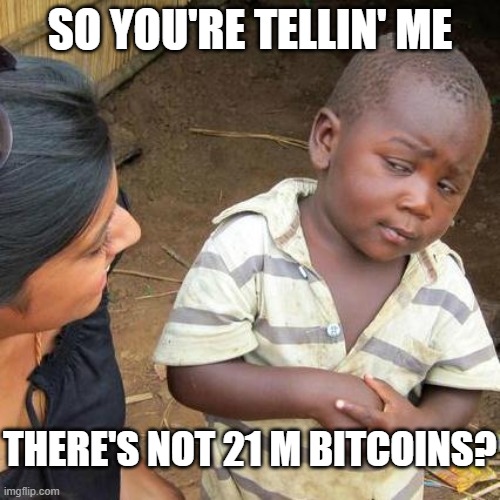
BIP-2,100,000,000,000,000,000
So, you're telling me...
- 21 million bitcoins is out, and...
- 2.1 quadrillion sats is in, except that...
- sats are out, so...
- 2.1 quadrillion bitcoins is in, except that...
- there are actually millisats, but...
- millisats are out, so...
- millibitcoins are in, so now...
- there are 2.1 quintillion millibitcoins, except that...
- millibitcoins are the basic base unit of bitcoin, so...
- millibitcoins are out, and now...
- 2.1 quintillion bitcoins are in

-
 @ 58537364:705b4b85
2025-05-28 08:25:55
@ 58537364:705b4b85
2025-05-28 08:25:55ถ้าอยากแล้วไม่หลง มันก็อยากด้วยปัญญา ความอยากอย่างนี้ท่านเรียกว่า เป็นบารมีของตน แต่ไม่ใช่ทุกคนนะที่มีปัญญา
บางคนไม่อยากจะให้มันอยาก เพราะเข้าใจว่า การมาปฏิบัติก็เพื่อระงับความอยาก ความจริงน่ะ ถ้าหากว่าไม่มีความอยาก ก็ไม่มีข้อปฏิบัติ ไม่รู้ว่าจะทำอะไร ลองพิจารณาดูก็ได้
ทุกคน แม้องค์พระพุทธเจ้าของเราก็ตาม ที่ท่านออกมาปฏิบัติ ก็เพื่อจะให้บรรเทากิเลสทั้งหลายนั้น
แต่ว่ามันต้องอยากทำ อยากปฏิบัติ อยากให้มันสงบ และก็ไม่อยากให้มันวุ่นวาย ทั้งสองอย่างนี้ มันเป็นอุปสรรคทั้งนั้น ถ้าเราไม่มีปัญญา ไม่มีความฉลาดในการกระทำอย่างนั้น เพราะว่ามันปนกันอยู่ อยากทั้งสองอย่างนี้มันมีราคาเท่า ๆ กัน
อยากจะพ้นทุกข์มันเป็นกิเลส สำหรับคนไม่มีปัญญา อยากด้วยความโง่ ไม่อยากมันก็เป็นกิเลส เพราะไม่อยากอันนั้นมันประกอบด้วยความโง่เหมือนกัน คือทั้งอยาก ไม่อยาก ปัญญาก็ไม่มี ทั้งสองอย่างนี้ มันเป็นกามสุขัลลิกานุโยโค กับอัตตกิลมถานุโยโค ซึ่งพระพุทธองค์ของเรา ขณะที่พระองค์กำลังทรงปฏิบัติอยู่นั้น ท่านก็หลงใหลในอย่างนี้ ไม่รู้ว่าจะทำอย่างไร ท่านหาอุบายหลายประการ กว่าจะพบของสองสิ่งนี้
ทุกวันนี้เราทั้งหลายก็เหมือนกัน ทุกสิ่งทั้งสองอย่างนี้มันกวนอยู่ เราจึงเข้าสู่ทางไม่ได้ก็เพราะอันนี้ ความเป็นจริงนี้ทุกคนที่มาปฏิบัติ ก็เป็นปุถุชนมาทั้งนั้น ปุถุชนก็เต็มไปด้วยความอยาก ความอยากที่ไม่มีปัญญา อยากด้วยความหลง ไม่อยากมันก็มีโทษเหมือนกัน “ไม่อยาก” มันก็เป็นตัณหา “อยาก” มันก็เป็นตัณหาอีกเหมือนกัน
ทีนี้ นักปฏิบัติยังไม่รู้เรื่องว่า จะเอายังไงกัน เดินไปข้างหน้าก็ไม่ถูก เดินกลับไปข้างหลังก็ไม่ถูก จะหยุดก็หยุดไม่ได้เพราะมันยังอยากอยู่ มันยังหลงอยู่ มีแต่ความอยาก แต่ปัญญาไม่มี มันอยากด้วยความหลง มันก็เป็นตัณหา ถึงแม้ไม่อยาก มันก็เป็นความหลง มันก็เป็นตัณหาเหมือนกันเพราะอะไร? เพราะมันขาดปัญญา
ความเป็นจริงนั้น ธรรมะมันอยู่ตรงนั้นแหละ ตรงความอยากกับความไม่อยากนั่นแหละ แต่เราไม่มีปัญญา ก็พยายามไม่ให้อยากบ้าง เดี๋ยวก็อยากบ้าง อยากให้เป็นอย่างนั้น ไม่อยากให้เป็นอย่างนี้ ความจริงทั้งสองอย่างนี้ หรือทั้งคู่นี้มันตัวเดียวกันทั้งนั้น ไม่ใช่คนละตัว แต่เราไม่รู้เรื่องของมัน
พระพุทธเจ้าของเรา และสาวกทั้งหลายของพระองค์นั้นท่านก็อยากเหมือนกัน แต่ “อยาก” ของท่านนั้น เป็นเพียงอาการของจิตเฉย ๆ หรือ “ไม่อยาก” ของท่าน ก็เป็นเพียงอาการของจิตเฉย ๆ อีกเหมือนกัน มันวูบเดียวเท่านั้น ก็หายไปแล้ว
ดังนั้น ความอยากหรือไม่อยากนี้ มันมีอยู่ตลอดเวลาแต่สำหรับผู้มีปัญญานั้น “อยาก” ก็ไม่มีอุปาทาน “ไม่อยาก” ก็ไม่มีอุปาทาน เป็น “สักแต่ว่า” อยากหรือไม่อยากเท่านั้น ถ้าพูดตามความจริงแล้ว มันก็เป็นแต่ "อาการของจิต" อาการของจิตมันเป็นของมันอย่างนั้นเอง ถ้าเรามาตะครุบมันอยู่ใกล้ ๆ นี่มันก็เห็นชัด
ดังนั้นจึงว่า การพิจารณานั้น ไม่ใช่รู้ไปที่อื่น มันรู้ตรงนี้แหละ เหมือนชาวประมงที่ออกไปทอดแหนั่นแหละ ทอดแหออกไปถูกปลาตัวใหญ่ เจ้าของผู้ทอดแหจะคิดอย่างไร? ก็กลัว กลัวปลาจะออกจากแหไปเสีย เมื่อเป็นเช่นนั้น ใจมันก็ดิ้นรนขึ้นระวังมาก บังคับมาก ตะครุบไปตะครุบมาอยู่นั่นแหละ ประเดี๋ยวปลามันก็ออกจากแหไปเสีย เพราะไปตะครุบมันแรงเกินไป
อย่างนั้นโบราณท่านพูดถึงเรื่องอันนี้ ท่านว่าค่อย ๆ ทำมัน แต่อย่าไปห่างจากมัน นี่คือปฏิปทาของเรา ค่อย ๆ คลำมันไปเรื่อย ๆ อย่างนั้นแหละ
อย่าปล่อยมัน หรือไม่อยากรู้มัน ต้องรู้ ต้องรู้เรื่องของมัน พยายามทำมันไปเรื่อย ๆ ให้เป็นปฏิปทา ขี้เกียจเราก็ทำไม่ขี้เกียจเราก็ทำ เรียกว่าการทำการปฏิบัติ ต้องทำไปเรื่อยๆอย่างนี้
ถ้าหากว่าเราขยัน ขยันเพราะความเชื่อ มันมีศรัทธาแต่ปัญญาไม่มี ถ้าเป็นอย่างนี้ ขยันไป ๆ แล้วมันก็ไม่เกิดผลอะไรขึ้นมากมาย ขยันไปนาน ๆ เข้า แต่มันไม่ถูกทาง มันก็ไม่สงบระงับ ทีนี้ก็จะเกิดความคิดว่า เรานี้บุญน้อยหรือวาสนาน้อย หรือคิดไปว่ามนุษย์ในโลกนี้คงทำไม่ได้หรอก แล้วก็เลยหยุดเลิกทำเลิกปฏิบัติ
ถ้าเกิดความคิดอย่างนี้เมื่อใด ขอให้ระวังให้มาก ให้มีขันติ ความอดทน ให้ทำไปเรื่อย ๆ เหมือนกับเราจับปลาตัวใหญ่ ก็ให้ค่อย ๆ คลำมันไปเรื่อย ๆ ปลามันก็จะไม่ดิ้นแรงค่อย ๆทำไปเรื่อย ๆ ไม่หยุด ไม่ช้าปลาก็จะหมดกำลัง มันก็จับง่าย จับให้ถนัดมือเลย ถ้าเรารีบจนเกินไป ปลามันก็จะหนีดิ้นออกจากแหเท่านั้น
ดังนั้น การปฏิบัตินี้ ถ้าเราพิจารณาตามพื้นเหตุของเรา เช่นว่า เราไม่มีความรู้ในปริยัติ ไม่มีความรู้ในอะไรอื่น ที่จะให้การปฏิบัติมันเกิดผลขึ้น ก็ดูความรู้ที่เป็นพื้นเพเดิมของเรานั่นแหละอันนั้นก็คือ “ธรรมชาติของจิต” นี่เอง มันมีของมันอยู่แล้ว เราจะไปเรียนรู้มัน มันก็มีอยู่ หรือเราจะไม่ไปเรียนรู้มัน มันก็มีอยู่
อย่างที่ท่านพูดว่า พระพุทธเจ้าจะบังเกิดขึ้นก็ตาม หรือไม่บังเกิดขึ้นก็ตาม ธรรมะก็คงมีอยู่อย่างนั้น มันเป็นของมันอยู่อย่างนั้น ไม่พลิกแพลงไปไหน มันเป็นสัจจธรรม
เราไม่เข้าใจสัจจธรรม ก็ไม่รู้ว่าสัจจธรรมเป็นอย่างไร นี้เรียกว่า การพิจารณาในความรู้ของผู้ปฏิบัติที่ไม่มีพื้นปริยัติ
ขอให้ดูจิต พยายามอ่านจิตของเจ้าของ พยายามพูดกับจิตของเจ้าของ มันจึงจะรู้เรื่องของจิต ค่อย ๆ ทำไป ถ้ายังไม่ถึงที่ของมัน มันก็ไปอยู่อย่างนั้น
ครูบาอาจารย์บางท่านบอกว่า ทำไปเรื่อย ๆ อย่าหยุด บางทีเรามาคิด “เออ ทำไปเรื่อย ๆ ถ้าไม่รู้เรื่องของมัน ถ้าทำไม่ถูกที่มัน มันจะรู้อะไร” อย่างนี้เป็นต้น ก็ต้องไปเรื่อย ๆ ก่อน แล้วมันก็จะเกิดความรู้สึกนึกคิดขึ้นในสิ่งที่เราพากเพียรทำนั้น
มันเหมือนกันกับบุรุษที่ไปสีไฟ ได้ฟังท่านบอกว่า เอาไม้ไผ่สองอันมาสีกันเข้าไปเถอะ แล้วจะมีไฟเกิดขึ้น บุรุษนั้นก็จับไม้ไผ่เข้าสองอัน สีกันเข้า แต่ใจร้อน สีไปได้หน่อย ก็อยากให้มันเป็นไฟ ใจก็เร่งอยู่เรื่อย ให้เป็นไฟเร็วๆ แต่ไฟก็ไม่เกิดสักที บุรุษนั้นก็เกิดความขี้เกียจ แล้วก็หยุดพัก แล้วจึงลองสีอีกนิด แล้วก็หยุดพัก ความร้อนที่พอมีอยู่บ้าง ก็หายไปล่ะซิ เพราะความร้อนมันไม่ติดต่อกัน
ถ้าทำไปเรื่อยๆอย่างนี้ เหนื่อยก็หยุด มีแต่เหนื่อยอย่างเดียวก็พอได้ แต่มีขี้เกียจปนเข้าด้วย เลยไปกันใหญ่ แล้วบุรุษนั้นก็หาว่าไฟไม่มี ไม่เอาไฟ ก็ทิ้ง เลิก ไม่สีอีก แล้วก็ไปเที่ยวประกาศว่า ไฟไม่มี ทำอย่างนี้ไม่ได้ ไม่มีไฟหรอก เขาได้ลองทำแล้ว
ก็จริงเหมือนกันที่ได้ทำแล้ว แต่ทำยังไม่ถึงจุดของมันคือความร้อนยังไม่สมดุลกัน ไฟมันก็เกิดขึ้นไม่ได้ ทั้งที่ความจริงไฟมันก็มีอยู่ อย่างนี้ก็เกิดความท้อแท้ขึ้นในใจของผู้ปฏิบัตินั้น ก็ละอันนี้ไปทำอันโน้นเรื่อยไป อันนี้ฉันใดก็ฉันนั้น
การปฏิบัตินั้น ปฏิบัติทางกายทางใจทั้งสองอย่าง มันต้องพร้อมกัน เพราะอะไร? เพราะพื้นเพมันเป็นคนมีกิเลสทั้งนั้น พระพุทธเจ้าก่อนที่จะเป็นพระพุทธเจ้า ท่านก็มีกิเลสแต่ท่านมีปัญญามากหลาย พระอรหันต์ก็เหมือนกัน เมื่อยังเป็นปุถุชนอยู่ ก็เหมือนกับเรา
เมื่อความอยากเกิดขึ้นมา เราก็ไม่รู้จัก เมื่อความไม่อยากเกิดขึ้นมา เราก็ไม่รู้จัก บางทีก็ร้อนใจ บางทีก็ดีใจ ถ้าใจเราไม่อยาก ก็ดีใจแบบหนึ่ง และวุ่นวายอีกแบบหนึ่ง ถ้าใจเราอยาก มันก็วุ่นวายอย่างหนึ่ง และดีใจอย่างหนึ่ง มันประสมประเสกันอยู่อย่างนี้
อันนี้คือปฏิปทาของผู้ปฏิบัติเรา
[อ่านใจธรรมชาติ] หลวงปู่ชา สุภัทโท หนังสือ หมวด: โพธิญาณ

-
 @ 3bf0c63f:aefa459d
2025-04-25 18:55:52
@ 3bf0c63f:aefa459d
2025-04-25 18:55:52Report of how the money Jack donated to the cause in December 2022 has been misused so far.
Bounties given
March 2025
- Dhalsim: 1,110,540 - Work on Nostr wiki data processing
February 2025
- BOUNTY* NullKotlinDev: 950,480 - Twine RSS reader Nostr integration
- Dhalsim: 2,094,584 - Work on Hypothes.is Nostr fork
- Constant, Biz and J: 11,700,588 - Nostr Special Forces
January 2025
- Constant, Biz and J: 11,610,987 - Nostr Special Forces
- BOUNTY* NullKotlinDev: 843,840 - Feeder RSS reader Nostr integration
- BOUNTY* NullKotlinDev: 797,500 - ReadYou RSS reader Nostr integration
December 2024
- BOUNTY* tijl: 1,679,500 - Nostr integration into RSS readers yarr and miniflux
- Constant, Biz and J: 10,736,166 - Nostr Special Forces
- Thereza: 1,020,000 - Podcast outreach initiative
November 2024
- Constant, Biz and J: 5,422,464 - Nostr Special Forces
October 2024
- Nostrdam: 300,000 - hackathon prize
- Svetski: 5,000,000 - Latin America Nostr events contribution
- Quentin: 5,000,000 - nostrcheck.me
June 2024
- Darashi: 5,000,000 - maintaining nos.today, searchnos, search.nos.today and other experiments
- Toshiya: 5,000,000 - keeping the NIPs repo clean and other stuff
May 2024
- James: 3,500,000 - https://github.com/jamesmagoo/nostr-writer
- Yakihonne: 5,000,000 - spreading the word in Asia
- Dashu: 9,000,000 - https://github.com/haorendashu/nostrmo
February 2024
- Viktor: 5,000,000 - https://github.com/viktorvsk/saltivka and https://github.com/viktorvsk/knowstr
- Eric T: 5,000,000 - https://github.com/tcheeric/nostr-java
- Semisol: 5,000,000 - https://relay.noswhere.com/ and https://hist.nostr.land relays
- Sebastian: 5,000,000 - Drupal stuff and nostr-php work
- tijl: 5,000,000 - Cloudron, Yunohost and Fraidycat attempts
- Null Kotlin Dev: 5,000,000 - AntennaPod attempt
December 2023
- hzrd: 5,000,000 - Nostrudel
- awayuki: 5,000,000 - NOSTOPUS illustrations
- bera: 5,000,000 - getwired.app
- Chris: 5,000,000 - resolvr.io
- NoGood: 10,000,000 - nostrexplained.com stories
October 2023
- SnowCait: 5,000,000 - https://nostter.vercel.app/ and other tools
- Shaun: 10,000,000 - https://yakihonne.com/, events and work on Nostr awareness
- Derek Ross: 10,000,000 - spreading the word around the world
- fmar: 5,000,000 - https://github.com/frnandu/yana
- The Nostr Report: 2,500,000 - curating stuff
- james magoo: 2,500,000 - the Obsidian plugin: https://github.com/jamesmagoo/nostr-writer
August 2023
- Paul Miller: 5,000,000 - JS libraries and cryptography-related work
- BOUNTY tijl: 5,000,000 - https://github.com/github-tijlxyz/wikinostr
- gzuus: 5,000,000 - https://nostree.me/
July 2023
- syusui-s: 5,000,000 - rabbit, a tweetdeck-like Nostr client: https://syusui-s.github.io/rabbit/
- kojira: 5,000,000 - Nostr fanzine, Nostr discussion groups in Japan, hardware experiments
- darashi: 5,000,000 - https://github.com/darashi/nos.today, https://github.com/darashi/searchnos, https://github.com/darashi/murasaki
- jeff g: 5,000,000 - https://nostr.how and https://listr.lol, plus other contributions
- cloud fodder: 5,000,000 - https://nostr1.com (open-source)
- utxo.one: 5,000,000 - https://relaying.io (open-source)
- Max DeMarco: 10,269,507 - https://www.youtube.com/watch?v=aA-jiiepOrE
- BOUNTY optout21: 1,000,000 - https://github.com/optout21/nip41-proto0 (proposed nip41 CLI)
- BOUNTY Leo: 1,000,000 - https://github.com/leo-lox/camelus (an old relay thing I forgot exactly)
June 2023
- BOUNTY: Sepher: 2,000,000 - a webapp for making lists of anything: https://pinstr.app/
- BOUNTY: Kieran: 10,000,000 - implement gossip algorithm on Snort, implement all the other nice things: manual relay selection, following hints etc.
- Mattn: 5,000,000 - a myriad of projects and contributions to Nostr projects: https://github.com/search?q=owner%3Amattn+nostr&type=code
- BOUNTY: lynn: 2,000,000 - a simple and clean git nostr CLI written in Go, compatible with William's original git-nostr-tools; and implement threaded comments on https://github.com/fiatjaf/nocomment.
- Jack Chakany: 5,000,000 - https://github.com/jacany/nblog
- BOUNTY: Dan: 2,000,000 - https://metadata.nostr.com/
April 2023
- BOUNTY: Blake Jakopovic: 590,000 - event deleter tool, NIP dependency organization
- BOUNTY: koalasat: 1,000,000 - display relays
- BOUNTY: Mike Dilger: 4,000,000 - display relays, follow event hints (Gossip)
- BOUNTY: kaiwolfram: 5,000,000 - display relays, follow event hints, choose relays to publish (Nozzle)
- Daniele Tonon: 3,000,000 - Gossip
- bu5hm4nn: 3,000,000 - Gossip
- BOUNTY: hodlbod: 4,000,000 - display relays, follow event hints
March 2023
- Doug Hoyte: 5,000,000 sats - https://github.com/hoytech/strfry
- Alex Gleason: 5,000,000 sats - https://gitlab.com/soapbox-pub/mostr
- verbiricha: 5,000,000 sats - https://badges.page/, https://habla.news/
- talvasconcelos: 5,000,000 sats - https://migrate.nostr.com, https://read.nostr.com, https://write.nostr.com/
- BOUNTY: Gossip model: 5,000,000 - https://camelus.app/
- BOUNTY: Gossip model: 5,000,000 - https://github.com/kaiwolfram/Nozzle
- BOUNTY: Bounty Manager: 5,000,000 - https://nostrbounties.com/
February 2023
- styppo: 5,000,000 sats - https://hamstr.to/
- sandwich: 5,000,000 sats - https://nostr.watch/
- BOUNTY: Relay-centric client designs: 5,000,000 sats https://bountsr.org/design/2023/01/26/relay-based-design.html
- BOUNTY: Gossip model on https://coracle.social/: 5,000,000 sats
- Nostrovia Podcast: 3,000,000 sats - https://nostrovia.org/
- BOUNTY: Nostr-Desk / Monstr: 5,000,000 sats - https://github.com/alemmens/monstr
- Mike Dilger: 5,000,000 sats - https://github.com/mikedilger/gossip
January 2023
- ismyhc: 5,000,000 sats - https://github.com/Galaxoid-Labs/Seer
- Martti Malmi: 5,000,000 sats - https://iris.to/
- Carlos Autonomous: 5,000,000 sats - https://github.com/BrightonBTC/bija
- Koala Sat: 5,000,000 - https://github.com/KoalaSat/nostros
- Vitor Pamplona: 5,000,000 - https://github.com/vitorpamplona/amethyst
- Cameri: 5,000,000 - https://github.com/Cameri/nostream
December 2022
- William Casarin: 7 BTC - splitting the fund
- pseudozach: 5,000,000 sats - https://nostr.directory/
- Sondre Bjellas: 5,000,000 sats - https://notes.blockcore.net/
- Null Dev: 5,000,000 sats - https://github.com/KotlinGeekDev/Nosky
- Blake Jakopovic: 5,000,000 sats - https://github.com/blakejakopovic/nostcat, https://github.com/blakejakopovic/nostreq and https://github.com/blakejakopovic/NostrEventPlayground
-
 @ 21810ca8:f2e8341e
2025-05-28 08:10:53
@ 21810ca8:f2e8341e
2025-05-28 08:10:53Ich bin neu bei Nostr und versuche mich hier rein zu fuchsen. Kann das einer sehen? Und dann habe ich noch viele Fragen
Gibt es gute Marktplätze wie ebay oder ebay kleinanzeigen wo man stink normale dinge und kram von zuhause gegen sat verkaufen kann.
-
 @ eb0157af:77ab6c55
2025-05-28 12:01:31
@ eb0157af:77ab6c55
2025-05-28 12:01:31A fake Uber driver steals $73,000 in XRP and $50,000 in Bitcoin after drugging an American tourist.
A U.S. citizen vacationing in the United Kingdom fell victim to a scam that cost him $123,000 in cryptocurrencies stored on his smartphone. The man was drugged by an individual posing as an Uber driver.
According to My London, Jacob Irwin-Cline had spent the evening at a London nightclub, consuming several alcoholic drinks before requesting an Uber ride home. The victim admitted he hadn’t carefully verified the booking details on his device, mistakenly getting into a private taxi driven by someone who, at first glance, resembled the expected Uber driver but was using a completely different vehicle.
Once inside the car, the American tourist reported that the driver offered him a cigarette, allegedly laced with scopolamine — a rare and powerful sedative. Irwin-Cline described how the smoke made him extremely docile and fatigued, causing him to lose consciousness for around half an hour.
Upon waking, the driver ordered the victim to get out of the vehicle. As Irwin-Cline stepped out, the man suddenly accelerated, running him over and fleeing with his mobile phone, which contained the private keys and access to his cryptocurrencies. Screenshots provided to MyLondon show that $73,000 worth of XRP and $50,000 in bitcoin had been transferred to various wallets.
This incident adds to a growing trend of kidnappings, extortions, armed robberies, and ransom attempts targeting crypto executives, investors, and their families.
Just a few weeks ago, the daughter and grandson of Pierre Noizat, CEO of crypto exchange Paymium, were targeted in a kidnapping attempt in Paris. The incident took place in broad daylight when attackers tried to force the family into a parked vehicle. However, Noizat’s daughter managed to fight off the assailants.
The post American tourist drugged and robbed: $123,000 in crypto stolen in London appeared first on Atlas21.
-
 @ b1ddb4d7:471244e7
2025-05-28 16:01:15
@ b1ddb4d7:471244e7
2025-05-28 16:01:15In the heart of East Africa, where M-Pesa reigns supreme and innovation pulses through bustling markets, a quiet revolution is brewing—one that could redefine how millions interact with money.
Enter Bitika, the Kenyan startup turning bitcoin’s complexity into a three-step dance, merging the lightning speed of sats with the trusted rhythm of mobile money.
At the helm is a founder whose “aha” moment came not in a boardroom, but at his kitchen table, watching his father grapple with the gap between understanding bitcoin and actually using it.
Bitika was born from that friction—a bridge between M-Pesa’s ubiquity and bitcoin’s borderless promise, wrapped in a name as playful as the Swahili slang that inspired it.
But this isn’t just a story about simplifying transactions. It’s about liquidity battles, regulatory tightropes, and a vision to turn Bitika into the invisible rails powering Africa’s Bitcoin future.
Building on Bitcoin
- Tell us a bit about yourself and how you got into bitcoin/fintech, and what keeps you passionate about this space?
I first came across bitcoin in 2020, but like many at that time, I didn’t fully grasp what it really was. It sounded too complicated, probably with the heavy terminologies. Over time, I kept digging deeper and became more curious.
I started digging into finance and how money works and realised this was what I needed to understand bitcoin’s objectives. I realized that bitcoin wasn’t just a new type of money—it was a breakthrough in how we think about freedom, ownership, and global finance.
What keeps me passionate is how bitcoin can empower people—especially in Africa—to take control of their wealth, without relying on unstable systems or middlemen.
- What pivotal moment or experience inspired you to create Bitika? Was there a specific gap in Kenya’s financial ecosystem that sparked the idea?
Yes, this idea was actually born right in my own home. I’ve always been an advocate for bitcoin, sharing it with friends, family, and even strangers. My dad and I had countless conversations about it. Eventually, he understood the concept. But when he asked, “How do I even buy bitcoin?” or “Can you just buy it for me?” and after taking him through binance—that hit me.
If someone I’d educated still found the buying process difficult, how many others were feeling the same way? That was the lightbulb moment. I saw a clear gap: the process of buying bitcoin was too technical for the average Kenyan. That’s the problem Bitika set out to solve.
- How did you identify the synergy between bitcoin and M-Pesa as a solution for accessibility?
M-Pesa is at the center of daily life in Kenya. Everyone uses it—from buying groceries to paying rent. Instead of forcing people to learn new tools, I decided to meet them where they already are. That synergy between M-Pesa and bitcoin felt natural. It’s about bridging what people already trust with something powerful and new.
- Share the story behind the name “Bitika” – does it hold a cultural or symbolic meaning?
Funny enough, Bitika isn’t a deeply planned name. It came while I was thinking about bitcoin and the type of transformation it brings to individuals. In Swahili, we often add “-ka” to words for flair—like “bambika” from “bamba.”
So, I just coined Bitika as a playful and catchy way to reflect something bitcoin-related, but also uniquely local. I stuck with it because thinking of an ideal brand name is the toughest challenge for me.
- Walk us through the user journey – how does buying bitcoin via M-Pesa in “3 simple steps” work under the hood?
It’s beautifully simple.
1. The user enters the amount they want to spend in KES—starting from as little as 50 KES (about $0.30).
2. They input their Lightning wallet address.
3. They enter their M-Pesa number, which triggers an STK push (payment prompt) on their phone. Once confirmed—pap!—they receive bitcoin almost instantly.
Under the hood, we fetch the live BTC price, validate wallet addresses, check available liquidity, process the mobile payment, and send sats via the Lightning Network—all streamlined into a smooth experience for the user.
- Who’s Bitika’s primary audience? Are you focusing on unbanked populations, tech enthusiasts, or both?
Both. Bitika is designed for everyday people—especially the unbanked and underbanked who are excluded from traditional finance. But we also attract bitcoiners who just want a faster, easier way to buy sats. What unites them is the desire for a seamless and low-barrier bitcoin experience.
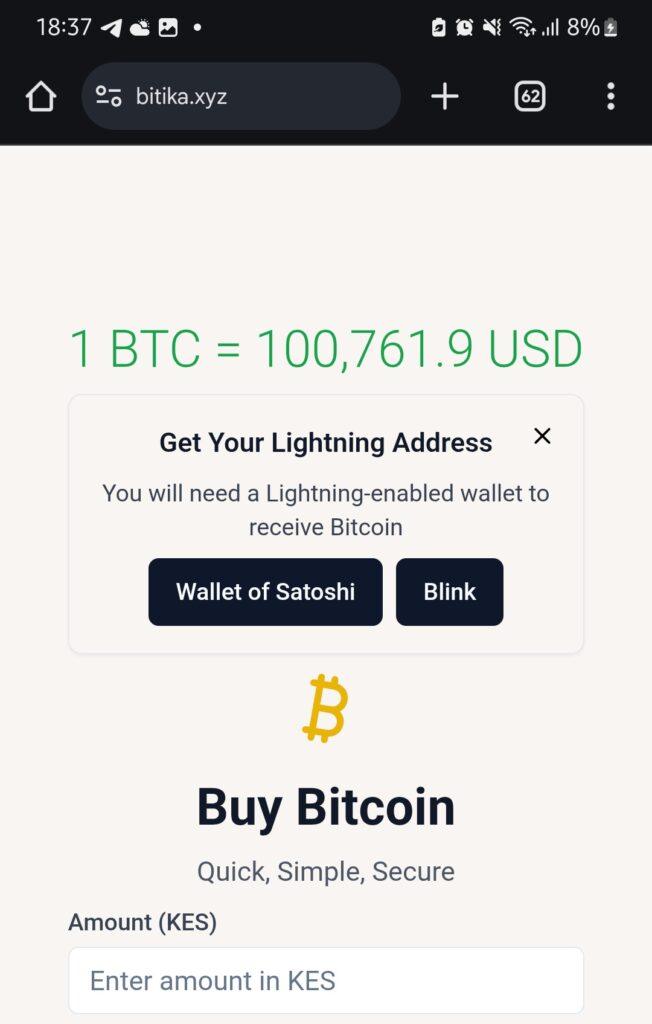
Community and Overcoming Challenges
- What challenges has Bitika faced navigating Kenya’s bitcoin regulations, and how do you build trust with regulators?
Regulation is still evolving here. Parliament has drafted bills, but none have been passed into law yet. We’re currently in a revision phase where policymakers are trying to strike a balance between encouraging innovation and protecting the public.
We focus on transparency and open dialogue—we believe that building trust with regulators starts with showing how bitcoin can serve the public good.
- What was the toughest obstacle in building Bitika, and how did you overcome it?
Liquidity. Since we don’t have deep capital reserves, we often run into situations where we have to pause operations often to manually restock our bitcoin supply. It’s frustrating—for us and for users. We’re working on automating this process and securing funding to maintain consistent liquidity so users can access bitcoin at any time, without disruption.
This remains our most critical issue—and the primary reason we’re seeking support.
- Are you eyeing new African markets? What’s next for Bitika’s product?
Absolutely. The long-term vision is to expand Bitika into other African countries facing similar financial challenges. But first, we want to turn Bitika into a developer-first tool—infrastructure that others can build on. Imagine local apps, savings products, or financial tools built using Bitika’s simple bitcoin rails. That’s where we’re heading.
- What would you tell other African entrepreneurs aiming to disrupt traditional finance?
Disrupting finance sounds exciting—but the reality is messy. People fear what they don’t understand. That’s why simplicity is everything. Build tools that hide the complexity, and focus on making the user’s life easier. Most importantly, stay rooted in local context—solve problems people actually face.
What’s Next?
- What’s your message to Kenyans hesitant to try bitcoin, and to enthusiasts watching Bitika?
To my fellow Kenyans: bitcoin isn’t just an investment—it’s a sovereign tool. It’s money you truly own. Start small, learn, and ask questions.
To the bitcoin community: Bitika is proof that bitcoin is working in Africa. Let’s keep pushing. Let’s build tools that matter.
- How can the bitcoin community, both locally and globally, support Bitika’s mission?
We’re currently fundraising on Geyser. Support—whether it’s financial, technical, or simply sharing our story—goes a long way. Every sat you contribute helps us stay live, grow our liquidity, and continue building a tool that brings bitcoin closer to the everyday person in Africa.
Support here: https://geyser.fund/project/bitika
-
 @ cae03c48:2a7d6671
2025-05-28 12:00:44
@ cae03c48:2a7d6671
2025-05-28 12:00:44Bitcoin Magazine
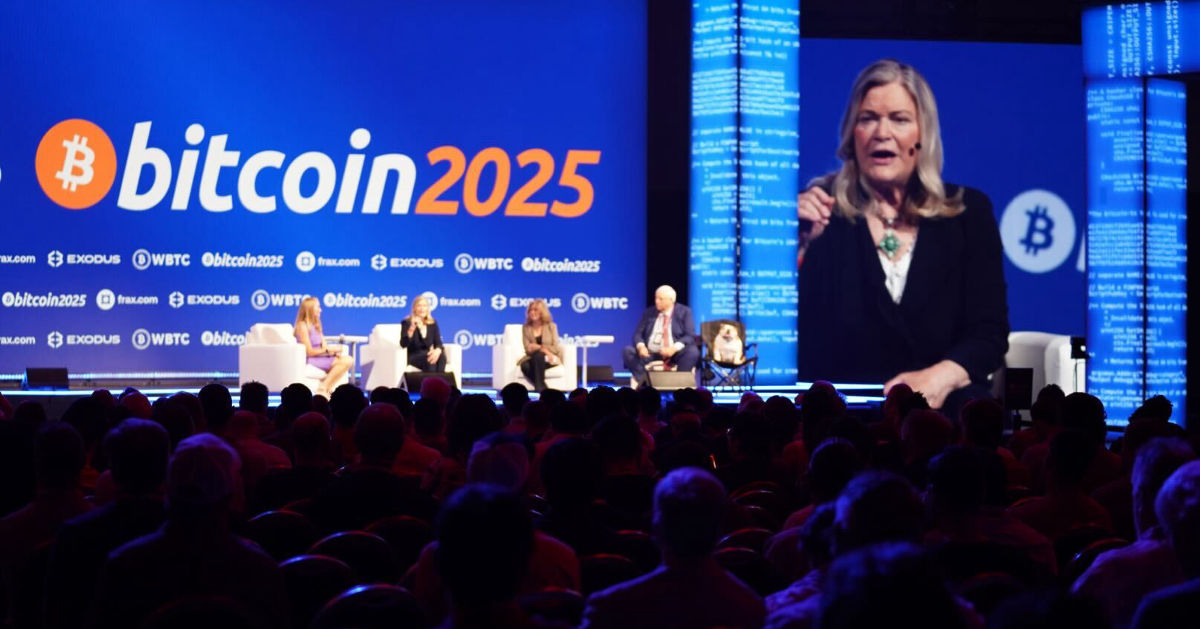
President Trump Supports Strategic Bitcoin Reserve Bill, Senator Lummis SaysToday at the Bitcoin 2025 Conference in Las Vegas, Nevada, US Senator Cynthia Lummis of Wyoming, Senator Marsha Blackburn of Tennessee, and Senator Jim Justice of West Virginia, took the stage to give updates on federal and state level Bitcoin adoption in the United States.
JUST IN:
 Senator Cynthia Lummis said US military generals are "big supporters" of a Strategic Bitcoin Reserve for economic power. pic.twitter.com/2RPMV3tbdA
Senator Cynthia Lummis said US military generals are "big supporters" of a Strategic Bitcoin Reserve for economic power. pic.twitter.com/2RPMV3tbdA— Bitcoin Magazine (@BitcoinMagazine) May 27, 2025
Cynthia Lummis announced that President Donald Trump is supportive of her Strategic Bitcoin Reserve Act, which would see the United States purchase 1,000,000 BTC, among other pro-Bitcoin and stablecoin legislation.
“President Trump supports the bill,” she stated. “And he has a team in the White House working on digital assets — everything from stablecoins to market structure to Bitcoin Strategic Reserve. And they will probably roll out in that order.”
“States have always been the incubators of innovation,” Lummis said. “Senator Justice was the Governor of West Virginia, Senator Blackburn will be the next Governor of Tennessee. The states are where the innovation is occurring.”
“So you have Arizona, Texas and New Hampshire that passed Strategic Bitcoin Reserve bills this year,” she continued. “30 states consider Strategic Bitcoin Reserves. We have the United Arab Emirates purchasing Bitcoin through American exchange traded funds — that’s good for America.”

Senator Blackburn echoed Lummis’ statements, sharing her thoughts on how other countries will follow the United States in their adoption of Bitcoin.
“Many of our allies follow what we do,” Blackburn said. “Everybody wants to be a part of of our market, they want to be a part of our trade. And they will follow what we do. And as Senator Lummis said, we already see countries that are establishing these reserves. So it is vitally important that we hold this as a portion of our reserves.”
Justice emphasized that to be successful, “we have got to get the economics right. Many people ask me many times as Governor, ‘what’s the most important thing you do?’ And I’ll promise you this, it’s all about the economics.”
Justice then went on to explain that when the average, everyday person is using Bitcoin to purchase their necessities, that legislation will start “happening at light speed”, because politicians want to get re-elected and therefore must follow the will of the people.

You can watch the full panel discussion and the rest of the Bitcoin 2025 Conference Industry Day below:
This post President Trump Supports Strategic Bitcoin Reserve Bill, Senator Lummis Says first appeared on Bitcoin Magazine and is written by Nik.
-
 @ b1ddb4d7:471244e7
2025-05-28 16:01:13
@ b1ddb4d7:471244e7
2025-05-28 16:01:13Custodial Lightning wallets allow users to transact without managing private keys or channel liquidity. The provider handles technical complexities, but this convenience comes with critical trade-offs:
- You don’t control your keys: The custodian holds your bitcoin.
- Centralized points of failure: Servers can be hacked or shut down.
- Surveillance risks: Providers track transaction metadata.
Key Risks of Custodial Lightning Wallets
*1. Hacks and Exit Scams*
Custodians centralize large amounts of bitcoin, attracting hackers:
- Nearly $2.2 billion worth of funds were stolen from hacks in 2024.
- Lightning custodians suffered breaches, losing user funds.
Unlike non-custodial wallets, victims have no recourse since they don’t hold keys.
*2. Censorship and Account Freezes*
Custodians comply with regulators, risking fund seizures:
- Strike (a custodial Lightning app) froze accounts of users in sanctioned regions.
- A U.K. court in 2020 ordered Bitfinex to freeze bitcoin worth $860,000 after the exchange and blockchain sleuthing firm Chainalysis traced the funds to a ransomware payment.
*3. Privacy Erosion*
Custodians log user activity, exposing sensitive data:
- Transaction amounts, receiver addresses, and IPs are recorded.
*4. Service Downtime*
Centralized infrastructure risks outages.
*5. Inflation of Lightning Network Centralization*
Custodians dominate liquidity, weakening network resilience:
- At the moment, 10% of the nodes on Lightning control 80% of the liquidity.
- This centralization contradicts bitcoin’s decentralized ethos.
How to Switch to Self-Custodial Lightning Wallets
Migrating from custodial services is straightforward:
*1. Choose a Non-Custodial Wallet*
Opt for wallets that let you control keys and channels:
- Flash: The self-custodial tool that lets you own your keys, control your coins, and transact instantly.
- Breez Wallet : Non-custodial, POS integrations.
- Core Lightning : Advanced, for self-hosted node operators.
*2. Transfer Funds Securely*
- Withdraw funds from your custodial wallet to a bitcoin on-chain address.
- Send bitcoin to your non-custodial Lightning wallet.
*3. Set Up Channel Backups*
Use tools like Static Channel Backups (SCB) to recover channels if needed.
*4. Best Practices*
- Enable Tor: Mask your IP (e.g., Breez’s built-in Tor support).
- Verify Receiving Addresses: Avoid phishing scams.
- Regularly Rebalance Channels: Use tools like Lightning Pool for liquidity.
Why Self-Custodial Lightning Matters
- Self-custody: Control your keys and funds.
- Censorship resistance: No third party can block transactions.
- Network health: Decentralized liquidity strengthens Lightning.
Self-custodial wallets now rival custodial ease.
Custodial Lightning wallets sacrifice security for convenience, putting users at risk of hacks, surveillance, and frozen funds. As bitcoin adoption grows, so does the urgency to embrace self-custodial solutions.
Take action today:
- Withdraw custodial funds to a hardware wallet.
- Migrate to a self-custodial Lightning wallet.
- Educate others on the risks of custodial control.
The Lightning Network’s potential hinges on decentralization—don’t let custodians become its Achilles’ heel.
-
 @ 5188521b:008eb518
2025-04-25 08:06:11
@ 5188521b:008eb518
2025-04-25 08:06:11Ecology
When my father died, an entire ecosystem of beneficiaries withered. Moussa Ag El Khir funded scholarships and community projects, paying thousands of Dinars monthly to stop the oasis town of In Salah from burning up. The few families we knew operating outside the oil-field economy would be forced to flee to the Mediterranean coast, along with just about every other Berber.
It wasn’t unexpected. My father had cystic fibrosis for all sixty-one years of his life. So far, that’s the only legacy he’s passed on to his children. My brothers are just carriers, but me, his precious daughter ended up like him in more ways than one.
We sat there in the lawyer’s office in Algiers, my brothers and I, staring at the ledger which contained payment for his life’s work.
“And he only left one word in his will?” asked Ibrahim for the third time. Ecology.
The lawyer said Moussa was very clear. He chose each of the keys himself. The contents of the ledger would belong to whoever could decode his life — those who understood the real meaning. Then he cut all communications and walked into the Sahara. The Tuareg caravan on the road to Akabli found his body a week later, reddened by sand burn.
Earth
We made an agreement that day. To share each word we discovered. We could break the code together. Of course, Ibrahim and Hama didn’t share anything. We barely speak. That’s what happens when one child follows their father into science, and her two brothers move to France the minute they get rich enough to buy a wife. I bet they spent longer looking into legal loopholes to get their hands on my father’s assets than they did trying to identify the keys.
That day was the start of my second life, and I went from research assistant at a regional university to private-key detective. 2048 words and few clues where to start. Although I was 27, I was virtually a grandmother according to the In Salah wives. But of course, I could never be a grandmother, or even a mother. Every night, I scoured photos in the family archive. An initial sweep of his digital footprint returned no out-of-place instances of any keywords.
It took me a year to find the GPS tag he’d added to one photo — an eighteen-year-old daughter standing next to a father proud of his first infinite solar prototype. The panel has long-since been torn out by the oil corp, but the base is still there. I drove the three kilometres from the town limit and shone the high beams at the spot. When I got out, the air was cool but still thick with sand. A few more steps through sinking dunes, and I saw it. He’d scratched a little globe into the blistered metal, and for a moment, my mucus-laden lungs tasted clear air.
Trigger
The next word took three years. Friends, contacts, professors, biographers — visits to anyone with whom he might have left a clue. But it was in the In Salah hospital, where, upon a routine CF checkup with Jerome Devailier, a French doctor, ‘trigger’ appeared. The government might stack everything against the desert peoples, but they hadn’t taken away healthcare. I’d been living off the kindness of neighbours while finishing my thesis on the very solar technology my father developed. How could he have known the ‘buyer’ was just a tendril of the very oil company he sought to defeat.
Dr Devalier went through the list of carcinogens and allergens to avoid with my new drugs. Over forty triggers which could be my downfall. If I was lucky, I’d live as long as my father did.
By then, my research stipend was long gone. I existed on toughened bread and soup, which always carried the taste of the scorched city air. Yet, I stayed. The public library, disconnected from the grid by the oil corp, was where I finished my manuscript. They would fight its publication. Since father’s money no longer flowed into the town, many had deserted me. There were those who said he killed an entire people by selling his solar patent to the wrong buyers. Others in In Salah worshipped his name, but eventually, they all trudged north to the cities. My brothers sold the family home from under me, forcing me to follow.
When I returned from the hospital, I dug out my father’s medical documents. On every page, the word ‘trigger’ was underlined. That was the moment I knew my life’s work would be unlocking the ledger, not publishing studies on long-dead solar panel technology. That battle was lost.
They
All we need is a simple document, but here, it is the administrators’ job to send people away. Physical copies are only issued in extreme circumstances. Citizens’ Registry screens played endless repetitions of how to apply for digital documents. The shrill voices of family members desperate for the original copy of a pirated document drowned the TV messaging. Women removed headscarves and revealed thick black hair; teenagers paced. The atmosphere thickened with sweat. And hours passed. Each appointment required a reset of digital protocol, biometric tests, and identity cards from legal descendents. Through counterfeit identities, our Dinars leak into the hands of criminals, but still the government denies the need for bitcoin. They just print more money. They is the word my father used for the government that fought his patent so hard.
After a four-hour wait, I discovered that the physical death certificate included an ‘identifying mark’ on the deceased’s body. The ink was fresh — etched into the shoulder blade of a man who wished to turn his back on the government that ignored its people. The tattoo read aqqalan, the Tamasheq word for they.
Scheme
It took two trips to his cluttered Marseille office to convince him I was serious. Two visas, two flights, and the small amount from the sale of the family house. But few detectives wanted to work for a promise.
The ledger could not legally be owned in Algeria, and Laurent Mercier was the only serious professional who entertained a percentage of what was on there. The solar tech patent and documents from my father were enough to start Laurent on the trail. ‘Preliminary,’ he said, until I had the ledger in my possession.
“Flying is not easy with my condition,” I said.
He lowered his sunglasses. “Working is not easy without money.”
Contact with my brother through the lawyer in Algiers was achingly slow, but eventually they agreed to give me possession. What was 33% of nothing anyway? Years had gone by.
So, when I sat for the second time, in the sweaty office in Marseille, I gave Laurent the ledger, and he handed me a surprise. In all his business affairs, my father used little English, but the word ‘scheme’ appeared in all three company names he incorporated in the last three years of his life. We had our fifth word, and I finally had someone on my side.
Make
Some days, I could barely walk to the public library. I became lethargic and mostly sat in the cool dark of my room in the shelter. The government refused to provide housing outside of Algiers, but a Tuareg organisation from Mali opened a shelter in In Salah. Bulging eyes and faded clothes stared back in the mirror each day. How long had it been since I’d been to a wedding, or celebrated a friend’s child? Occupants came and went, and all that was left was a barren room and one meal per day.
As the sun punished the city with every ray of Allah’s untapped gift, streets grew thick with dust, and the local government fell, seat by seat, to oil execs. The only transport running was to and from the oil fields, which belched the remnants of the land into the sky. And still they worked. Still they sat on my father’s patent and refused to supply the world with efficient solar power.
With little else to cling onto, I harboured thoughts of how I could spend the ledger money. Fixing the town and replanting lost gardens. Bringing people back. That all took a back seat to decoding the message my father was sending. Laurent and I began to believe that the keys he chose formed some sort of instruction for his legacy.
Ten years to the day after his death, I was in the public library, looking for clues in an English history book. On my exit, the librarian stopped me.
“We have a gift for you, Kana.”
I waited while he fetched a package.
“Your father instructed me to give this to you. But not before this date.”
My hands tore open the package. More books, technical manuals, and hand-written notes. Amongst the papers was a tasselled leather bookmark embossed with the four letters that comprised one of the seven missing words. Make.
Citizen
It’s hard for a father in Algeria to admit to his daughter that she is his spirit — the heir to his life’s work. Of course he felt terrible guilt after our mother’s passing. That was when the letters started.
Moussa wrote to himself really, trying to come to terms with bringing a protégé into the world with a bright scientific mind and lungs that would snap her life expectancy. We communicated by letter for the last few years of his life — sharing the breakthroughs of his findings and what it might mean for our decaying oasis town. Analogue writing was the only real privacy, he said. His letters always ran to the same length, as if they were one lesson divided into equal chunks. We even exchanged letters during his last hospitalisation in Algiers. Those words were the only real strength I gained.
It was Laurent who analysed the letters with a new text scanning tool. For me, my father’s last letters were advice, regret, pain, and love, but to Laurent, they were simply a puzzle to solve to get one step closer.
Our letters gave Laurent the idea to communicate via physical mail. The process was painful, with letters sent from outlying towns before being shipped across the Alboran Sea and up into France. Muatin was one name my father called me. Like him, I dreamed of helping many through science. This was one of the few Arabic words in the French letters he wrote. It was also the only keyword included in any of the letters. Citizen.
When
Years of quiet followed. In Salah became unlivable after they co-opted the city reservoir for cooling drilling rigs. Each study that proved the field was still viable funnelled funds away from the locals who clung on. Resettlement benefits went up, and all but the semi-nomadic Tuaregs left. I followed. My health could not take much more desert. In the cooler coastal plains, I recovered strength, and subsidies for new medications helped me survive on a meagre teaching salary.
With no further clues, my Marseillais detective lost interest. His last letter, sent years ago, stated with unusual brevity that he was resigning the case. No payment was due.
I had lost my health, my father, his work, my money, our house, the town, and I spent each week delivering science and English classes to teenagers. They had no more hope for our country than I had. Algerians had already lost the Sahara. A one-degree temperature shift each decade of my life had shrunk Africa and sent its peoples northwards.
My father’s word puzzle occupied my thoughts. The combinations and permutations of letters and characters had millions of possible meanings but only one correct answer. Yet simple linguistic logic provided the next word. The headteacher was a linguist — a profession long lost to the higher-powered text analysers and language AI. He spoke little English but asked about the categorisations of grammatical terms in the 2048 key words.
“Why do you ask?”
“Because,” he said, “for a sentence of twelve words, at least one conjunction is necessary to form a second clause.”
He was right. I had been focussing on lists and complex codes to build my father’s motto. When I got home, I furiously searched my list of terms for conjunctions. I found only one. ‘When.’
Can
The permutations were still huge. Even eliminating some of the more conceptual words did not help. Millions of sentences existed in my dead father’s mind. Millions of meanings, all lost to the need for more energy to fund the world’s great thirst for energy. Still, the panels in most of the ‘dead middle’ (as the space between the tropics became known) melted at over 50 degrees.
I was back in Paris for CF treatment. As a young woman, I would have been pleased to make fifty years. But the realities of daily visits and the sickness brought on by medication stung. I wanted things to end, even when I discovered the next key.
It had been years since I had dreamed of the freedoms my father’s fortune could bring. Parts of Asia held out against bitcoin, but the cost of countries doing business off-network had become prohibitive. Eventually, the fossil conglomerates would give in to the need for solar mining and the provision of universal energy.
It was in a Parisian hospital bed that I discovered ‘can.’ My wardmate, a rough labourer from Oran, found a biography in the hospital library that made me sit up straight. ‘Can’ was repeated in almost every description of my father in his one-time business partner’s book. And it was this Arabian ‘businessman,’ Abdulkarim Rahman, who brokered the deal that robbed the world of infinite solar power. Each page mocked my father as believing only physical impossibilities are impossible. He branded him the ‘can man.’
Drastic
During my recuperation, I spent the final two weeks of my visa stay in Marseille. My days passed with endless algorithm tweaks to reject or accept word orders for the elusive twelve-word sentence my father once wrote.
Food lost its taste, and friends and colleagues in academia had scattered. In-person meetings were often contained to the night hours, but Marseille was not a place to go out after dark. The latest protests had gotten violent, and the government looked likely to topple. My people had always been resilient, but when the option to move and operate a caravan was removed by General Hafiz, part of my spirit died. I resolved to spend my final years in In Salah, however uncomfortable they would be.
My final port of call before returning was Laurent’s office. The eTaxi cast me out into the dusty street, and I wheezed as I climbed the three flights of stairs to his tiny door on Rue Marché. We hadn’t spoken in years, but I was surprised to find a different name about the door. Pascale Dupont, Investigateur.
The assistant I remembered was quite the opposite to Laurent — slow and methodical, short and heavy set.
“Madame,” he said. “I have difficult news.”
Their business had always straddled the law, but I never imagined an ex-officer of the law could be convicted of treason.
“A closed-door trial,” said Pascale. Then he handed over an air-gapped 3D storage file. “Laurent knew you would come for this.”
My mind cast forward to the reams of information he must have built on my father. The patents and technical diagrams he illegally acquired and other clues. I instantly recognised the brand of storage file as a keyword. Drastic.
“How can I thank him?”
“He is dead, madame.” Pascale hung his head. “He survived prison for only two weeks.”
Must
My final years brought me home. In Salah had gained fame for its one group of Tuaregs who refused to leave. The Lakzis owned a house in a desperate condition, not dissimilar to my failing body. By the age of fifty-two, I could no longer walk, but they welcomed me. I pooled my disability allowance and some money I’d gained from selling my father’s watch. We waited for the world to mourn the death of a once great city. We would keep it alive by refusing to move, by refusing to permit its rebranding as an ‘industrial area.’ Now the oil fields were finally drying up, they wanted to dig under the town.
We had managed to eliminate half of the remaining words. Just under 1,000 possible selections for the final two words, but little idea of an order.
The problem was that I was the only English speaker among them, and it took great energy to attempt to teach the meaning of the words and possible grammatical constructions for my father’s sentence.
But soon, patterns began to emerge. Fragments of word pairings and groups. ‘Trigger drastic scheme’ appeared again and again in the permutations. ‘They can’ and ‘When they can’ gave a tantalising glimpse. We ranked sentences in terms of likelihood to form the full key and categorised them by the most likely remaining words. Due to the need for a modal verb, ‘must’ scored highest by our calculations.
In this race to unlock the ledger before In Salah’s destruction, we nosed ahead.
Yet the day of that discovery was my final day in the desert. An air ambulance transported my feeble body to Algiers, and I would never return.
They messaged me — so close. They would unlock the ledger with the final word after my operation. The bitcoin could undo the wrongs of the past, and my father’s sentence would live on.
End
The phrase which began the global revolution first appeared on the wall of a much-disputed oil refinery in the desert outside In Salah, Algeria.
When they can make ecology end, citizen earth must trigger drastic scheme
Soon, the graffiti marked government buildings in Algiers. Activists took to the streets. Governments crumbled and currencies collapsed. Climate groups received massive donations said to come from ‘the one,’ a ledger with a huge stack written off by financiers the world over. The codebreaker credited with unlocking the ledger was unable to witness the transfer of 10,000 coins to the Global Climate Fund due to her death, aged 52, from a congenital condition.
The words of Moussa Ag El Khir now mark each of the millions of panels, which line the ‘dead middle.’ They contribute over 80% of the Earth’s power supply.
To mark the fiftieth anniversary of his death, the World Climate Forum will be held in the town of his birth, In Salah, Algeria. This story, compiled from the diaries of his daughter, Kana Ult El Khir, will be read as the opening address of the conference.
This story was originally published in 21 Futures: Tales From the Timechain
To continue the story of the real-world treasure (sats) use the address (it's real).\ Who knows, maybe some zaps will find their way into the wallet...

-
 @ 3770c235:16042bcc
2025-05-28 05:54:01
@ 3770c235:16042bcc
2025-05-28 05:54:01** Introduction: The Neon Pulse of Las Vegas
**It’s 2:30 AM on a Tuesday. The Strip hums with laughter, clinking glasses, and the occasional Elvis impersonator. A group of friends stumbles out of a nightclub, squinting under the glow of a Las Vegas billboard that screams, “Hungry? $5 Pancakes → 1 Block Right!” Ten minutes later, they’re drowning their late-night cravings in syrup.This isn’t luck—it’s Las Vegas billboards doing what they do best: working while the rest of the world sleeps. In a city where the party never stops, these glowing giants are the ultimate salespeople. Let’s dive into why Las Vegas billboards outshine traditional ads and how your business can ride their 24/7 energy wave.
** Why Las Vegas Billboards Never Take a Coffee Break
** 1. Tourists Don’t Have Bedtimes (and Neither Do Billboards)
- 42 million visitors flock to Vegas yearly. They’re sipping margaritas at noon, gambling at midnight, and shopping at 3 AM.
- Las Vegas billboards near hotspots like the Bellagio Fountains or Fremont Street catch eyes round the clock.Real Story:
A donut shop owner named Luis rented a billboard near the “Welcome to Vegas” sign. His message? “Jet Lagged? Sugar Fix Open 24/7!” Sales tripled—especially between 1 AM and 4 AM.** 2. You Can’t “Skip” a Billboard
** - Imagine this: You’re stuck in traffic on the Strip. Your phone’s dead. That Las Vegas billboard for air-conditioned massages? It’s your lifeline.
- Compare that to online ads: 47% of people skip them, and TikTok ads vanish in a scroll.- Vegas Thrives on Impulse
- Billboards tap into spontaneous decisions:
- “Let’s try that rooftop bar!”
- “Wait, free slot play? Let’s U-turn!”
- Traditional ads (like radio spots) fade fast. Billboards linger, nudging tourists to act now.
** 5 Reasons Your Business Needs a Vegas Billboard
** 1. Size Matters (And So Does Flash)
- Strip billboards can be taller than a 5-story building.
- Digital screens use LEDs so bright, they’re visible from space.Pro Tip:
A casino added fake “smoke” effects to their billboard for a Halloween promo. Traffic backed up for selfies—and bookings spiked.- No Language Barrier
- Vegas draws visitors from Tokyo, Berlin, São Paulo...
- A Las Vegas billboard with a giant cocktail emoji? Universal for “Drinks here!”
Case Study:
A Korean BBQ spot used a billboard of sizzling meat. No words. Just smoke visuals. Tourists followed the “aroma” straight to their door.- They’re Always in the Right Place, Right Time
- 6 AM: Joggers see smoothie ads.
- 3 PM: Pool partiers spot “Free Margarita” promos.
-
Midnight: Hangover clinics whisper, “We’ve got IVs.”
-
Instant Trust Boost
- A tiny online ad says “startup.” A glowing billboard says, “We’re Vegas royalty.”
Jake’s Win:
Jake’s tiny magic shop rented a billboard reading, “Real Tricks—Cheaper Than the Casino!” Tourists treated him like David Blaine.- QR Codes = Instant Customers
- “Scan for free parking!” → 1,000 scans in a weekend.
- “Tap to call a limo” → Rides booked before the light turns green.
** How to Make Your Vegas Billboard Irresistible
** Step 1: Claim Your Territory
- The Strip: Pricey but prime ($15k–$60k/month).
- Fremont Street: Quirky, cheaper ($5k–$20k), packed with partiers.
- Highway 15: Target road-trippers with “Almost There! Cold Beer Ahead!”Step 2: Keep It Stupid Simple
- Bad: “Experience Culinary Excellence at Our Artisanal Bistro!”
- Good: “24/7 Bacon Pancakes → Exit Here.”Maria’s Hack:
Maria’s tattoo parlor used a billboard with a flaming skull and three words: “Walk-Ins Welcome.” No phone number. “People just… show up,” she laughs.Step 3: Track Your Wins (Like a Vegas High Roller)
- QR Codes: “Scan for Free Slot Play!” → Track scans.
- Unique URLs: “Visit VegasPizza24.com” → Monitor traffic.
- Old-School: Count foot traffic. (“Did that bachelor party just roll in from our billboard? Yes.”)**FAQs ** 1. “How do I even measure if my billboard’s working? It’s not like online ads!”
Answer:
You’re right—it’s not just clicks and likes. But here’s how real businesses track success:
- QR Codes: Add a unique code like “Scan for Free Appetizer!” Track scans.
- Promo Codes: “Mention this billboard for 20% off!” (Works great for Uber drivers: “My passengers blurt it out mid-ride,” says driver Luis M.)
- Foot Traffic Spikes: Note sales surges after your ad goes live. A dispensary saw a 60% bump in visits after their “We’re Closer Than the Casino!” billboard.
- Social Media Tags: Encourage selfies with your billboard. A retro motel offered a free pool pass for tagged photos. Their Instagram exploded.- “Aren’t billboards old-school? My Gen Z customers live on TikTok!”
Answer:
Billboards in Vegas are anything but old-school. Here’s why: - Hybrid Campaigns: Pair billboards with geofenced mobile ads. Example: A billboard for a pool party says, “Scan to Pre-Order Drinks.” Users nearby get a TikTok-style ad on their phone.
- Instagrammable Designs: Quirky billboards go viral. The “Welcome to Vegas” sign is the most Instagrammed spot in the city. Mimic that vibe!
- Influencer Collabs: Pay a Vegas influencer to pose with your billboard. Their followers will hunt it down like a scavenger hunt.
Real Story:
A vintage clothing store’s billboard (“Find Your Retro Vibe → 2 Blocks East”) became a TikTok trend after a local influencer did a “thrift haul” video there.** 3. “What’s the biggest mistake businesses make with Vegas billboards?”
** Answer:
Trying to cram in too much info! Drivers have 5–7 seconds to read your ad. Avoid:
- Text Overload: “Grand Opening! 50% Off! Open 24/7! Call Now!” → Too much!
- Bland Designs: Gray text on a gray background? Yawn.
- Ignoring Locals: Tourists are 70% of viewers, but locals matter too. A gym’s billboard said, “Tired of Tourists? Work Out in Peace.” Memberships spiked.Fix It:
- Use 7 words max.
- Bold colors (red, yellow, neon pink).
- Add a clear call to action: “Turn Right Now!” or “Scan for Free Parking.”- “Do I need a permit? What if my ad gets rejected?”
Answer:
Yep, permits are a thing. The city bans: - Flashing Lights Near Residences: No strobes in suburban areas.
- Certain Content: No swear words, adult themes, or political fights.
How to Avoid Rejection:
- Work with local Outdoor Advertising companies—they know the rules.
- Submit designs early. One pizza joint’s ad was flagged for a pepperoni slice deemed “too suggestive.” They swapped it to a cheese pull… and it got approved.Conclusion: Let Your Business Shine All Night Long
At 5 AM, as the sun peeks over the desert, the Las Vegas billboards keep glowing. They’ve sold midnight pancakes, inspired shotgun weddings, and even talked someone out of a questionable tattoo (“Wait! Our Parlor’s Better → Next Exit”).These aren’t just ads—they’re part of Vegas’ heartbeat. So whether you’re slinging sushi, massages, or monster truck rides, remember: In a city that never sleeps, your billboard shouldn’t either.
Ready to Light Up the Night?
Find Las Vegas billboards near you today. And if you spot one that says, “Free High-Fives for Readers of This Article,” honk twice. It’s probably yours. -
 @ 9ca447d2:fbf5a36d
2025-05-28 11:01:17
@ 9ca447d2:fbf5a36d
2025-05-28 11:01:17Steak ‘n Shake recently made headlines by officially accepting bitcoin payments via the Lightning Network across all its U.S. locations. The integration of Bitcoin payments at over 500 locations is a monumental moment for both the fast food industry and the broader retail sector.
This is not just something that Steak ‘n Shake is testing in a handful of locations, they are doing a full-scale rollout, fully embracing Bitcoin.
With more than 100 million customers a year, Steak ‘n Shake’s integration of Lightning—Bitcoin’s fast, low-fee payment layer—makes it easier than ever to use Bitcoin in day-to-day life. Buying a burger and a shake with sats? That’s now a real option.
The process is straightforward. Customers simply scan a Lightning QR code at the register, completing their payment in seconds, while Steak ‘n Shake receives instant USD conversion, ensuring price stability and ease of use.
So what does this mean for Bitcoin and E-commerce?
For starters, Steak ‘n Shake becomes the first of eventually many to fully embrace a digital world. As Bitcoin continues to grow, consumers will continue to realize the benefits of saving in a currency that is truly scarce and decentralized.
This is a huge step forward for Bitcoin as it shows it is not just for holding, it’s for spending, too. And by using the Lightning Network, Steak n’ Shake is helping prove that Bitcoin can scale for everyday transactions.
This now creates a seamless checkout experience, making bitcoin a viable alternative to credit cards and cash.
More importantly, it signals a significant shift in mainstream attitudes towards Bitcoin. As a well-known brand across America, this move serves as a powerful endorsement, likely to influence other chains and retailers to consider similar integrations.
Related: Spar Supermarket in Switzerland Now Accepts Bitcoin Via Lightning
What can this mean for your business?
Accepting bitcoin as payment can open the door to a new demographic of tech-savvy, financially engaged consumers who prefer digital assets.
As we know, companies that adopt Bitcoin receive a fascinating amount of love from the Bitcoin community and I would assume Steak n’ Shake will be receiving the same amount of attention.
From a business perspective, accepting bitcoin has become more than just a payment method—it’s a marketing tool. It sets your business apart and gets people talking. And in a crowded market, that kind of edge matters.
Steak ‘n Shake’s embrace of Bitcoin is likely to accelerate the adoption of digital assets in both physical retail and e-commerce.
As more businesses witness the operational and marketing benefits, industry experts anticipate a ripple effect that will increase interaction between consumers and digital currencies, further regulatory clarity, and bring continued innovation in payment technology.
Steak ‘n Shake’s nationwide Bitcoin payments rollout is more than a novelty. It’s a pivotal development for digital payments, setting a precedent for other retailers and signaling the growing integration of digital assets into everyday commerce.
-
 @ 266815e0:6cd408a5
2025-04-24 22:56:53
@ 266815e0:6cd408a5
2025-04-24 22:56:53noStrudel
Its been over four months since I released
v0.42.0of noStrudel but I haven't forgot about it, I've just been busy refactoring the code-base.The app is well past its 2yr birthday and a lot of the code is really messy and kind of hacky. so my focus in the past few months has been refactoring and moving a lot of it out into the applesauce packages so it can be tested.
The biggest changes have been switching to use
rx-nostrfor all relay connections and usingrxjsand applesauce for event management and timelines. In total ~22k lines of code have been changed since the last release.I'm hoping it wont take me much longer to get a stable release for
v0.43.0. In the meantime if you want to test out the new changes you can find them on the nsite deployment.nsite deplyment: nostrudel.nsite.lol/ Github repo: github.com/hzrd149/nostrudel
Applesauce
I've been making great progress on the applesauce libraries that are the core of onStrudel. Since January I've released
v0.11.0andv0.12.0.In the past month I've been working towards a v1 release with a better relay connection package applesauce-relay and pre-built actions for clients to easily implement common things like follow/unfollow and mute/unmute. applesauce-actions
Docs website: hzrd149.github.io/applesauce/ Github repo: https://github.com/hzrd149/applesauce
Blossom
Spec changes: - Merged PR #56 from kehiy for BUD-09 ( blob reports ) - Merged PR #60 from Kieran to update BUD-8 to use the standard NIP-94 tags array. - Merged PR #38 to make the file extension mandatory in the
urlfield of the returned blob descriptor. - Merged PR #54 changing the authorization type for the/mediaendpoint tomediainstead ofupload. This fixes an issue where the server could mirror the original blob without the users consent.Besides the changes to the blossom spec itself I started working on a small cli tool to help test and debug new blossom server implementations. The goal is to have a set of upload and download tests that can be run against a server to test if it adheres to the specifications. It can also be used output debug info and show recommended headers to add to the http responses.
If you have nodejs installed you can try it out by running
sh npx blossom-audit audit <server-url> [image|bitcoin|gif|path/to/file.jpeg]Github repo: github.com/hzrd149/blossom-audit

Other projects
Wifistr
While participating in SEC-04 I built a small app for sharing the locations and passwords of wifi networks. Its far from complete, but its usable and serves as an example of building an app with SolidJS and applesauce.
Live version: hzrd149.github.io/wifistr/ nsite version: here Github repo: github.com/hzrd149/wifistr
nsite-manager
I've been slowly continuing work on nsite-manager, mostly just to allow myself to debug various nsites and make sure nsite.lol is still working correctly.
Github repo: github.com/hzrd149/nsite-manager
nsite-gateway
I finally got around to making some much needed bug fixes and improvements to nsite-gateway ( the server behind nsite.lol ) and released a stable
1.0.0version.My hope is that its stable enough now to allow other users to start hosting their own instances of it.
Github repo: github.com/hzrd149/nsite-gateway
morning-glory
As part of my cashu PR for NUT-23 ( HTTP 402 Payment required ) I built a blossom server that only accepts cashu payments for uploads and stores blobs for 24h before deleting them.
Github repo: github.com/hzrd149/morning-glory
bakery
I've been toying with the idea of building a backend-first nostr client that would download events while I'm not at my computer and send me notifications about my DMs.
I made some progress on it in the last months but its far from complete or usable. Hopefully ill get some time in the next few months to create a working alpha version for myself and others to install on Umbrel and Start9
Github repo: github.com/hzrd149/bakery
-
 @ 6e0ea5d6:0327f353
2025-05-28 04:34:08
@ 6e0ea5d6:0327f353
2025-05-28 04:34:08Ascolta bene! It is more dignified to thirst alone in the desert than to share wine with someone who has no thirst for conquest.
On the silent path to success, it’s not the declared enemies who slow the march, but rather the friends. Not the noble or loyal ones, but the failures—those who carry a dull glint in their eyes, chronic laziness in their spirit, and the eternal excuse of bad luck in their pockets. Friendship, when poorly chosen, becomes a polished anchor, tied to your ankle with ropes named camaraderie.
Nothing weighs heavier on the journey than having to endure the failed and envious around you. It is a kind of emotional parasitism that begins with empathy and ends in stagnation. Those who live among the weak will crawl. Those who keep company with miserable friends, instead of striving to prosper, learn to curse wealth—not out of ethics, but out of envy. Mediocrity, my friend, is contagious. And it does not take root suddenly, but like a silent epidemic.
Ambition—that fire that burns in the bones of great men—will always seem like arrogance to the ears of the failed. Those who have never built anything, except arguments to justify their paralysis, will never understand the fury of someone born to conquer. And so, with smiles, they spit venom: “Calm down,” they say, “be content,” they advise. Hypocrites. What they call humility is nothing more than resignation to their own defeat.
To walk alone, with hunger and honor, is worth more than feasting at lavish tables at the cost of your own sweat, surrounded by parasites who toast your downfall with glasses full of praise. No one prospers where the conversation is filled with complaints, criticism, and envy. What does not build up, corrodes.
The rust of the weak is invisible at first—a bitter joke here, a veiled critique there. And before you know it, the structure is already rotten. Of the friendship, only the weight remains. Of the relationship, only exhaustion. The true enemy of success is the company of those who have failed and wish for you the same fate. These tragic figures—always tired, always victims—are masters of collective self-sabotage.
Feel no remorse in abandoning those who build nothing and consume everything. And in that abandonment, you become freer, stronger, and unbreakable.
Thank you for reading, my friend!
If this message resonated with you, consider leaving your "🥃" as a token of appreciation.
A toast to our family!
-
 @ b1ddb4d7:471244e7
2025-05-28 16:01:12
@ b1ddb4d7:471244e7
2025-05-28 16:01:12The upcoming Bitcoin 2025 conference, scheduled from May 27–29 at the Venetian Conference Center in Las Vegas, is set to make history with an official attempt to break the GUINNESS WORLD RECORDS® title for the most Bitcoin point-of-sale transactions in an eight-hour period.
Organized by BTC Inc, the event will showcase Bitcoin’s evolution from a digital capital asset to a practical medium of exchange, leveraging the latest advancements in payment technology.
Tap-to-Pay with Lightning-Ready Bolt Cards
To facilitate this record-setting attempt, 4,000 Lightning-ready Bolt Cards will be distributed to conference attendees.
— Uncle Rockstar Developer (@r0ckstardev) May 15, 2025
These NFC-enabled cards allow users to make instant, contactless Bitcoin payments at vendor booths throughout the expo-no apps or QR codes required, just a simple tap.
The cards are available in four collectible designs, each featuring a prominent figure in Bitcoin’s history: Senator Cynthia Lummis, Michael Saylor, Satoshi Nakamoto, and Jack Dorsey.
Each attendee will receive a randomly assigned card, making them both functional and collectible souvenirs.
Senator Lummis: A Playful Provocation
Notably, one of the card designs features Senator Cynthia Lummis with laser eyes-a playful nod to her reputation as a leading Bitcoin advocate in US politics.
While Lummis is known for her legislative efforts to promote Bitcoin integration, she has publicly stated she prefers to “spend dollars and save Bitcoin,” viewing BTC as a long-term store of value rather than a daily currency.
The choice to feature her on the Bolt Card, could be suggested by Rockstar Dev of the BTC Pay Server Foundation, perhaps a lighthearted way to highlight the ongoing debate about Bitcoin’s role in everyday payments.
Nothing cracks me up quite like a senator that wants the US to buy millions of Bitcoin use dollars to buy a beer at a Bitcoin bar.
This is how unserious some of you are. pic.twitter.com/jftIEggmip
— Magoo PhD (@HodlMagoo) April 4, 2025
How Bolt Cards and the Lightning Network Work
Bolt Cards are physical cards equipped with NFC (Near Field Communication) technology, similar to contactless credit or debit cards. When linked to a compatible Lightning wallet, they enable users to make Bitcoin payments over the Lightning Network by simply tapping the card at a point-of-sale terminal.
The Lightning Network is a second-layer protocol built on top of Bitcoin, designed to facilitate instant, low-cost transactions ideal for everyday purchases.
This integration aims to make Bitcoin as easy to use as traditional payment methods, eliminating the need for QR code scanning or mobile apps.
A Showcase for Bitcoin’s Real-World Usability
With over 30,000 attendees, 300 exhibitors, and 500 speakers expected, the Bitcoin 2025 conference is poised to be the largest Bitcoin event of the year-and potentially the most transactional.
The event will feature on-site activations such as the Official Bitcoin Magazine Store, where all merchandise will be available at a 21% discount for those paying with Bitcoin via the Lightning Network-a nod to Bitcoin’s 21 million coin supply limit.
By deeply integrating Lightning payments into the conference experience, organizers hope to demonstrate Bitcoin’s readiness for mainstream commerce and set a new benchmark for its practical use as a currency.
Conclusion
The Guinness World Record attempt at Bitcoin 2025 is more than a publicity stunt-it’s a bold demonstration of Bitcoin’s technological maturity and its potential to function as a modern, everyday payment method.
Whether or not the record is set, the event will serve as a milestone in the ongoing journey to make Bitcoin a truly global, user-friendly currency
-
 @ eb0157af:77ab6c55
2025-05-28 10:01:29
@ eb0157af:77ab6c55
2025-05-28 10:01:29Michigan lawmakers are unveiling a comprehensive strategy to regulate Bitcoin and cryptocurrencies.
On May 21, Republican Representative Bill Schuette introduced House Bill 4510, a proposal to amend the Michigan Public Employee Retirement System Investment Act. The legislation would allow the state treasurer, currently Rachael Eubanks, to diversify the state’s investments by including cryptocurrencies with an average market capitalization of over $250 million in the past calendar year.
Under current criteria, Bitcoin (BTC) and Ether (ETH) are the only cryptocurrencies that meet these selection standards. The proposal specifies that any investment in digital assets must be made through exchange-traded products (spot ETFs) issued by registered investment companies.
Anti-CBDC legislation
Republican Representative Bryan Posthumus is leading the bipartisan initiative behind the second bill, HB 4511, which establishes protections for cryptocurrency holders. The proposal prohibits Michigan from implementing crypto bans or imposing licensing requirements on digital asset holders.
Another key aspect of the legislation is a ban on state officials from supporting or promoting a potential federal central bank digital currency (CBDC). The definition includes the issuance of memorandums or official statements endorsing CBDC proposals related to testing, adoption, or implementation.
Mining and redevelopment of abandoned sites
The third bill, HB 4512, is a proposal led by Democratic Representative Mike McFall for a bipartisan group. This initiative would establish a Bitcoin mining program allowing operators to use abandoned oil and natural gas sites.
The program calls for the appointment of a supervisor tasked with assessing the site’s remaining productive potential, identifying the last operator, and determining the length of abandonment. Prospective participants would need to submit detailed legal documentation of their organizational structure, demonstrate operational expertise in mining, and provide profitability breakeven estimates for their ventures.
The fourth and final bill, HB 4513, also introduced by the bipartisan group led by McFall, focuses on the fiscal aspect of the HB 4512 initiative. The proposal would amend Michigan’s income tax laws to include proceeds generated from the proposed Bitcoin mining program.
The post Michigan: four bills on pension funds, CBDCs, and mining appeared first on Atlas21.











